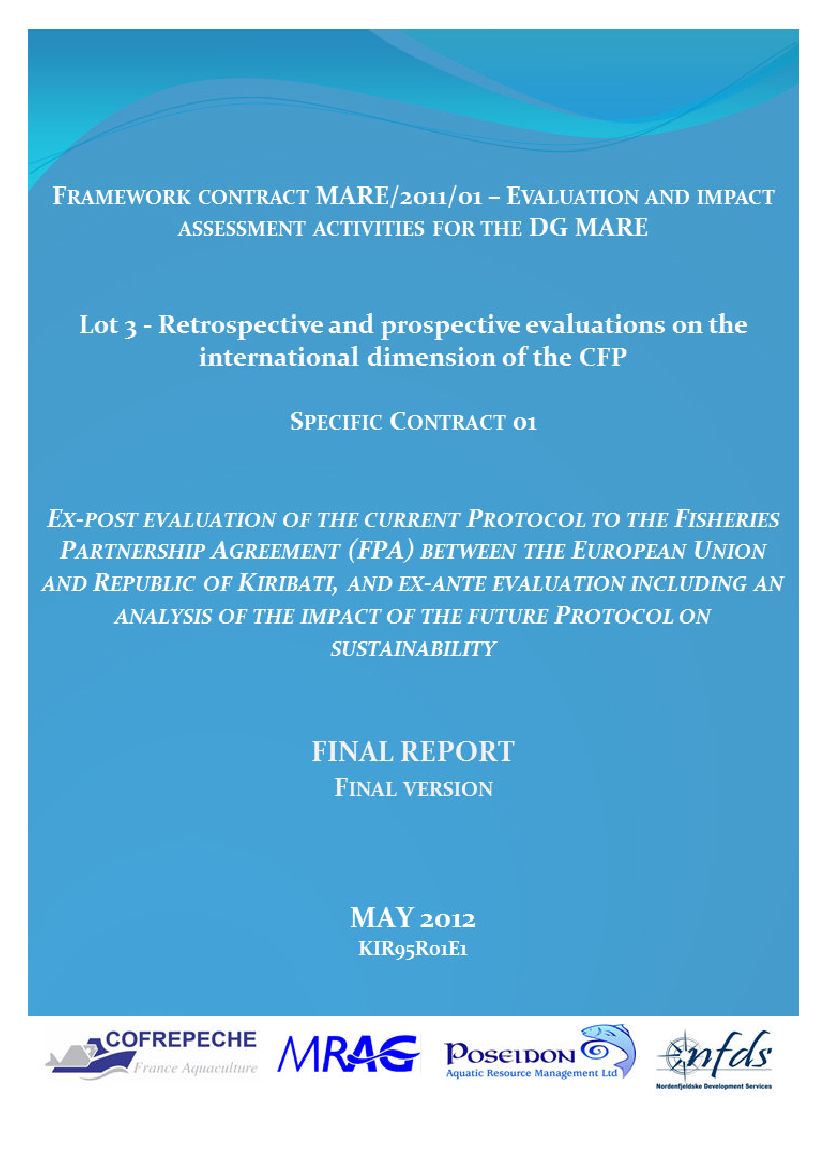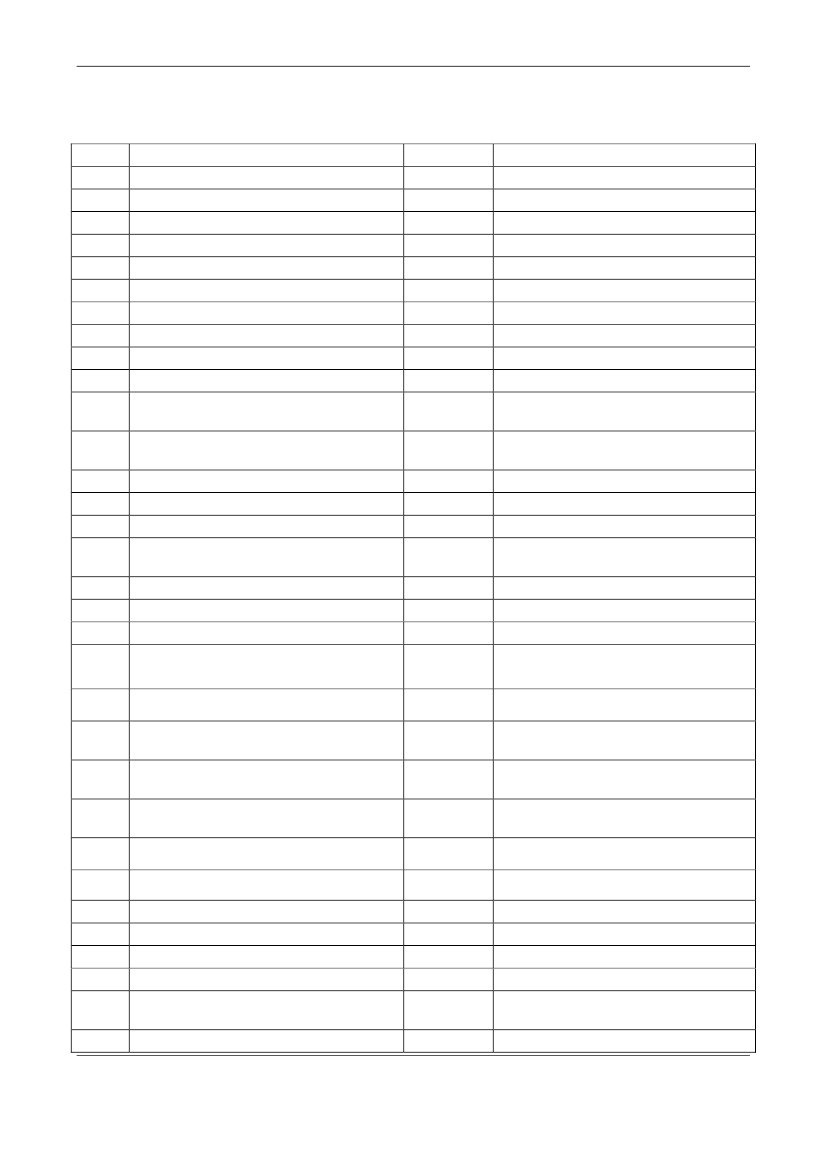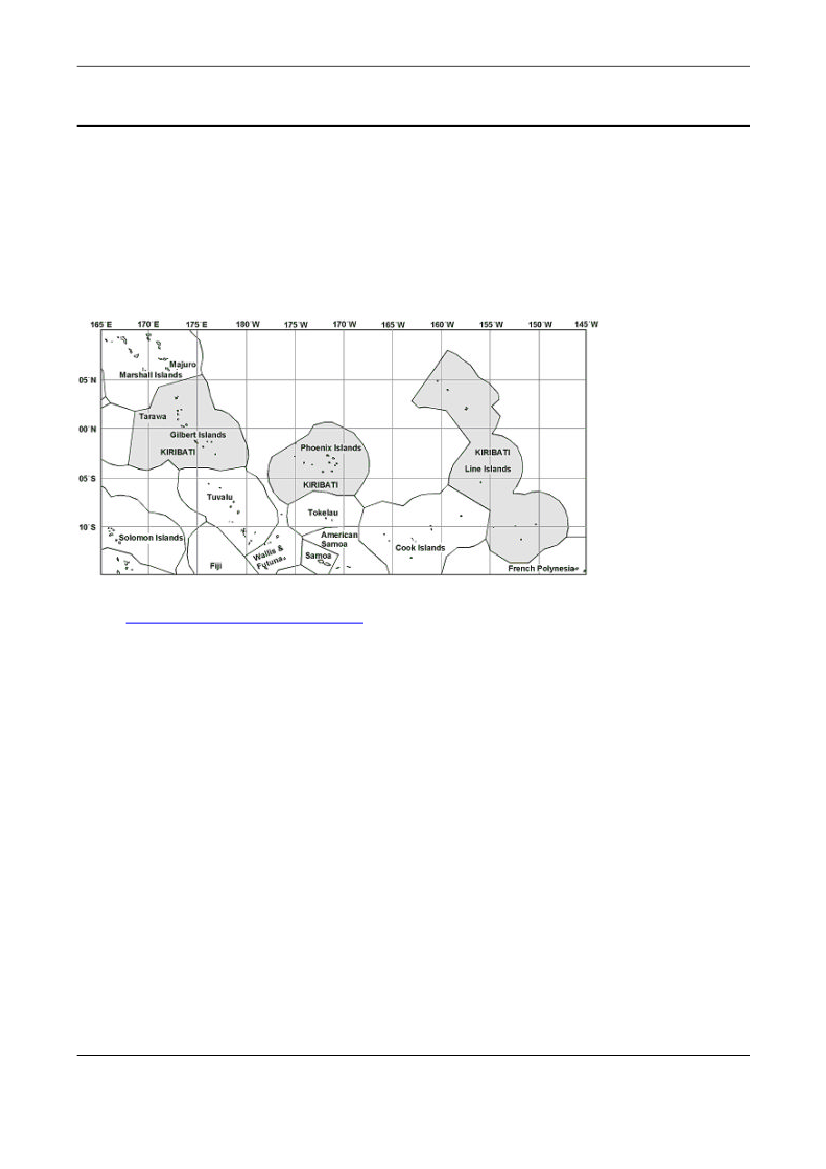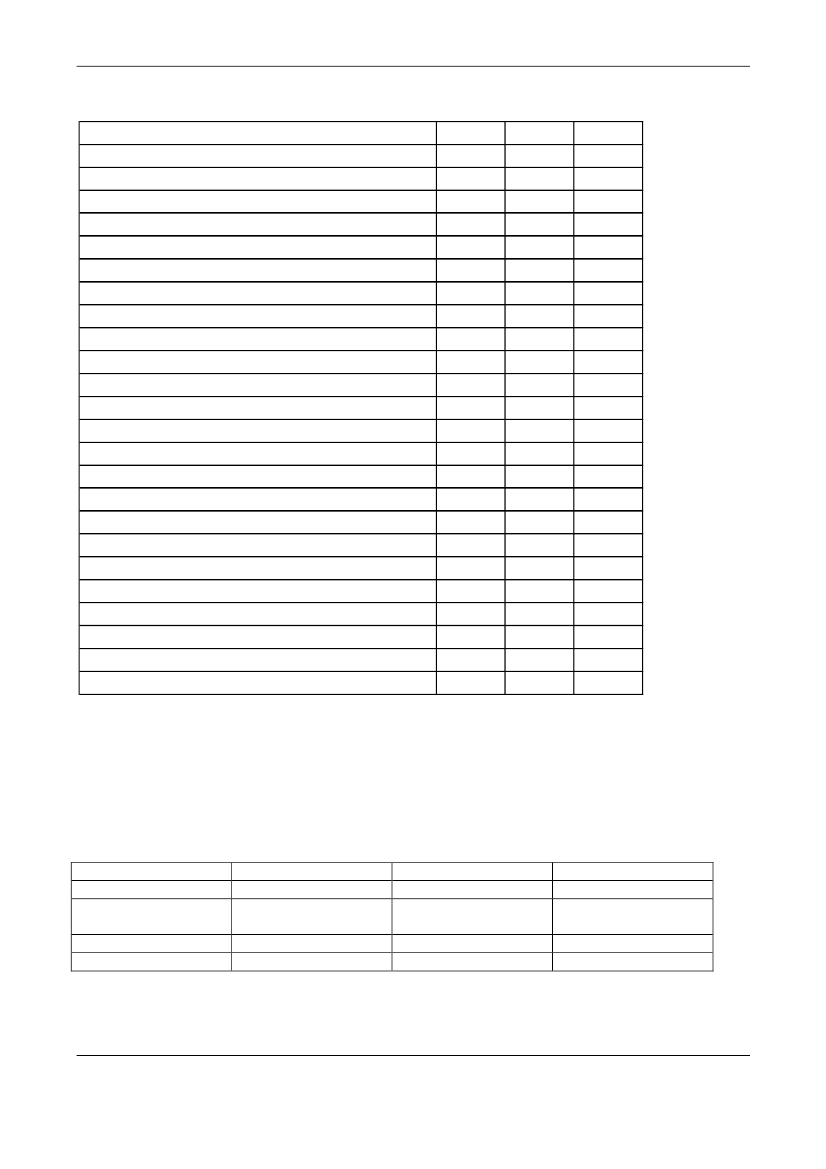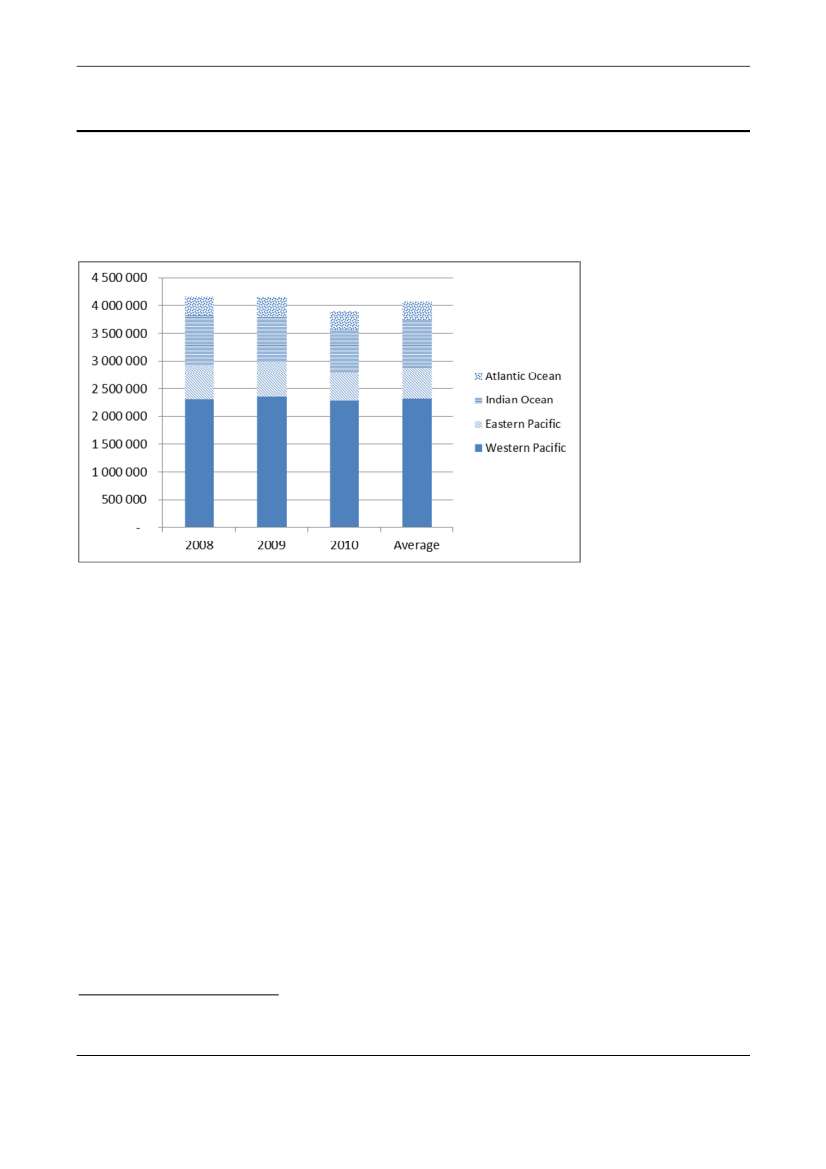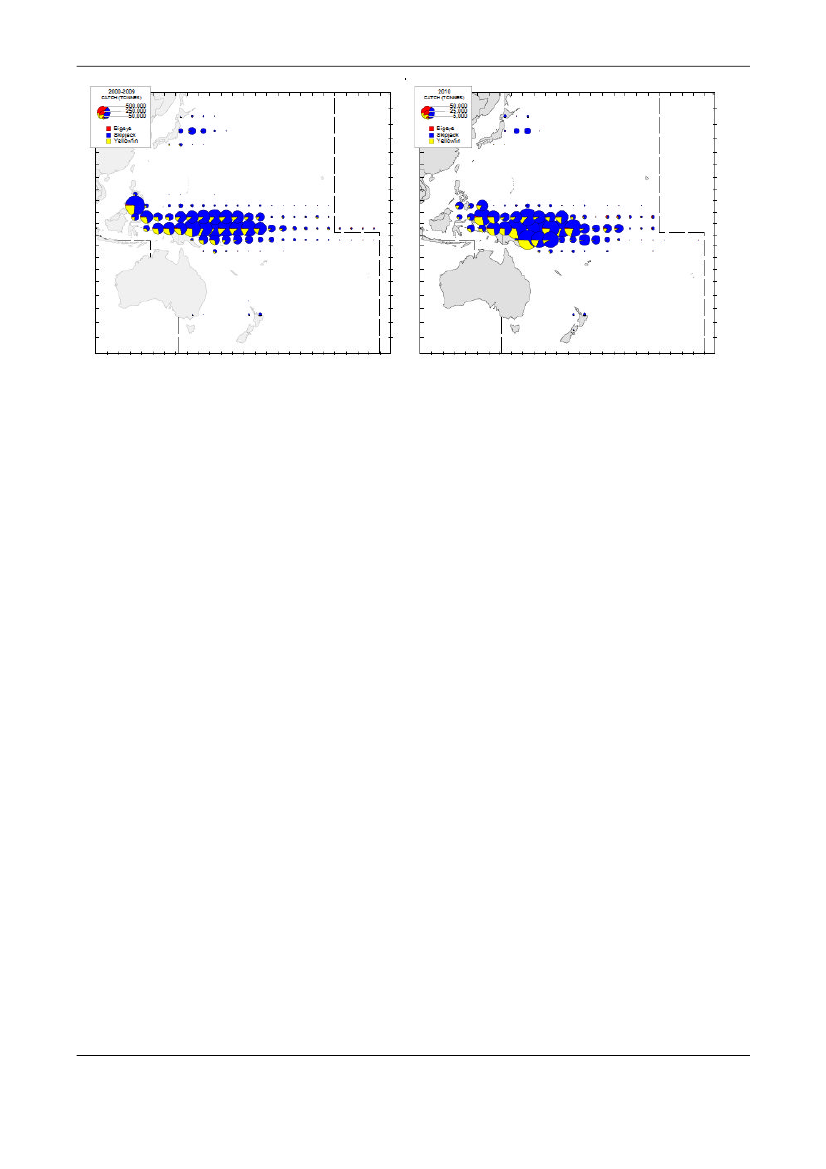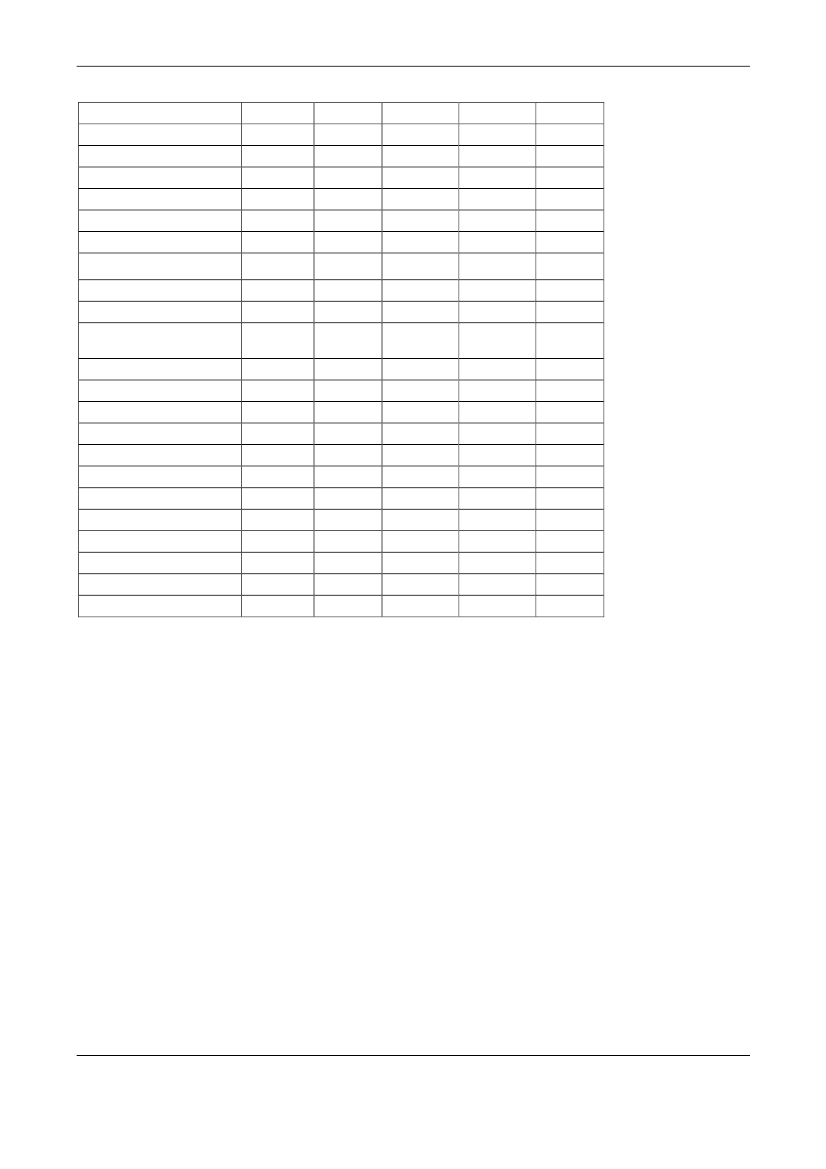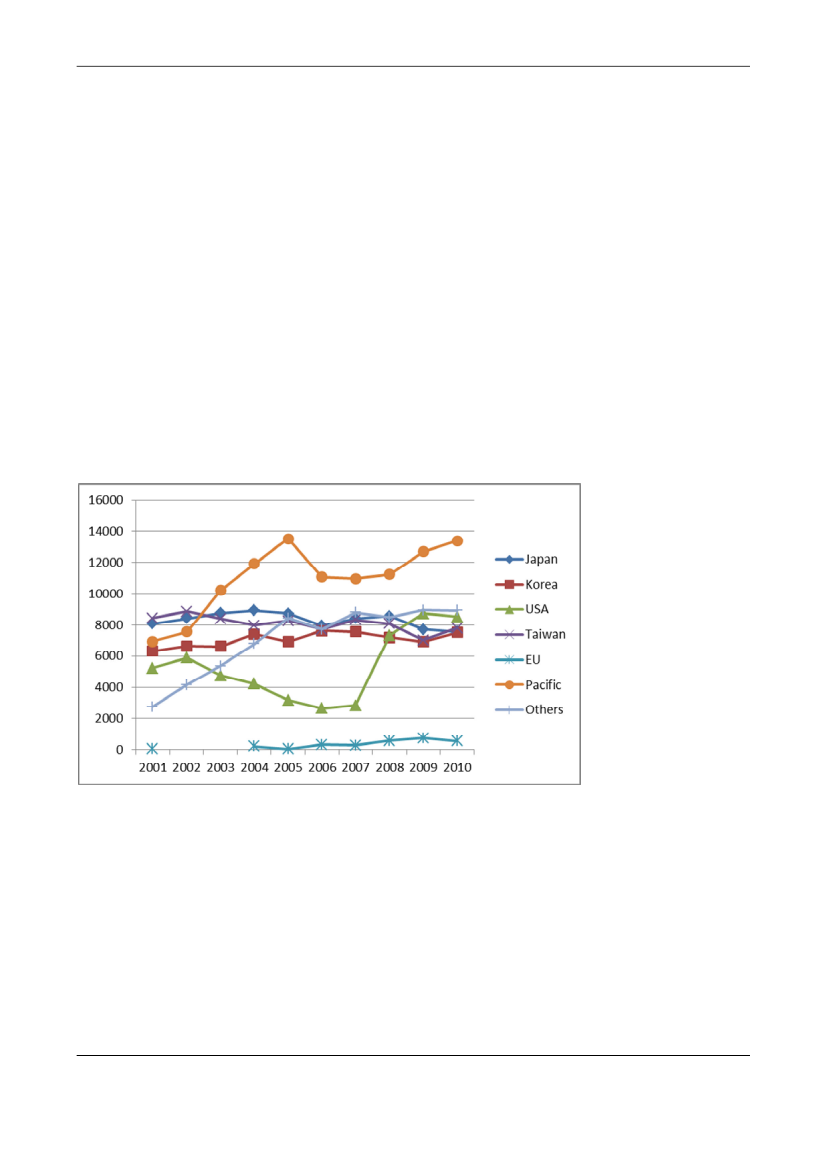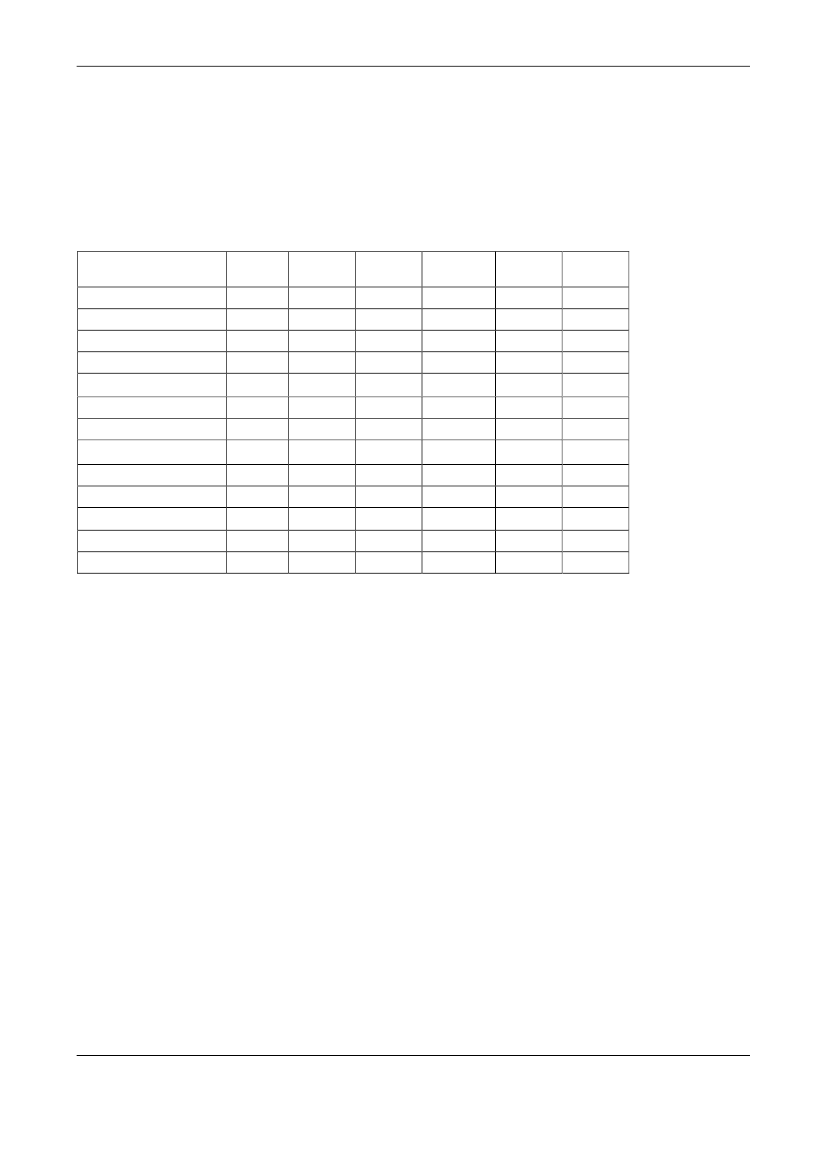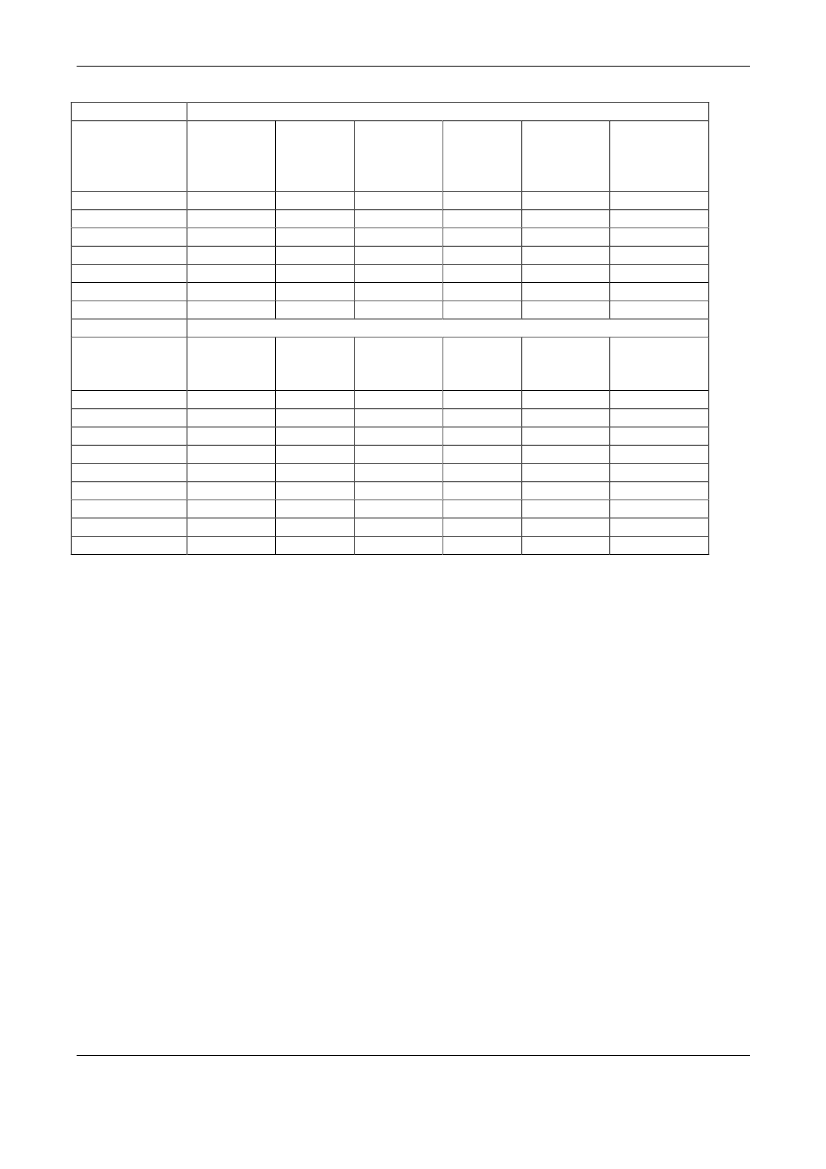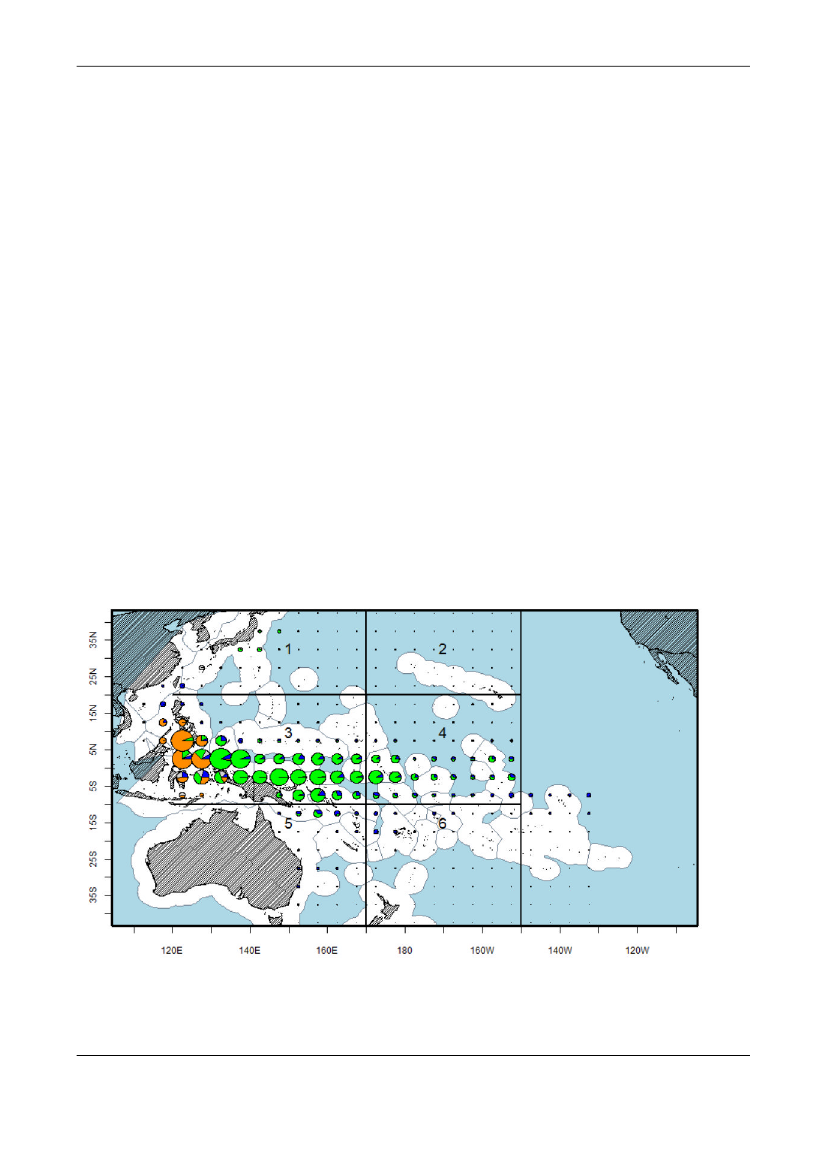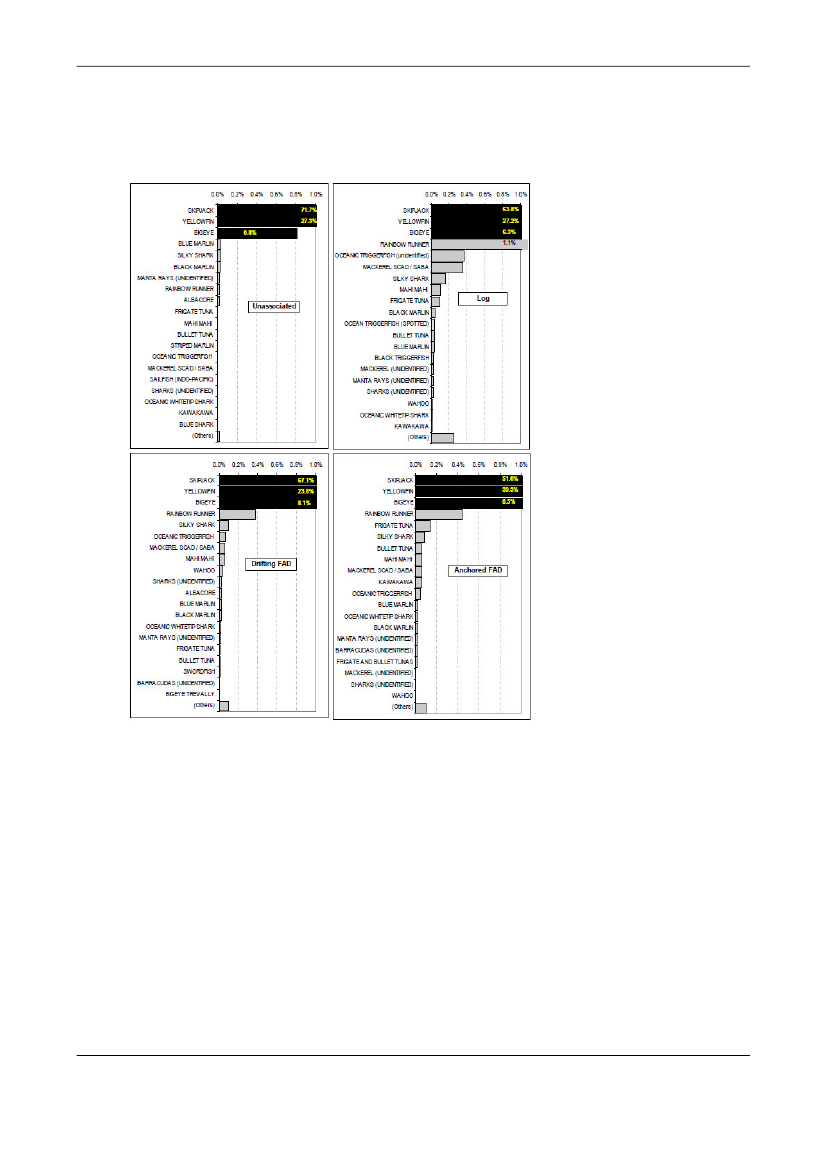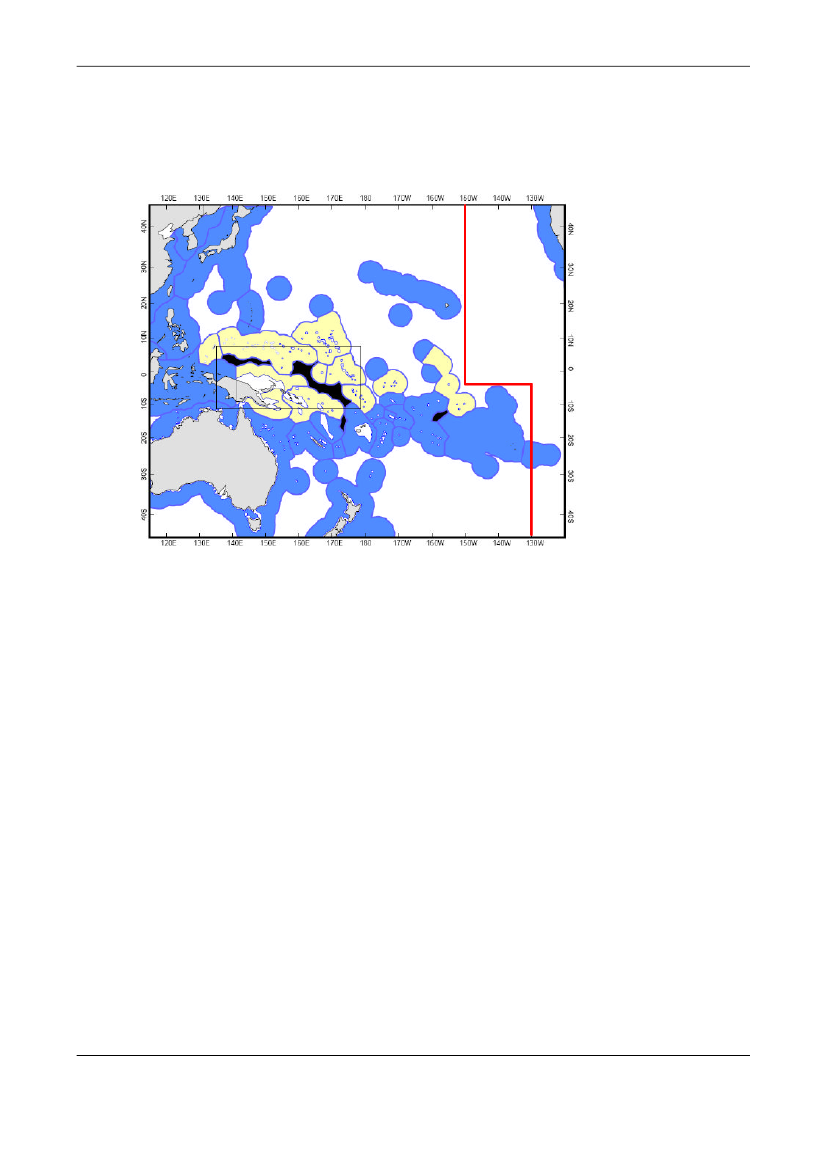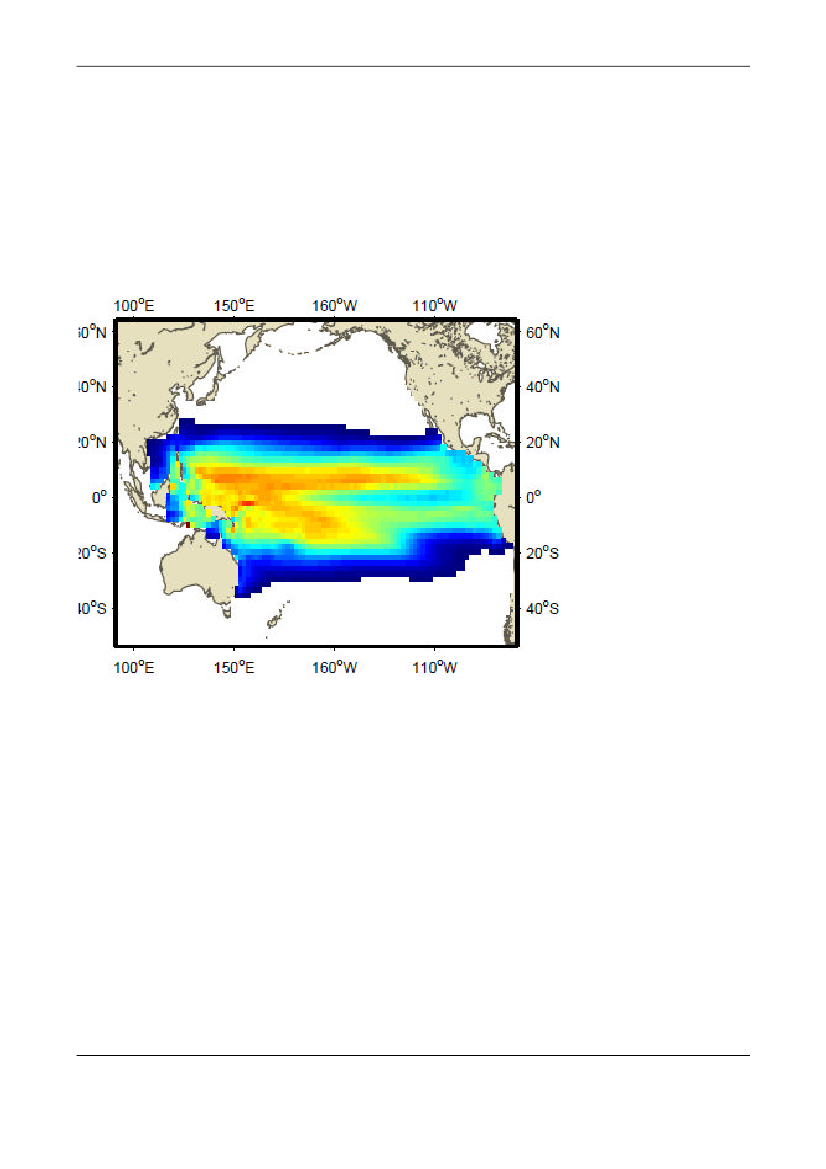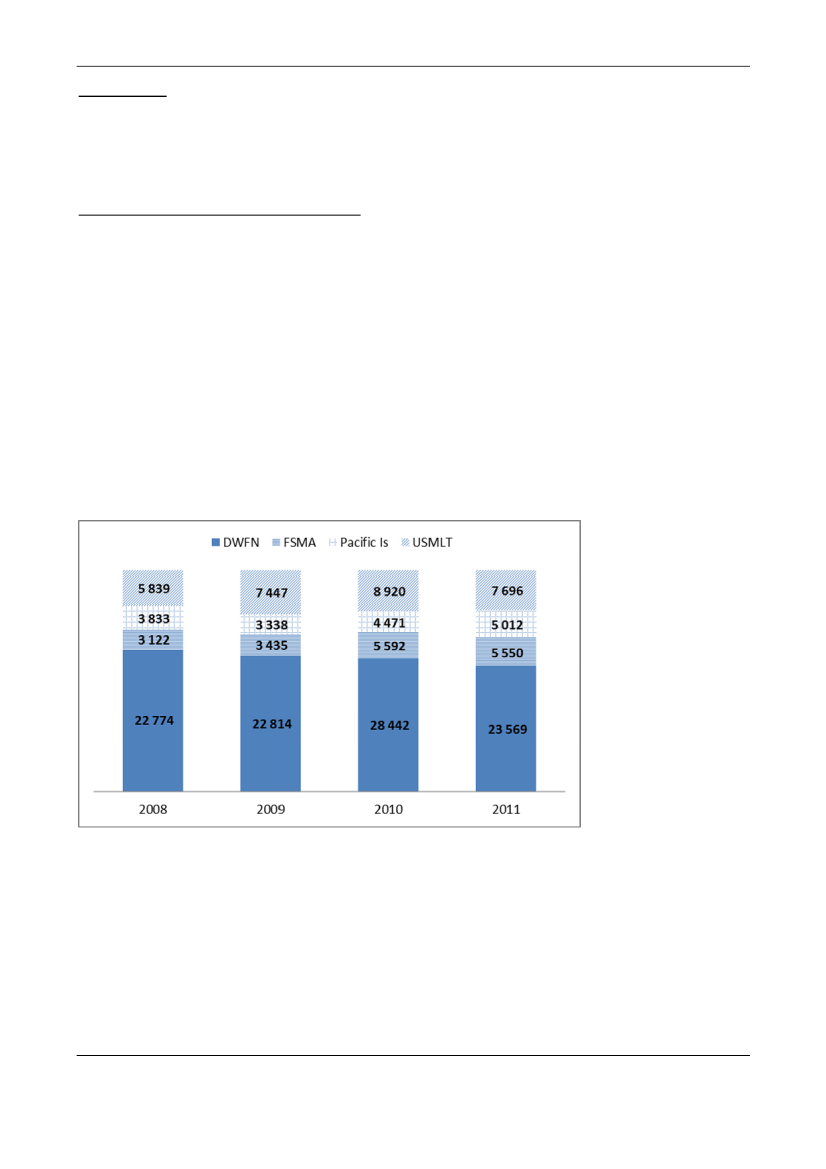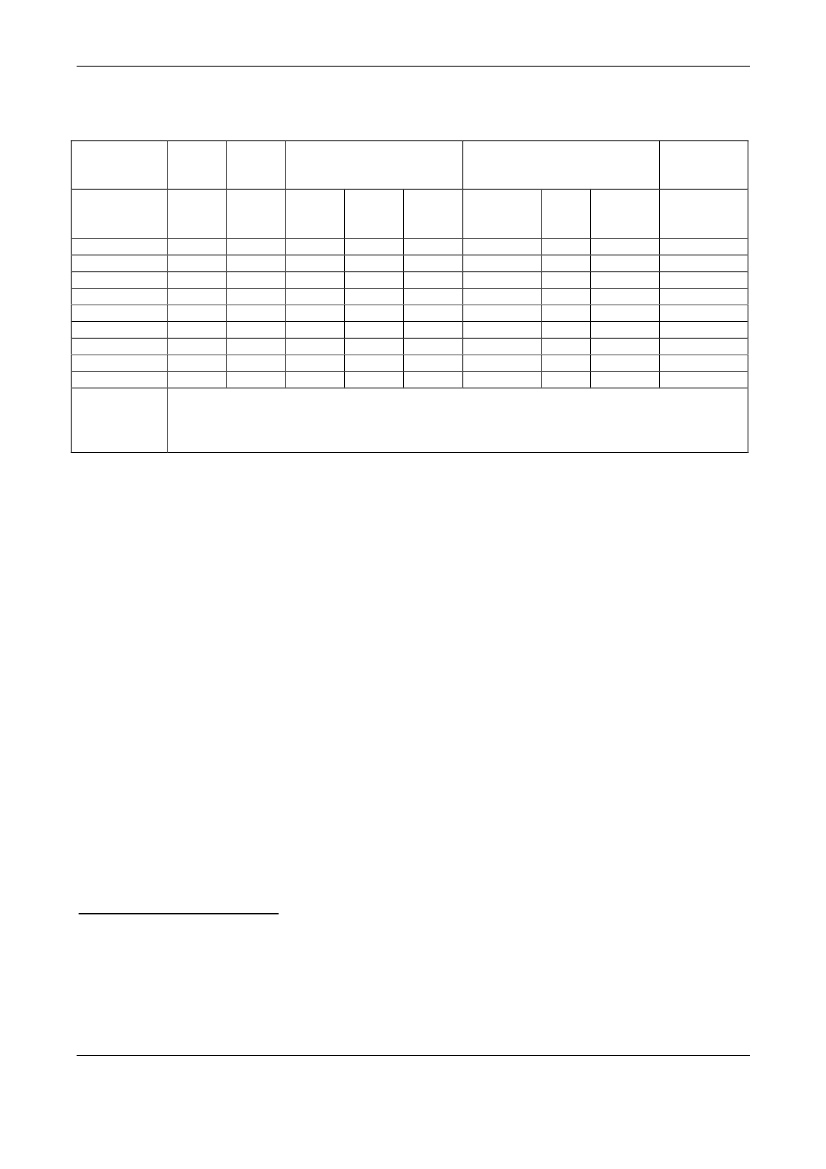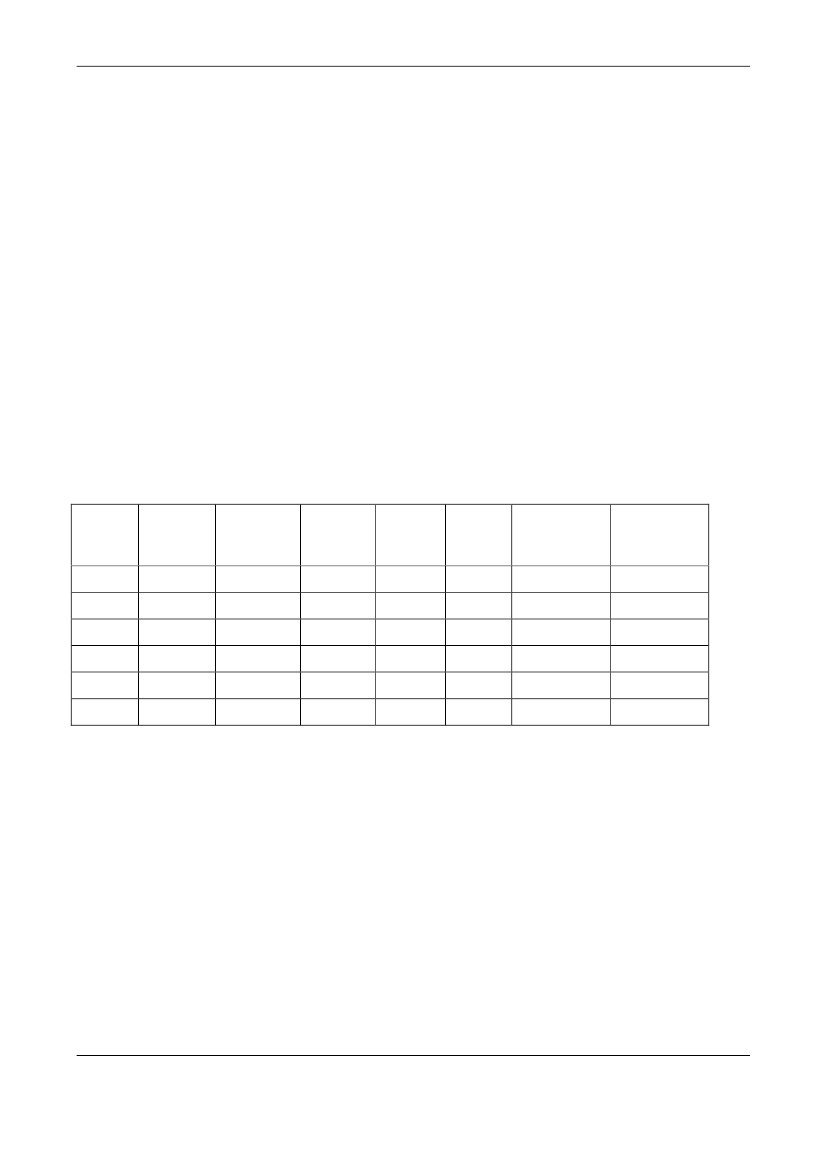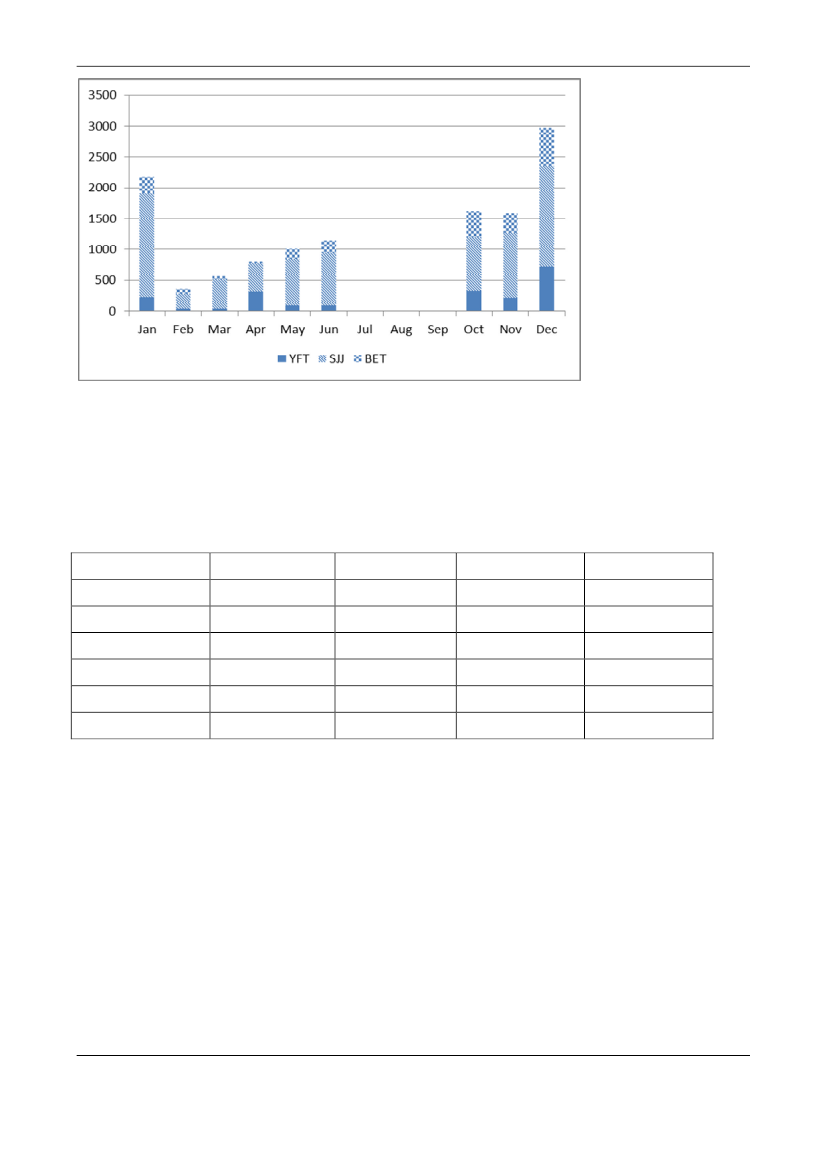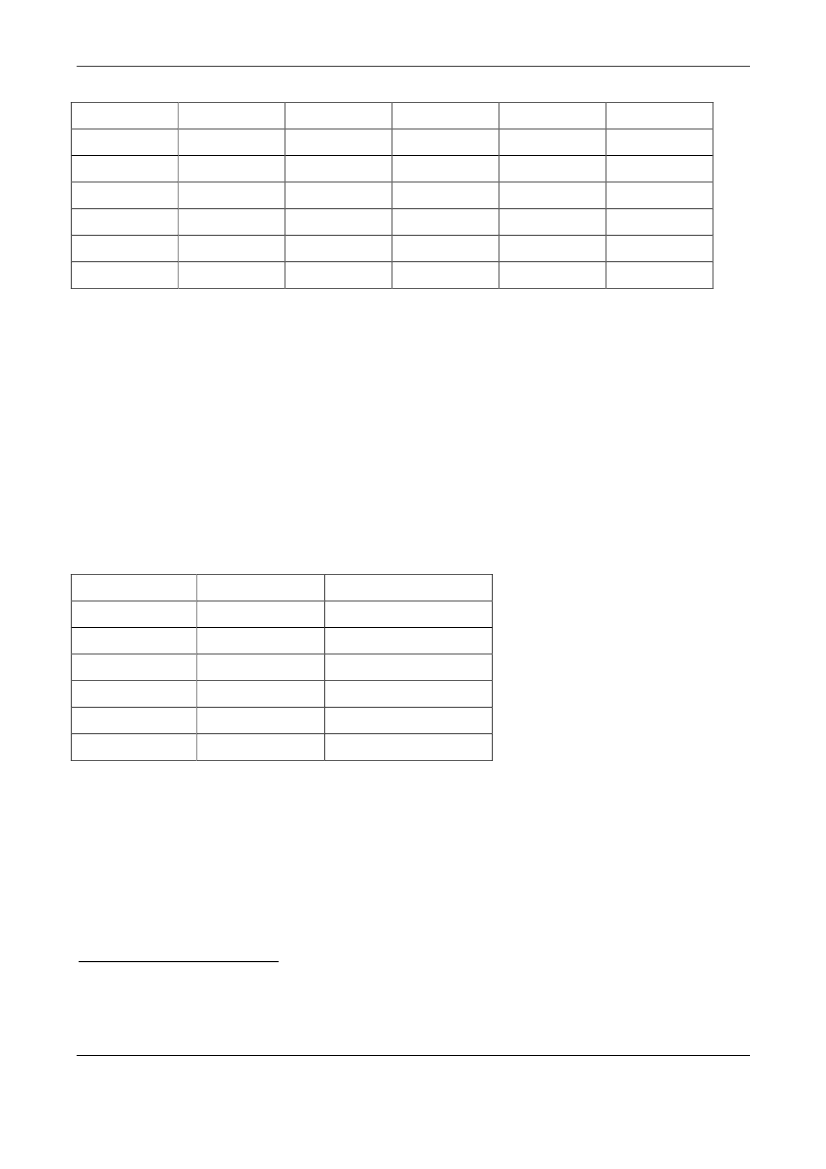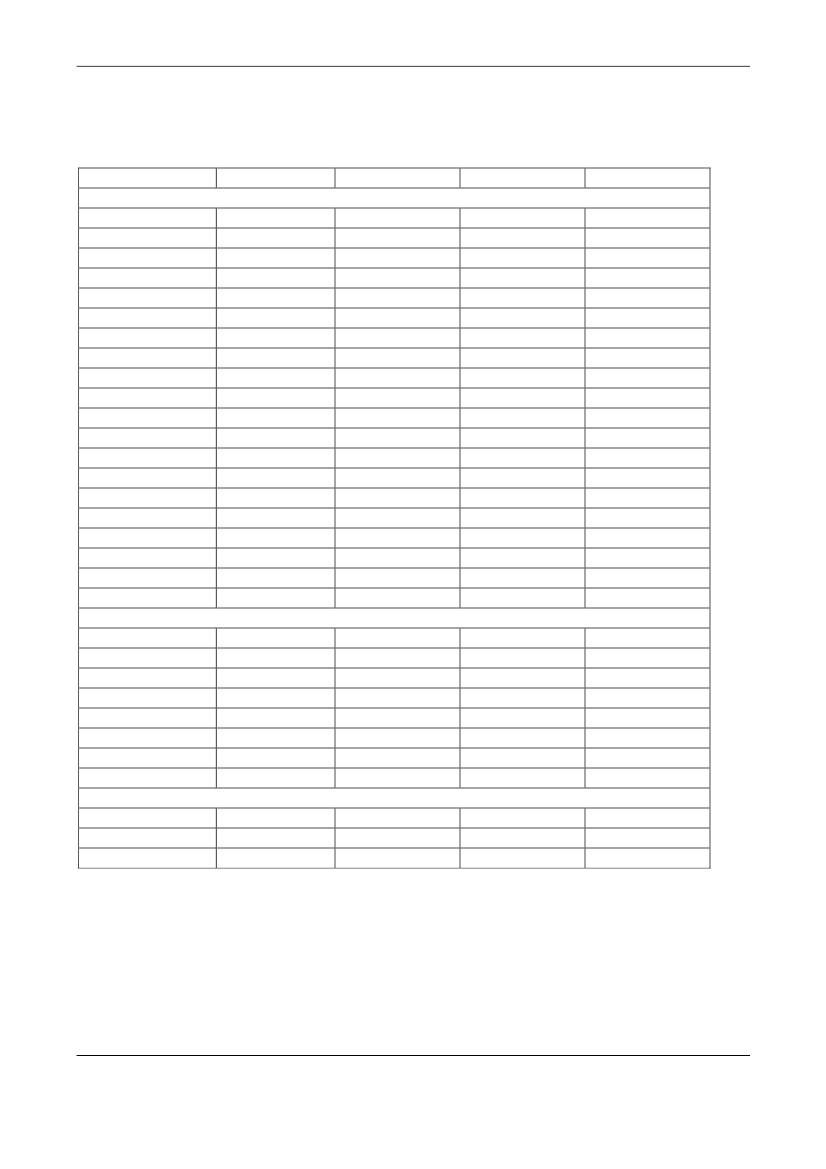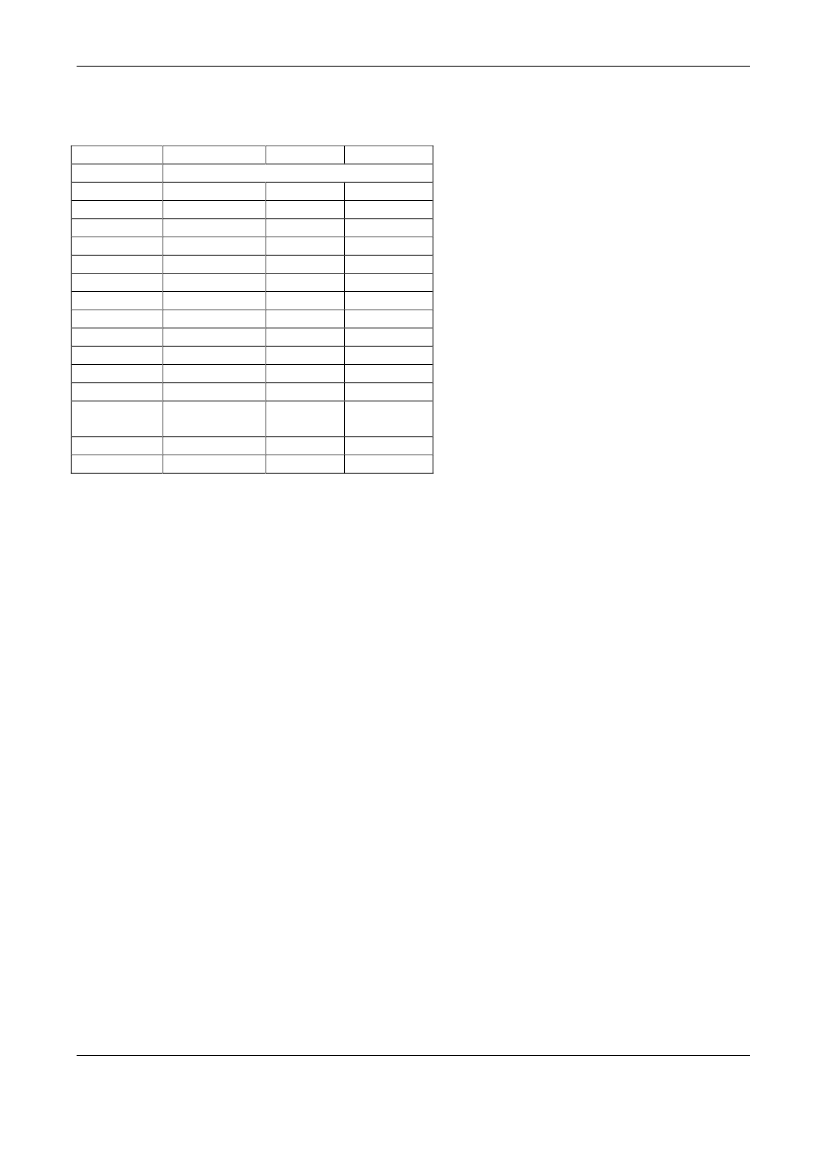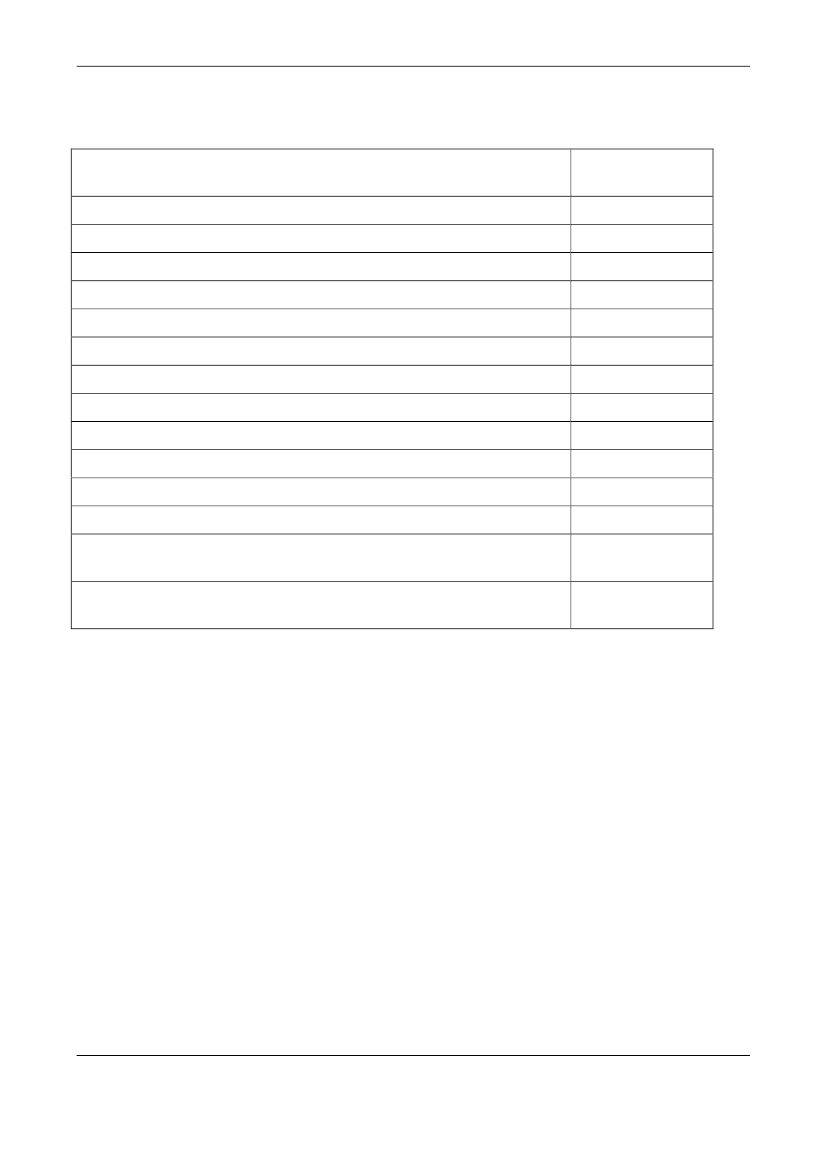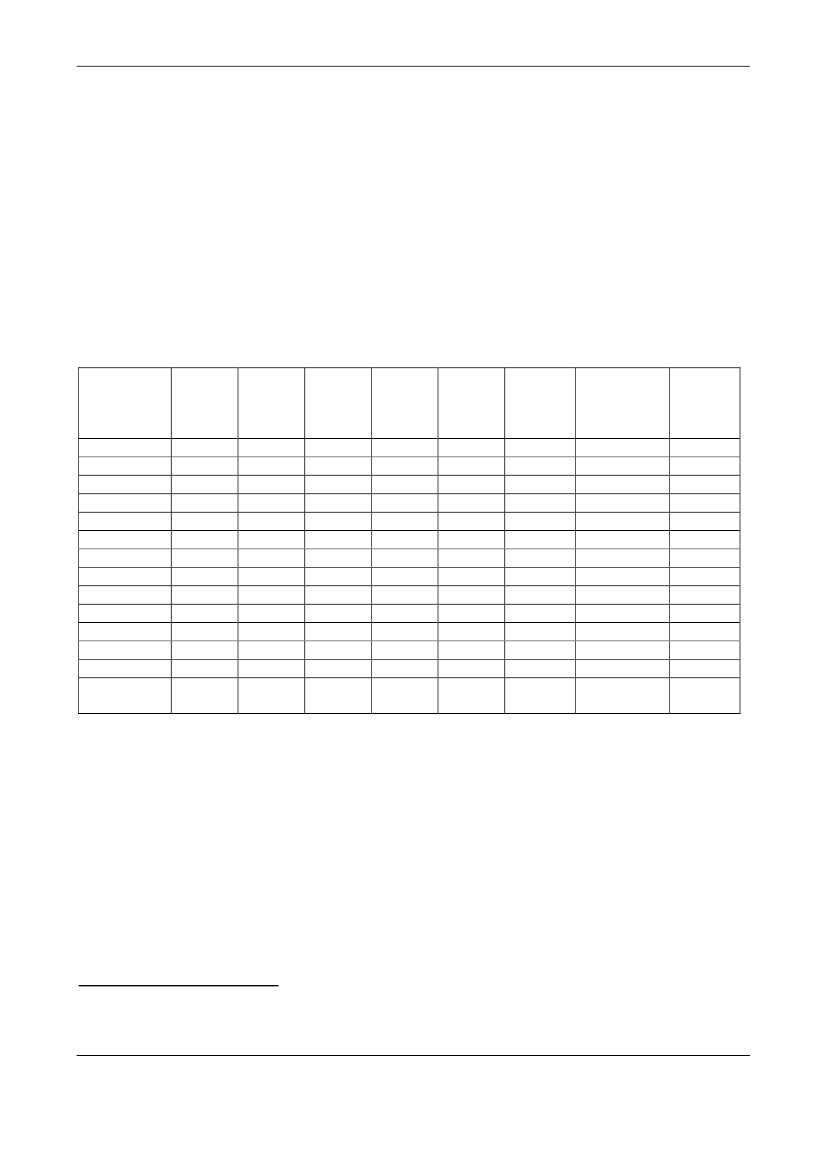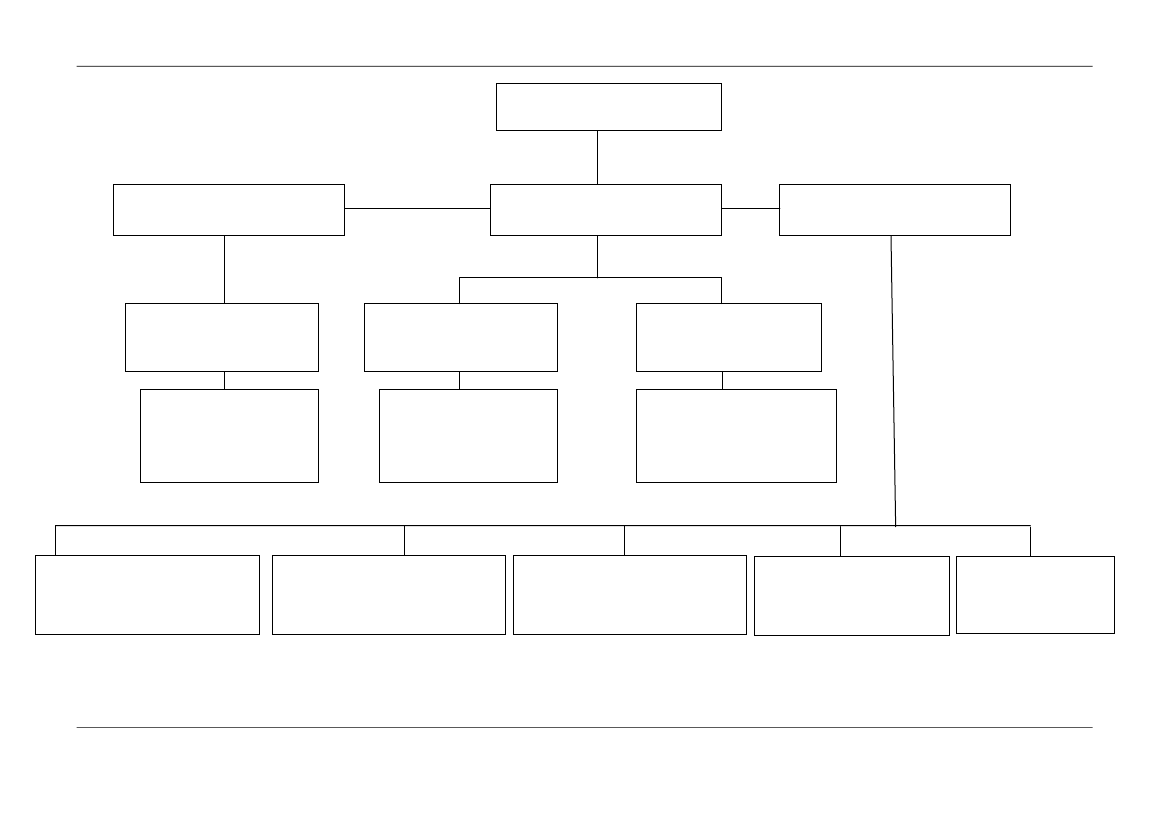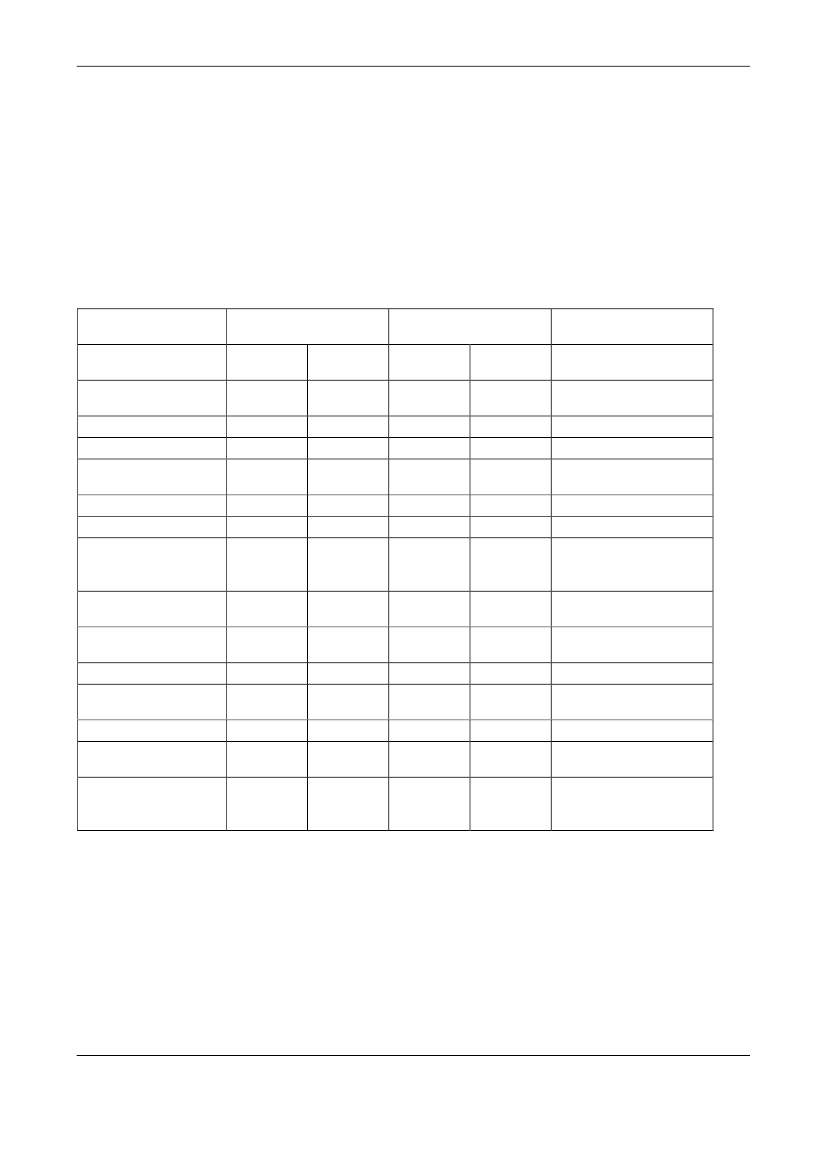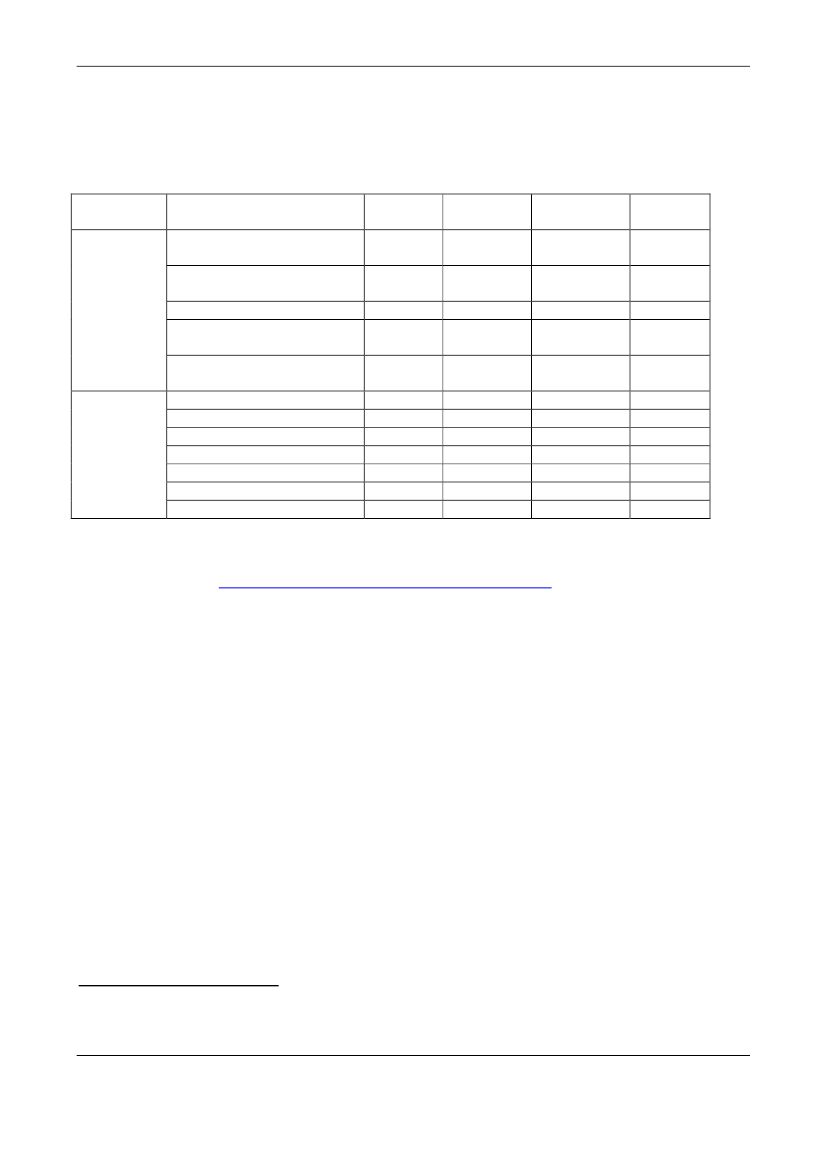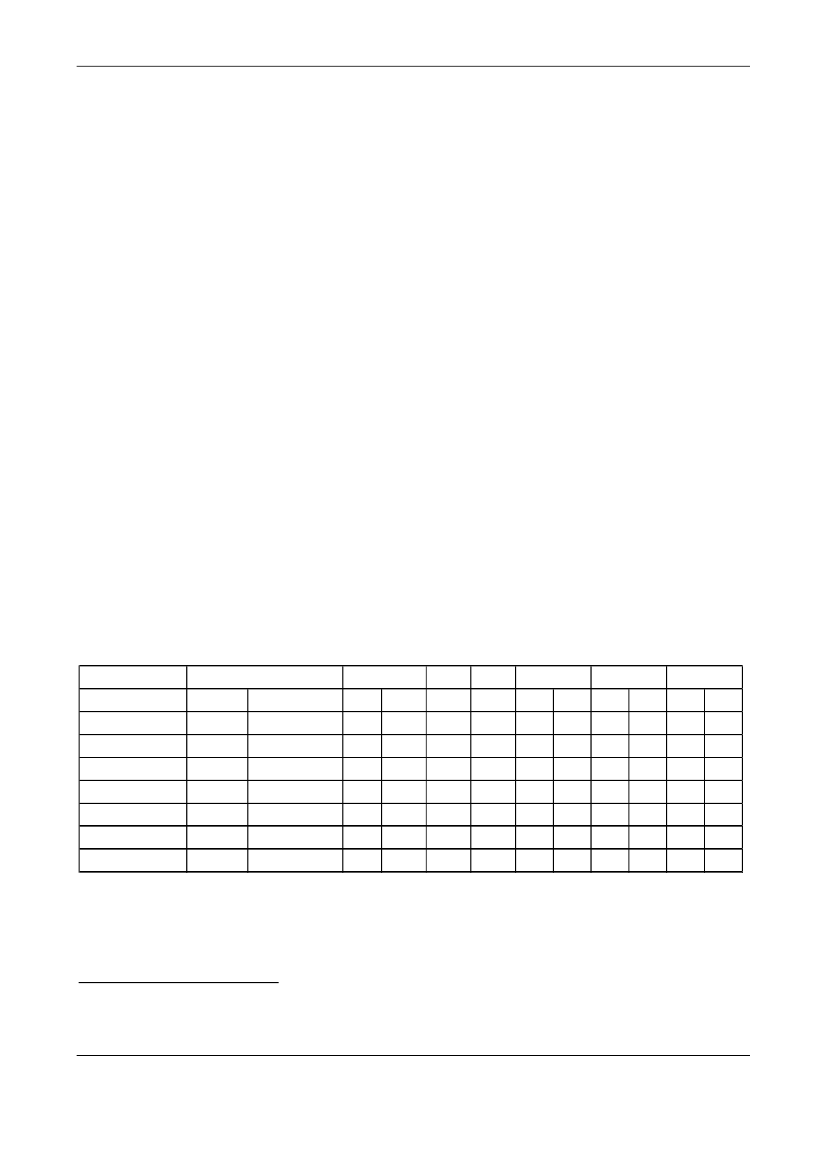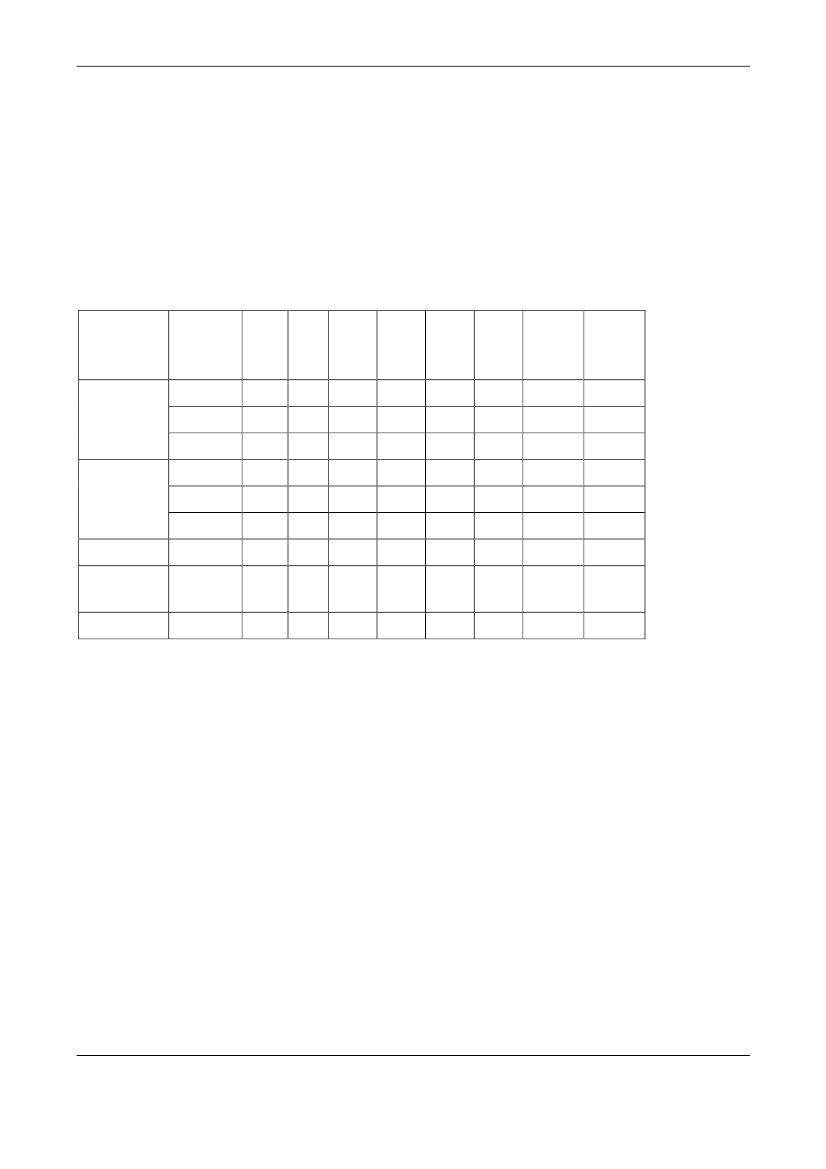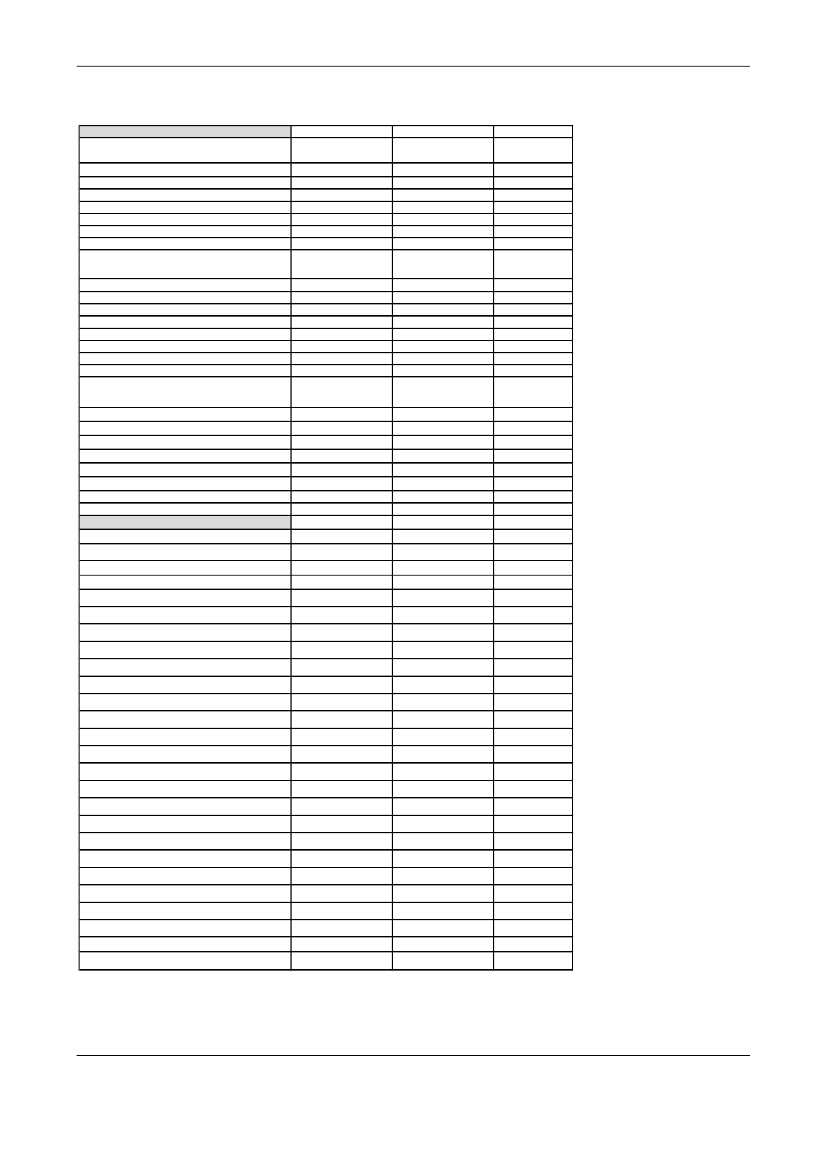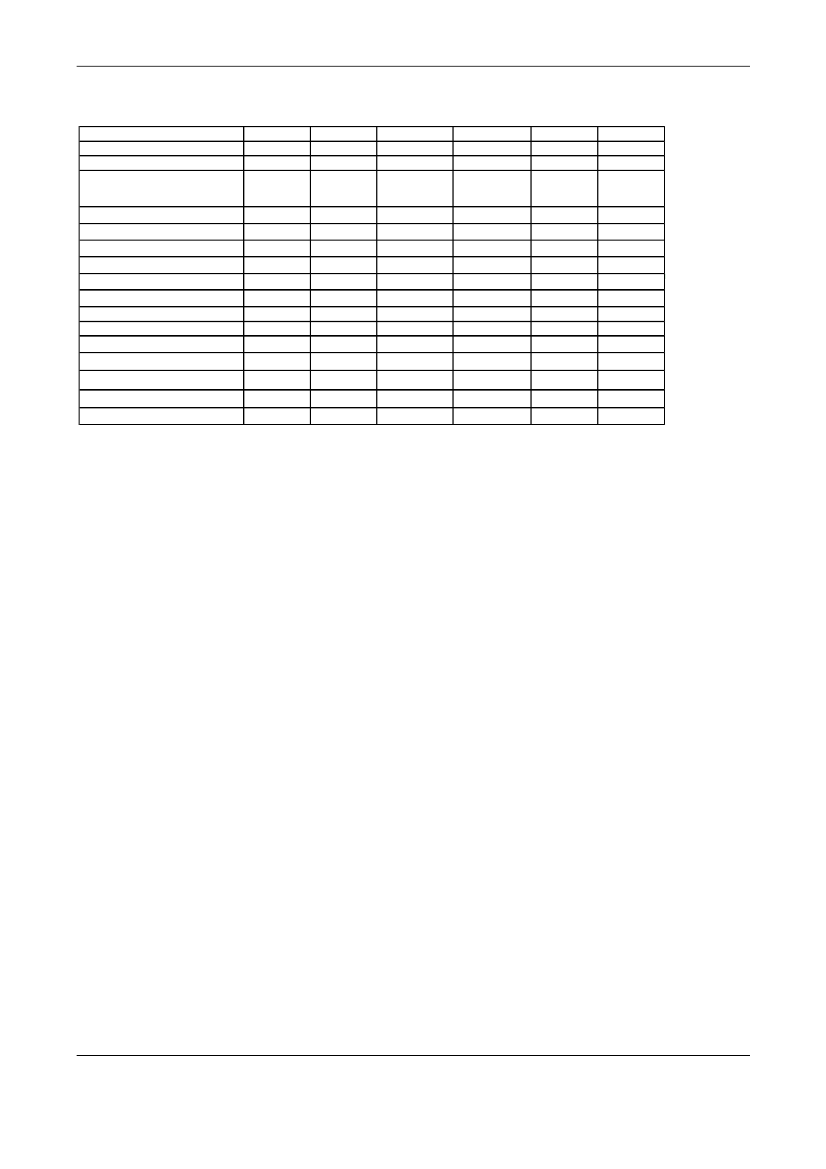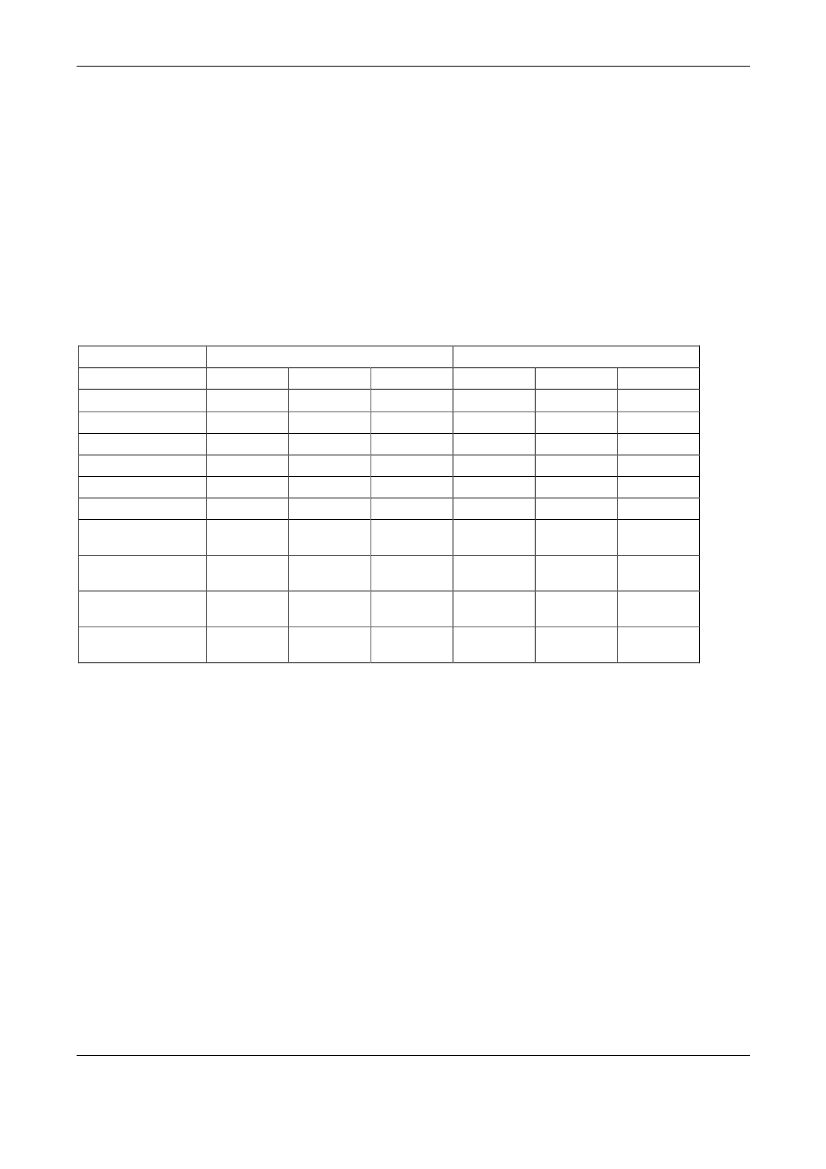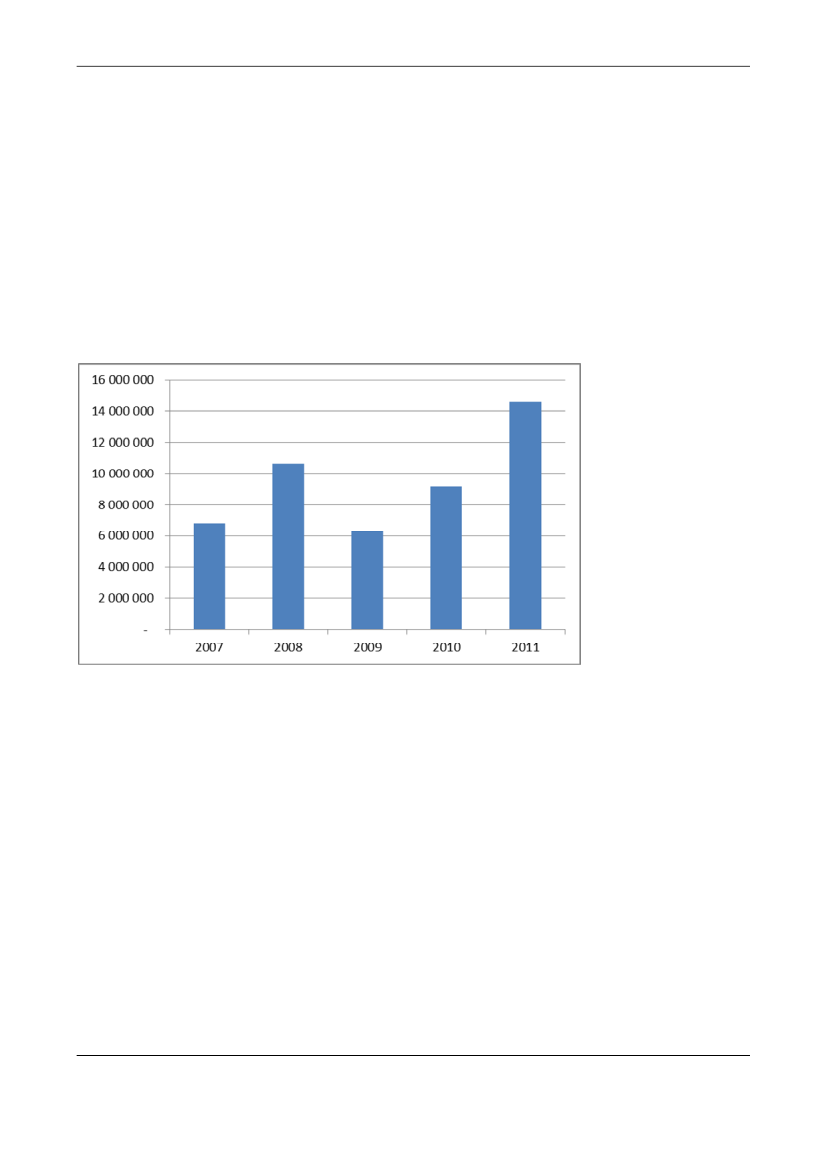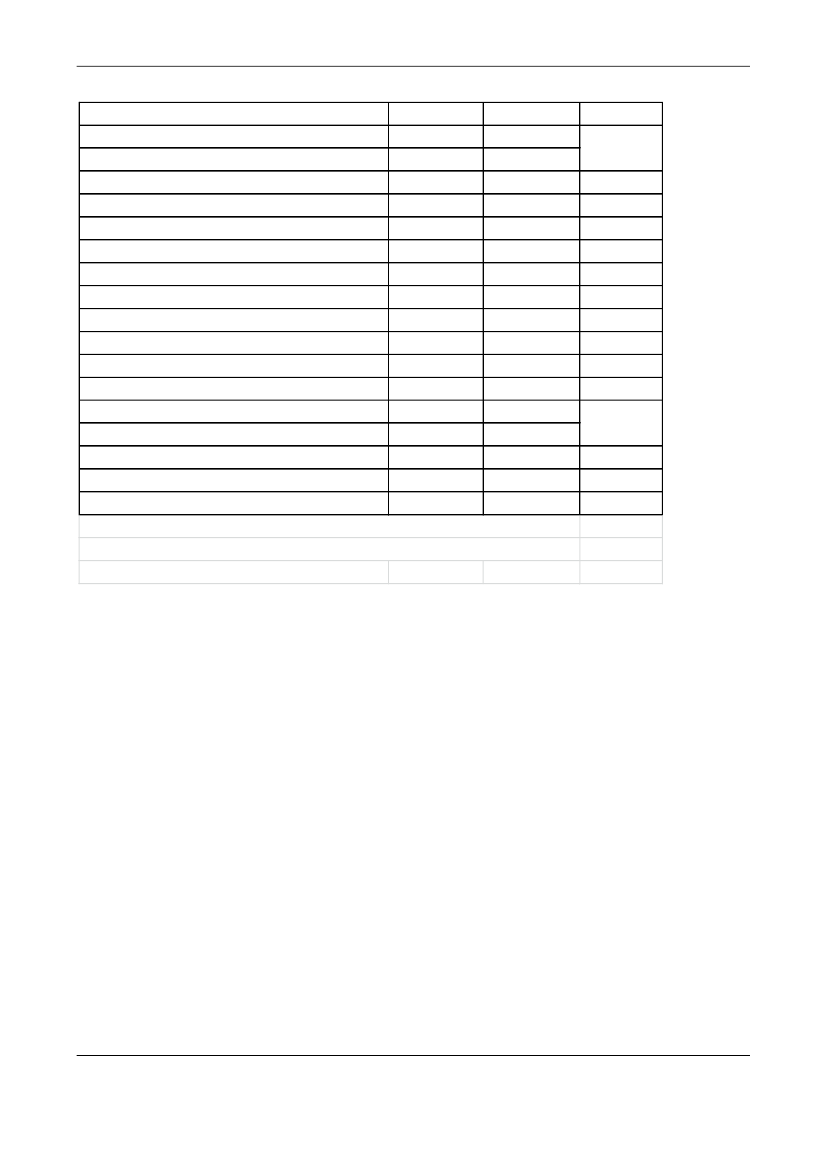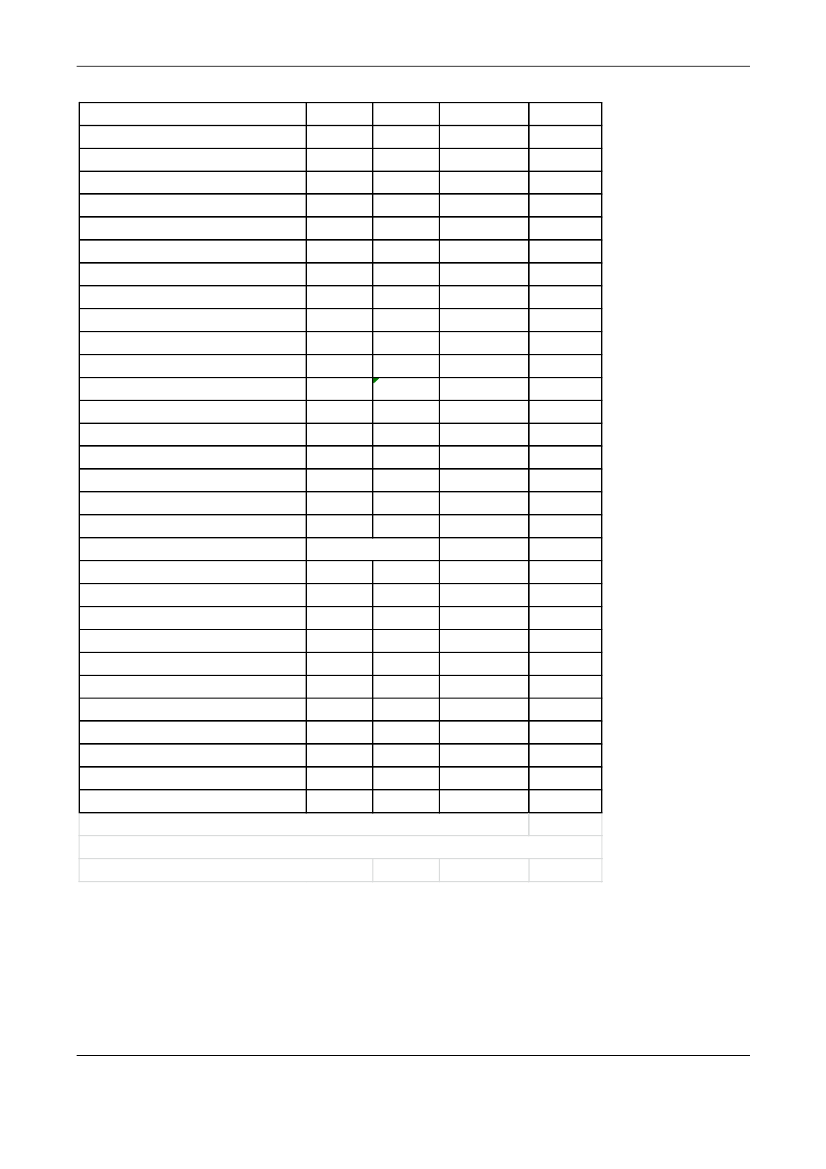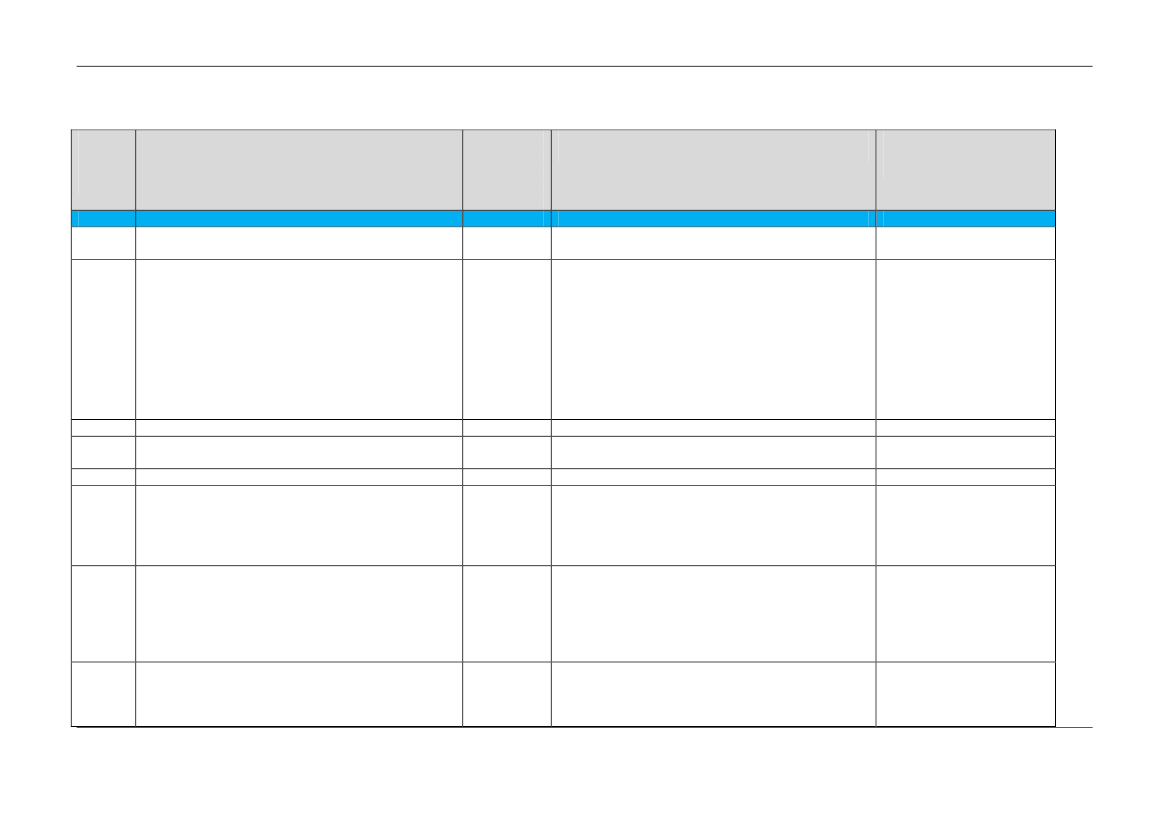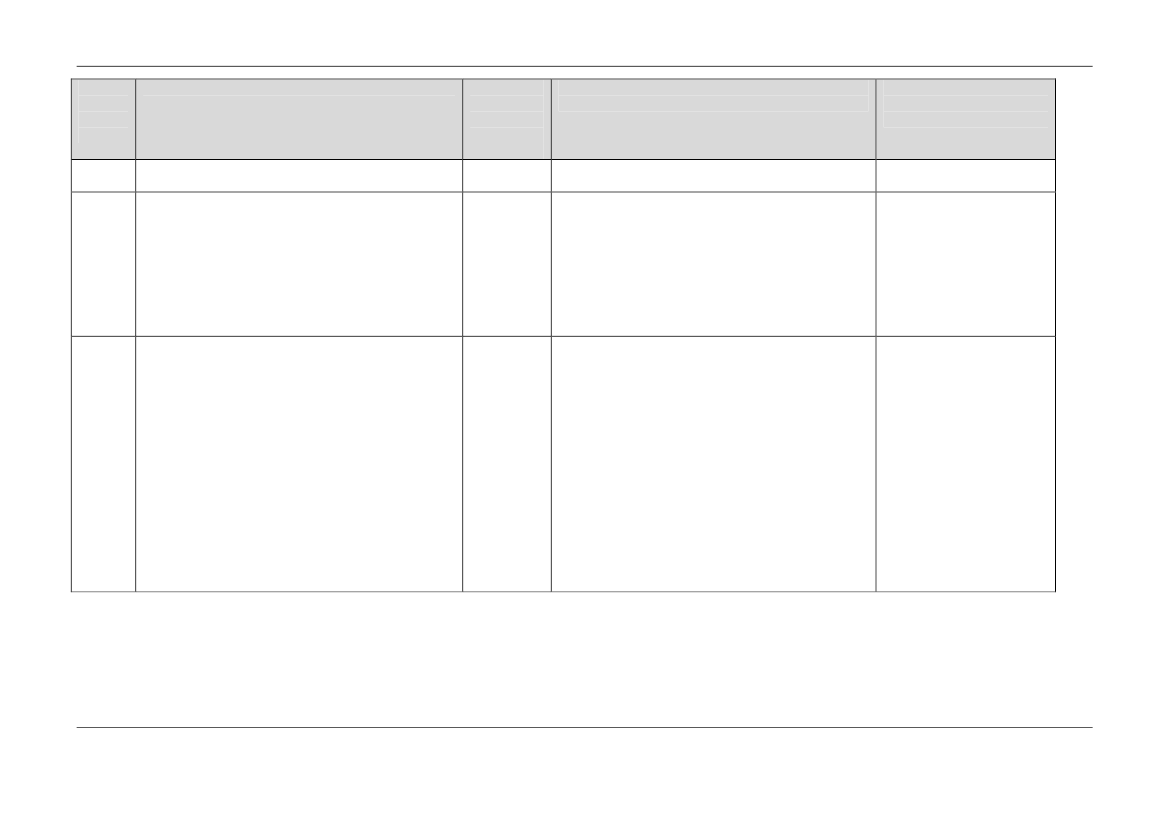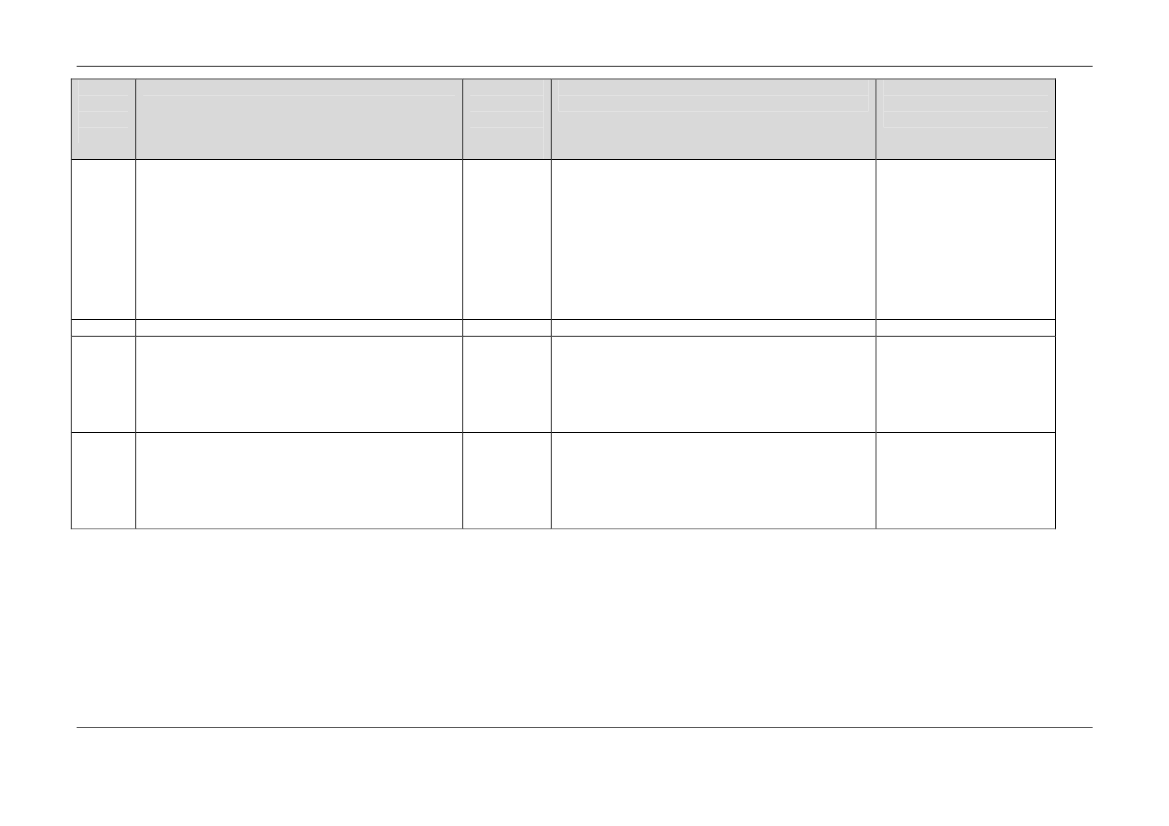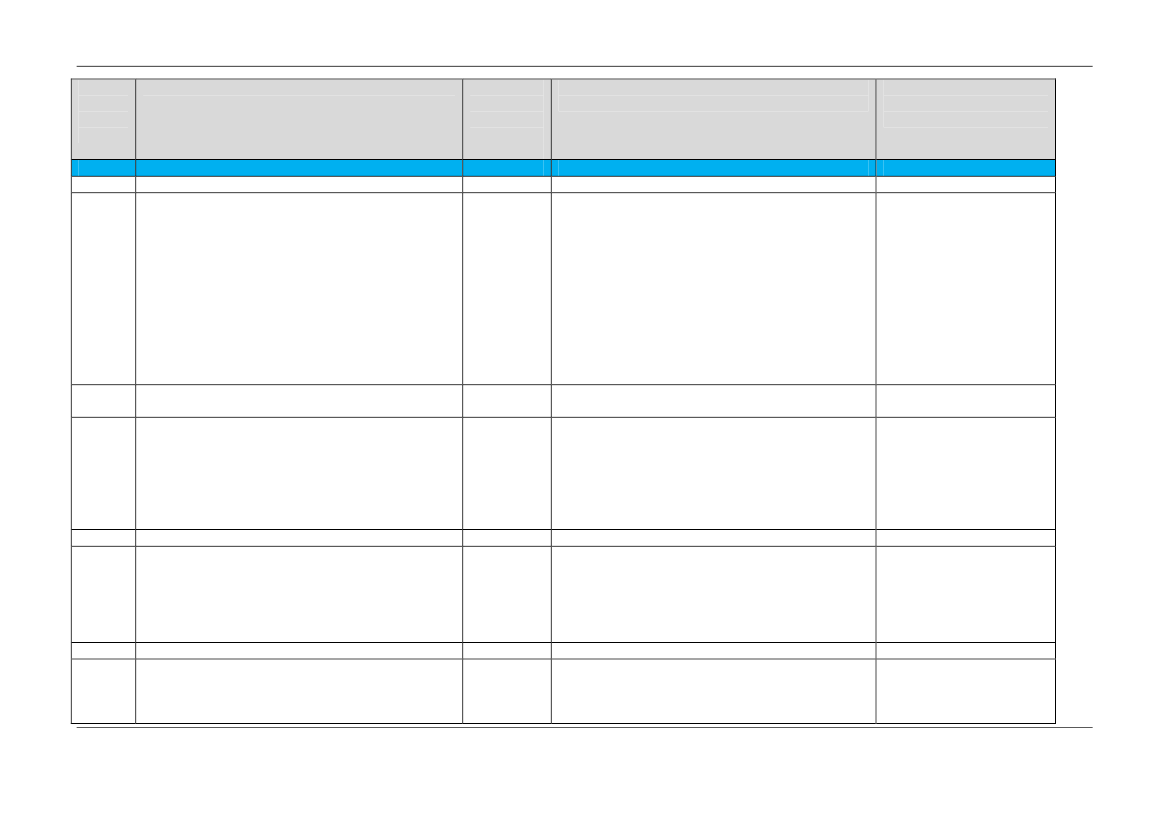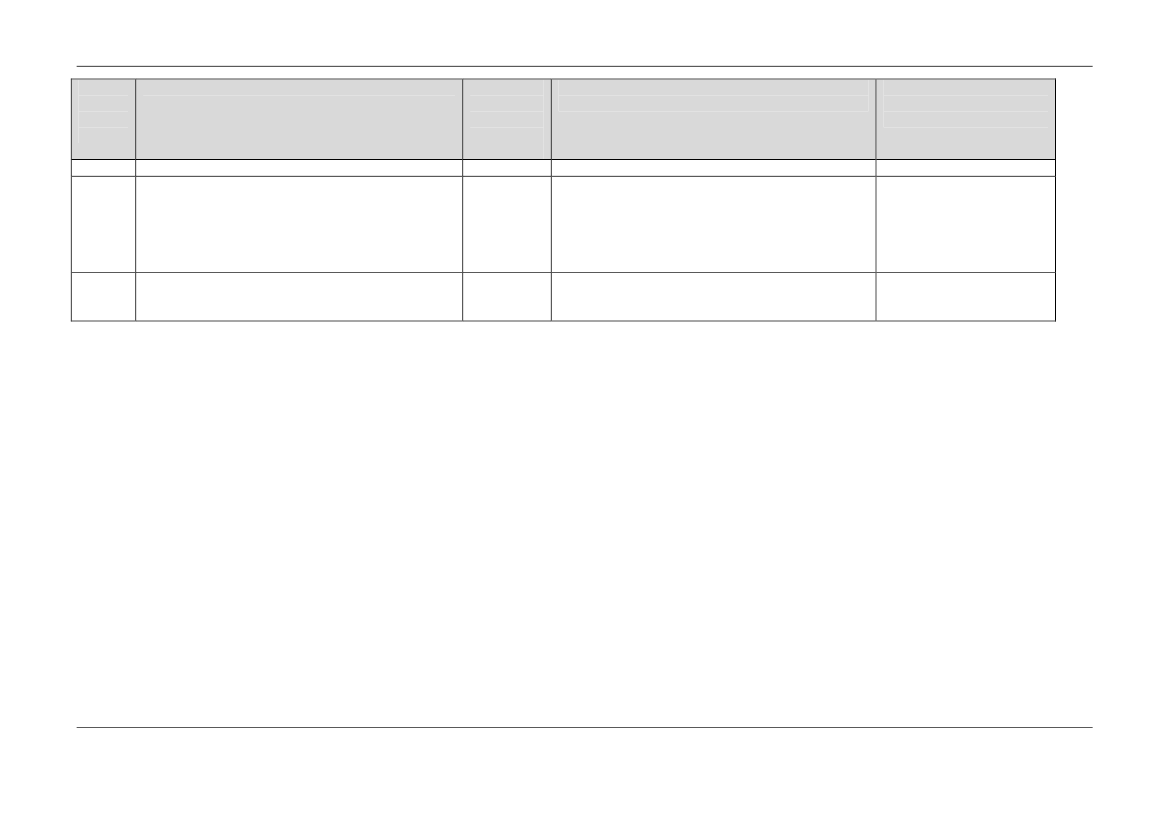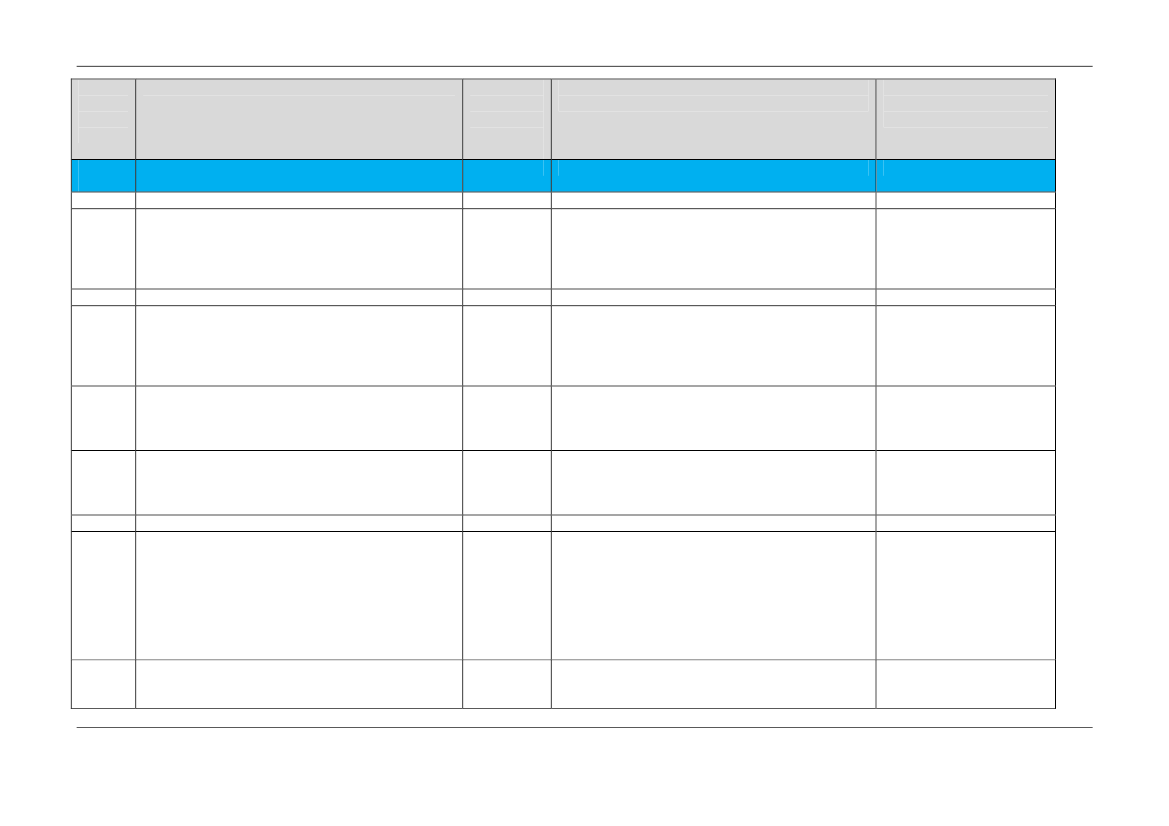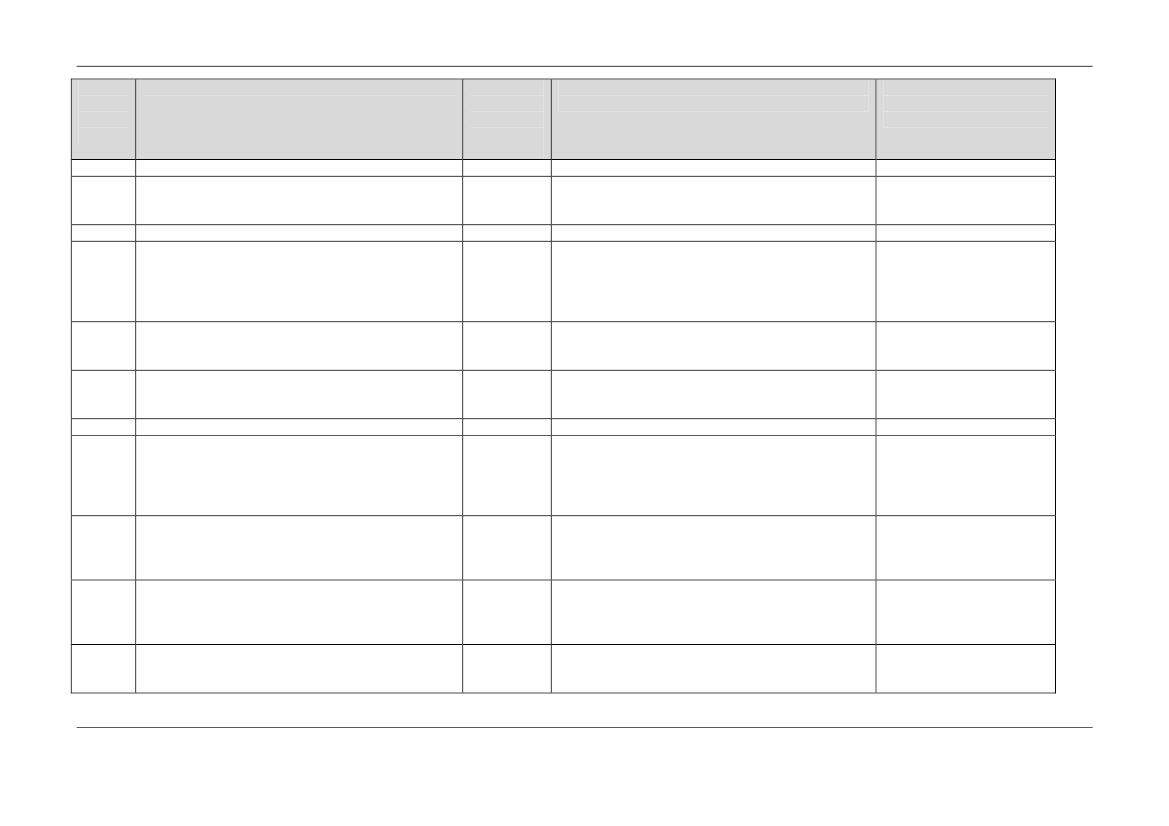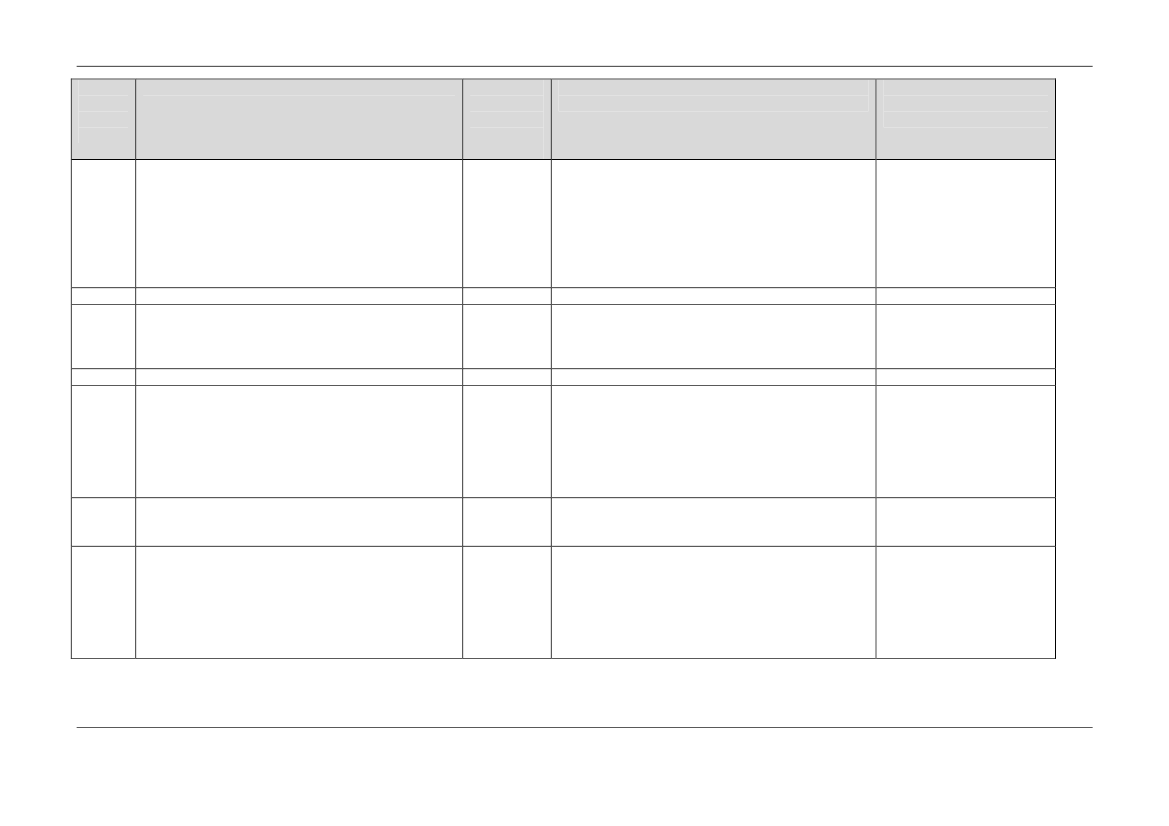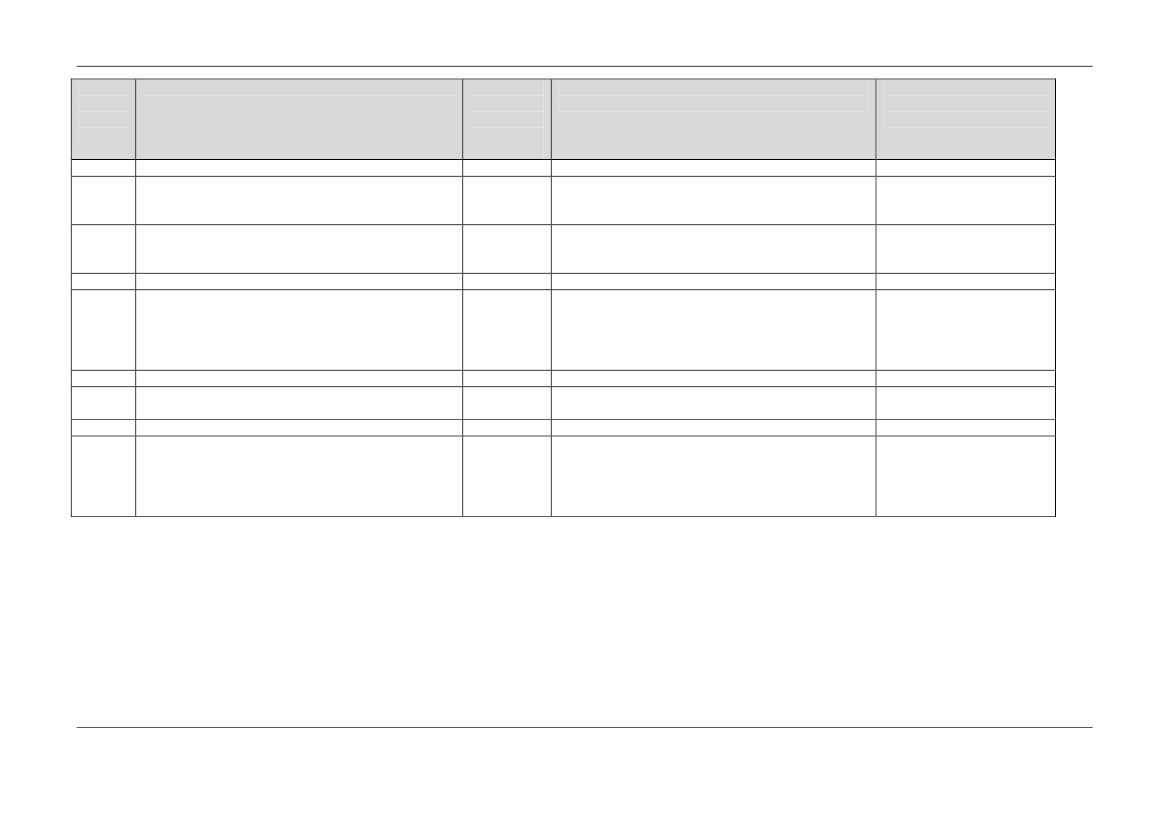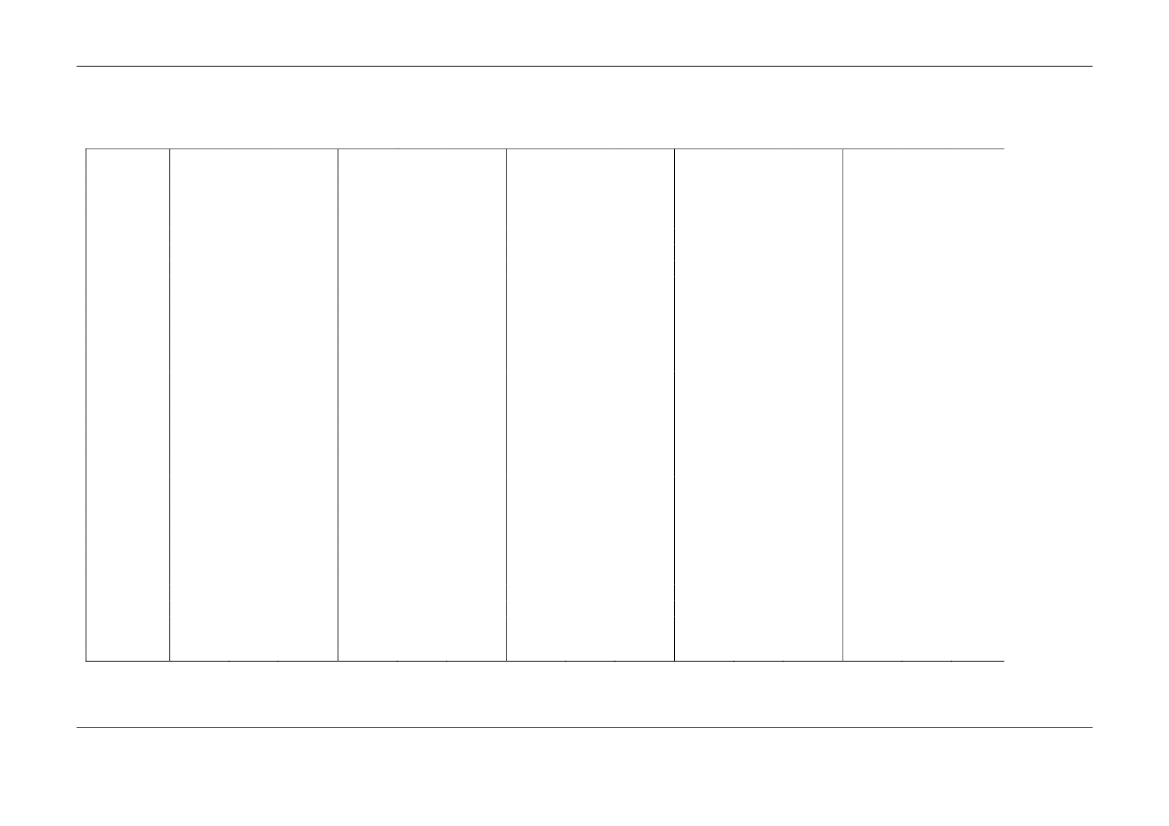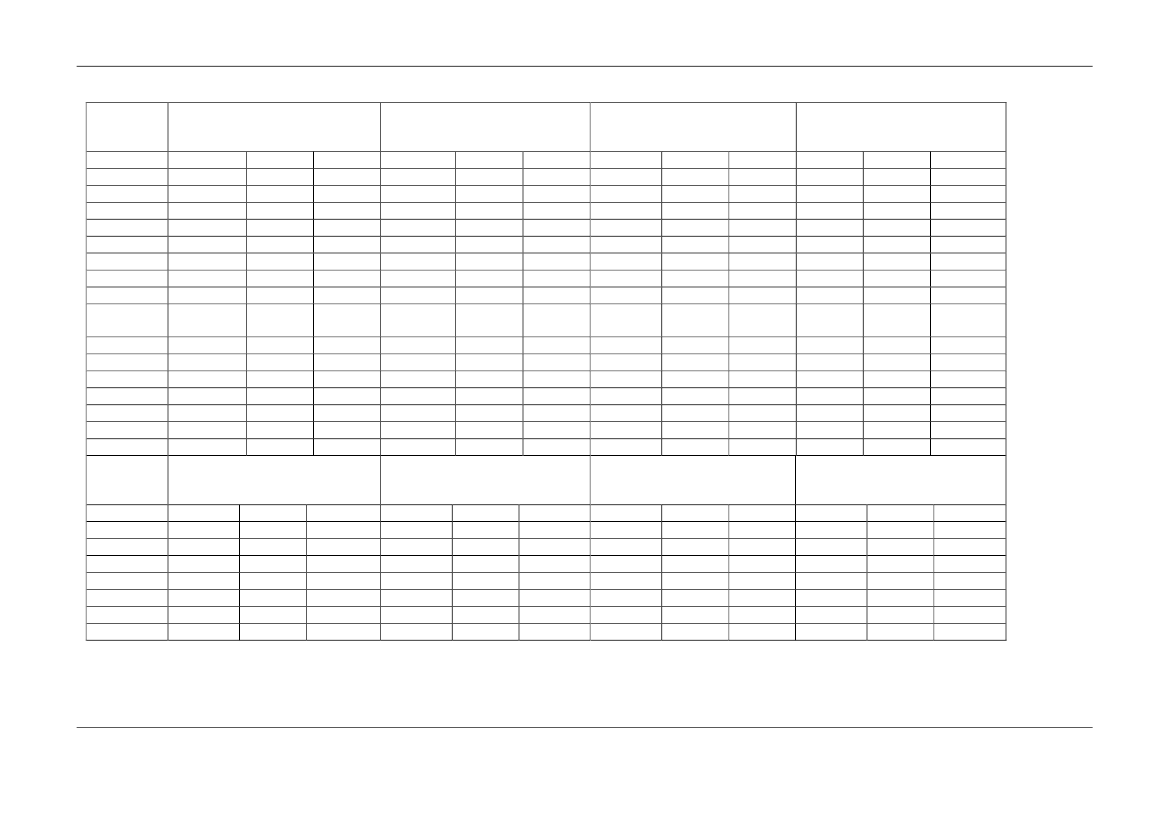Udvalget for Fødevarer, Landbrug og Fiskeri 2011-12
FLF Alm.del Bilag 343
Offentligt
DG MARE 2011/01/Lot 3 - SC1
KIR95R01E1
This report has been prepared with the financial support of the European Commission.The views expressed in this study are those of the authors and do not necessarily reflect the views of theEuropean Commission or of its services.The content of this report may not be reproduced, or even part thereof, without explicit reference to the source.POSEIDON, MRAG, COFREPECHE & NFDS, 2012. - Ex-post evaluation of the current Protocol to theFisheries Partnership Agreement between the European Union and Republic of Kiribati, and ex-anteevaluation including an analysis of the impact of the future Protocol on sustainability, Framework contractMARE/2011/01 - Lot 3, specific contract n�01. Final report: final version, May 2012. Bruxelles, 138 p.COFREPECHE: 32 rue de Paradis, 75010 Paris, France.[email protected]Version: Final Report,final versionReport ref: KIR95R01E1Number of pages: 138 (all included)Date issued: 21 May 2012
ActionAuthors
SURNAMEMACFADYEN
First nameGraeme
OrganisationPositionPOSEIDONDirector /Team leader - Fisheries economistPOSEIDONDirector /Fisheries economistMRAGManaging Director /Senior fisheries expertPOSEIDONDirectorCOFREPECHEProject officersCOFREPECHEProjects DirectorCOFREPECHEDeputy Managing Director
CategoryI
BANKS
Richard
I
Peer review(draft final report)Proof readingEditionApprovalValidation
MEES
Chris
I
HUNTINGTONPICAULTLE FOLDEFAUXSILVA
TimDavidGwendalVincentJean-Pierre
IIIII
Consortium: COFREPECHE (leader) – MRAG – NFDS – POSEIDONPage iEx-post evaluation of the current protocol to the FPA between the EU and Kiribati, and ex-ante evaluation with analysis of impacts of a futureprotocolFinal Report – final version
DG MARE 2011/01/Lot 3 - SC1
KIR95R01E1
Acronyms and abbreviationsACPADBAFADAERALCAUS$B/CBETCCMCCSCFPCICIFCMMCNMCPPLAfrican, Caribbean and PacificAsian Development BankAnchored FADAnnual Economic ReportAutomatic Location CommunicatorAustralian DollarBenefit/costBigeye TunaCommission Cooperating MemberCatch Certificate SchemeCommon Fisheries PolicyConservation InternationalCarriage Insurance and FreightinsINTERCOITIUUJCKDPkglbLDCMCSMDGSMFEDMFMRDmmmnMoUMPAMSYMTCMTUMYNEAOFPOPAGACORTHONGELPACPPAEPIPAPNAPNAOPNGPROCFISHRERFInchesInternational Code of SignalsInformation TechnologyIllegal, Unregulated or UnreportedJoint CommitteeKiribati Development PlanKilogrammesPoundsLesser Developing CountryMonitoring, Control and SurveillanceMillennium Development GoalsMinistry of Finance and EconomicDevelopmentMinistry of Fisheries and MarineResources DevelopmentmillimetersmillionMemorandum of UnderstandingMarine Protected AreaMaximum Sustainable YieldMinimum Terms and ConditionsMobilisation Transmission UnitManagement YearNew England AquariumOceanic Fisheries ProgrammeOrganización de Productores Asociadosde Grandes Atuneros CongeladoresOrganisation de Producteurs de ThonCongeléPacific ACPsParty Allowable EffortPhoenix Islands Protected AreaParties to the Nauru AgreementParties to the Nauru Agreement OfficePapua New GuineaPacific Regional Coastal FisheriesDevelopment ProgrammeRevenue Equalisation Reserve Fund
Conservation and Management MeasuresCommission Non Cooperating MemberCentral Pacific Producers LimitedCommittee of Representatives ofCRGAGovernments and AdministrationsCRISP Coral Reef Initiative for the PacificDCFData Collection FrameworkDCRData Collection RegulationDEVFI The Development of Tuna Fisheries in theSHPacific ACP Countries ProjectDFADDGMAREDWFNEAFMEBITECEDFEEZENSOEPEPAEPODrifting FADDirectorate General for Maritime Affairsand FisheriesDistant Water Fishing NationsEcosystem Approach to FisheriesManagementEarnings Before Interest and TaxEuropean CommissionEuropean Development FundExclusive Economic ZoneEl Niño Southern OscillationEuropean ParliamentEconomic Partnership AgreementEastern Pacific Ocean
Consortium: COFREPECHE (leader) – MRAG – NFDS – POSEIDONPage iiEx-post evaluation of the current protocol to the FPA between the EU and Kiribati, and ex-ante evaluation with analysis of impacts of a futureprotocolFinal Report – final version
DG MARE 2011/01/Lot 3 - SC1
KIR95R01E1
EUFFADFAMEFAOFFAFFCFMISFMSYFOBFPAFSMFSMAFTEGATTGDPGSPHSHSPIAIATTCIEOIEPAIMF
European UnionFishing mortalityFish Aggregation DeviceFisheries, Aquaculture and MarineEcosystemsFood and Agriculture OrganisationForum Fisheries AgencyForum Fisheries CommissionFisheries Monitoring Information SystemFishing mortality rate that would giveMaximum Sustainable YieldFree OnBoardFisheries Partnership AgreementFederated States of MicronesiaFSM ArrangementFull Time EquivalentGeneral Agreement on Tariffs and TradeGross Domestic ProductGeneralised System Of PreferencesHigh SeasHigh Seas PocketsImplementing AgreementInter-American Tropical Tuna CommissionInsituto Español oceanograficoInterim Economic Partnership AgreementInternational Monetary Fund
Regional Fisheries ManagementOrganisationRMIRepublic of the Marshall IslandsScientific Support for the ManagementSCICOFISH of Coastal and Oceanic Fisheries in thePacific Islands RegionSEAPODY Spatial Ecosystem and PopulationsMDynamics ModelSIDSSmall island developing statesRFMOSJKSMACFishSOESPCTAETCCTUFMAWUNICEFUNFSAUS$USLMTVDSVDSCVMSWCPWCPFCWCPOWTOYFTSkipjack TunaSustainable Management of Aquacultureand Coastal Fisheries in the PacificRegion for Food Security and Small-scale LivelihoodsState Owned EnterpriseSecretariat of the Pacific CommunityTotal Allowable EffortTechnical and Science CommitteeTuna Fisheries Database ManagementSystemUnited Nations International Children'sEmergency FundUnited Nations Fish Stocks AgreementUnited States DollarUnited States Multi-Lateral TreatyVessel Day SchemeVessel Day Scheme CommitteeVessel Monitoring SystemWestern Central PacificWestern Central Pacific CommissionWestern Central Pacific OceanWorld Trade OrganisationYellowfin Tuna
Consortium: COFREPECHE (leader) – MRAG – NFDS – POSEIDONPage iiiEx-post evaluation of the current protocol to the FPA between the EU and Kiribati, and ex-ante evaluation with analysis of impacts of a futureprotocolFinal Report – final version
DG MARE 2011/01/Lot 3 - SC1
KIR95R01E1
Currency Exchange Rates used in this report (www.oanda.com)€1 =2007200820092010US$1.351.581.411.22AUS$1.591.641.741.44
20111.451.35
20121.341.25
Rates are mid-year rates, except for 2012 which is rate at time of writing (Feb/March 2012)
AcknowledgementsThe consultants are grateful to all stakeholders who shared their time, thoughts, information and data with theconsulting team which completed this specific contract.
Consortium: COFREPECHE (leader) – MRAG – NFDS – POSEIDONPage ivEx-post evaluation of the current protocol to the FPA between the EU and Kiribati, and ex-ante evaluation with analysis of impacts of a futureprotocolFinal Report – final version
DG MARE 2011/01/Lot 3 - SC1
KIR95R01E1
EXECUTIVESUMMARYINTRODUCTIONi.This report provides an ex-post evaluation of the current Protocol to the Fisheries Partnership Agreement(FPA) between the European Union and the Republic of Kiribati. It also provides an ex-ante evaluationand analysis of impacts of a potential future Protocol on sustainability. The evaluation covers the periodSeptember 2006 to March 2012. The FPA provides fishing opportunities for EU purse seine and longlinevessels to fish in the waters of Kiribati.
COUNTRY BACKGROUNDii.Kiribati is a remote Pacific nation made up of 33 widely dispersed islands (21 inhabited) divided intogroups (Gilbert Group, Phoenix Group and the Line Group) that straddle the equator. While the total landarea is only 726 km2, the related exclusive economic zone (EEZ) is the largest EEZ of the Pacific islandscountries at 3.55 mn km2. Kiribati’s population was 103,280 in 2011 and is almost entirely concentrated inthe Gilbert Islands. At the current population growth rate of 1.25 %, the population is expected to double inthe next 20 years. Kiribati is a sovereign democratic republic within the Commonwealth.The Kiribati economy faces significant constraints common to other island atoll states. Gross DomesticProduct (GDP) stands at€109mn (2010), expanding by an estimated 2-3 % per annum. GDP per capita isone of the lowest of the Parties to the Nauru Agreement (PNA) nations at€1,047and Kiribati is classifiedas a least developed African, Caribbean and Pacific (ACP) State. Challenges to economic developmentinclude size, remoteness and geographical fragmentation, infertile soils, limited exploitable resources andan expanding population. A major distinctive feature of national resources is the Revenue EqualisationReserve Fund (RERF) with a value of around€410mn (in 2011). Initially established from royalties fromphosphate mining, the RERF is used to fund fiscal deficits. The Kiribati Development Plan (KDP) 2008–2011 builds upon the previous National Development Strategy 2004–2007 with actions to address fiscalmanagement, population growth, and improved access to international labour markets. While progress inimplementation has been slow, the strategic focus remains: (i) improving the economic environment in theouter islands, particularly Kiritimati (Christmas Island); (ii) strengthening access to health services; and (iii)addressing climate change.Kiribati relies heavily on licence fees from distant water fishing nations (worth an annual average of€24.4mn in the period 2009 - 2011) that provide 23-30 % of government revenue and remittances from Kiribaticitizens employed abroad, mainly as seafarers. Fishing is also an important subsistence activity, with over80 % of households involved in fishing. Fish consumption per capita per year is high by global and Pacificstandards (between 72 kg and 207 kg for the entire country). The fishing sector contributes around 10 %of GDP. Kiribati has bilateral fisheries arrangements with the European Union, Japan, Taiwan, and theRepublic of Korea, as well as private company agreements with vessels from Ecuador and El Salvador.Kiribati also receives revenue from a multilateral treaty signed with the United States.EU relations with the Pacific ACP countries, based on the Lome Conventions and the Cotonou Agreementhave been aimed at supporting stabilisation following decolonisation, while at the same time supportingeconomic and social progress. At the regional level the 10th European Development Fund (EDF) (2008-2013) includes as a priority the sustainable management of natural resources and the environment, withsupport to programmes under the Forum Fisheries Agency (FFA) and Secretariat of the PacificCommunity (SPC). While Kiribati benefits from regional initiatives, fisheries remain outside the 10th EDFCountry Strategy Paper and National Indicative Programme for Kiribati. Fisheries-specific support isinstead provided through the sectoral policy support component of the FPA. The Kiribati fisheries sectoralso benefits from regional initiatives by other donors (notably Australia, New Zealand and the US) andnational support under the Australian-Kiribati Partnership for development.In September 2004, the EU and 14 Pacific ACP countries, including Kiribati, opened negotiations on anEconomic Partnership Agreement (EPA), which should eventually replace the preferential access schemeConsortium: COFREPECHE (leader) – MRAG – NFDS – POSEIDONPage vEx-post evaluation of the current protocol to the FPA between the EU and Kiribati, and ex-ante evaluation with analysis of impacts of a futureprotocolFinal Report – final version
iii.
iv.
v.
vi.
DG MARE 2011/01/Lot 3 - SC1
KIR95R01E1
contained in the Cotonou Agreement that expired at the end of 2007. EPA negotiations are still inprogress. Whilst there is presently no trade in fishery products between Kiribati and the EU, the countryhas future aspirations in trading fresh tuna loins.
TUNA FISHERIES INKIRIBATI AND THE REGIONvii.The Western and Central Pacific Ocean (WCPO) is the main fishing ground for tunas, accounting foraround 60 % of world catches. Total WCPO tuna catch for 2010 was estimated at 2.28 mn tonnes, with thepurse seine fishery accounting for 80 %, pole-and-line fishing 6.5 %, and longline fishing about 6 %. EUpurse seine vessels account for 2 % of catches in the WCP.Purse seine fishing expanded rapidly during the 1980s, mainly through the operations of Japanese and USfleets. More recently the composition of the fleet became more diverse, with an expansion to include otherAsian fishing nations, New Zealand and EU vessels. Vessels predominantly target skipjack tuna (81 % ofthe total catch) along with yellowfin (17 %) and bigeye (2 %) and overall dependency on free school fishinghas increased over the years. Access to fishing by distant water purse seine vessels takes the form ofregional or bilateral fisheries partnership arrangements or agreements, including: bilateralintergovernmental agreements; EU FPAs; commercial agreements between associations or companies;individual agreements between countries which are Parties to the Nauru Agreement (PNA); and the USTuna Treaty.The longline fishery catches mainly yellowfin and bigeye tunas, but also albacore, billfish, swordfish andother species including pelagic and reef sharks. The total number of vessels involved in the tropicalWCPO fisheries has generally been around 3,000. European longliners operate primarily south of 20�S,outside the tropical area and the EU longline vessels have never fished in Kiribati waters. Together EUlongliners account for less than 1 % of total WCPO longline catches.The status of the three main tuna stocks exploited in the WCP equatorial area is monitored by theScientific Committee installed under the Western Central Pacific Commission (WCPFC) (the tuna RegionalFisheries Management Organisation (RFMO) for the WCPO). Currently skipjack is being exploited atmoderate levels and overfishing is not occurring, yellowfin is currently fully exploited and there is a 50 %chance that overfishing is occurring, and recent assessments show that overfishing of bigeye tuna iscurrently occurring with present catch levels unlikely to be sustainable.The key governance and fishery management organisations for tuna and related species in the WCPO,and the tuna purse seine fisheries in particular include: The WCPFC; The Parties to the Nauru Agreement(PNA); Regional organisations that provide management services to the WCPFC and the PNA, inparticular the Forum Fisheries Agency (FFA) based in Solomon Islands, and the SPC based in NewCaledonia; and the PNA national governments. A number of WCPFC Commission Management Measures(CMMs) have been formulated in the annual sessions of the Commission. The PNA has also introduced aVessel Day Scheme (VDS) for the Management of the Western Purse Seine Fishery, with Party AllowableEffort (PAE) days allocated to PNA countries, and agreed that a minimum fee of US$5,000 /€3,450perfishing day shall be applied to foreign fishing vessels from 2012 onwards.Within Kiribati itself, the Kiribati Development Plan focus for fisheries includes maximizing the sustainableeconomic benefits from the tuna resource; conserving coastal resources in the face of rising demand forfood and cash incomes; and managing the transition from government research to commercial productionand export. Overriding governance priorities are identified as: maintaining close collaboration with the PNAand FFA and to obtain maximum sustainable EEZ access fees; promoting public-private partnerships withreputable foreign investors in catching and onshore domestic processing of tuna; conducting participatoryeducation programmes with fishers and communities engaged with vulnerable species/stocks; andensuring legal sanctions are observed to enforce the conservation regime and prosecute when necessary.Responsible for this is the Ministry of Fisheries and Marine Resources Development with a staff of 115.Kiribati has established the Phoenix Islands Protected Area (PIPA) which is one of the largest MarineProtected Areas (MPAs) in the Pacific at 408,250 km�.Consortium: COFREPECHE (leader) – MRAG – NFDS – POSEIDONPage viEx-post evaluation of the current protocol to the FPA between the EU and Kiribati, and ex-ante evaluation with analysis of impacts of a futureprotocolFinal Report – final version
viii.
ix.
x.
xi.
xii.
DG MARE 2011/01/Lot 3 - SC1
KIR95R01E1
EVALUATIONxiii.The Protocol provides for 4 purse seine fishing authorisations (1 for France and 3 for Spain), and 12longline fishing authorisations, evenly split between Portugal and Spain. Apart from two longline fishingauthorisations taken during the first year of the FPA there has been 0 % utilisation of the longline fishingauthorisation possibilities, and no longline catches made during the FPA. On the other hand utilisation ofthe 4 purse seine fishing authorisations has been 100 % for each of year of the FPA, and utilisation ofcatch possibilities in excess of 100 % each year of the FPA. In 2011 catch utilisation is expected to exceed200 % of the reference tonnage of 6,400 tonnes for the first time.Payments made to Kiribati during the FPA have averaged€1.2mn per year, with 2/3 paid by the EU and1/3 by vessel owners. The average payment over 2007 to 2011 was€3,350/ US$4,675 a day i.e. close tothe current PNA benchmark price of US$5,000/day.The covenants and obligations of the FPA and Protocol are generally being complied with by all parties.However some areas of concern include: the failure of the Joint Committee (JC) meetings to take placeuntil 2011; the slow payments in recent years for the financial support for the sectoral policy; the failure byKiribati to supply inspection certificates and observer reports to shipowners; and the lack of any realimpetus towards joint enterprises or local landings for processing.The economic analysis of the Protocol shows that ex-vessel fish prices are lower than internationalstandards, probably due to smaller fish sizes caught in the FAD fishery, but that fish prices have risen byaround 50 % over the period of the evaluation. Given the increasing trend in catches made in Kiribati overthe evaluation period, the landed value of fish caught under the Protocol also shows a rising trend and in2010 exceeded€14million.A total of€6.4mn of value-added is accrued each year when considering the benefits to both theEuropean Union and Kiribati. 75 % of this accrues to the EU and 25 % to Kiribati. EU value-added is mostprominent in the catching and upstream sectors, and less marked in downstream processing. In Kiribativalue-added is almost entirely focused in the upstream/input sub-sector, principally in the form ofpayments made to the Government for access and sectoral support, but also from vessel support servicesi.e. transshipment. Some small value-added is made through the employment of Kiribati crew andobservers.In terms of costs and benefits, for the EU as a whole the Protocol generated an average annualbenefit/cost (B/C) ratio of 4.0, demonstrating that the Protocol provides good value for money with every€1invested by the EU and fleet owners generating€4.0of benefit in terms of value-added. The cost ofaccess for vessel owners (€35/tonne) represents 4.1-4.4 % of the average weighted sales prices receivedfor catches made under the Protocol. Annual average catch values made under the Protocol are€9.5mn,and vessel profits as a proportion of sales revenues range between 11 % and 23 % for the two vesselclasses (84m and 100+m). The benefits to Kiribati were€1.2mn per year on average from the EU, plussmaller benefits in the form of value-added made from port calls by EU vessels and from local crew andobservers onboard EU vessels.The contribution of catch made under the Protocol to the EU processing sector was small at around 2 % ofloined imports to the EU in 2010, while fish caught under the Protocol and imported to the EU in cannedform represented around 1 % of EU imports of canned tuna in 2010.The employment generated by the Protocol is estimated at 98 Full-Time Equivalent (FTE) jobs. Thisemployment generation represents 116 tonnes of fish caught under the Protocol for every job, and€23,810of payments by the EU and vessel owners for every one job. Employment creation is dividedroughly equally between the EU and Kiribati. The social clause elements of the Protocol in terms of wagelevels, seamen having contracts, etc., are being fully complied with.
xiv.
xv.
xvi.
xvii.
xviii.
xix.
xx.
Consortium: COFREPECHE (leader) – MRAG – NFDS – POSEIDONPage viiEx-post evaluation of the current protocol to the FPA between the EU and Kiribati, and ex-ante evaluation with analysis of impacts of a futureprotocolFinal Report – final version
DG MARE 2011/01/Lot 3 - SC1
KIR95R01E1
xxi.
xxii.
xxiii.
xxiv.
xxv.
xxvi.
With respect to effectiveness, the EU fleet plays only a small role in terms of overall fleet activity in bothKiribati and WCP. Its ability to impact on responsible fishing is therefore limited. However some concernsare noted in relation to responsible fishing in terms of high percentages of catches being comprised ofbigeye tuna (which is assessed as being over-exploited), vessel discards, vessels exceeding high seasdays limits, bycatch of pelagic sharks, and weaknesses in MCS capacity in Kiribati. The Protocol has beeneffective in supporting the EU catching sub-sector in particular, but not in creating any joint enterprises orany significant developments of the Kiribati fish catching or processing sub-sectors, due largely to theeconomics of doing so. As noted above, the Protocol has also been effective in creating someemployment in both the EU and Kiribati.With respect to efficiency, the Protocol has been efficient for the EU in providing access at an affordablerate for EU vessels owners, and in generating a good benefit/cost ratio of 4.0. But the cost per EU job hasbeen€23,810.For Kiribati, payments made by the EU under the Protocol have represented 4-7 % ofnational fishing licence revenue and 1-2 % of total annual government revenues.The Protocol has significantly contributed to the viability and sustainability of the EU purse seine catchingsub-sector operating in the Pacific and its related employment, but has made no contribution to thesustainability of the longline sector, and only small contributions to the sustainability of the EU upstreamand processing sub-sectors. The Protocol does not appear to threaten the sustainability of the Kiribatifishing sector. The Protocol has not however been successful in resulting in any sustainable joint catchingsub-sector operations, or in making any contributions to sustainable Kiribati processing sector operations,although has contributed to sustainable upstream/vessel support activities.The EU is a Commission Contracting Member to the WCPFC, and the Protocol is consistent with both theCFP and WCPFC policies management measures, as well as with the Food and AgricultureOrganisation’s (FAO) Code of Conduct for Responsible Fisheries, and with the International LabourOrganisation’s Declaration on Fundamental Principles and Rights at Work. There are no inconsistencies inthe Protocol text or its implementation, and EU trade policy. The Protocol is also consistent with nationalKiribati policy and national legislation. Perhaps the key issue of concern in relation to consistencyhowever, is the fact that the Protocol is a tonnage-based Protocol, with payments for access made pertonne. National Kiribati policy, in line with evolving regional initiatives, is now strongly in favour ofnegotiating and providing access based on vessel days.All of the above comments mean that the Protocol is relevant to the needs of the EU, and in particular toits purse seine fleet (although not to the longline fleet). The generation of access fees means the Protocolis also relevant to the needs of Kiribati. The Protocol does not however satisfy the needs/desires of Kiribatias expressed to the consultants to have a Protocol which is structured around paying for access based onvessel days, although this desire has not been formally expressed to the EU. This is explained by the factthat the VDS was not in place when the Protocol was negotiated, but has evolved in recent years. Inaddition, while the Protocol has an objective for the creation of joint enterprises and support for localprocessing activity, which satisfies the needs of Kiribati, implementation of the Protocol has not managedto bring about any such activity or to satisfy these needs and aspirations.Looking forward to a potential future Protocol, potential new management measures being considered inthe region to improve the management regime (e.g. a one month extension of the Fish AggregationDevice (FAD) closure, an increase in minimum mesh sizes, closure of the Phoenix Island Protected Areato fishing, high seas closures around the Kiribati EEZ) would have a negative impact on the activities andprofitability of EU purse seine vessels. Other changes which could have an impact if mandated by theWCPFC include potential changes in crewing requirements to 10 % and then 20 % being from PNAcountries – this would require changes to the text of the Protocol to ensure coherence, as the textcurrently states a minimum of 6 crew on the fleet of purse seiners, which represents around 5 % of currentvessel crew numbers (this figure is exceeded by the EU fleet, with around 9 % of total crew alreadysourced from Kiribati).Consortium: COFREPECHE (leader) – MRAG – NFDS – POSEIDONPage viiiEx-post evaluation of the current protocol to the FPA between the EU and Kiribati, and ex-ante evaluation with analysis of impacts of a futureprotocolFinal Report – final version
DG MARE 2011/01/Lot 3 - SC1
KIR95R01E1
xxvii.
It is likely that a future Protocol would generate considerable levels of value-added to both the EU and toKiribati, but few changes in employment or the balance of value-added creation between the EU andKiribati. It would be in the interest of both the EU and Kiribati to have a new Protocol. For the EU fleet a ‘noProtocol’ would cause fishing rights as a proportion of sales revenues to rise considerably, while forKiribati a failure to sign a new Protocol would eliminate the ear-marked funds for special sectoral supportprovided by the EU under the Protocol, and could result in under-utilisation of Kiribati’s PAE days underthe VDS.
RECOMMENDATIONSxxviii.The recommendations made in this report are necessarily brief, given that it is not the job of theconsultants to present a strategy to the EU for negotiation, but rather to provide the EU negotiators withthe economic data to prepare for the negotiations. Thus the principal recommendation made is to base thenegotiations on the economic and social data provided in this report, and to ensure that there is indeedsignature of a new Protocol.The ongoing CFP reform also means that there is as yet, not clear direction or guidance on changing thebalance of access payments per tonne between the EU and fleet owners, and the current balance shouldtherefore be retained.From a purely technical perspective, this evaluation recommends that the longline fishing opportunities beremoved from the Protocol, given the fact that there have been zero catches made by the longline fleetunder the Protocol. However a final decision on this issue would also need to reflect the political wishesand agreement by EU Member States.Given the high level of juvenile bigeye tuna catches taken in the FAD fishery by the EU fleet, theevaluation also recommends that direct measures should be included in the Protocol (and Annex) tomitigate against this problem. Such measures should be agreed jointly by all parties, but could include theuse of, and reporting on, FAD management plans.The levels of payments in a future Protocol, and the basis on which they are paid (e.g. tonnage or vesseldays), will be the subject of negotiation, but should be informed by recent catch levels, rates of utilisation,and fish prices.A recommendation is made for greater emphasis and recognition by all parties of the importance of theJoint Committee meetings. These meetings represent a vital monitoring mechanism for implementation ofthe FPA – a mechanism which has historically not been especially effective. The Joint Committeemeetings must be yearly as required in the text of the FPA, and should be used both to review sectoralpolicy implementation, and to ensure ongoing compliance with the covenants and obligations laid out inthe FPA and Protocol (and necessary action if such compliance is found to be lacking). Current areas ofweakness in compliance with other covenants and obligations required in the FPA and Protocol shouldalso be addressed as a matter of urgency.The evaluation recommends that focus be given to the issue of strengthening MCS capacity in Kiribati. Forexample, FPA sectoral funds, and other EU development support, could be used to enhance observercapacities so as to ensure mutual recognition by WCPFC and Inter-American Tropical Tuna Commission(IATTC) of each other’s observers. The evaluation also recommends greater recognition by EUdevelopment projects of the important nature of the Kiribati FPA, and therefore for the use of funds tosupport Kiribati. The view of this evaluation is that there should be a special effort to better align sectoralpolicy support provided by the FPA with other EU development aid in a mutually enforcing manner, whilebeing careful to avoid duplication. This could be supported by the appointment of a fisheries attaché to theEU Delegation in Fiji, and the EU is believed to be in process of recruiting someone to such a position.Finally, the evaluation notes the importance of the EU continuing to engage actively with the WCPFC inefforts to ensure responsible fisheries in the WCPO. As part of this process, given some of theweaknesses identified in the evolving VDS system, the evaluation recommends that the EU supports theestablishing of target and limit reference points for tuna stocks, so as to ensure the integrity of the schemeby linking stock status to the management system.Consortium: COFREPECHE (leader) – MRAG – NFDS – POSEIDONPage ixEx-post evaluation of the current protocol to the FPA between the EU and Kiribati, and ex-ante evaluation with analysis of impacts of a futureprotocolFinal Report – final version
xxix.xxx.
xxxi.
xxxii.xxxiii.
xxxiv.
xxxv.
DG MARE 2011/01/Lot 3 - SC1
KIR95R01E1
RÉSUMÉINTRODUCTIONi.Ce rapport fournit une évaluation ex-post du protocole de l’Accord de Partenariat dans le secteur de laPêche (APP) entre l’Union européenne (UE) et la République de Kiribati (ci-après citée ‘Kiribati’). Ilprocure également une évaluation ex-ante et une analyse d’impacts en termes de durabilité d’un possiblefutur protocole. L’évaluation couvre la période de septembre 2006 à mars 2012. L’APP garantit desopportunités de pêche pour les senneurs et les palangriers de l’UE dans les eaux de Kiribati.
CONTEXTE DU PAYSii.Kiribati est une nation éloignée du Pacifique, constituée de 33 îles fortement dispersées (dont 21habitées) divisées en groupes d’îles (îles Gilbert, îles Phénix et îles de la Ligne) et chevauchantl’équateur. Alors que la superficie des terres émergées est de seulement 726 km2, la Zone ÉconomiqueExclusive (ZEE) associée est la plus vaste ZEE des pays insulaires du Pacifique avec 3,55 millions dekm2. La population de Kiribati était de 103 280 habitants en 2011 et est presque exclusivement concentréedans les Îles Gilbert. Au taux de croissance démographique actuel de 1,25 %, il est prévu que lapopulation double dans les 20 prochaines années. Kiribati est une république démocratique souveraineparmi le Commonwealth.L’économie de Kiribati fait face à des contraintes non négligeables communes à d’autres états atoll. LeProduit Intérieur Brut (PIB) est de 109 millions d’euros (2010), avec une croissance estimée de 2- 3 % paran. Le PIB par habitant par an est parmi les plus bas des Parties à l’Accord de Nauru, PAN (en anglais,PNA) à 1 047€et Kiribati est classé dans les états ACP (Afrique, Caraïbes, Pacifique) les moinsdéveloppés. Les contraintes limitant son développement économique incluent la taille de l’archipel,l’isolement et la fragmentation géographique, l’infertilité des sols, les ressources exploitables limitées etune population croissante. Un aspect majeur et distinct des ressources nationales est le fonds de réserved’égalisation de revenu (en anglais, RERF) ayant une valeur d’environ 410 millions d’euros (en 2011).Etabli initialement à partir des redevances issues des mines de phosphate, le fonds de réserve RERF estutilisé pour compenser les déficits fiscaux. Le Plan de Développement de Kiribati 2008-2011 se base surla précédente Stratégie de Développement National 2004-2007 avec des actions ciblant la gestion fiscale,la croissance de la population et un accès amélioré aux marchés du travail internationaux. Alors que lamise enœuvrea été lente, la stratégie reste focalisée sur : (i) améliorer le contexte économique dans lesîles périphériques, particulièrement Kiritimati (île Christmas) ; (ii) renforcer l’accès aux services de santé ;et (iii) gérer les effets de changement climatique.Kiribati est fortement dépendante des droits de licences de pêches lointaines d’autres nations (valeurmoyenne de 24,4 millions d’euros dans la période 2009 - 2011) qui procurent 23 – 30 % des recettes del’état ainsi que des envois de fonds des citoyens de Kiribati employés à l’étranger, principalement en tantque marins. La pêche est aussi une activité de subsistance importante, avec plus de 80 % des foyersimpliqués dans le secteur. La consommation annuelle de poisson par habitant est élevée selon lesstandards mondiaux et les standards du Pacifique (variant entre 72 kg et 207 kg dans l’ensemble dupays). Le secteur de la pêche contribue à 10 % du PIB. Kiribati a signé des accords de pêche bilatérauxavec l’Union Européenne, le Japon, Taiwan, et la République de Corée ainsi que des accords privés avecdes navires venant d’Équateur et du Salvador. Kiribati re§oit aussi des revenus du traité multilatéral signéavec les États-Unis.Les relations de l’UE avec les états ACP du Pacifique, basées sur les Conventions de Lomé et lesAccords de Cotonou visent à renforcer la stabilité suite à la décolonisation, tout en favorisant le progrèséconomique et social. Au niveau régional le 10ème Fonds Européen de Développement, FED (2008 -2013) inclut en tant que priorité la gestion durable des ressources naturelles et de l’environnement, avecl’appui de programmes sous l’égide de l’Agence des Pêches du Forum des îles du Pacifique(communément nommé par son acronyme anglais FFA) et le Secrétariat Général de la Communautés duConsortium: COFREPECHE (leader) – MRAG – NFDS – POSEIDONPage xEx-post evaluation of the current protocol to the FPA between the EU and Kiribati, and ex-ante evaluation with analysis of impacts of a futureprotocolFinal Report – final version
iii.
iv.
v.
DG MARE 2011/01/Lot 3 - SC1
KIR95R01E1
vi.
Pacifique (SCP). Alors que Kiribati bénéficie d’initiatives régionales, les pêcheries restent exclues duDocument de stratégie et du Programme Indicatif National du 10ème FED. L’appui spécifique auxpêcheries se fait plutôt à travers de la composante de l’APP d’appui de mise enœuvred’une politiquesectorielle. Le secteur de la pêche de Kiribati bénéficie aussi d’initiatives régionales par d’autresdonateurs (notamment l’Australie, la Nouvelle Zélande et les États-Unis) ainsi qu’un soutien national sousle Partenariat pour le développement entre l’Australie et Kiribati.En septembre 2004, l’Union européenne et 14 pays ACP du Pacifique, dont Kiribati, ont ouvert desnégociations sur un Accord de Partenariat Économique, APE, qui devrait à terme remplacer le régimed’accès préférentiel, ayant expiré à la fin de 2007 et contenu dans l’Accord de Cotonou. Les négociationssur l’APE sont toujours en cours. Alors qu’il n’y a pas actuellement de transactions de produits de la pêcheentre Kiribati et l’UE, le pays a des aspirations futures portant sur le commerce de longes de thon frais.
LA PECHE AUX THONS AKIRIBATI ET DANS LA REGIONvii.L’Océan Pacifique occidental et central, OPOC est la zone de pêche principale pour le thon, représentantautour de 60 % des prises mondiales. La prise totale de thon au sein de l’OPOC pour 2010 a été estiméeà 2,28 millions de tonnes, dont 80 % sont représentés par la pêcherie des thoniers senneurs, 6,5 % parles canneurs et environ 6 % par les palangriers. Les navires senneurs européens représentent 2 % desprises dans le Pacifique occidental et central, POC.La pêche à la senne a connu un essor rapide dans les années 1980, principalement par le biais desopérations de flottes japonaises et américaines. Plus récemment la composition de la flotte s’estdiversifiée, avec une augmentation, pour inclure d’autres nations de pêche asiatiques, la Nouvelle-Zélande et les navires européens. Les navires ciblent préférentiellement le listao (81 % de la capturetotale) en parallèle avec l’albacore (17 %) et le thon obèse (2 %) ; la dépendance globale de la pêche surbanc libre a augmenté au fil des années. L’accès à la pêcherie par des navires de pêche lointaine à lasenne prend la forme d’arrangements ou d’accords de partenariat de pêche régionaux ou bilatéraux,incluant : des accords bilatéraux intergouvernementaux, des APP avec l’UE, des accords commerciauxentre associations ou sociétés, des accords individuels entre pays Parties à l’Accord de Nauru (PAN) et letraité américain portant sur le thon (USTuna Treaty).La pêcherie palangrière capture principalement de l’albacore et du thon obèse, mais aussi du germon, despoissons à rostre (e.g. espadons) ainsi que d’autres espèces dont des requins pélagiques et de récifs. Lenombre total de navires impliqués dans les pêcheries tropicales de l’OPOC a généralement été de3 000.Les palangriers européens opèrent principalement au sud de 20�S, en dehors de la zone tropicale et lesnavires palangriers de l’UE n’ont jamais pêché dans les eaux de Kiribati. Ensemble les palangrierseuropéens représentent moins de 1 % des captures totales à la palangre dans l’OPOC.L’état des trois principaux stocks exploités dans la zone équatoriale du POC est surveillé par le ComitéScientifique installé sous la Commission des Pêches du Pacifique occidental et central, CPPOC (enanglais, WCPFC), organisation de gestion régionale des pêches thonières, ORGP, pour l’OPOC. Le listaoest actuellement exploité à des niveaux modérés sans cas de surpêche. L’albacore est actuellementexploité pleinement avec une probabilité de 50 % que de la surpêche ait lieu. Des évaluations récentesmontrent que la surpêche de thon obèse est avérée avec des niveaux de capture ayant peu de chanced’être durables.Les organisations clés de gestion et de gouvernance pour le thon et les espèces associées au sein del’OPOC, et pour les pêcheries à la senne en particulier, comprennent : la CPPOC, les PAN, en particulierla FFA basée aux Îles Salomon, le SCP basé en Nouvelle Calédonie et les gouvernements nationaux desPAN. Un certain nombre de Mesures de Gestion de la Commission (CommissionManagement Measures,CMMs) ont été formulées durant les sessions annuelles de la Commission. Les PAN ont aussi présentéun régime de contrôle par jours de mer par navire,Vessel Day Scheme(VDS) pour la gestion des pêchesà la senne du Pacifique ouest, avec des jours d’effort autorisés par partie (PartyAllowable Effort,PAE)alloués aux pays PAN, et se sont mises d’accord pour qu’un tarif minimum de 5 000 US$/ 3 450€par jourde pêche soit appliqué aux navires étrangers à partir de 2012.Consortium: COFREPECHE (leader) – MRAG – NFDS – POSEIDONPage xiEx-post evaluation of the current protocol to the FPA between the EU and Kiribati, and ex-ante evaluation with analysis of impacts of a futureprotocolFinal Report – final version
viii.
ix.
x.
xi.
DG MARE 2011/01/Lot 3 - SC1
KIR95R01E1
xii.
À Kiribati même, les éléments centraux du Plan de Développement de Kiribati portant sur la pêcheincluent la maximisation des bénéfices économiques durables issus des ressources thonières, laconservation des ressources côtières face à la demande croissante en revenus alimentaires et enespèces, et la gestion de la transition d’une recherche gouvernementale à une production commerciale età l’exportation. Les objectifs majeurs de gouvernance sont identifiés comme étant : maintenir unecollaboration étroite avec les PAN et la FFA, obtenir des droits durables d’accès à la Zone d’ExclusivitéÉconomique (ZEE) à leur niveau maximum, promouvoir des partenariats public-privé pour les captures etla transformation domestique à terre du thon avec des investisseurs étrangers réputés, animer desprogrammes éducationnels participatifs avec des pêcheurs et des communautés engagées dans despêches sur des espèces/stocks vulnérables, et s’assurer que des sanctions légales soient appliquéespour mettre enœuvreles mécanismes de conservation, en engageant des poursuites lorsque nécessaire.Cette responsabilité incombe au Ministère des Pêches et du Développement des Ressources Marinesemployant 115 personnes. Kiribati a établi l’Aire Protégée des Îles Phénix (PhoenixIslands ProtectedArea,PIPA), qui est l’une des Aires Marines Protégées (AMPs) les plus vastes du Pacifique mesurant408 250 km2.
EVALUATIONxiii.Le protocole dispense de 4 autorisations de pêches à la senne (1 pour la France et 3 pour l’Espagne), et12 autorisations de pêche à la palangre partagées équitablement entre le Portugal et l’Espagne. À partdeux autorisations de pêche à la palangre prises durant la première année du protocole, il y a eu 0 %d’utilisation des possibilités de pêche à la palangre, et aucune capture à la palangre n’a été effectuéedurant le protocole. D’autre part, chaque année du protocole, l’utilisation des 4 autorisations de pêche à lasenne a été de 100 %, et l’utilisation des possibilités de captures en excès de 100 % chaque année duprotocole. En 2011, l’utilisation des captures est prévue de dépasser les 200 % du tonnage de référencede 6 400 tonnes pour la première fois.Les paiements effectués auprès de Kiribati durant le protocole ont été en moyenne de 1,2 millions d’eurospar an, dont les 2/3 payés par l’Union européenne (UE) et 1/3 par les armateurs des navires. Le paiementmoyen entre 2007 et 2011 était de 3 350€/4 675 US$ par jour, proche du seuil actuel de prix des PAN de5 000 US$ par jour.Les engagements et obligations de l’accord et de son protocole ont généralement été respectés par toutesles parties. Cependant, certains domaines de préoccupation comprennent l’échec de la tenue desréunions de Commission mixte jusqu’en 2011 ; la lenteur des paiements au cours des dernières annéesde l’appui financier à la politique sectorielle ; l’échec de la transmission par Kiribati de certificatsd’inspection et de rapports d’observateurs aux armateurs ; ainsi que l’ absence d’un élan réel vers dessociétés mixtes ou vers des sites de débarquement locaux pour la transformation.L’analyse économique du protocole montre que les prix de poissons en sortie navire sont plus bas que lesstandards internationaux, probablement en raison des tailles plus faibles de poissons capturés au seindes pêcheries sur DCPs (Dispositifs de Concentration de Poissons), mais les prix ont augmenté d’environ50 % durant la période de l’évaluation. Étant donné la tendance à la hausse des captures réalisées àKiribati durant la période de l’évaluation, la valeur au débarquement des poissons capturés dans le cadrede l’APP présente une tendance à la hausse et a dépassé 14 millions d’euros en 2010.Une valeur ajoutée totale de 6,4 millions d’euros est accumulée chaque année lorsque l’on prend encompte les bénéfices pour l’Union européenne et pour Kiribati. La valeur ajoutée est plus marquée pourl’UE en amont dans les secteurs de la capture, et moins marquée en aval de la transformation. À Kiribatila valeur ajoutée est presque entièrement concentrée dans le sous-secteur en amont, principalement sousforme de paiements au gouvernement de Kiribati pour l’accès et l’appui sous-sectoriel, mais dans lesservices d’appui aux navires, notamment le transbordement. Une petite plus-value est réalisée au traversde l’emploi d’équipages et d’observateurs de Kiribati.Consortium: COFREPECHE (leader) – MRAG – NFDS – POSEIDONPage xiiEx-post evaluation of the current protocol to the FPA between the EU and Kiribati, and ex-ante evaluation with analysis of impacts of a futureprotocolFinal Report – final version
xiv.
xv.
xvi.
xvii.
DG MARE 2011/01/Lot 3 - SC1
KIR95R01E1
En termes de coûts et bénéfices pour l’UE dans son ensemble le protocole a généré un ratio moyenbénéfices/coûts (B/C) de 1:4,6, démontrant que le protocole fournit un bon rapport qualité/prix ; chaqueeuro investi par l’UE et les armateurs générant 4,60€de bénéfice en termes de valeur ajoutée. Le coûtd’accès pour les armateurs (35€/tonne)représente 4,1 - 4,4 % du prix moyen des ventes à la pesée pourles captures réalisées sous le protocole. Les valeurs moyennes annuelles des captures réalisées dans lecadre du protocole sont proches de 9,5 millions d’euros, et les profits pour les navires en tant queproportion du revenu des ventes sont compris entre 11 % et 23 % pour les deux classes de navires (73 met 100+ m). Pour Kiribati, les bénéfices en provenance de l’UE étaient de 1,2 millions d’euros par an enmoyenne, s’y ajoutant des bénéfices plus faibles générés par la plus-value issue des escales portuairesdes navires de l’UE ainsi des équipages locaux et des observateurs à bord des navires de l’UE.xix.La contribution des captures réalisées dans le cadre du protocole au secteur de transformation de l’UE aété faible à environ 2 % d’imports de longes par l’UE en 2010, alors que le poisson capturé dans le cadredu protocole et importé par l’UE sous forme de conserves a représenté autour de 1 % des imports deconserves de thons par l’UE en 2010.xx.L’emploi généré par le protocole est estimé à 98 emplois en équivalent temps plein. Cette générationd’emploi représente 116 tonnes de poisson capturés sous le protocole pour chaque emploi et 23 810€enpaiements par l’UE pour chaque emploi. La création d’emploi est divisée approximativement en part égaleentre l’UE et Kiribati. Les clauses sociales du protocole en matière de niveaux de rémunération, de lanécessité pour les marins d’être sous contrat, etc., ont été complètement respectées.xxi.En ce qui concerne l’efficacité, la flotte de l’UE ne joue qu’un petit rôle sur le plan de l’activité de la flottetotale présente à Kiribati et dans le POC. Sa capacité à influencer une pêche responsable est donclimitée. Cependant, des préoccupations sont à noter en relation avec la pêche responsable. Elles portentsur le pourcentage élevé de captures composées de thon obèse (qui est estimé en surexploitation), lesrejets des navires, le navires dépassant le nombre de jours autorisé en haute mer, les capturesaccessoires de requins pélagiques, et les faiblesses en capacité de suivi, contrôle et surveillance (SCS)de Kiribati. Le protocole a été efficace dans son appui au sous-secteur UE des captures en particulier,mais ne l’a pas été dans la création de sociétés mixtes ou dans le développement significatif des sous-secteurs de capture ou de transformation de Kiribati, largement pour des raisons de coûts. Ainsi qu’il a étémentionné précédemment, le protocole a aussi été efficace dans la création de l’emploi tant pour l’UE quepour Kiribati.xxii.S’agissant de l’efficience, le protocole a été utile pour l’UE en fournissant un accès à un coût raisonnablepour les armateurs des navires de l’UE, et en générant un bon ratio bénéfice/coût de 4,6. Cependant lecoût par emploi de l’UE a été de 23 810€.Pour Kiribati, les paiements effectués par l’UE dans le cadre duprotocole ont représenté 4-7 % du revenu national des licences de pêche et 1-2 % du revenugouvernemental annuel total.xxiii.Le protocole a contribué de manière significative à la viabilité et à la durabilité du sous-secteur descaptures à la senne de l’UE opérant dans le Pacifique et de ses emplois liés, mais il n’a aucunementcontribué à la durabilité du secteur palangrier ; et a contribué faiblement à la durabilité des sous-secteursen amont et de transformation de l’UE. Le protocole ne semble pas menacer la durabilité du secteur de lapêche de Kiribati. Le protocole n’a cependant pas eu de succès dans le développement d’opérations decaptures par des sociétés mixtes, ni en contribuant durablement aux opérations du sous-secteur de latransformation de Kiribati, bien qu’il ait contribué aux activités durables en amont/de soutien aux navires.xxiv.L’UE est une partie contractante de la CPPOC, et le protocole est en cohérence avec à la fois les mesuresde gestion politiques de la Politique Commune des Pêches (PCP) et de la CPPOC, ainsi qu’avec le Codede Conduite pour des Pêcheries Responsables de la FAO (Foodand Agriculture Organisation),et avec laDéclaration de l’Organisation Internationale du Travail sur les Principes Fondamentaux et les Droits auTravail. Il n’y a pas d’incohérences entre le texte du protocole ou sa mise enœuvreet les politiquescommerciales de l’UE. Le protocole est aussi cohérent avec les politiques nationales et les législationsnationales de Kiribati. L’élément-clé de préoccupation au sujet de la cohérence pourrait cependant êtreque le protocole est basé sur le tonnage, avec des paiements par accès par tonne. La politique nationaleConsortium: COFREPECHE (leader) – MRAG – NFDS – POSEIDONPage xiiiEx-post evaluation of the current protocol to the FPA between the EU and Kiribati, and ex-ante evaluation with analysis of impacts of a futureprotocolFinal Report – final version
xviii.
DG MARE 2011/01/Lot 3 - SC1
KIR95R01E1
xxv.
xxvi.
xxvii.
de Kiribati, en accord avec des initiatives régionales en évolution, est maintenant fortement en faveurd’une négociation et de fournir des accès basés sur des jours de mer par navire.Tous les commentaires précédents signifient que le protocole est pertinent vis-à-vis des besoins de l’UE,et en particulier de ceux de sa flotte de pêche à la senne (bien que ne l’étant pas pour ceux de la flottepalangrière). La génération des droits d’accès signifie que le protocole est aussi pertinent aux besoins deKiribati. Le protocole ne satisfait cependant pas les besoins/souhaits de Kiribati d’avoir un protocolestructuré autour de paiements par accès basés sur des jours de mer, bien que ce souhait n’ait pasformellement été exprimé à l’UE. Ceci s’explique par le fait que le VDS n’était pas en place lorsque leprotocole était négocié mais qu’il a évolué dans les récentes années. De plus, alors que le protocole a unobjectif de création de sociétés mixtes et de soutien à l’activité locale de transformation, satisfaisant lesbesoins de Kiribati, la mise enœuvredu protocole n’a pas réussi à créer de telles activités ou à satisfaireces besoins et aspirations.En se projetant vers un éventuel futur protocole, de nouvelles mesures de gestion potentielles étantconsidérées dans la région pour améliorer le mode de gestion (ex : une extension d’un mois de la clôturedes Dispositifs de Concentration de Poissons (DCPs), une augmentation des tailles minimales demaillage, la fermeture à la pêche de l’Aire Protégée de l’Île Phénix, les fermetures de zones de haute merautour de la ZEE de Kiribati) auraient un impact négatif sur les activités et la profitabilité des naviressenneurs de l’UE. D’autres changements qui pourraient avoir un impact si mandatés par la CPPOCcomprennent des changements potentiels dans les exigences d’équipages à 10 % puis 20 % d’originesdes pays PAN – ceci nécessiterait des changements de texte du protocole afin d’assurer sa cohérence,puisque le texte actuellement cite un minimum de 6 hommes d’équipage dans la flotte de senneurs, ce quireprésente environ 5 % du nombre total de marins à bord (ce chiffre est dépassé par la flotte de l’UE avecenviron 9 % de l’équipage total déjà originaire de Kiribati).Il est probable que le futur protocole génère des niveaux conséquents de valeur ajoutée à la fois pour l’UEet Kiribati, mais peu de changements sur l’emploi ou la répartition de la création de valeur ajoutée entrel’UE et Kiribati. Il serait ainsi dans l’intérêt de l’UE et de Kiribati d’avoir un nouvel protocole. Pour l’UE, un« non protocole » signifierait une hausse importante des droits de pêche dans le revenus des ventes,pendant que pour Kiribati l’absence de signature d’un nouveau protocole éliminerait les fonds réservés àl’appui sectoriel spécial fourni par l’UE sous le protocole et pourrait résulter par une sous-utilisation desjours de PAE sous le VDS.
RECOMMANDATIONSxxviii.Les recommandations soumises dans ce rapport sont nécessairement brèves, puisque il n’est pas du rôledes consultants de présenter une stratégie à l’UE pour la négociation, mais plutôt de fournir à l’UE lesdonnées économiques pour préparer les négociations. C’est pourquoi la recommandation principale estde baser les négociations sur les données économiques et sociales fournies dans ce rapport afin des’assurer qu’il y ait ainsi signature d’un nouveau protocole.La réforme en cours de la PCP signifie aussi qu’il n’y a pas encore de direction ou d’orientation sur unchangement de ratio de droits d’accès à la tonne entre l’UE et les armateurs, et que le ratio actuel doitdonc être maintenu.D'un point de vue purement technique, cette évaluation recommande que les possibilités de pêche à lapalangre soient retirées du protocole, compte tenu du fait qu'il n'y ait eu aucune capture effectuées par laflottille palangrière au titre du protocole. Toutefois, une décision finale sur cette question devra égalementtenir compte des souhaits politiques et de l'aval des Etats membres de l'UE.Compte tenu du niveau élevé de juvéniles de thon obèse capturés dans la pêche sous DCPs par la flottede l'UE, l'évaluation recommande également que des mesures directes soient incluses dans le protocole(et son annexe) afin d'atténuer ce problème. Ces mesures devraient être adoptées conjointement partoutes les parties, mais pourrait inclure l'utilisation de, et des rapports sur des, plans de gestion des DCPs.Consortium: COFREPECHE (leader) – MRAG – NFDS – POSEIDONPage xivEx-post evaluation of the current protocol to the FPA between the EU and Kiribati, and ex-ante evaluation with analysis of impacts of a futureprotocolFinal Report – final version
xxix.xxx.
xxxi.
DG MARE 2011/01/Lot 3 - SC1
KIR95R01E1
xxxii.xxxiii.
xxxiv.
xxxv.
Les niveaux de paiements dans un futur protocole, et la base sur laquelle ils sont payés (ex. tonnage oujours de pêche des navires), seront sujets à négociation, mais devront être renseignés des niveaux decaptures récents, des taux d’utilisation et des prix du poisson.Une recommandation est exprimée pour une plus grande mise en évidence et reconnaissance par toutesles parties de l’importance des réunions de la commission mixte. Ces réunions représentent unmécanisme de suivi vital pour la mise enœuvrede l’APP – un mécanisme qui n’a pas été historiquementtrès efficace. Les réunions de la commission mixte doivent être annuels, tel que requis dans le texte del’APP, et devraient être utilisés pour revoir à la fois la mise enœuvredes politiques sectorielles et pours’assurer du respect des engagements et des obligations détaillées dans l’APP et le protocole (et lesactions nécessaires à un tel respect sont insuffisants). Les zones de faiblesse actuelles dans le respectdes autres engagements et obligations requises dans l’APP et le protocole devraient aussi être traitées enurgence.L’évaluation recommande que l’accent soit mis sur le renforcement de la capacité de suivi, contrôle etsurveillance (SCS) à Kiribati. Par exemple, les fonds sectoriels de l’APP, et autres appuis audéveloppement de l’UE, pourraient être utilisés pour augmenter les capacités d’observation afin d’assurerune reconnaissance mutuelle des observateurs de la CPPOC et de la Commission Inter-américaine duthon tropical (CIAT ; en anglais IATTC). L’évaluation recommande aussi une plus grande reconnaissancepar les projets de développement de l’UE de l’importance de l’APP avec Kiribati, et donc pour l’utilisationdes fonds d’appuis à Kiribati. Le point de vue de cette évaluation est qu’il devrait y avoir un effortparticulier pour mieux aligner l’appui à la politique sectorielle fournie dans le cadre de l’APP avec d’autresprojets de développement de l’UE de manière à se renforcer mutuellement tout en prenant garde à éviterdes duplications. Ceci pourrait être appuyé par la nomination d'un attaché à la pêche à la délégation del'UE aux îles Fidji, l'UE serait sous le processus de recruter pour pourvoir un tel poste.Enfin, l’évaluation note l’engagement actif de l’UE à collaborer avec la CPPOC dans le but de garantir despêches responsables au sein de l’OPOC. En tant que partie intégrante de ce processus, étant donnécertaines des faiblesses grandissantes identifiées du système VDS en évolution, l’évaluation recommandeque l’UE soutienne l’établissement de points de références cibles et de références limites pour les stocksde thons afin d’assurer l’intégrité du programme VDS en liant l’état des stocks au système de gestion.
Consortium: COFREPECHE (leader) – MRAG – NFDS – POSEIDONPage xvEx-post evaluation of the current protocol to the FPA between the EU and Kiribati, and ex-ante evaluation with analysis of impacts of a futureprotocolFinal Report – final version
DG MARE 2011/01/Lot 3 - SC1
KIR95R01E1
TABLE OFCONTENTS12INTRODUCTION - PURPOSE AND SCOPE OF THIS EVALUATION................................................. 1GENERAL BACKGROUND AND SITUATION IN THE PARTNER COUNTRY ................................... 22.1COUNTRY BACKGROUND...................................................................................................................... 22.1.1 Geography.................................................................................................................................... 22.1.2 Population .................................................................................................................................... 32.2POLITICAL,ECONOMIC AND SOCIAL ISSUES............................................................................................ 32.2.1 Political and institutional aspects.................................................................................................. 32.2.2 General economic situation and outlook....................................................................................... 42.2.3 National budgetary and social objectives ..................................................................................... 52.2.4 Contribution of fisheries to national economy............................................................................... 52.2.5 Balance of trade ........................................................................................................................... 62.2.6 Employment ................................................................................................................................. 72.2.7 Food security................................................................................................................................ 72.3EUANDKIRIBATI RELATIONSHIPS IN THE REGIONAL CONTEXT.................................................................. 72.3.1 EU cooperation strategy ............................................................................................................... 72.3.2 10th EDF commitments................................................................................................................ 82.3.3 9thEDF commitments..................................................................................................................102.3.4 Millennium Development Goal Initiative.......................................................................................102.3.5 Trade relationships between Kiribati and the EU.........................................................................102.4OTHER DONOR RELATIONS..................................................................................................................113TUNA FISHERIES IN KIRIBATI AND THE REGION ..........................................................................133.1REGIONAL OVERVIEW.........................................................................................................................133.2THE PURSE SEINE FISHERY..................................................................................................................143.2.1 Fleet evolution .............................................................................................................................143.2.2 Purse seine catch by species ......................................................................................................153.2.3 Purse seine effort ........................................................................................................................173.2.4 FAD and free school set dependencies.......................................................................................183.3THELONGLINE FISHERY......................................................................................................................183.3.1 The fleet ......................................................................................................................................183.3.2 Longline catch by species ...........................................................................................................193.4STATUS OFFISH STOCKS IN THE REGION..............................................................................................203.5ECOSYSTEM ISSUES ASSOCIATED WITH TUNA FISHERIES........................................................................223.6MANAGEMENT AGREEMENTS IN THEWCPAND THEIR IMPLICATIONS.......................................................243.6.1 The Western and Central Pacific Fisheries Commission (WCPFC) ............................................243.6.2 Parties to the Nauru Agreement (PNA) and related management arrangements........................283.6.3 The Palau Arrangement and Vessel Day Scheme (VDS)............................................................333.6.4 Niue Treaty..................................................................................................................................383.6.5 Regional Organizations (FFA and SPC)......................................................................................393.7THEEASTERNPACIFICFISHERY: STATUS ANDMANAGEMENT ISSUES.....................................................413.7.1 Status and management issues ..................................................................................................413.7.2 Issues of special concern to vessels fishing under the Kiribati FPA ............................................423.8FLEETS FISHING IN THEKIRIBATIEEZ ..................................................................................................433.8.1 EU purse seine fleet ....................................................................................................................433.8.2 EU longline fleet ..........................................................................................................................46Consortium: COFREPECHE (leader) – MRAG – NFDS – POSEIDONPage xviEx-post evaluation of the current protocol to the FPA between the EU and Kiribati, and ex-ante evaluation with analysis of impacts of a futureprotocolFinal Report – final version
DG MARE 2011/01/Lot 3 - SC1
KIR95R01E1
3.8.3 Non-EU distant water fishing activity in the Kiribati EEZ..............................................................463.8.4 Domestic sector...........................................................................................................................503.9FISHERIES GOVERNANCE INKIRIBATI....................................................................................................513.9.1 Policy and institutional framework ...............................................................................................513.9.2 Ministry of Fisheries and Marine Resources Development (MFMRD) Budget.............................553.9.3 National Fisheries Laws ..............................................................................................................563.9.4 Specific national marine protected area measures......................................................................573.9.5 Monitoring, control and surveillance ............................................................................................583.9.6 Catch certification........................................................................................................................604EX-POST EVALUATION SPECIFIC TO THE PROTOCOL OF THE FISHERIES PARTNERSHIPAGREEMENT ......................................................................................................................................614.1INTRODUCTION TO THEFISHERIESPARTNERSHIPAGREEMENT...............................................................614.2UTILISATION.......................................................................................................................................624.2.1 Fishing authorisations and uptake of the possibilities negotiated ................................................624.2.2 Catches and utilisation of the possibilities negotiated..................................................................634.3COSTS OF THEPROTOCOL..................................................................................................................634.4COMPLIANCE WITH THE COVENANTS AND OBLIGATIONS SPECIFIED IN THEFPA.........................................664.5ECONOMIC ANALYSIS OFPROTOCOL....................................................................................................674.5.1 Findings and discussion of the economic and financial impacts of the Protocol..........................674.6EMPLOYMENT ANALYSIS OF THEPROTOCOL..........................................................................................754.7EFFECTIVENESS– THE EXTENT TO WHICH THE SPECIFICFPAOBJECTIVES WERE ACHIEVED.....................774.8EFFICIENCY– THE EXTENT TO WHICH THE DESIRED EFFECTS WERE ACHIEVED AT A REASONABLE COST.....794.9SUSTAINABILITY– THE EXTENT TO WHICH POSITIVE/NEGATIVE EFFECTS ARE LIKELY TO LAST AFTER THEFPAHAS TERMINATED.................................................................................................................................804.10 CONSISTENCY– THE EXTENT TO WHICH POSITIVE/NEGATIVE SPILL-OVER ONTO OTHER ECONOMIC,SOCIALOR ENVIRONMENTAL POLICY AREAS ARE BEING MAXIMISED/MINIMISED............................................................824.11 RELEVANCE– THE EXTENT TO WHICH THEFPA’S OBJECTIVES WERE PERTINENT TO THE NEEDS,PROBLEMSAND ISSUES FACED BY STAKEHOLDERS..........................................................................................................8355.15.25.36ANALYSIS OF IMPACTS AND EX-ANTE EVALUATION OF A FUTURE PROTOCOL OF THEFISHERIES PARTNERSHIP AGREEMENT........................................................................................85STAKEHOLDERS TO A FUTURE PROTOCOL AND THEIR VIEWS...................................................................85SECTORAL POLICY DEVELOPMENT........................................................................................................86EX-ANTE EVALUATION CRITERIA...........................................................................................................89CONCLUSIONS AND RECOMMENDATIONS....................................................................................92
6.1CONCLUSIONS...................................................................................................................................926.2RECOMMENDATIONS...........................................................................................................................94APPENDICESAPPENDIXA: REFERENCES......................................................................................................................................................................96APPENDIXB: PERSONS CONSULTED........................................................................................................................................................102APPENDIXC: COMPLIANCE WITH KEY COVENANTS AND OBLIGATIONS IN THEAGREEMENT, PROTOCOL ANDANNEX......................................104APPENDIXD: COSTS ANDEARNINGS MODELS FOR84M AND100+MEUPURSE SEINE VESSELS UTILISING FISHING POSSIBILITIES PROVIDED BYTHEPROTOCOL............................................................................................................................................................................113APPENDIXE: METHODOLOGY USED IN THIS EVALUATION..........................................................................................................................114APPENDIXF: PURSE SEINE CATCHES IN THEWCPOBY NATIONALITY, 2006TO2010 (TONNES) .................................................................116APPENDIXG: LONGLINE CATCHES IN THEWCPOBY NATIONALITY, 2006TO2010 (TONNES)......................................................................117APPENDIXH: PURSE SEINE AND LONGLINE CATCHES INKIRIBATIEEZBY NATIONALITY, 2007TO2010 (TONNES) ........................................118
Consortium: COFREPECHE (leader) – MRAG – NFDS – POSEIDONPage xviiEx-post evaluation of the current protocol to the FPA between the EU and Kiribati, and ex-ante evaluation with analysis of impacts of a futureprotocolFinal Report – final version
DG MARE 2011/01/Lot 3 - SC1
KIR95R01E1
Figures, Tables and BoxesFiguresFIGURE1: KIRIBATIEXCLUSIVEECONOMICZONE.........................................................................................................................................2FIGURE2: WORLD TUNA CATCH, 2008-2010 (TONNES)..............................................................................................................................13FIGURE3: DISTRIBUTION OF CATCHES OF TUNAS IN THEWCPAREA BY GEAR OVER THE2000-2009PERIOD,AND2010................................14FIGURE4: TRENDS IN ANNUAL EFFORT(DAYS AT SEA)FOR THE TOP FOUR PURSE SEINE FLEETS, FSMA/DOMESTIC AND OTHERS OPERATING INTHE TROPICALWCP, 2001–2010 ...................................................................................................................................................17FIGURE5: DISTRIBUTION OF CUMULATIVEWCPFCYELLOWFIN TUNA CATCH FROM2000-2009BY5DEGREE SQUARES OF LATITUDE ANDLONGITUDE AND FISHING GEAR;.......................................................................................................................................................21FIGURE6: PERCENTAGE COMPOSITION OF THE20MAIN SPECIES CAUGHT BY UNASSOCIATED,LOG-DRIFTINGFADAND ANCHOREDFADPURSE-SEINE SETS(BY WEIGHT)IN THEWCP–CADETERMINED FROM RECENT OBSERVER DATA(2001–2006). .............................................23FIGURE7: WCPFC HIGHSEA POCKETS....................................................................................................................................................27FIGURE8: MEAN DISTRIBUTION OF SKIPJACK LARVAE, 1STQUARTER FOR THE DECADE1990-1999................................................................28FIGURE9: DWFN / FSMAANDDOMESTICPURSE SEINE EFFORT BYPNALICENSED PURSE SEINE FLEET.....................................................35FIGURE10: MONTHLY CATCHES BYEUPURSE SEINE VESSELS FOR2010BY SPECIES(TONNES) ..................................................................44FIGURE11: FISHERIESDIVISION ORGANISATION CHART..............................................................................................................................54FIGURE12: AVERAGE MONTHLY IMPORT PRICES PAID BYBANGKOK CANNERIES FOR PURSE SEINE CAUGHT FISH(EURO/TONNE, 2006TOJULY2011)............................................................................................................................................................................................68FIGURE13: ANNUAL VALUE OF CATCHES MADE INKIRIBATIEEZBYEUVESSELS UNDER THEPROTOCOL(EUROS)........................................69
TablesTABLE1: KIRIBATIGROSSDOMESTICPRODUCT BYECONOMICACTIVITY ATCONSTANT2006 PRICES, 2007–09 (€MNS).................................6TABLE2: BALANCE OF EXTERNAL TRADE(€,MN)..........................................................................................................................................6TABLE3: BREAKDOWN OF PURSE SEINE DISTANT WATER VESSELS(EEZAND HIGH SEAS)FISHING IN THEWESTERNPACIFIC, 31 JUNE2010AND AT THREE PRIOR TIMES IN THE FISHERY.....................................................................................................................................15TABLE4: PURSE SEINE CATCH(TONNES)BY TROPICAL TUNA SPECIES INWCPO, 2010................................................................................16TABLE5: PNACATCH BY SET TYPE(AVERAGE2005-2009) ........................................................................................................................18TABLE6: LONGLINE CATCHES IN THEWCPO,TONNES, 2010. ....................................................................................................................20TABLE7: WCPFCMEASURES RELEVANT TO THE FISHERIES UNDER ASSESSMENT........................................................................................25TABLE8: PNA VDSALLOCATIONS,UPTAKE BY MANAGEMENT YEAR(2008-2011)AND TRANSFERS...............................................................36TABLE9: IMPLEMENTATION OFPAE ALLOCATIONS BYPNAMEMBERS ATFEBRUARY2011 ..........................................................................37TABLE10: STRENGTHS AND WEAKNESSES OF THEVDS .............................................................................................................................37TABLE11: EUZONAL PURSE SEINE CATCHES IN THEWCPO (EEZANDHS) 2007-2010 .............................................................................43TABLE12: EUPURSE SEINE SPECIES CATCH IN THEWCPO (EEZANDHS) 2006-2011. .............................................................................44TABLE13: EUPURSE SEINE FISHING DAYS BY ZONE(2007-2010) ..............................................................................................................45TABLE14: CATCH STATISTICS FOREUFLEET INKIRIBATI PROVIDED BY DIFFERENT MANAGEMENT ORGANISATIONS(2007-2010) ...................45TABLE15: EUCATCH BYKIRIBATI ZONE(2007-2010)................................................................................................................................46TABLE16: CATCHES OF TUNA(TONNES)BYDWFNANDFSMAPURSE SEINE AND LONGLINE VESSELS IN THEKIRIBATIEEZ .........................47TABLE17: SUMMARY OF FOREIGN VESSELS LICENSED TO FISH INKIRIBATI WATERS, 2011 ...........................................................................48TABLE18: ESTIMATES OF ANNUAL AVERAGE LICENCE REVENUES ACCRUED TOKIRIBATI IN THE PERIOD2009-2011.......................................49TABLE19: USE OFKIRIBATIPAEDAYS, 2007TO2010..............................................................................................................................50TABLE20: MFMRD EXPENDITUREFRAMEWORK, 2011AND2012 (AUS$AND€).......................................................................................55TABLE21: MARINEPROTECTEDAREAS INKIRIBATI....................................................................................................................................57TABLE22: UTILISATION OF FISHING AUTHORISATIONS PROVIDED FOR IN THEPROTOCOL..............................................................................62TABLE23: UTILISATION OF CATCH POSSIBILITIES PROVIDED FOR IN THEPROTOCOL.....................................................................................63TABLE24: PAYMENTS MADE TOKIRIBATI BY THEEUAND FLEET OWNERS....................................................................................................65TABLE25: PAYMENTS MADE TOKIRIBATI PER TONNE OF FISH AND PER DAY, 2007-2010..............................................................................66TABLE26: CARRIAGEINSURANCE ANDFREIGHT(CIF)PRICES PAID FOR FISH CAUGHT BYEUPURSE SEINERS FISHING UNDER THEPROTOCOL.....................................................................................................................................................................................................67TABLE27: AVERAGE YEARLY IMPORT PRICES PAID BYBANGKOK CANNERIES FOR PURSE SEINE CAUGHT FISH(EURO/TONNE).........................68TABLE28: AVERAGE YEARLY EX-VESSEL PRICES(€/TONNE) .......................................................................................................................68TABLE29: AVERAGE ANNUAL VALUE ADDED ACCRUING TO THEEUAND TOKIRIBATI FROM THEPROTOCOL...................................................70TABLE30: BALANCE OF VALUE-ADDED BETWEEN SUB-SECTORS,AND BETWEEN THEEUANDKIRIBATI..........................................................72TABLE31: AVERAGE ANNUAL COSTS AND BENEFITS(€)OF THEPROTOCOL(2007TO2011) ........................................................................73Consortium: COFREPECHE (leader) – MRAG – NFDS – POSEIDONPage xviiiEx-post evaluation of the current protocol to the FPA between the EU and Kiribati, and ex-ante evaluation with analysis of impacts of a futureprotocolFinal Report – final version
DG MARE 2011/01/Lot 3 - SC1
KIR95R01E1
TABLE32: EUIMPORTS OF CANNED AND LOINED TUNA AND ESTIMATED CONTRIBUTIONS OF CATCH MADE UNDER THEPROTOCOL TOEUIMPORTS........................................................................................................................................................................................74TABLE33: EMPLOYMENT GENERATED BY THEPROTOCOL...........................................................................................................................76TABLE34: EX-ANTE EVALUATION OF THE RENEWAL OF THEEU/KIRIBATIPROTOCOL....................................................................................89
BOXESBOX1: SUMMARY OF FISHERIES PROGRAMMES COVERED UNDER THE10THEDF............................................................................................9BOX2: FISHERIESPERFORMANCEINCENTIVEFUND(AUSAID, 2010-2011) ................................................................................................12BOX3: CONTENTS OF THENAURUAGREEMENT.........................................................................................................................................29BOX4: THEHARMONISEDMINIMUMTERMS ANDCONDITIONS FORFOREIGNFISHINGVESSELACCESS.........................................................32
Consortium: COFREPECHE (leader) – MRAG – NFDS – POSEIDONPage xixEx-post evaluation of the current protocol to the FPA between the EU and Kiribati, and ex-ante evaluation with analysis of impacts of a futureprotocolFinal Report – final version
DG MARE 2011/01/Lot 3 - SC1
KIR95R01E1
1
INTRODUCTION - PURPOSE AND SCOPE OF THIS EVALUATION
This evaluation provides a retrospective ex-post evaluation for the existing Protocol to the FisheriesPartnership Agreement (FPA) between the EU and the Republic of Kiribati (hereafter, Kiribati)1. The evaluationconsiders the Protocol in terms of its relevance, coherence, effectiveness, efficiency and sustainability. It alsoprovides a prospective analysis of impacts and ex-ante evaluation of a future Protocol, in order to providesufficient data and information for the negotiation and implementation of a new Protocol.The framework and scope of the evaluation are influenced by the Terms of Reference provided to theconsultants, the Council Decision of 19thJuly 2004 on Fisheries Partnership Agreements (COM (2002) 637final), the Specific Methodological Guidelines for Evaluation of Fisheries Partnership Agreements (OceanicDeveloppement & Megapesca Lda, 2008), and the European Commission Impact Assessment Guidelines(2009). The period of the Protocol evaluated in this report is from 16thSeptember 2006 until March 2012.According to the Article 27(4) of the Financial Regulation and Article 21 of its Implementing Rules, CommissionServices have to ensure that the spending activities they manage are subject of an ex-post and/or ex-anteevaluation in terms of the human and financial resources allocated and the results obtained in order to verifyconsistency with the objectives set. These evaluations must be proportionate to the resources mobilised for,and the impact of, the programme and activity concerned. The Commission requires the evaluation andanalysis of impacts to support its focus on improving the quality and coherence of the policy developmentprocess.Before the Commission begins negotiating a new Protocol with Kiribati, it requires:Factual information and an analysis of the general situation in Kiribati and its fishing sector, coveringthe economic, financial, political, institutional, social and environmental aspects, and likelydevelopments in the short and medium term;A cost-benefit analysis for the European stakeholders, as regards both the conditions of access to thewaters and resources for the European distant-water fleet, fishing authorisations and other elementsprovided for or to be provided for in the Protocol; andA cost-benefit analysis of a Protocol, and assess its impact on Kiribati, at the political, institutional,economic, financial, social and environmental levels.
This report presents information collected from various sources, including various Directorate Generals of theEuropean Commission (EC), the Western Central Pacific Fisheries Commission (WCPFC), the Parties to theNauru Agreement Office (PNAO), the Oceanic Fisheries Programme (OFP) of the Secretariat of the PacificCommunity (SPC), the Forum Fisheries Agency (FFA) and the professional association groupings of EuropeanUnion (EU) shipowners, Organización de Productores Asociados de Grandes Atuneros Congeladores(OPAGAC) and Organisation de Producteurs de Thon Congelé (ORTHONGEL), concerned with the utilisationof fishing possibilities. It also includes the findings of a mission in Kiribati that took place between 26thJanuaryand 5thFebruary 2012 during which discussions were held with Kiribati stakeholders (government authorities,private sector).
Throughout this report when referring to the ‘FPA’ we refer to the FPA, Protocol, and Annex. And when referring specifically to the‘Protocol’ we refer to both the Protocol and the Annex.1
Consortium: COFREPECHE (leader) – MRAG – NFDS – POSEIDONPage 1Ex-post evaluation of the current protocol to the FPA between the EU and Kiribati, and ex-ante evaluation with analysis of impacts of a futureprotocolFinal Report – final version
DG MARE 2011/01/Lot 3 - SC1
KIR95R01E1
22.12.1.1
GENERAL BACKGROUND AND SITUATION IN THE PARTNER COUNTRYCountry backgroundGeography
Kiribati is a remote Pacific nation made up of a large number of widely dispersed islands that straddle theequator (Figure 1). The country is made up of 33 islands, 21 of which are inhabited with a total land area ofsome 811 km2. The related exclusive economic zone (EEZ) is equal in size to the continental United Statesand at 3.55 mn km2is the largest EEZ of the Pacific islands countries, lying within the tropical tuna rangebounded by 20�N and 20�S. The islands are divided into three widely spread groups; the Gilbert Group, thePhoenix Group and the Line Group.
Figure 1: Kiribati Exclusive Economic ZoneSource:http://www.seaaroundus.org/eez/296.aspx.
The Gilbert Islands (or Tungaru Group) is a chain of 11 atolls and five other islands which have no lagoon butare of similar origin. Often considered alongside this chain is the isolated island of Banaba, a raised atollreaching a height of some 81 meters similar to Nauru, and the only “high” island in the country. The PhoenixIslands include three atolls and five other islands with fringing reefs. There are also at least two othersubmerged reef structures (Winslow and Carondelet) which have no associated islands. The Line Islands inthe east fall into a northern and southern group. The northern group includes the island of Teraina and theatolls of Tabuaeran and Kiritimati (Christmas Island). The southern Line Islands are mostly uninhabited andinclude the atoll of Millennium Island (formerly Caroline Island) and three other islands with fringing reefs, aswell as at least one other submerged reef with no associated island. The total land area is only 726 km2, ofwhich over half (388 km2) is on Kiritimati (Christmas Island).
Consortium: COFREPECHE (leader) – MRAG – NFDS – POSEIDONPage 2Ex-post evaluation of the current protocol to the FPA between the EU and Kiribati, and ex-ante evaluation with analysis of impacts of a futureprotocolFinal Report – final version
DG MARE 2011/01/Lot 3 - SC1
KIR95R01E1
The capital (Tarawa) on South Tarawa is over 2,000 km to the west of Kiritimati. The islands are very low-lyingwith few places being more than two meters above sea level. This makes them particularly vulnerable to risesin sea level and also to pollution, unsustainable depletion of the underground water resources, and coastalerosion brought about by both man-made and external factors. The predominant climatic influence comes fromthe southeast trade winds which create a pronounced windward side to the reefs. The western islands aregenerally wetter, while the Line Islands lie in the dry equatorial zone. Rainfall is also significantly higher in allareas during El Niño Southern Oscillation (ENSO) events. Although tidal ranges tend to be low (less than 2meters at spring tides) there is variation in sea level through the year (10-20 cm variation in mean monthlylevels) which can increase by up to 40 cm during El Niño years. The atolls comprise a diversity of habitats,including channels, lagoon reefs and shallow reef flats as well as reef slope environments. There is a cleardifference between windward and leeward sides, with the windward (eastern) sides typically having acontinuous reef margin, narrow reef flat and well developed islands. The leeward reefs are typically muchwider, but in some places show a more gradual slope with a less developed reef flat, often submerged at lowtide.2.1.2Population
Kiribati’s population was 103,280 in 2011, with an annual population growth rate of 1.25 %2. At the current rateof growth, the population is expected to double in the next 20 years.The population is almost entirely concentrated in the Gilbert Islands. The combination of high populationgrowth and lack of employment on the outer islands is causing the population to drift to Tarawa, the capital.About 43.6 % of the population live on South Tarawa and the population density (2,558 people per square km)is high, especially on the islet of Betio. Rapid urban population growth, overcrowding and unsustainabledevelopment are taking their toll, particularly in South Tarawa - there are serious problems with potable water,sewerage and waste disposal, coastal erosion, over-fishing of coastal resources and health issues.The Phoenix Islands are largely uninhabited, in the main because freshwater is not always available. Just over3,000 people live on Kiritimati. 58 % of the population of Kiribati is under the age of 24. A major part of theyoung population has no skills or employment. 98.8 % are primarily Micronesians and speak a common locallanguage, with Asian and European minority populations the remainder. English is the official governmentlanguage.2.22.2.1Political, economic and social issuesPolitical and institutional aspects
Kiribati is a democratic republic within the Commonwealth. The constitution promulgated at independenceestablishes Kiribati as a sovereign democratic republic and guarantees the fundamental rights of its citizens.The President is both the head of state and the head of government, and is elected by members of theparliament known as the Maneabani Maungatabu. The Maneabani Maungatabu is a 46-member unicameralparliament. After each general election, the new Maneaba nominates at least three but not more than four ofits members to stand as candidates for president, locally referred to as "His Excellency Te Beretitenti." Thevoting public then elects the president from among these candidates. A cabinet of up to 10 members isappointed by the president from among the members of the Maneaba.
2
National Statistics Office estimate
Consortium: COFREPECHE (leader) – MRAG – NFDS – POSEIDONPage 3Ex-post evaluation of the current protocol to the FPA between the EU and Kiribati, and ex-ante evaluation with analysis of impacts of a futureprotocolFinal Report – final version
DG MARE 2011/01/Lot 3 - SC1
KIR95R01E1
Although popularly elected, the president can be deposed by a majority vote in the Maneaba. In this case, anew election for President must be held. A person can serve as president for only three terms, irrespective ofterm duration.The President appoints the cabinet, which comprises the President, Vice-President, Attorney-General and nomore than 10 ministers.Presidential elections were held on 13 January 2012. Anote Tong of the ruling Boutokaante Koaua (Supportingthe Truth Party) was re-elected for a third term as President of the Republic of Kiribati, winning with an overallmargin of almost 42 %. A new Fisheries Minister, Tinian Reiher was appointed on 20th January 2012. TheFisheries Minister is a member of the ruling party, and a former Fisheries Secretary.2.2.2General economic situation and outlook
Kiribati's economy faces significant constraints common to other island atoll states. These include its smallsize, remoteness and geographical fragmentation, a harsh natural environment with infertile soils, limitedexploitable resources, and the need to create jobs and promote growth for an expanding population. Kiribati isclassified as a least developed ACP State under Annex 6 of the Cotonou Agreement. There is little potentialfor agricultural development, and limited fresh water supplies. Low-lying atolls are threatened by anysubstantial rise in sea levels. There is minimal manufacturing sector activity and agriculture is predominantlysubsistence in nature. The major commercial activity is the harvesting of coconuts for domestic consumptionand for the export of copra and coconut oil. The main source of formal employment is the public sector.Notwithstanding the limited range of economic assets, Kiribati has largely had a solid record of financialstability since independence in 1979. Governments have traditionally adopted a cautious approach todomestic spending combined with a deliberate policy of accumulating offshore investments. A major distinctivefeature of national resources is the Revenue Equalisation Reserve Fund (RERF), initially established fromroyalties from mining the Banaba phosphate deposits. The RERF has a value of around AUS$554 mn/€410mn (2011) and is used to fund the annual fiscal deficit. However, it recently suffered from exposure to failedIcelandic banks and the continuation of a high level of draw-downs to fund the budget deficit and distressedState-Owned Enterprise (SOE) reforms (Asian Development Bank [ADB] Pacific Economic Monitor Feb 2011).Concern has been raised as to the long term sustainability of the fund, and it has become even more urgentthat the government constrain expenditures to a level in line with revenue. Privatisation of financiallydistressed SOEs is underway and these reforms are likely to create space for private sector development,reduce SOE’s drain on the budget, and improve the government’s future financial position.The Kiribati Gross Domestic Product (GDP) stands at AUS$147 mn /€109mn (Table 1), expanding by anestimated 2-3 % per annum (IMF, 2011). GDP per capita is one of the lowest of the PNA nations at US$1,518 /€1,047(World Bank, 2011), and compares to GDP figures for Federated States of Micronesia of US$2,883 /€1,988,Rep Marshall Islands US$2,587 /€1,784,Papua New Guinea US$1,383 /€954,and Solomon IslandsUS$1,261 /€870.GDP growth is likely to be higher in 2012 as large donor-funded infrastructure developmentprogrammes commence. These include the upgrading of international airports in Tarawa and Kiritimati,upgrading of the South Tarawa Road, and the extension of Betio Port. Inflation was estimated at 2.5 % in2011.According to analysis carried out by the International Monetary Fund (IMF, 2011), key externally financedinfrastructure projects are expected to spur growth over the next few years. The main challenge is to managethe investment boom underway without creating inflationary pressures. Risks to future economic growth aremainly external and relate to higher inflation pressures from a further escalation of international fuel and foodprices and a stalled global recovery that would hit Kiribati’s remittances and wealth funds. These are balancedby the potentially faster rebound in domestic demand driven by large public investments in the pipeline.
Consortium: COFREPECHE (leader) – MRAG – NFDS – POSEIDONPage 4Ex-post evaluation of the current protocol to the FPA between the EU and Kiribati, and ex-ante evaluation with analysis of impacts of a futureprotocolFinal Report – final version
DG MARE 2011/01/Lot 3 - SC1
KIR95R01E1
2.2.3
National budgetary and social objectives
The Government endorsed the Kiribati Development Plan (KDP) 2008–2011 , prepared by Ministry of Financeand Economic Development (MFED) in April 2008, which specified actions to address the core weaknesses offiscal management, addressing population growth, and improved access to international labour markets (topromote invisible earnings from national workers abroad). The KDP also builds upon the previous NationalDevelopment Strategy 2004–2007, which had guided the previous strategic focus on (i) improving theeconomic environment in the outer islands, particularly Kiritimati Island (Christmas Island); (ii) strengtheningaccess to health services throughout the country; and (iii) addressing climate change.The Government’s progress in implementing its development priorities has been slow, due in part to capacitylimitations but also to lack of financial and skilled human resources (ADB, 2009).2.2.4Contribution of fisheries to national economy
Kiribati relies heavily on licence fees from distant water fishing nations and remittances from Kiribati citizensemployed abroad, mainly as seafarers. The contribution of the fishing sector to the real GDP is around 10 %.Kiribati, like other FFA members, also receives revenue from a multilateral treaty signed with the UnitedStates. It has bilateral fisheries arrangements with the European Union, Japan, Taiwan, and the Republic ofKorea, as well as some specific private company agreements with vessels operating from Latin America(Ecuador and El Salvador).These licenses produced AUS$30 mn /€17.2 mn in 2009, AUS$41.7 mn /€28.9mn in 2010 and AUS$26.9mn /€19.9mn in 2011 (Ministry of Finance, 2011). Variations in revenue are usually in response to El Niñoevents. There is a strong relationship between higher stock abundance/availability and environmentalconditions in the eastern region (Langleyet al.,2008).Revenues from fishing licences traditionally provide between 23-30 % of Kiribati’s government revenue (IMF,2011).
Consortium: COFREPECHE (leader) – MRAG – NFDS – POSEIDONPage 5Ex-post evaluation of the current protocol to the FPA between the EU and Kiribati, and ex-ante evaluation with analysis of impacts of a futureprotocolFinal Report – final version
DG MARE 2011/01/Lot 3 - SC1
KIR95R01E1
Table 1: Kiribati Gross Domestic Product by Economic Activity at Constant 2006 Prices, 2007–09(€mns)AgricultureFishingSeaweedMining and QuarryingManufacturingElectricity, Gas & Water SupplyConstructionWholesale & Retail tradeHotel &RestaurantsTransport and StorageCommunicationsFinancial IntermediationReal EstateOwner Occupied DwellingsBusiness ServicesPublic Administration and DefenceEducationHealthOther Community, Social & Personal ServicesLess Imputed Bank Service ChargesPlus Taxes on ProductsLess Subsidies% fishingSource: IMF.
200713.18.70.10.14.90.31.94.70.83.84.36.41.78.70.816.77.03.01.5-3.612.3-5.191.99.4%
200812.98.50.10.04.80.31.34.80.73.64.26.21.78.70.716.87.23.21.3-3.59.3-4.688.29.7%
200912.48.20.10.04.30.31.44.50.73.14.15.81.78.30.714.86.82.71.3-3.37.4-2.582.610.0%
2.2.5
Balance of trade
Copra has historically been the leading export earner, but has now fallen to fairly low levels (less than AUS$1mn /€740,000per year). Fish product exports are very small and include shark fins and seaweed, but nottuna, and there are no exports of fish products to the EU.Table 2: Balance of external trade (€, mn)2007Total exports7.04Of which are fisheryproducts0.38Total imports44.03Balance of trade-37.04Source: IMF, 2011.20085.240.2444.94-39.7020093.620.3438.2834.66
Consortium: COFREPECHE (leader) – MRAG – NFDS – POSEIDONPage 6Ex-post evaluation of the current protocol to the FPA between the EU and Kiribati, and ex-ante evaluation with analysis of impacts of a futureprotocolFinal Report – final version
DG MARE 2011/01/Lot 3 - SC1
KIR95R01E1
2.2.6
Employment
The labour force comprises 37,000, 20,000 of whom are male, and the remaining 17,000 female. Fishing isalso an important subsistence activity, and an estimated 80 % of households either make a living or survivethrough some involvement with fishing (IMF, 2011).2.2.7Food security
Fish and taro cooked in coconut cream, is the staple diet in Kiribati. According to the latest statistics publishedby the Food and Agriculture Organisation (FAO, 2011) on the food balance sheet of fish and fisheriesproducts, consumption of such products in Kiribati is high by both global and Pacific standards (between 72 kgand 207 kg for the entire country). The FAO food security indicator reports an undernourishment rate of 5 %,with dietary deficiency of 5,420 persons. Fish is an important component of the diet as it is estimated to covermore than 85 % of animal protein consumption and 30 % of total protein consumption (UNICEF, 2008). Allfisheries products consumed in Kiribati are derived from artisanal and subsistence fishing. There are noorganised landings of tuna into the islands, but lower quality tunas or purse seine bycatch may be traded onoccasions to islanders or the recognised SOE, Central Pacific Producers Limited (CPPL), which has four retailoutlets on Tarawa. This practice is fairly common during transshipments from purse seiners to carrier vessels.2.3EU and Kiribati relationships in the regional context
This section considers DG DevCo support to Kiribati. In addition to the support outlined below, revenues fromthe FPA are drawn from the No 4 Development Account to support fisheries structural and policy developmentinitiatives. The sectoral support programme under the FPA focuses on supporting a number of projects.Additional comment is provided in later evaluation sections of the report.2.3.1EU cooperation strategyThe EU relations with the Pacific ACP countries are structured, and have been so for decades, first on thebasis of the Lome Conventions, and now by the Cotonou Agreement (EC, 2008). In political terms animportant objective for the EU has been to underpin a successful stabilisation following decolonisation, while atthe same time supporting economic and social progress. Considering the political volatility experienced in anumber of Pacific ACP countries, the EU considers that this goal has not yet been convincingly attained (EC,2006), and that a concerted effort needs to be made to accelerate progress to achieving the MillenniumDevelopment Goals (MDGs) (EC, 2010).In 2006, the EU tabled a proposal for a strengthened partnership with the Pacific islands (document COM(2006) 248) further adopted by the Council. The strategy proposed consists of three components:Strengthened relationship between the EU and ACP Pacific States and region, to pursue a broadpolitical dialogue mostly with and through the Pacific islands Forum, but also at national level with keyPacific ACP countries in accordance with the provisions of the Cotonou Agreement;More focused development action on three priorities: governance, regional integration and sustainablemanagement of natural resources. Fisheries is seen as a sector with great potential for cooperation,including promotion of sustainable utilisation of resources and of good governance practices; andMore efficient aid delivery: facilitation of donor coordination; a more efficient and effective cooperationwith the smallest countries; and increased use of budget support, are the three axis identified by theEU.
Consortium: COFREPECHE (leader) – MRAG – NFDS – POSEIDONPage 7Ex-post evaluation of the current protocol to the FPA between the EU and Kiribati, and ex-ante evaluation with analysis of impacts of a futureprotocolFinal Report – final version
DG MARE 2011/01/Lot 3 - SC1
KIR95R01E1
In a resolution adopted in February 2007 (document P6_TA (2007) 0022), the European Parliament (EP)welcomed the initiative of the EU to develop the first EU integrated strategy for the Pacific after 30 years ofcooperation. The EP emphasises the potentially positive role of fisheries in the development of the Pacificislands and supports the initiative of the EU to support monitoring, control and surveillance (MCS) and fightagainst illegal, unreported and unregulated (IUU) fishing. Interestingly, the EP has encouraged the EU tonegotiate any future tuna agreements with the entire region, rather than with individual States, given the highdegree of regional integration of fishery management functions adopted by Pacific island Countries.The 2010 revision to the Contonou Agreement (Article 23a: Fisheries) (EC 2010, ibid) also stresses theimportance of the development and implementation of fisheries development strategies and managementplans, the mainstreaming of fisheries into national and regional development strategies, the development ofinfrastructure and technical know-how to enable ACP countries to achieve maximum sustainable value fromtheir fisheries, capacity building of ACP countries to overcome external challenges that hinder them fromtaking full advantage of their fisheries resources, and the promotion and development of joint ventures forinvestment in the fisheries sector of ACP countries. It is also stated that any fishery Agreement that may benegotiated between the EU and ACP States shall pay due consideration to the consistency with the ACPdevelopment strategies.2.3.210th EDF commitments
At Kiribati levelThe Country Strategy Paper and National Indicative Programme concluded between the EU and the Republicof Kiribati (Kiribati/EU 10th EDF), for the period covered by the 10th EDF (2008-2013) focuses on sectoralpolicy programmes for water sanitation and renewable energy (€10.8 mn), as well as an additional component(€1.9 mn) for a non-focal ‘technical cooperation facility’. Fisheries remain outside the 10th EDF programme forKiribati, with the reliance for fisheries specific support interventions being the sectoral policy supportcomponent of the FPA3. The remaining support under the 10th EDF (€1.1 mn) (The B-envelope) is allocatedfor unforeseen needs.Under the 11thEDF, the EU is considering support for the development of Christmas Island.At Regional levelAt the regional level, the two main priorities under the 10th EDF 2008-2013 are detailed in the RegionalStrategy Paper and the Regional Indicative Programme approved by the EU and the 15 ACP Pacific States,which include Solomon Islands, Micronesia and Kiribati (Pacific region – EU, 10th EDF (2008)). They are:Regional economic integration:€45mn available for development of human resources, key industriesand trade capacity, trade arrangements and integration into the world economy. Regional integrationis seen as a way of bringing stability and development to the Pacific islands; andSustainable management of natural resources and the environment:€50mn to support measures tohelp low-lying atolls respond to rising sea-levels, protect biodiversity and support fishery development.The later includesinter aliainitiatives to promote greater regional integration of fishery management,increase the efficiency and competitiveness of the local tuna processing industries, strengthen theregion capacities to fight IUU fishing, including stock assessment and the development of the MCSstrategy. These are encompassed by three programmes:oThe Development of Tuna Fisheries in the Pacific ACP Countries Project (DevFish II, 2008), an€8.2mn programme managed by FFA in collaboration with the South Pacific Commission (SPC);Article 7(2) of the Agreement (the Community’s financial support for promoting responsible fishing and the sustainable exploitationof fisheries resources in Kiribati waters)3
Consortium: COFREPECHE (leader) – MRAG – NFDS – POSEIDONPage 8Ex-post evaluation of the current protocol to the FPA between the EU and Kiribati, and ex-ante evaluation with analysis of impacts of a futureprotocolFinal Report – final version
DG MARE 2011/01/Lot 3 - SC1
KIR95R01E1
oScientific Support for the Management of Coastal and Oceanic Fisheries in the Pacific islandsRegion (SciCOFish, 2008), a€9mn programme managed the Oceanic Fisheries Programme ofthe South Pacific Commission in collaboration with FFA ; andoSustainable Management of Aquaculture and Coastal Fisheries in the Pacific Region for FoodSecurity and Small-scale Livelihoods (SMACFish, 2008), a€10mn programme managed by theCoastal Fisheries Programme of SPC.A brief synopsis of these programmes is summarised in Box 1.Box 1: Summary of fisheries programmes covered under the 10thEDFDEVFISH II:Focuses on support in development in national fisheries management plans; strengthening industryassociations and artisanal fishers' representation in decision making; providing training and advice on fishingaccess agreements and licenses to national government staff; providing support to the EU-approved ‘CompetentAuthority’ to certify fish exports so as to meet EU export standards, and to comply with the IUU catch certificationstandards; to implement regional strategies, such as strengthening regional MCS capacity, supported by ancoordination centre and training and technical assistance in each country - this also includes legislative reviews,providing advice for the implementation of FAO’s Port State Measures, and supporting feasibility studies triallingnew technologies, and planning for the acquisition of new enforcement asset; supporting regional integration ofsurveillance operations through strengthening of an electronic system for monitoring and surveillance of vesselsat sea; and facilitating information exchange between national agencies and other surveillance partners such asthe US, Australia, New Zealand and France.SciCOFish:Focuses on: the strengthening of SPC’s scientific capacity by strengthening observer trainingsystems; extending the Tuna Fisheries Database Management System (TUFMAN) data base to all countries;improving the quality of bio-economic and ecosystem modelling to support stock assessments of all tuna, tunalike species and sharks; support to tuna tagging; developing management advice; and developing local capacityfor implementing field monitoring protocols.SMACFish:Focuses on: supporting coastal marine resource management through institutional strengtheningand co-management; developing community based awareness training; reviewing vulnerability to long termclimate change; and developing appropriate marine-based and other alternative livelihood programmes.Source: EDF Concept notes.
In addition, there is an ACP Fish2 project, coordinated from Brussels, which commenced activities in 2010.This project provides technical support to ACP fisheries administrations. Kiribati is not eligible under ACP FishII component 1 (policy/legal instruments) and 2 (MCS and enforcement) however because they benefit from aFPA4.To date, aside from multilateral components of the EDF support programme, there has not been any specificsupport from these EDF funds allocated to support Kiribati5. This is perhaps surprising given the importanceand high utilisation of the FPA as discussed later in this report, and may in part be explained by a lack ofsufficiently robust engagement by Kiribati in the regional organisations managing fisheries-related EDF fundsi.e. FFA and SPC.
DEVCO decided that countries having signed a FPA with the EU should not be supported by ACP Fish II under components 1 and2 (except through a regional program). This was not foreseen in the ACP FISH 2 project document and is specific to ACP Fish II.The same countries were not excluded from the previous EC-funded SFP programme for instance (Strengthening Fishery ProductsHealth Conditions in ACP/OCT Countries).45
Director MFMRD, Pers. Comm., January, 2012
Consortium: COFREPECHE (leader) – MRAG – NFDS – POSEIDONPage 9Ex-post evaluation of the current protocol to the FPA between the EU and Kiribati, and ex-ante evaluation with analysis of impacts of a futureprotocolFinal Report – final version
DG MARE 2011/01/Lot 3 - SC1
KIR95R01E1
2.3.3
9thEDF commitments
Under the 9th EDF (2003-3007), the following projects were funded to support strengthening of fisheriesmanagement, including research and control:Pacific Regional Coastal Fisheries Development Programme (PROCFISH) signed with SPC (€10.2mn), with a focus on management of certain coastal fisheries and oceanic fisheries, and with anextension (CoFISH,€2mn) to cover ACP States not included under PROCFISH;Development of Tuna fisheries in the Pacific ACP countries (DEVFISH) signed with FFA (€3 mn intotal) with a focus on development of locally based tuna industries, training to fisheries accessnegotiation, and support to fishery policy development in certain Pacific countries; andScientific support to Oceanic Fishery Management in the WCP area (SCICOFISH) signed with SPC(€6.5 mn) with a focus on improvement of scientific advice (data collection, stock assessment) andpilot projects on control of fishing activities (e.g. use of modern technology, including satellite-basedtechnology to detect IUU fishing).SPC has supported high level research into stock assessment and management, providing the basisfor the fishery management decisions that exist to date;FFA provides multinational support in capacity building across a range of management areas:licensing, statistics, observer training and MCS.Millennium Development Goal Initiative
Kiribati benefited from these in the following ways:
2.3.4
Under the EC-funded MDGS Initiative, Kiribati has been allocated€4.2mn. These funds, which must becommitted during 2012 and will probably be spent over the next three years, are to be used for water andsanitation improvements on Kiritimati (Christmas Island), subject to the government presenting the project priorto commitment of funds by the EU.2.3.5Trade relationships between Kiribati and the EU
In September 2004, the EU and 14 Pacific ACP countries, including Kiribati, opened negotiations on anEconomic Partnership Agreement (EPA), which should eventually replace the preferential access schemecontained in the Cotonou Agreement that expired at the end of 2007. These negotiations target an ambitiousand development-oriented arrangement, which should promote regional integration and economicdevelopment, policy reform, and sustainable management of resources, such as fisheries, and thus also helpto reduce poverty. EPA negotiations entered a crucial phase during 2007, as the deadline jointly set by theACP and EU in the Cotonou Agreement was approaching. Under time pressure, negotiations focused onpreserving ACP market access and complying with the parameters for a World Trade Organisation (WTO)compatible free trade area (as per Article XXIV of General Agreement on Tariffs and Trade (GATT)). PapuaNew Guinea (PNG) was anxious to avoid trade disruption with the EU as of 1 January 2008 and to benefit frompreferential tariffs as has historically been the case for canned tuna (HS code 1604) and new favourable rulesof origin for canned tuna offered by the EU in such context, and signed the Interim Economic PartnershipAgreement (EU/IEPA, 2008). Fiji also initialled the Interim EPA, however it has not so far ratified it. So far, thisagreement has not been implemented by any other Pacific ACPs (PACPs). Negotiations for a comprehensiveEPA with all PACP countries are still in progress.
Consortium: COFREPECHE (leader) – MRAG – NFDS – POSEIDONPage 10Ex-post evaluation of the current protocol to the FPA between the EU and Kiribati, and ex-ante evaluation with analysis of impacts of a futureprotocolFinal Report – final version
DG MARE 2011/01/Lot 3 - SC1
KIR95R01E1
Under existing rules, without the EPA, the six Pacific Least Developed Countries (LDCs) of the PACS,including Kiribati, fall back on the “everything but arms” preferential access to the EU market provided underthe EU Generalised System of Preferences, although this is a unilateral and not a contractual arrangementand does not contain improved EPA rules of origin for processed fishery products. The other eight non-LDCPACPs, whose goods exports to the EU are relatively limited at present, are eligible for the EU’s GeneralisedSystem of Preferences (GSP) tariff reductions. So whilst the thrust towards regional economic integration ofthe PACPs has been accelerated by the IEPA initialled with Papua New Guinea and more recently Fiji, aregional Agreement still remains outstanding. Among the reasons for the delay is that the smallest PACPs arenow seeking to expand the rules of origin concessions to include semi-processed seafood products, mainlyfresh tuna loins (HS 0304 and 0305).Both the PACPs and the EU remain committed to building a long-term partnership and concluding acomprehensive EPA supportive of development and regional integration.Whilst there is presently no trade in fishery products between Kiribati and the EU, the country has some futureaspirations in trading fresh tuna loins to the EU market, linked to a new joint venture arrangement in Tarawa,Kiribati Fish Limited, which is seeking to establish a loining operation linked to the Chinese longline fleetoperations. So far, Kiribati is not among countries entitled to export fishery products to the EU as it is non-complying with the EU IUU and sanitary legislations.2.4Other donor relations
The EDF support notwithstanding, most donor support in the PACP fisheries sector is provided at themultilateral level, including institutional strengthening programmes (by Australia and New Zealand); aerialsurveillance and surface patrol capacity to combat IUU fishing (by Australia, New Zealand, France, and USA);and various fisheries development projects (by Japan). These budgets are in some cases substantial; forexample, to address IUU fishing issues Australia is expected to devote up to€330mn to the on-going Pacificpatrol boat project.Kiribati is receiving support from the Australian Ministry of Foreign Affairs and Trade for support to develophuman resource and workforce skills. This is a facility available to all national government administrations, andincludes fisheries training support to the PNA Crewing Agency agreed to be based in Tarawa (approximately$5mn /€3.4mn, over 5 years), and support to develop the first ever Pacific purse seine training curriculumwhich is being trialled in Kiribati6.Kiribati has also received support from the Australian-Kiribati Partnership for development, and Australian Aidfunded an AUS$1 mn /€0.74mn ‘Fisheries Performance Incentive Fund’ to strengthen the fisheriesadministration to generate more revenue for government and new fishery legislation (see Box 2 for furtherdetails). The programme was for two years, 2010-2011. The fund comprised four milestones, each supportedby AU$250,000 /€185,185.
6
PNA policy is to promote crewing (10%) on all Distant Water Fishing Vessels operating in the Pacific
Consortium: COFREPECHE (leader) – MRAG – NFDS – POSEIDONPage 11Ex-post evaluation of the current protocol to the FPA between the EU and Kiribati, and ex-ante evaluation with analysis of impacts of a futureprotocolFinal Report – final version
DG MARE 2011/01/Lot 3 - SC1
KIR95R01E1
Box 2: Fisheries Performance Incentive Fund (Aus Aid, 2010-2011)Milestone 1: Legislative Drafting – Fisheries Act and RegulationsAmending the Fisheries Act to include changes in Offences and Penalties under the Fisheries Ordinance,including coastal fisheries-related offences and penalties and to make provision for offences and penalties thatare effective deterrents in modern commercial fishing.Milestone 2: Review of Access and other Cooperative ArrangementsIndependent review of access, licensing, joint venture and other cooperative arrangements, including those forcoastal fisheries and potential targets for revenue generation. The review took into account implementation ofobligations under the Parties to the Nauru Agreement Vessel Day Scheme and the Western and Central PacificFisheries Commission. The milestone will be complete when a review is presented to the Minister and theCabinet, and the Government provides a response to the recommendations.Milestone 3: Development of Policy, Operational GuidelinesDevelopment of clear policy and operational guidelines and procedures for administration of access and licensingand joint venture arrangements by the Ministry of Fisheries and Marine Resources Development (MFMRD).Milestone 4: MoU between Police Maritime Unit and MFMRDUnderstanding between MFMRD and Police Maritime Unit on the operation of Kiribati fisheries monitoring,control and surveillance, including targets for active patrol days and other performance measures and thepotential establishment of a government fund for costs associated with fisheries monitoring and surveillance.Source: Aus Aid, 2011.
The United States Pacific Development Fund, a component of the US Multi-Lateral Agreement, also providesdevelopment assistance. This is used to support the Ministry of Fisheries and Marine Resources Development(MFMRD) development budget.Non-fisheries sector support activity was provided in 2011 by Australia (AUS$28 mn /€20.7mn), Taiwan(AUS$11 mn /€8.1mn), New Zealand (AUS$6 mn /€4.4mn), the World Bank (AUS$4 mn /€3mn), and theAsian Development Bank. These donors support projects with a focus on wider fiscal and institutional support(human resource management, governance, health, education and law enforcement), urban development andaddressing the issue of rural deprivation.
Consortium: COFREPECHE (leader) – MRAG – NFDS – POSEIDONPage 12Ex-post evaluation of the current protocol to the FPA between the EU and Kiribati, and ex-ante evaluation with analysis of impacts of a futureprotocolFinal Report – final version
DG MARE 2011/01/Lot 3 - SC1
KIR95R01E1
33.1
TUNA FISHERIES IN KIRIBATI AND THE REGIONRegional overview
World catches of the three major tuna species (skipjack, yellowfin and bigeye) for all types of gears combinedtotaled over 4 mn tonnes on average per year over the 2008-2010 period. The Western and Central PacificOcean is the main fishing ground for tunas, accounting for 57 % of world catches on average, ahead of theIndian Ocean (21 %), the Eastern Pacific (14 %) and the Atlantic Ocean (8 %) (Figure 2).
Figure 2: World tuna catch, 2008-2010 (tonnes)Source: WCPFC7, IATTC, IOTC and ICCAT annual reports.
The total WCPO tuna catch for 2010 was estimated at 2.28 mn tonnes, slightly lower than the highest everannual catch in 2009 at 2.37 mn tonnes. During 2010, the purse seine fishery accounted for an estimated 1.82mn tonnes (80 % of the total catch), with pole-and-line fishing taking an estimated 150,000 tonnes (6.5 %), thelongline fishery an estimated 135,000 tonnes (6 %), with the remainder taken by coastal handline, ring net,and troll fishing methods. These latter catches are mostly taken in eastern Indonesia, the Philippines andJapan. The WCP tuna catch (2.28 mn tonnes) for 2010 represented 82 % of the total Pacific Ocean catch of2.8 mn tonnes. Figure 3 presents the distribution of catches in the WCP area. Most of the WCP tuna fisheriesare concentrated in the tropical area bound by 20�N and 20�S. SPC data show that the waters under thejurisdiction of PNA account for 76 % of the overall tropical tuna catch of the equatorial purse-seine fleet in theWCP, and 22 % of the yellowfin/bigeye longline fleet. The latter catches 44 % in the WCPO High Seas (HS)zones, and the remaining 44 % from other non PNA zones.
7
Data from WCPFC extracted from SPC ‘catch by EEZ for distribution, SPC, Nov, 2011’.
Consortium: COFREPECHE (leader) – MRAG – NFDS – POSEIDONPage 13Ex-post evaluation of the current protocol to the FPA between the EU and Kiribati, and ex-ante evaluation with analysis of impacts of a futureprotocolFinal Report – final version
DG MARE 2011/01/Lot 3 - SC1
KIR95R01E1
Figure 3: Distribution of catches of tunas in the WCP area by gear over the 2000-2009 period, and 2010.Source: Tuna Fishery Yearbook, 2010.
The following sections review the two main fisheries in which EU operators have some interests, namely thepurse seine fishery and the longline fishery.3.23.2.1
The purse seine fisheryFleet evolution
The purse seine fishery of the Western Central Pacific evolved from a series of trials largely sponsored by theJapanese during the late 1960s and early 1970s (Gillett, 2007). The purse seine technique evolved from otherregional fisheries, namely eastern Pacific and off Japan, but faced particular development problems in thePacific because of characteristically clear water and a deep thermocline in the equatorial Pacific which createdunfavorable conditions for purse-seining – the tuna schools tend to be smaller, faster-moving, and divingdeeper than those in the Eastern Pacific Ocean. By the late 1970s there were several fully commercialJapanese and American purse seine operations in the western equatorial area of the Pacific islands. Thenumber of purse seine vessels operating in the Pacific islands increased rapidly during the early 1980s. TheUSA purse seine fleet moved in quickly from the eastern Pacific, due partly to the very strong El Niño event of1982–83 and partly in response to pressure to reduce dolphin mortality in their traditional fishing grounds. In1983, 62 USA seiners caught 179,000 tonnes of tuna in the Pacific islands area. During the period from themid-1980s to 2003, the regional purse seine fleet expanded, albeit at a slower rate, and the nationalcomposition of the fleet became more diverse (Table 3), with an expansion to include other Asian fishingnations, firstly Taiwan, Korea, and the Philippines, followed by China and New Zealand. The EU, along withLatin American vessels from El Salvador and Ecuador, beneficially owned in Spain, represent a more recentgroup of entrants to the fishery. Access for all groups of vessels takes the form of regional or bilateral fisheriespartnership arrangements or agreements, including:Bilateral intergovernmental agreements between individual fishing states and individual PNA Parties;European Union FPAs (between the EU, and Solomon Islands, Kiribati and Federated States ofMicronesia (FSM));An assortment of commercial agreements between associations or companies and individual PNAParties; andThe US Treaty (between the Governments of certain Pacific States and the USA).
Consortium: COFREPECHE (leader) – MRAG – NFDS – POSEIDONPage 14Ex-post evaluation of the current protocol to the FPA between the EU and Kiribati, and ex-ante evaluation with analysis of impacts of a futureprotocolFinal Report – final version
DG MARE 2011/01/Lot 3 - SC1
KIR95R01E1
Pacific island countries have also sought to promote investment in their countries by encouraging reflagging,chartering, joint ventures or similar arrangements between Island states and foreign investors. This has led togrowth in Pacific island fishing capacity, with agreed access to PNA EEZs through the FSM Arrangement8.Table 3 below highlights the evolution of the different purse seine fleet groupings.Table 3: Breakdown of purse seine distant water vessels (EEZ and high seas) fishing in the WesternPacific, 31 June 2010 and at three prior times in the fisheryCountry grouping1988199520032010Korea23302728Taiwan1423839Japan39353436New Zealand0044Vanuatu02155China00412Philippines9132222Spain (EU)0014Ecuador0007El Salvador0002Indonesia3000Other (now non active)8020Total DWFN83122147159FSMA4122436Domestic to Pacific islandsn/an/an/a37Total DWFN FSMA and119177191232DomesticUSLMT32432036Source: Gillett, 2007 and updated from PNAO vessel records, 2010. Note: Indonesian industrial purse seiners (>30 GT)are excluded from the above table, but are reported at 18 vessels fishing within the Indonesian EEZ. DWFN: DistantWater Fishing Nations; FSMA Federated States of Micronesia FPA; USLMT: United States Multi-Lateral Treaty.3.2.2Purse seine catch by species
The WCPO 2010 purse-seine catch of 1.8 mn tonnes (Williamset al.,2011) was the third highest on record forthis fishery, at 80,000 tonnes lower than the record attained in 2009. The majority of the historic WCP purseseine catch has come from the four main distant-water fleets (see Table 4). Additional data for other years isprovided in Appendix F.
8The
FSM Arrangement was developed as a mechanism for domestic vessels of the PNA to access the fishing resources of other parties. It camein force in 1995. Signatories are Kiribati, Federated States of Micronesia, Marshall Islands, Nauru, Palau, Papua New Guinea and Solomon Islands.The FSM Arrangement aims to: provide access for Domestic Vessels to parties’ waters on terms no less favourable than those granted to distantwater fishing nations; secure maximum sustainable economic benefits from tuna resources; promote greater participation by nationals of Parties infisheries and assist in development of national fisheries industries; and allow access to vessels on terms consistent with the Palau Arrangement.Consortium: COFREPECHE (leader) – MRAG – NFDS – POSEIDONPage 15Ex-post evaluation of the current protocol to the FPA between the EU and Kiribati, and ex-ante evaluation with analysis of impacts of a futureprotocolFinal Report – final version
DG MARE 2011/01/Lot 3 - SC1
KIR95R01E1
Table 4: Purse seine catch (tonnes) by tropical tuna species in WCPO, 2010.JapanKoreaUSATaiwanEarly DWFN entrantsChinaEuropean UnionEl SalvadorNew ZealandRecent post 2000 DWFNentrantsFSMKiribatiRep Marshall IsPapua New GuineaSolomon IsTuvaluFSMA and domesticVanuatuPhilippinesIndonesiaOther PacificGrand totalSource: SPC, 2011.Yellowfin38,54458,31425,68629,203151,74710,5134,89070776516,8752,6734,6867,02848,1744,2121,99668,7692,45239,78920,67062,911300,302Bigeye2,6792,9724,2513,43713,3399486,6661,2031318,9483803,5931,5464,4735469910,6372373,7226,20110,16043,084Skipjack200,011216,026215,587166,211797,83542,25526,3635,46123,61597,69419,39523,15347,387149,7808,2078,459256,38121,031123,679179,826324,5361,476,446TotalPer cent241,23313%277,31215%245,52413%198,85111%962,92053%53,7163%37,9192%7,37124,511123,51722,44831,43255,961202,42712,96510,554335,78723,720167,190206,697397,6071,819,8310%1%7%1%2%3%11%1%1%18%1%9%11%22%100%
These groups are divided into the following:The early entrants:Taiwan, Japan, USA and Korea, which numbered 95 vessels in 1988, but whichhave gradually increased vessel numbers to 139 vessels in 2010. This group of vessels caught 53 %of the total catch in 2010 (almost 1 mn tonnes). Fourteen of the US vessels are beneficially owned inTaiwan;Vessels from Pacific islands fleets:These totalled 54 vessels in 2010, with a catch of 336,000 tonnes,or 18 % of the total. PNG represents the largest contingent of this fleet. Vessels from this group aredivided into two groups, domestic (21) allowing access to only respective national flag EEZs and theirarchipelagic waters, and PNG FSMA vessels (33 vessels). The ownership structure within the FSMAgroup of vessels comprises predominantly Taiwanese and some other foreign beneficial ownersincluding 1 Spanish owned vessel in Kiribati. Non-FSMA vessels, defined as ‘domestic’ vessels areregistered in the Solomon Islands, PNG, FSM, and two in Kiribati. These are owned by a combinationof foreign and domestic owners, but in most cases, fishing activities directly support domesticinvestments in the onshore processing and servicing sectors.New distant-water entrants:This group includes the European Union (Spain), New Zealand andChina, as well as a more recent increase of vessels from Ecuador and El Salvador. This group ofvessels was not present in the Pacific before 2000. Catches are now collectively around 124,000tonnes (7 % of the total). The Latin vessels (Spain and South America) fish in both the Western andEastern Pacific Ocean.
Consortium: COFREPECHE (leader) – MRAG – NFDS – POSEIDONPage 16Ex-post evaluation of the current protocol to the FPA between the EU and Kiribati, and ex-ante evaluation with analysis of impacts of a futureprotocolFinal Report – final version
DG MARE 2011/01/Lot 3 - SC1
KIR95R01E1
Other Pacific:Philippines and Vanuatu, as well as a number of Indonesian vessels. The Vanuatu fleetcomprises vessels chartered through Vanuatu but beneficially owned in Taiwan, and these vesselsfish through bilateral arrangements with specific countries. Filipino vessels fish both inside their ownEEZ, as well as through specific bilateral arrangements, whilst Indonesian vessels (18 in number) fishinside their EEZ and in Indonesian archipelagic waters.
It is noteworthy from the above table that the fleets predominantly target skipjack (Katsuwonuspelamis),accounting for 81 % of the total catch. However, yellowfin tuna (Thunnusalbacares),accounting for 17 %, maybe caught in large numbers. The other target species, bigeye tuna (Thunnusobesus),accounts for 2 % of thetotal catch and is often caught in large numbers when using Fish Aggregation Devices (FADs). The EU fleet,which is particularly reliant of FADs, has a much higher dependency on bigeye tuna (18 %) than the otherfleets.3.2.3Purse seine effort
Figure 4 below summarizes the historic levels of purse seine effort by the major countries/groups in WCPOwaters. The data show the significant growth in effort by Pacific island based vessels, whilst most other groupshave remained stable. However, there are two other notable changes with the decline and resurrection of theUS Multilateral fleet (USMLT), following a transfer of 14 Taiwanese vessels to the US register in 2007, and anincrease in other vessel catches, mostly from China, Philippines and Vanuatu.
Figure 4: Trends in annual effort (days at sea) for the top four purse seine fleets, FSMA/domestic andothers operating in the tropical WCP, 2001–2010Source: SPC.The above figures do not contain any adjustment for weighting against effort as set out in the VDS weightingscheme. Details of this are provided in Section 3.6.
Consortium: COFREPECHE (leader) – MRAG – NFDS – POSEIDONPage 17Ex-post evaluation of the current protocol to the FPA between the EU and Kiribati, and ex-ante evaluation with analysis of impacts of a futureprotocolFinal Report – final version
DG MARE 2011/01/Lot 3 - SC1
KIR95R01E1
3.2.4
FAD and free school set dependencies
Whilst different fleets demonstrate different dependencies on set types, the overall dependency on freeschool fishing has increased over the years. Fishing on drifting FADs evolved from a traditionaldependency on log sets in the mid-1990s. The current distribution (2011) between set types shows 79 %on free schools (no doubt partly a response to the three month closure from 1 July to 30th September), 14% on set FADs, and 7 % on drifting FADs. Table 5 shows that EU purse seine vessels have the highestdependency on drifting FADs of all the main fleets operating in the region.Table 5: PNA catch by set type (average 2005-2009)FreeDrifting AnchoredLogOtherschoolFADFAD63%18%19%0%1%42%40%18%0%0%41%42%16%0%0%14%9%77%0%0%27%4%69%0%0%50%20%22%9%0%58%8%33%1%0%28%11%11%13%48%43%30%0%1%0%28%25%9%89%88%87%22%24%32%0%0%0%2%7%0%0%0%0%0%1%Total100%100%100%100%100%100%100%100%100%100%100%100%100%
KoreaTaiwanJapanUSANew ZealandVanuatuChinaPhilippinesSpain (EU)EcuadorEl SalvadorTotal DWFNFSMA and Domestic
Source: SPC / Williamset al.,2010.3.33.3.1
The Longline fisheryThe fleet
The longline fishery fishing in the WCPO accounts for around 6 % of the catch of total tropical tuna speciescaught inside the range in the tropical area bounded by 20�N and 20�S, mostly yellowfin and bigeye tunas,but also albacore (Thunnusalalunga),and a range of billfish including three species of marlin (blue marlin,striped marlin and black marlin), swordfish (Xiphiasgladius),pelagic and reef sharks (mostly blue shark,shortfin mako, silky shark, oceanic whitetip and hammerhead) and a bycatch of other species.There are four types of fisheries that occur using longline within the area of the Pacific islands:Fisheries for yellowfin and bigeye, targeted by large distant sashimi freezer longliners (typically>250 GRT). These vessels almost exclusively operate from Japan and Korea and fish longvoyages, transshipping at sea, exclusively supplying the sashimi market in Japan and Korea. Theyfish in the HS, in the HS Pockets (HSPs) and within national EEZs, the latter under bilateralagreements.Fisheries for albacore, targeted by smaller (typically <100 GRT) offshore vessels, undertaking tripsof less than one month, with freezer, ice or chill capacity, and serving frozen markets, with producttransshipped or landed direct into one of a small number of regional hubs including Fiji, American Samoaand French Polynesia. Most product is destined for canneries, specializing in albacore (which provides‘white meat tuna’ for the US market), but may also be sold fresh, frozen and or as cooked loins to EUand Japanese markets. The largest component of these fleets are Taiwanese and Chinese, operatingthrough bilateral or domestic charter agreements with Western Pacific islands including Solomon
Consortium: COFREPECHE (leader) – MRAG – NFDS – POSEIDONPage 18Ex-post evaluation of the current protocol to the FPA between the EU and Kiribati, and ex-ante evaluation with analysis of impacts of a futureprotocolFinal Report – final version
DG MARE 2011/01/Lot 3 - SC1
KIR95R01E1
Islands, Vanuatu, Fiji, FSM, Republic of the Marshall Islands (RMI) and Kiribati. In addition, there aresome 200 vessels domestically owned and operated from a number of Western, Central and SouthPacific countries and territories including French Polynesia, Fiji, New Caledonia, Cook Is, Samoa andPNG.A South Pacific distant water fishery, which is a new fishery comprising distant water vessels.These vessels exclusively target swordfish, in the HS South of 20�S.Domestic fisheries in sub-tropical and temperate waters comprising vessels targeting different speciesin sub-tropical and temperate waters. Fleets include those from Japan, Australia, New Zealand andUSA.
The total number of vessels involved in the tropical WCPO fisheries has generally been around 3,000, butaround 780 vessels operate in the Pacific island waters, with a further 500 or so operating specifically on thehigh seas. Of the vessels known to be fishing in the island EEZs, the group has seen an increase by around180 vessels in the last 5 years, with new entrants joining the fishery from the Indian Ocean9(FFA, 2011). Thebulk of this increase has taken place post Conservation and Management Measure (CMM) 2008-01.SPC data (WCPFC, 2010) show that the number of EU longliners from Spain operating for at least part oftheir fishing time in the WCP area has declined from 18 vessels in 2008 to 5 in 2010. The Spanish vesselsoperate on the South Pacific distant-water swordfish fishery, which is a relatively new fishery and lies outsidethe EEZs of Pacific island countries. This fishery is very distinct from the longline fisheries exploiting tropicaltunas and albacore.3.3.2Longline catch by species
The WCPO catch by the longline fleet amounted to 232,000 tonnes in 2010. Table 6 shows the total catch ofPacific island and distant water fleets by species for 2010. Additional data for other years are provided inAppendix G.
A representative from the Taiwanese fishing vessel company, Yuh Yow, stated that this was largely in response to piracy in theIndian Ocean (Pers. Comm., December, 2011).9
Consortium: COFREPECHE (leader) – MRAG – NFDS – POSEIDONPage 19Ex-post evaluation of the current protocol to the FPA between the EU and Kiribati, and ex-ante evaluation with analysis of impacts of a futureprotocolFinal Report – final version
DG MARE 2011/01/Lot 3 - SC1
KIR95R01E1
Table 6: Longline catches in the WCPO, tonnes, 2010.GroupYellowfinBigeyePacific island EEZsAlbacoreBillfishTotal%dependenceonIslandEEZs31%26%28%24%100%0%42%%dependenceHigh Seas69%74%72%76%0%100%58%45,15027%
JapanKoreaTaiwanChinaPacific islandsEUTotal
5,4863,5783,3839828,398021,826Yellowfin
1,7853,1451,0571,2122,70609,906Bigeye5,74911,59110,6007,6530835,60245,50827%
5621,0356852891,83404,405High SeasAlbacoreBillfish4,0644,88711,6561,0810721,69556,86133%5,6272,2477,1561,86401,00117,89522,30013%
1,49966510,8391,15821,003035,165
9,3328,42315,9643,64133,942071,302Total21,13823,61341,06811,68001,01898,517169,818100%
JapanKoreaTaiwanChinaPacific islandsEUTotalGrand total% by species
5,6984,88711,6561,0810223,32545,15027%
Source: SPC.However, when excluding the fisheries in non-Pacific island Country EEZs, and associated HS, the totalcatch of the principal species amounted to 169,000 tonnes. Several countries have bilateral longlineagreements with Kiribati (China, Korea, Taiwan, Japan, Indonesia, Vanuatu, Fiji, FSM, Philippines andIndonesia). The Korean catch was the largest at 5,300 tonnes in 2010, 50 % of which was comprised ofbigeye tuna. The EU longline fleet has never fished in Kiribati waters.3.4Status of Fish stocks in the region
The status of the three main stocks exploited in the WCP equatorial area is monitored by the Scientific Committeeinstalled under the WCPFC. The following text summarises the latest scientific advice produced by thisCommittee. The status of stocks in the Eastern Pacific Ocean (EPO), as stated by the IATTC, is provided inSection 3.7.SkipjackSkipjack tuna is a fast growing, short-lived species (maximum age ~3 years) that has a rapid populationturnover. It has high resilience to fishing and can support annual catches at the current level (1.7 mntonnes). The majority of exploitation occurs on fish that have already reached reproductive maturity (age 1+).Most skipjack therefore have the opportunity to reproduce before they are exposed to intensive fishing.According to the key conclusions of the models presented in 2011 (Hoyleet al.,2011), the skipjack species isbeing exploited to moderate levels, overfishing is not occurring and the stock is not in an overfished state. Thehigh recent catches (2009-2011) are considered to be sustainable unless recruitment falls persistently belowthe long-term average. The Summary Record of the WCPFC 7thScientific Committee notes that: currentConsortium: COFREPECHE (leader) – MRAG – NFDS – POSEIDONPage 20Ex-post evaluation of the current protocol to the FPA between the EU and Kiribati, and ex-ante evaluation with analysis of impacts of a futureprotocolFinal Report – final version
DG MARE 2011/01/Lot 3 - SC1
KIR95R01E1
high catches can result in range contractions of the stock (para 224); WCPFC should consider developinglimits on fishing for skipjack (para 225); and catches are specially high in the western equatorial region andadditional purse seine effort will yield only modest gains in long-term skipjack catches and may result in acorresponding increase in fishing mortality for bigeye and yellowfin (para 226).YellowfinYellowfin tuna has a life span of up to ~7 years of age, grows rapidly and has a moderate population turnover.Yellowfin begins spawning at ~1.5-2 years of age (~100 cm fork length or 20 kg). Yellowfin are taken by avariety of gears - purse seine (>50 % of the WCPO catch by weight, with a wide size range of fish), longline(16 %, mostly adults), pole-and-line (4 %), plus a range of gears in the domestic fisheries in Indonesia andPhilippines, taking mostly smaller fish (25-30 %). The total WCPO yellowfin catch has been between 270,000and 440,000 tonnes since 2000, but reached a record 543,000 tonnes in 2008 before falling back to 350,000tonnes in 2010. Langleyet al.(2011) undertook the most current yellowfin assessment on a regional basisacross 6 regions within the WCPO (Figure 5), where Kiribati falls into region 4. The assessment (Langleyetal.,2011) concludes that the WCPO yellowfin stock is not in an overfished state, but that depletion hasincreased steadily over time and is considerably higher in equatorial region 3. Recent depletion levels in region3 are approximately 0.30 for total biomass (i.e. a 70 % reduction from the unexploited level). Impacts aremoderate in region 4 (37 %), lower (about 15-25 %) in regions 1, 5, and 6 and minimal (9 %) in region 2. Ifstock-wide over-fishing criteria were applied at the level of the stock assessment model regions, region 3would be fully exploited and the remaining regions are under-exploited. The Langleyet al.(2011) stockassessment for yellowfin indicates that the stock is at least fully exploited and that there is a 50 % chance thatoverfishing is occurring. The WCPFC Scientific Committee has recommended that fishing mortality be reduced.The attribution of depletion to various fisheries or groups of fisheries indicates that the associated purse-seine fishery and Philippines/Indonesian domestic fisheries have the highest impact, particularly in region 3,while the unassociated purse seine fishery has a moderate impact.
Figure 5: Distribution of cumulative WCPFC yellowfin tuna catch from 2000-2009 by 5 degree squaresof latitude and longitude and fishing gear;Source: Langleyet al.,2011. Longline (blue), purse-seine (green), pole-and-line (grey) and other (principally Indonesiaand Philippines, dark orange). The grey lines indicate the regional spatial stratification of the assessment models.Consortium: COFREPECHE (leader) – MRAG – NFDS – POSEIDONPage 21Ex-post evaluation of the current protocol to the FPA between the EU and Kiribati, and ex-ante evaluation with analysis of impacts of a futureprotocolFinal Report – final version
DG MARE 2011/01/Lot 3 - SC1
KIR95R01E1
BigeyeBigeye tuna lives to at least 12 years of age, grows more slowly than yellowfin, has lower natural mortality,and a smaller stock size. Bigeye reaches a maximum size of ~120 kg, and begins spawning at ~3-4 years ofage (~110 cm fork length or 30 kg). Bigeye is caught in large quantities by both the longline and purseseine component of the catch (Harley, 2010). Purse seine and other surface fisheries have an equal orgreater impact on the spawning stock biomass than longliners (WCPFC, 2011). This is because asignificant exploitation of juveniles occurs in the purse-seine FAD fishery10, as well as in the domesticfisheries of Philippines and Indonesia. These juvenile catches have high impact on the subsequent adultpopulation, and at the same time, the adult spawning stock continues to decline (Davieset al.,2011).Recent assessments show that overfishing of bigeye tuna is currently occurring. Catches are still around 7 %higher than the Maximum Sustainable Yield (MSY) of 131,400 tonnes. This is despite current high levels ofrecruitment into the fishery. Therefore, the current levels of catch are unlikely to be sustainable (WCPFC SC 7,2011). The WCPFC Scientific Committee has recommended that fishing mortality be reduced by a minimumof 28 % from the average levels for 2001—2004. These years are the set reference years for effortrestrictions applied under CMM 2008-01 (See Section 3.6.1).3.5Ecosystem issues associated with tuna fisheries
The purse seine bycatch species varies according to whether sets are associated (FAD fisheries) orunassociated (i.e. free swimming schools). Molony (2007) estimated retained catch of non-target species (i.e.other than skipjack, bigeye and yellowfin tuna) to be around 1.8 % by weight of the total purse seine catch inthe WCPFC Convention Area, equating to approximately 36,000 tonnes in 2008.Langleyet al.(2008), analysed fishery observer data from the equatorial purse-seine fishery for the period2001−2006 to determine the species composition of catches (by weight) from unassociated (free-school) andassociated (log, drifting FAD and anchored FAD) sets (Figure 6).Apart from skipjack tuna, yellowfin and bigeye tuna are clearly the main species taken in the purse seinefishery. Langleyet al.(2008) found that all set types were dominated by catches of skipjack tuna and yellowfin,with these two species accounting for 99 % of the unassociated sets and 91 % of the catch from theassociated set types.Other species represented less than 0.2 % of the catch from unassociated sets, and 1–2 % of the catch fromassociated sets, of which rainbow runner (Elegatisbipinnulata)was the most significant component. Theremainder of the catch from associated sets is comprised of surface-orientated species that are principallyoceanic in habitat (e.g. mackerel scad (Decapterusmacarellus),frigate tuna (Auxisthazard)and mahi-mahi(Coryphaenahippurus))or occupy both reef and oceanic habitats (e.g. rainbow runner; oceanic triggerfish(Balistidae), silky shark (Carcharhinusfalciformis)and oceanic whitetip shark (C.longimanus)).Kirby (2006) attributed fishing mortality by purse seine set type and ranked by productivity risk. Of the mainbycatch species identified as taken in FAD fisheries, frigate tuna, spotted and black triggerfish, mahi-mahi andmackerel scad were assessed as relatively low risk, whilst silky shark was assessed as having the highestrelative risk. The rate of shark bycatch is significantly greater in FAD fisheries, recording 88 % and 93 % of thesharks respectively in regions 3 and 4 respectively (Clarkeet al.,2011), with an estimated 1-10 silky sharkscaught per day, amounting to between 48,000 to 84,000 silky sharks, 1,000 oceanic whitetip sharks caught perannum (Lawson, 2011). Oceanic whitetip sharks are found throughout the WCPO between 30oN and Slatitude. This species is also commonly encountered in the purse seine fishery, particularly in areas just southof the equator. Silky sharks have a similar distribution to oceanic whitetips but appear to be concentrated in a10Catches
of bigeye tuna in the free school fishery and 0.8% (Hampton, 2009), whilst in FAD fisheries catches are upwards of 5 % or greater
Consortium: COFREPECHE (leader) – MRAG – NFDS – POSEIDONPage 22Ex-post evaluation of the current protocol to the FPA between the EU and Kiribati, and ex-ante evaluation with analysis of impacts of a futureprotocolFinal Report – final version
DG MARE 2011/01/Lot 3 - SC1
KIR95R01E1
narrower latitudinal band between 20oN and S latitude. Silky sharks interact with purse seine fisheries overnearly the entire geographic range of the fishery. Silky sharks were particularly skewed toward juveniles intropical waters. However, both species have experienced progressive reductions in Catch Per Unit Effort(CPUE) since 1999 (Lawson, 2011). As part of the current shark research programme (WCPFC SC7),preliminary results show that silky sharks are in an overfished state.
Figure 6: Percentage composition of the 20 main species caught by unassociated, log-drifting FAD andanchored FAD purse-seine sets (by weight) in the WCP–CA determined from recent observer data(2001–2006).Source: Langleyet al.,2008.
Consortium: COFREPECHE (leader) – MRAG – NFDS – POSEIDONPage 23Ex-post evaluation of the current protocol to the FPA between the EU and Kiribati, and ex-ante evaluation with analysis of impacts of a futureprotocolFinal Report – final version
DG MARE 2011/01/Lot 3 - SC1
KIR95R01E1
3.6
Management agreements in the WCP and their implications
The key components of the governance and fishery management framework for tuna and related species inthe WCPO, and the tuna purse seine fisheries in particular include:i) The Western and Central Pacific Fisheries Commission (WCPFC), the tuna RFMO for the WCPO;ii) The Parties to the Nauru Agreement, known as PNA or the Nauru Group;iii) Regional organisations that provide management services to the WCPFC and the PNA, including andin particular the FFA and the SPC; andiv) The PNA national governments.3.6.1The Western and Central Pacific Fisheries Commission (WCPFC)
The WCPFC is the one of the newest and one of the largest RFMOs. The Commission has 25 members,comprising Australia, Canada, People‘s Republic of China, Cook Islands, European Union (EU), FederatedStates of Micronesia (FSM), Fiji, France, Japan, Kiribati, Korea, Republic of the Marshall Islands (RMI), Nauru,New Zealand, Niue, Palau, Papua New Guinea (PNG), Philippines, Samoa, Solomon Islands, Chinese Taipei,Tonga, Tuvalu, United States of America (USA) and Vanuatu (WCPFC, 2009a).Several other states are granted cooperating non-member (CNM) status on an annual basis, agreeing tocomply with WCPFC measures, participating as observers, and entitled to authorise their vessels to fish in theWCPO within set limits. At WCPFC6, the CNM status of Belize, El Salvador, Indonesia, Mexico and Senegalwas renewed, and CNM status was extended to Ecuador and Vietnam (WCPFC, 2009b, (paras 22-49).WCPFC Commission Management Measures (CMMs) have been formulated in the annual sessions of theCommission (Table 7) by consensus11(WCPFC, 2004), with the support of Scientific (SC) and Technical andCompliance (TCC) committee meetings. The SC meetings deal with collection and validation of data from thefishery, monitoring and assessment of stocks, monitoring and assessment of the ecosystem and evaluation ofmanagement options. However, proper scientific work such as stock assessments is conducted by an externalbody (scientific services provider) – the SPC's Oceanic Fisheries Programme. Only since 2011 has the TCCdealt in a substantial manner with assessing compliance with the CMMs based on a trial ComplianceMonitoring Scheme (CMM 2010-03). Unlike compliance committees in most RFMOs, the WCPFC TCC has abroad agenda similar to that of the Annual Commission Session and works as a pre-plenary for discussion onall items to be tackled at the Annual Meeting. Small Pacific islands often are represented by the samedelegates to SC, TCC and Annual Meetings, partly due to insufficient numbers of technically qualifiedpersonnel in national administrations. The WCPFC Secretariat undertakes a number of compliance dutieswhich relate to monitoring, control and surveillance (MCS) on the HSPs and collation of specified reports oncompliance from the members. These reports include details on: the WCPFC vessel monitoring system (VMS),high seas boarding and inspection, the regional observer programme, transshipment verification and PortState Measures.
The WCPFC has a consensus-based decision-making process, with provision for a two-chambered voting process requiring a 75% majority inboth chambers if all efforts to reach a decision by consensus have been exhausted, (WCPFC, 2004), (Rule 22). From the meeting records, it isevident that the voting provision has not been used for deciding on conservation and management measures, Rules of Procedure for the WCPFC.Available from http://www.wcpfc.int/doc/commission-01/rules-procedure11
Consortium: COFREPECHE (leader) – MRAG – NFDS – POSEIDONPage 24Ex-post evaluation of the current protocol to the FPA between the EU and Kiribati, and ex-ante evaluation with analysis of impacts of a futureprotocolFinal Report – final version
DG MARE 2011/01/Lot 3 - SC1
KIR95R01E1
Table 7: WCPFC measures relevant to the fisheries under assessmentMeasuresKey Relevant FeaturesCMM 2007-Ensure vessels haveAutomatic Location Communicator(ALC) on in high seas0212: VMSNot undermine measure by transferring purse seine effort to areas N of 20N or S of 20S.Within 20N to 20S:CMM 2008-Limit high seas purse seine effort to 2004 levels or average 2001-04;0113Limit EEZ effort to 2004 levels (PNA) or take compatible measures;YellowfinFAD closure – 3 months from 2010;and BigeyeClosure of 2 high seas pockets;100% catch retention/no discards (for tuna species);100% observer coverage; andcapacity of “other fisheries” generally limited to 2004 levels or average 2001-04.Implement FAO Guidelines;CMM 2008-Comatose turtles to be brought on board and resuscitation attempted;0314Proper handling and release techniques and equipment to be applied as per WCPFCSea TurtlesGuidelines;Purse seine operators to follow specific procedures to avoid /release turtles; andPurse seine operators to report all interactions and provide reports to WCPFC.CMM 2009-0215:Specific rules for FAD closure and catch retention, including prohibiting, during the FAD closure,FADconducting any part of a set within one nautical mile of a FAD.Closureand CatchRetentionCMM 2009-0616:RegulationNo purse seine transshipment at sea, except in designated special cases.ofTransshipmentMonitoring and reporting systems implemented to ensure that members implement:Catch and effort limits;2010-0317:Catch and effort reporting;ComplianceSpatial and temporal closures and gear restrictions;monitoringObserver and VMS requirements; andScientific data provision, reporting and handling.
CMM 2007-02, Commission Vessel Monitoring scheme. http://www.wcpfc.int/doc/cmm-2007-02/commission-vessel-monitoring-systemCMM 2008-01, Conservation and management measure for yellowfin and bigeye tuna in the WCPO, http://www.wcpfc.int/doc/cmm-2008-01/conservation-and-management-measure-bigeye-and-yellowfin-tuna-western-and-central-pa14WCPFC CMM 2008-03, Conservation and management of sea turtles, http://www.wcpfc.int/doc/cmm-2008-03/conservation-and-management-sea-turtles15WCPFC 2009-02, High Seas FAD closure and catch retention, http://www.wcpfc.int/doc/cmm-2009-02/conservation-and-management-measure-application-high-seas-fad-closures-and-catch-ret WCPFC CMM 2008-03, Conservation and management of sea turtles,http://www.wcpfc.int/doc/cmm-2008-03/conservation-and-management-sea-turtles16WCPFC CMM 2009-06, Conservation and management measure on the regulation of transshipment, http://www.wcpfc.int/doc/cmm-2009-06/conservation-and-management-measure-regulation-transshipment-017WCPFC CMM 2010-03, Conservation and management measure for compliance monitoring scheme, http://www.wcpfc.int/doc/cmm-2010-03/conservation-and-management-measure-compliance-monitoring-scheme13WCPFC
12WCPFC,
Consortium: COFREPECHE (leader) – MRAG – NFDS – POSEIDONPage 25Ex-post evaluation of the current protocol to the FPA between the EU and Kiribati, and ex-ante evaluation with analysis of impacts of a futureprotocolFinal Report – final version
DG MARE 2011/01/Lot 3 - SC1
KIR95R01E1
Measures
Key Relevant FeaturesMembers comply with reporting systems confirming confirmation of the Implementation of theNational Plan of Action on SharksRequire full utilisation through retention of carcass; andImplement 5% fin to weight ratio.Prohibit retention, transshipment or trading in fins caught in contraventionEncourage live release of sharks in non-target fisheries
2010-0718:Sharks
Source: WCPFC.
The WCPFC has adopted a core package of measures in CMM 2008-01 (WCPFC, 2010) for the Pacific purseseine (and longline) fisheries with the objectives to:Ensure through the implementation of compatible measures for the HS, HSPs and EEZs that bigeyeand yellowfin tuna stocks are maintained at levels capable of producing their maximum sustainableyield; as qualified by relevant environmental and economic factors including the special requirementsof developing States in the Convention area as expressed by Article 5 of the Convention;Achieve, through the implementation of a package of measures, over a three-year period commencingin 2009, a minimum of 30 % reduction in bigeye tuna fishing mortality from the annual average duringthe period 2001-2004 or 2004;Ensure that there is no increase in fishing mortality for yellowfin tuna beyond the annual averageduring the period 2001-2004 average or 2004; andAdopt a package of measures that shall be reviewed annually and adjusted as necessary by theCommission taking account of the scientific advice available at the time as well as the implementationof the measures. In addition, this review shall include any adjustments required by Commissiondecisions regarding management objectives and reference points.
CMM 2008-01 is a complex measure which imposes purse seine effort limits and longline catch limits, aclosure relating to purse seine fishing using FADs, the closure of two HSPs to purse seine fishing, andmeasures relating to observer coverage, development of FAD management plans, catch retention, andjuvenile tuna catch mitigation research, to be progressively implemented during the period 2009-2011.For 2009, for the purse seine fishery, effort in PNA EEZs and the HS was limited to 2004 reference levels; theFAD closure was applied from August 1stto 30thSeptember, with mandatory observer coverage during thattime; and bigeye, skipjack and yellowfin tuna were required to be retained, and not discarded; and the purseseine fishery on the high seas was also subject to the FAD closure, an effort limit, catch retention andmandatory observer coverage.The 2004 reference levels for the purse seine effort limits included effort obligated under existing agreements,which had been registered with the Commission (para 7). Twelve agreements have been registered with theCommission (WCPFC, 2008). In most cases, the effort provided for in these agreements was fully subscribedin 2004, but in the case of the United States Multi-Lateral Treaty (USMLT), only 21 of the 40 vessels providedfor in the Treaty were active in 2004. Vessels of Small Island developing State Members are exempt from thepurse seine effort limits.As an incentive to encourage exploration of innovative arrangements to mitigate bigeye bycatch, CommissionCooperating Members (CCMs) meeting certain conditions were authorised to apply a 10 % reduction in purseseine bigeye bycatch as an alternative arrangement to the high seas FAD closure (para 15).WCPFC CMM 2010-07, Conservation and management measure for sharks, http://www.wcpfc.int/doc/cmm-2010-03/conservation-and-management-measure-compliance-monitoring-scheme18
Consortium: COFREPECHE (leader) – MRAG – NFDS – POSEIDONPage 26Ex-post evaluation of the current protocol to the FPA between the EU and Kiribati, and ex-ante evaluation with analysis of impacts of a futureprotocolFinal Report – final version
DG MARE 2011/01/Lot 3 - SC1
KIR95R01E1
For the second two years of the measure applying (2010-2011), effort limitation continues to apply, the FADclosure is extended to cover the period July 1stto 30thSeptember each year (3 months), and the closure of twoHSPs wholly enclosed by the EEZs of CCMs (and one Commission Non Cooperating Member (CNM)), asshown in Figure 7, applies from 1stJanuary 2010. From January 1st2010, and 100 % observer coverage fromthe Commission’s Regional Observer Programme has been required.
Figure 7: WCPFC High Sea pocketsNotes: The WCPFC Convention Area, with the two HSPs wholly enclosed between 200N and 200S are shown in black.The PNA EEZs are shown in yellow, and the archipelagic waters of PNG, Solomon Islands, Fiji and Vanuatu are in white(CMM 2008-01).
For the longline fishery, the total catch of bigeye by longline gear will be subject to phased reduction such thatby January 2012, the longline catch of bigeye tuna is 70 % of the average annual catch in 2001-2004 or 2004,with a phased 30 % reduction for CCMs, with 10 % in the first year, 20 % in the second and 30 % in the thirdyear. Exemptions apply to CCMs which caught less than 2,000 tonnes in 2004, provided that their catch doesnot exceed 2,000 tonnes in each of the years 2009-2011, with other exemptions applying to small islanddeveloping states (SIDS) and longline fleets catching less than 5,000 tonnes of bigeye and landing exclusivelyfresh fish.All CCMs are required to report to each regular session of the Technical and Compliance Committee on theimplementation of CMM 2008-01 measure (para. 45), and the measures are reviewed annually in conjunctionwith the scientific advice to measure the impact and compliance with the measure (para. 46).Information on the effectiveness of CMM 2008-01 is discussed below.WCPFC CMMs also place an increasingly important emphasis on ecosystem management. CMM 2010 nowplaces binding obligations on CCMs to implement national plans of action on shark management. The currentfocus is to minimise shark retention, but it is also likely that shark mitigation measures will form the basis ofCMMs in the near future, pending the outcome of research into the status of silky sharks.Additional comment is also relevant on the issue of observers. Appendix C highlights the failure of Kiribatiobservers to regularly supply observer reports as reported by EU fleet owners, and this can only compromiseefforts aimed at effective management and responsible fisheries. This assertion is backed up by the 2011Consortium: COFREPECHE (leader) – MRAG – NFDS – POSEIDONPage 27Ex-post evaluation of the current protocol to the FPA between the EU and Kiribati, and ex-ante evaluation with analysis of impacts of a futureprotocolFinal Report – final version
DG MARE 2011/01/Lot 3 - SC1
KIR95R01E1
WCPFC 3rd Annual report for the regional observer programme, which highlighted that 57 % of observer tripreports due had not been submitted. Section 3.7 provides additional comments on the issue of observerspertaining to WCPFC and IATTC requirements.With respect to fisheries management in archipelagic waters, these waters can be important spawning areasfor tuna, however the majority of spawning probably takes place widely throughout the western and centraltropical Pacific where suitable habitat exists and is not just restricted to archipelagic waters. For skipjack,yellowfin and bigeye tuna, this is where the sea surface temperature is greater than about 26oC andproductivity is suitable to enable adult tuna to enter spawning condition. Modelled distribution of skipjack tunalarvae by Lehodeyet al.(2011) based on the Spatial Ecosystem and Populations Dynamics Model(SEAPODYM) shows very wide distributions across the Pacific (http://www.wcpfc.int/node/3633).
Figure 8: Mean distribution of skipjack larvae, 1stquarter for the decade 1990-1999Source: Lehodeyet al.,2011.3.6.2Parties to the Nauru Agreement (PNA) and related management arrangements
The PNA is an alliance of Pacific island states whose EEZs collectively account for a significant bulk of theregion’s tuna catch and 54 % of the purse seine catch. The Nauru Agreement is a regional Agreementconcerned with Cooperation in the Management of Fisheries of Common Interest (see Box 3 for furtherdetails). The Agreement is a binding Treaty-level instrument considered to be a sub-regional or regionalfisheries management arrangement for the purpose of the United Nations Fish Stocks Agreement (UNFSA)and the WCPFC Convention. The countries of Solomon Islands, Tuvalu, Kiribati, Marshall Islands, Papua NewGuinea, Nauru, Federated States of Micronesia and Palau, have worked collaboratively since 1982 to managethe tuna stocks within their national waters through the Agreement. PNA coordinate the implementation ofmanagement measures with a view to enhancing economic benefits from the fishery (PNA, 1982), including:Harmonizing the terms and conditions of access for distant water fishing vessels/fleets; andGranting preferential access to vessels of the Parties in order to encourage domestic participation inthe fishing industry.
Consortium: COFREPECHE (leader) – MRAG – NFDS – POSEIDONPage 28Ex-post evaluation of the current protocol to the FPA between the EU and Kiribati, and ex-ante evaluation with analysis of impacts of a futureprotocolFinal Report – final version
DG MARE 2011/01/Lot 3 - SC1
KIR95R01E1
The Organisation operates its secretariat from the Marshall Islands. Its objectives are to:Enhance regional solidarity; andPromote economic control and participatory rights over the tuna resources in PNA waters.Maximise the profitability of the fishery and ancillary industries within the PNA;Develop initiatives to maximise the sustained direct and indirect economic benefits to the Parties; andDevelop strategic fisheries conservation and management initiatives.
Its primary focus is to:
The PNA countries operate an access and management regime, which optimises revenue collection for theparties, as well as promoting the development of the Parties’ indigenous fishery sector.Box 3: Contents of the Nauru AgreementArticle IThe Parties shall seek to establish a co-ordinated approach to the fishing of the common stocks in theFisheries Zones by foreign fishing vessels and in particular:(a) shall establish principles for the granting of priority to applications by fishing vessels of the Parties to fishwithin the Fisheries Zones over other foreign fishing vessels;(b) shall establish, as a minimum, uniform terms and conditions under which the Parties may licence foreignfishing vessels to fish within the Fisheries Zones regarding:(i)the requirement that each foreign fishing vessel apply for and possess a licence or permit; theplacement of observer on foreign fishing vessels;(ii)the requirement that a standardized form of log book be maintained on a day-to-day basis whichshall be produced at the direction of the competent authorities;(iii)the timely reporting to the competent authorities of required information concerning the entry, exitand other movement and activities of foreign fishing vessels within the Fisheries Zones; and(iv)standardized identification of foreign fishing vessels.(c) seek to establish other uniform terms and conditions under which the Parties may licence foreign fishing vesselsto fish within the Fisheries Zones, including:(i)the payment of an access fee, which shall be calculated in accordance with principlesestablished by the Parties;(ii)the requirement to supply to the competent authorities complete catch and effort data for eachvoyage;(iii)the requirement to supply to the competent authorities such additional information as theParties may determine to be necessary;(iv)the requirement that the flag States or organisations having authority over a foreign fishingvessel take such measures as are necessary to ensure compliance by such vessel with therelevant fisheries laws of the Parties; and(v)such other terms and conditions as the Parties may from time to time consider necessary.Article II:The Parties shall seek to establish a co-ordinated approach to the fishing of the common stocks in theFisheries Zones by foreign fishing vessels and in particular:(a) shall establish principles for the granting of priority to applications by fishing vessels of the Parties to fishwithin the Fisheries Zones over other foreign fishing vessels;(b) shall establish, as a minimum, uniform terms and conditions under which the Parties may licence foreignfishing vessels to fish within the Fisheries Zones regarding:(i)the requirement that each foreign fishing vessel apply for and possess a licence or permit;(iii)the requirement that a standardized form of log book be maintained on a day-to-day basiswhich shall be produced at the direction of the competent authorities;(iv)the timely reporting to the competent authorities of required information concerning the entry,exit and other movement and activities of foreign fishing vessels within the Fisheries Zones;and(v)standardized identification of foreign fishing vessels.Consortium: COFREPECHE (leader) – MRAG – NFDS – POSEIDONPage 29Ex-post evaluation of the current protocol to the FPA between the EU and Kiribati, and ex-ante evaluation with analysis of impacts of a futureprotocolFinal Report – final version
DG MARE 2011/01/Lot 3 - SC1
KIR95R01E1
(c) seek to establish other uniform terms and conditions under which the Parties may licence foreign fishingvessels to fish within the Fisheries Zones, including:(i)the payment of an access fee, which shall be calculated in accordance with principlesestablished by the Parties;(ii)the requirement to supply to the competent authorities complete catch and effort data for eachvoyage;(iii)the requirement to supply to the competent authorities such additional information as theParties may determine to be necessary;(iv)the requirement that the flag States or organisations having authority over a foreign fishingvessel take such measures as are necessary to ensure compliance by such vessel with therelevant fisheries laws of the Parties; and(v)such other terms and conditions as the Parties may from time to time consider necessary.Article III:The Parties shall seek to standardise their respective licensing procedures and in particular:(a) seek to establish and adopt uniform measures and procedures relating to the licensing of foreign fishing vessels,including application formats, licensing formats and other relevant documents; and(b) explore the possibility of establishing, without prejudice to the respective sovereign rights of the Parties, acentralised licensing system of foreign fishing vessels.Article IV:The Parties shall seek the assistance of the South Pacific Forum Fisheries Agency in establishingprocedures and administrative arrangements for the exchange and analysis of:(a) statistical data concerning catch and effort by fishing vessels in the Fisheries Zones relating to the commonstocks of fish; and(b) information relating to vessel specifications and fleet composition.Source: Nauru Agreement (PNA 1982).
The Nauru Agreement is implemented through binding Implementing Arrangements and associatedArrangements, which include:1stImplementing Arrangement (PNA, 1983),setting minimum licensing standards, includingreporting, inspection and onboard observation, vessel identification and “good standing” on the FFAregional register;2nd Implementing Arrangement (PNA 1990),adding additional conditions relating to VMS, highseas reporting and a prohibition on transshipment at sea;FSM Arrangement (PNA 1994),establishing arrangements for preferential access among the partiesfor vessels meeting certain standards for the provision of domestic economic benefits;Palau Arrangement (PNA, 1995),limiting the purse seine fishery, initially by limiting vessel numbers,but now through the VDS which is described separately in more detail below;3rdImplementing Arrangement (3IA) (PNA, 2008),applying a FAD closure, 100 % observercoverage and catch retention/no tuna discards in PNA EEZs, and prohibition of fishing in HSPs forlicensed vessels19. The high seas closures were extended (PNA, 2010) to run from 1 January 2011,applicable to purse seine vessels licensed to fish in PNA EEZs.
These arrangements apply to all vessels, with the only differential applied in the amendment to the 3IA, with aderogation to allow domestic vessels to introduce large mesh size. The proposed extension of a four monthFAD closure is to be applied to DWFN only.
Consortium: COFREPECHE (leader) – MRAG – NFDS – POSEIDONPage 30Ex-post evaluation of the current protocol to the FPA between the EU and Kiribati, and ex-ante evaluation with analysis of impacts of a futureprotocolFinal Report – final version
DG MARE 2011/01/Lot 3 - SC1
KIR95R01E1
The present management measures are also in the process of amendment to include additional elements ofthe PNA 3IA, including:A ban on the setting of whale sharks (PNA, 2010);Introduction of additional HS closures (high seas areas between 10˚N and 20˚S and 170˚E and 150˚W20˚S and 170˚E and 150˚W)20(which is not scientifically supported and which would have a majorimpact on EU vessels fishing in Kiribati waters and high seas areas outside the EEZ); andAn increase in the minimum mesh size for purse seine nets to 90 mm (3.5ins) measured from knot toknot in the bunt and 240 mm (9ins) in 70 % of the body of each purse seine net.
References to the Palau and Nauru agreements are usually explicit in each of the Party’s national fishery acts,and as such adoption of PNA Agreements are binding on the Parties.The PNA also collaborate to achieve the objectives of the Nauru Agreement and other regional andinternational instruments through a coordinated approach to their participation in broader groups, including theFFA, SPC and the WCPFC and to their relationships with fishing access partners. In this respect, the First andSecond Implementing Arrangements provide the basis for the FFA Harmonised Minimum Terms andConditions (see Box 4) and for many of the compliance elements of the WCPFC Convention and the WCPFCcompliance programmes, and the 3IA provides the major purse seine elements of WCPFC CMM 2008-01. Theamendments to the third implementation Agreement (PNA, 2010) will formulate the PNA’s proposals forchange to CMM 2008-01, but are already binding on the parties and will be applied to the DWFNs through theMinimum Terms and Conditions (MTCs).
The closure of additional High Seas areas between 10N and 20S and 170E and 150W, effective 1 January 2011, PNA Circular2010-01, 24 May 2010, Outcomes of the 29thAnnual Meeting of the Parties to the Nauru Agreement (PNA29), 19-23 May 2010,Majuro, Marshall Islands. It was noted that this had not been introduced as part of the Kiribati Minimum Terms and Conditions(MTCs).20
Consortium: COFREPECHE (leader) – MRAG – NFDS – POSEIDONPage 31Ex-post evaluation of the current protocol to the FPA between the EU and Kiribati, and ex-ante evaluation with analysis of impacts of a futureprotocolFinal Report – final version
DG MARE 2011/01/Lot 3 - SC1
KIR95R01E1
Box 4: The Harmonised Minimum Terms and Conditions for Foreign Fishing Vessel AccessCommon Regional Licence Form to be carried on board at all times;Good Standing on the FFA Vessel Register: that the vessel and its operator to have good standing onthe FFA Vessel Register; and vessel to be registered on the WCPFC Record of Fishing Vessels;Transshipment: no purse seine vessel, except for group seiners, to transship at sea; 72 hours’ notice;submit full reports on transshipping;Pay all fees required;Maintain and Submit Catch Logs in Zones and High Seas;Reporting: each Wednesday; within a reasonable time of entry into and departure from the zone, andentry into a port. Out-turn documentation, and landing and dock receipts to be provided;Observers to be allowed and assisted to undertake their duties, every effort to be made to achieve 100% coverage ;Agent to be appointed to receive and respond to any legal process ;Vessels in Transit to have fishing equipment stowed or secured for fishing;Port State Control: FFA members to exercise powers of port State over fishing vessels in their ports;Inspection/Enforcement: operators to comply instructions and directions given by an authorised andidentified person;Copy of the International Code of Signals (INTERCO) to be accessible at all times;Vessels to be identified in accordance with FAO Standards;Flag States or Fishermen's Associations to be required in agreements to take measures to ensurecompliance by their vessels;Vessel Monitoring System to be implemented;Fish Aggregating Devices to be clearly marked and identified; andCompulsory pre-fishing inspections to be carried out.Source: FFA, 2010.
Hamptonet al.,(2011) drew a number of conclusions in assessing the WCPFC CMM 2008-01 and PNA thirdparty implementation arrangements:Purse seine effort has expanded since the introduction of CMM 2008-01, with effort (excludingdomestic purse seiners based in Indonesia and Philippines) in 2010 estimated to have increased byapproximately 18 % compared to effort in 2004. VMS data to 30 September 2011 indicates a furtherincrease in effort of approximately 7 % over the same time in 2010;Catches of skipjack and yellowfin were moderately reduced during the closures, but bigeye catcheswere strongly reduced. In 2010, the proportions of effort associated with FAD usage outside theclosure period, particularly the months immediately before and after the FAD closure, had lower FADusage than is typically the case. While catches were reduced during the closures, the average size ofthe catch was higher for all species, particularly yellowfin, during the closures because of the largeraverage size of fish caught in unassociated sets. These larger average sizes have higher unit values;Available data from all sources indicate that the HSP closure since 1 January 2010 has largely beenrespected. Since January 2010, effort has been concentrated mainly in the EEZs, with no apparent re-distribution of effort to the eastern high seas;The 2010 longline catch of bigeye tuna of 61,676 tonnes (as reported by CCMs) is approximately 74% of the average catch for 2001-2004.The reduction in purse seine FAD effort in 2010 had the greatest effect in terms of removingoverfishing (67.4 % of overfishing removed on bigeye tuna) followed by the reduction in longline catchin 2010 (34.7 % of the overfishing removed). For purse seine closures, there was a relatively smallincremental reduction in fishing mortality (F)/FMSY compared to that achieved by a FAD closure; andIt was estimated that if the CMM was implemented without exemptions, approximately half of theoverfishing that is estimated could occur under the CMM, could be removed (reduction of bigeye tunaF/FMSY from 1.35 to 1.17).
Consortium: COFREPECHE (leader) – MRAG – NFDS – POSEIDONPage 32Ex-post evaluation of the current protocol to the FPA between the EU and Kiribati, and ex-ante evaluation with analysis of impacts of a futureprotocolFinal Report – final version
DG MARE 2011/01/Lot 3 - SC1
KIR95R01E1
Sibertet al.(2011) applying the Spatial Ecosystem and Populations Dynamics Model (SEAPODYM) foundthat:Simply closing areas to purse-seine fishing, produces only very small increases in bigeye biomass.Area closures could even be counter-productive in some cases if fishing effort is simply displaced andthe closure is used as a justification to increase fishing effort outside of the closed areas. Provisionalanalysis of the 2010 purse seine closure of areas alone shows that the closure was fairly wellrespected by the purse seine fleets, but total purse seine effort increased by 10 % and was deployedin the EEZs surrounding area. This outcome suggests that the response of the purse seine fleets tothe closures was not only to deploy effort in areas adjacent to the closed areas but also to increaseeffort in these areas. The 2010 situation almost certainly increased fishing mortality of juvenile bigeye.However, closed areas for highly migratory species can be useful fishery management tools, if thedisplaced effort is eliminated, i.e. when combined with an overall reduction in effort, as opposed totransferring effort elsewhere;FAD prohibition with redistributed effort to free school sets resulted in a significant improvement in theadult bigeye biomass in the WCPFC convention area with a strong positive impact on bigeye stockconservation; andBenefits from any bigeye conservation measure will only be detectable after 10 years and be fullyrealized after two decades, i.e. in the 2030s assuming timely implementation.The Palau Arrangement and Vessel Day Scheme (VDS)
3.6.3
The VDS is a scheme under the Palau Arrangement for the Management of the Western Purse Seine Fishery(PNA, 2004), which establishes a system of tradable fishing days allocated to the Parties as Party AllowableEffort (PAE). The Arrangement was established toRegulate the number of purse seine vessels to be licensed by the Parties at any one time, in responseto scientific advice on resource sustainability and the rapid influx of foreign purse seine vessels intothe WCPO; andProvide a basis for increasing economic benefits to resource-owning states and economic returns toparticipating vessel owners.
Prior to the coming into force of the Palau Arrangement, the PNA had already set in 1990 a provisional limit of164 purse seine vessels to be licensed by the Parties. The license allocation limit under the PalauArrangement in 1995 was for 205 purse seine vessels until the license allocation management scheme wasreplaced by the VDS in December 2007. The introduction of the VDS was the result of an external reviewcommissioned by the Parties in 2000 (Geen, 2000) to assess the effectiveness of the license allocationmanagement scheme in achieving its objectives under the Palau Arrangement. The review by Geen (2000)recommended the adoption of the VDS to regulate the number of fishing days by purse seine vessels as along term approach to the management of the purse seine fishery. The Parties adopted the VDS in 2006following the completion of the signing by all Parties of the MoU for the provisional application of theamendments to the Palau Arrangement to facilitate the implementation of the VDS.The VDS scheme is managed by the PNA Office (PNAO). The VDS is overseen and reviewed by an Inter-Party VDS Committee (VDSC), and reports to the annual meeting of the Parties to the Palau Arrangement.The role of the VDSC is to have oversight on the operational aspects of the VDS and providerecommendations as appropriate to the plenary meetings of the Parties to the Palau Arrangement, unlessmandated to decide on certain operational aspects of the VDS.A Total Allowable Effort (TAE) was set at 28,469 days based on the 2004 TAE in PNA waters, and specificParty Allowable Efforts (PAE) were decided based on a combination of two factors: the average level of purseseine effort in the waters of the Parties for the period 2001 to 2004 (50 %); and the relative biomass withineach Party EEZ (50 %).Consortium: COFREPECHE (leader) – MRAG – NFDS – POSEIDONPage 33Ex-post evaluation of the current protocol to the FPA between the EU and Kiribati, and ex-ante evaluation with analysis of impacts of a futureprotocolFinal Report – final version
DG MARE 2011/01/Lot 3 - SC1
KIR95R01E1
Other important factors include the following elements:VDS PAE management: The sequence of events leading to the present PAE management arrangement was:As from 2008-2009 (MY 1-MY2):Parties could transfer days between Management Years of the same Management Period, andbetween Management Periods;Parties could seek temporary increases subject to the approval of the Parties;VDS applied a rolling three year over Management Period; andExchanges between parties were allowed to make up for any excesses and shortfalls.As from 2010 (MY 3):The ability to transfer days from one year to the next ceased;Exchanges between parties allowed in order to avoid over excesses in individual PAEs, orcorresponding shortfalls;A hybrid adjustment was introduced to the original allocation allowing for 50/50 % or 100/0 % historicaleffort/biomass formulation and applying whichever ratio results in a higher PAE for each Party; andThe resultant adjusted TAE based on the hybrid PAE formulation was 33,798 days. The Partiesagreed in the same meeting in June 2009 to strictly apply a limit of 28,469 days for MY3 (2010)irrespective of the hybrid Adjusted TAE total of 33,798 days, which meant that each Party could useup their hybrid PAE provided that the agreed limit of 28,469 days was not exceeded.As from 2011 (MY 4):In determining the TAE/PAEs for 2011, the Parties adopted the approach of applying the higher PAEof the hybrid 50/50 % and 100/50 % effort/biomass formulation and this time to standardize the PAEssuch that the total of the standardized PAEs equate to the agreed limit of 28,469 days;In agreeing to apply a hard limit of 28,469 days in MY4 (2011), the Parties agreed to further amendthe VDS Management Scheme (Attachment C), not to allow transfer days between ManagementYears and between Management Periods and not to allow temporary increases for specialcircumstances;In enforcing the hard limit of 28,469 days, each Party thus needed to ensure that its agreed respectivePAE was not exceeded by enabling the transfer/trading of days from other Parties which have surplusdays available for transfer/trading, provided the agreed overall limit of 28,469 days was not exceeded,otherwise for the Party that has reached its PAE to close off its EEZ to foreign fishing vessels underbilateral access agreements and to FSMA vessels of other Parties; andWith respect to PAE overruns in 2010, if the level of fishing in the EEZ of a Party exceeds its PAE fora Management Year, that Party’s PAE for the following Management Year shall be adjusted bydeducting in the case of the overrun 120 % of the excess. In this case the Administrator alerted theParties and those who were likely to exceed their PAEs by the end of the year of the possibility. Inagreeing to apply the hard limits in 2011, and also in standardizing the hybrid model as adjusted bythe Parties in April 2010, the Parties effectively reduced their individual PAEs by 18 % in order toarrive at the Hard Limits of a PAE of 28,469 days.
Definition of a Fishing Day: For the purpose of the Scheme, a fishing day is defined as any calendar day, orpart of a calendar day, during which a purse seine vessel is in the waters of a Party outside a port, but doesnot include days for which advance notice has been given that a vessel will be in the waters of a Party but willnot be undertaking fishing activities, such as when a vessel is in transit. Vessel days involving fishing in morethan one zone in a day shall be apportioned according to the distribution of reported positions in a daybetween zones. This principle also applies to days involving reporting from the waters of non-parties and theHigh Seas.Consortium: COFREPECHE (leader) – MRAG – NFDS – POSEIDONPage 34Ex-post evaluation of the current protocol to the FPA between the EU and Kiribati, and ex-ante evaluation with analysis of impacts of a futureprotocolFinal Report – final version
DG MARE 2011/01/Lot 3 - SC1
KIR95R01E1
Fishing Power: Recognising that the fishing power of vessels varies, particularly with the size of vessels, theParties decided that fishing days by vessels of different sizes should be accounted for as follows:Small vessels of less than 50 meters in length: 0.5 days;Vessels in the 50 to 80 meters range as equal: 1 day; andVessels over 80 meters: 1.5 days.
Allowance for FSM and the Multilateral Treaty: In order to meet their obligations under the FSM arrangementand the Multilateral Treaty with the US, the Parties have set aside pools of fishing days to provide for fishingeffort by FSM Arrangement vessels fishing outside the waters of their Home Parties and US Treaty vessels.The number of days in these pools has been calculated as the average fishing days based on the 2004 TAE inPNA waters. These determined the allocations for vessels fishing under the FSM Arrangement and the USTreaty. These were originally set at 2,670 and 3,540 but subsequently adjusted to 3,122 and 5,838 days totake account of adjustments in fishing effort and revisions made in CMM 2008-01. Both these limits have beenconsistently exceeded. The US to 5,838 days, 7,477 days, 8,920 days in 2008, 2009 and 2010; and FSMA by3,122 days, 3,435 days and 5,592 days in 2008, 2009 and 2010. Under the current USMLT negotiations theUS is seeking an allocation of 9,000 days, which will include 1,000 days from non-PNA parties.Bringing the US fleet under the VDS scheme will reduce the Parties’ individual PAEs and limit theirdevelopment aspirations and ability to maintain existing fisheries arrangements. Negotiations reconvene inFebruary 2012. However, based on recent communiqués between FFA and the US, it appears likely that PNAmay well agree on a limit of 7,000 days.Figure 6 shows the adjustments to vessel days, following the application of the weighting system.
Figure 9: DWFN / FSMA and Domestic Purse seine effort by PNA licensed purse seine fleetSource: PNAO.
Consortium: COFREPECHE (leader) – MRAG – NFDS – POSEIDONPage 35Ex-post evaluation of the current protocol to the FPA between the EU and Kiribati, and ex-ante evaluation with analysis of impacts of a futureprotocolFinal Report – final version
DG MARE 2011/01/Lot 3 - SC1
KIR95R01E1
Table 8 below provides the outline of the allocation between the parties under the VDS.Table 8: PNA VDS allocations, uptake by management year (2008-2011) and transfersPartyallocationPartyallocationFSMKiribatiMarsh. IsNauruPalauPNGSol. IsTuvaluTotalAnnualadjustmentsPercentUptake in MY 1-MY320082120092010AdjustedPAEsMY 4 (2011)%Uptake20122012 PAEs
6,25322%5,0474,5915,6485,52219%5,0405,5226,19422%3,9985,6874,7955,45019%4,3795,4742,72710%7124566372,2348%2,2342,2341,4525%1,5111,5072,1391,6536%1,6991,6535952%163801185142%5435147,90728%12,28610,60615,03010,07335%11,14412,1702,3618%2,3022,2022,5482,1468%1,8992,3109793%5881,0229738773%9401,05528,468100%26,60726,15131,88828,469100%27,87830,932MY1 (2008): Adjusted to take account of 13 month operational period, and transfers from MY2 to MY 1 (PNG);MY2 (2009): Transfer of unused fishing days (2008), underutilised days and extra credit to PNG (5,000 days) andSolomon Is (547 days); MY3: Overshoot in annual TAE 4,978 days, but VDS days in surplus from precedingyears.
Source: PNAO.
The PNA countries established a MoU (PNA, 2011) setting a minimum benchmark fee on 20thJuly22, 2011agreeing the following:A minimum bench mark fee of US$ 5,000 (€3,448) per fishing day under the Vessel Days Schemeshall be applied to foreign fishing vessels from 2012 as a non-negotiable bench mark;The minimum bench mark fee shall be applied to all foreign fishing vessels from the beginning of the5thManagement Year (MY5) (2012);Parties shall inform each other of their negotiations with foreign fishing vessels and collaborate witheach other so that foreign fishing fleets do not play them off against each other; andThe Parties shall duly inform foreign fishing vessels of the implementation of the minimum bench markfee when they renew their bilateral access agreements for 2012.
The full operation of the VDS commenced with the first Management Year (MY1) of 12 months from 1 December 2007 to 30November 2008 which was extended by an additional month to include December 2008 in order to align the subsequentManagement Years of the VDS to a calendar year from the second Management Year (MY2 – 1 January to 31 December 2008)onwards2122Kiribati
was not present at the meeting but subsequently signed the MoU in August 2011.
Consortium: COFREPECHE (leader) – MRAG – NFDS – POSEIDONPage 36Ex-post evaluation of the current protocol to the FPA between the EU and Kiribati, and ex-ante evaluation with analysis of impacts of a futureprotocolFinal Report – final version
DG MARE 2011/01/Lot 3 - SC1
KIR95R01E1
Table 9 below summarises the present status of implementation of national VDS effort limits by the Parties.Table 9: Implementation of PAE Allocations by PNA members at February 2011All agreements except for the one with the EU incorporated the VDS and fleets allocated daysper calendar yearFSMAs from 2010. The VDS rate of US$ 5,000/vessel day is incorporated into each Agreement uponrenewal.Kiribati implemented VDS to all Bilateral agreements renewed in 2011 including Japan, Taiwan,China and New Zealand. The agreements with Korea and EU lapse in April and SeptemberKiribatirespectively. Stakeholder consultations suggest that Korea may be willing to pay US$ 8,000 perday.Marshall Marshall Islands has implemented VDS limits for all Bilateral Agreements, and has activelyIslandsexchanged Vessel days with PNG, Nauru and Solomon IslandsNauru operated an Olympic system, closing the fishery as and when the PAE was reached.NauruNauru closed is EEZ to purse seine fishing in October of 2011. As of 2012 Nauru sold its VesselDays by tender. The amounts have not been disclosed.PalauPalau operated an Olympic system up until 2011. VDS as from 2012.Allocated vessel days to fleets in agreements. PNG traded days from Palau, FSM and MarshallPNGIslands at US $ 5,000/dayVessel Days allocated to Korea, Japan and Taiwan in agreements.Solomon Trading took place between the Solomon Is and RMI, with a rate / vessel day set at US $8,000IslandsThe Solomon Islands closed the fishery from 17thJune 2011, but this was reopened to the EUon 29thJanuary on the basis of the existing FPA.TuvaluTuvalu operated an Olympic system up until 2011. VDS as from 2012.Negotiations are taking place between the US and the Pacific island Parties. NegotiationsUSMLT(based on an exchange of letters) currently stand at a rate of $10,000/Vessel Day (US$ 60million) per annum, with an additional development component separated.Source: PNA Administrator.
The VDS is a very large management programme being applied by a group of developing countries of varyingcapacities. Taken together with the various other measures of the 3IA and CMM 2008-01, the VDS provides acentral element in the management of the target stocks and is also an important element in the regionalstrategy to conserve bigeye.It is not the principal job of this report to evaluate the VDS; however Table 10 presents some strengths andweaknesses of the VDS.Table 10: Strengths and weaknesses of the VDSStrengthsA binding Agreement on allocations offishing effortHas mechanisms to account for effortcreepHas high-level political support in thePNA LeadershipIs based on an extensive consultativeprocess with stakeholders directlyinvolvedIs accepted by the WCPFC asevidenced by its incorporation into
Weaknesses
The lack of a clear link between the PAE and scientificadvice on stock statusPAE allocation has been unsettled, and difficulties have beenaddressed in part through increasing the TAE and individualPAEs throughad hocadjustmentsTrading has been slow to developThead hocadjustments, lack of trading and high provisionsfor transfers between years resulted in high adjusted PAEsfor 2010 and increased effort in 2010, including allowing thetransfer, instead of removal, of effort from the closed HSPs
Consortium: COFREPECHE (leader) – MRAG – NFDS – POSEIDONPage 37Ex-post evaluation of the current protocol to the FPA between the EU and Kiribati, and ex-ante evaluation with analysis of impacts of a futureprotocolFinal Report – final version
DG MARE 2011/01/Lot 3 - SC1
KIR95R01E1
StrengthsCMM 2008-01Uses a centralized monitoring of effortby VMSHas support from the FFA VMS andthe Regional Observer ProgrammeHas monitoring (logsheet) andscientific support from SPCTrading gathered momentum in 2011
WeaknessesSome Parties have overrun their PAEs, and it is not clearthat the sanctions in the Scheme for over-runs are beingappliedLimits have only been partially applied at national levelThere are inconsistencies in the treatment of non-fishingdays, with apparently high provisions for non-fishing days forone Party, while no provisions are made for other Parties;The Scheme does not apply to archipelagic waters and efforthas increased substantially in archipelagic waters of theParties since 2004;The FSMA effort is capped at 3,907 days but was exceededin both 2010 and 2011; andUS effort is being brought into the VDS, but is likely torequire an additional 2,460 daysNot accepted by all CCMs to the WCPFC
Source: Consultants’ analysis;
In response to the early experience with the VDS, including the shortfalls in performance, PNA is reviewingamending the VDS Management Scheme to improve the Scheme including:Implementing target and limit reference points for skipjack tuna, which take account of the catchthroughout the range of the stock;Requiring FSMA vessels to cease fishing once the cap for days outside home Party waters isexceeded in a Management Year;Revising the VDS weighting limits to take account of the catch, with the possibility of introducing afurther limit on super seiners;Revising the PAEs to take account of changes to the USMLT; andImproving the trading mechanism between Parties to ensure all allocations are used within eachManagement Year (MY).3.6.4Niue Treaty
The Niue Treaty on Cooperation in Fisheries Surveillance and Law Enforcement was adopted in 1993 andall FFA Members, except Tokelau, are parties. The Agreement is legally a stand-alone Agreementalthough it was adopted directly in response to Article 5 of the FFA Convention (calling for the promotion ofintra-regional coordination and cooperation in fisheries surveillance and law enforcement) and the FFAhas certain administrative responsibilities under the Treaty and so, in practice, taking account also of thelargely concurrent membership, the Treaty can be seen as ade factosubsidiary Agreement of FFA.The Treaty is an Agreement on cooperation between FFA members on monitoring, control and surveillanceof fishing, and includes provisions on exchange of information and procedures for cooperation inmonitoring, prosecuting and penalising illegal fishing vessels. It is designed to complement the othermanagement frameworks in the region, and specifically defines its relationship to harmonized minimum termsand conditions of access. Despite initial broad political support for the Treaty, there has to date been minimalimplementation of it. In recent years, however, there has been renewed interest resulting in the organisationand implementation of joint deployment plans.Consortium: COFREPECHE (leader) – MRAG – NFDS – POSEIDONPage 38Ex-post evaluation of the current protocol to the FPA between the EU and Kiribati, and ex-ante evaluation with analysis of impacts of a futureprotocolFinal Report – final version
DG MARE 2011/01/Lot 3 - SC1
KIR95R01E1
3.6.5
Regional Organizations (FFA and SPC)
FFA and SPC play significant roles in the management framework for the fisheries under assessment becauseof the support and services they provide both to PNA and the WCPFC.3.6.5.1 Forum Fisheries Agency (FFA)Based in Honiara, Solomon Islands, FFA's 17 members are Australia, Cook Islands, Federated States ofMicronesia, Fiji, Kiribati, Marshall Islands, Nauru, New Zealand, Niue, Palau, Papua New Guinea, Samoa,Solomon Islands, Tokelau, Tonga, Tuvalu and Vanuatu. FFA was established to help countries sustainablymanage their fishery resources that fall within their 200 nautical mile Exclusive Economic Zones (EEZs). FFAis an advisory body providing expertise, technical assistance and other support to its members who makesovereign decisions about their tuna resources and participate in regional decision making on tunamanagement through agencies such as the Western and Central Pacific Fisheries Commission (WCPFC).The joint aim of members of the FFA is captured in its Vision Statement, which states:“We, the Member Countries of the Forum Fisheries Agency, will enjoy the highest level of economic and socialbenefits that is compatible with sustainable use of our tuna resources.”Approximately 50 staff at the regional FFA headquarters in Honiara support their national contact points ineach member jurisdiction. FFA focuses its work on:a) Fisheries management – providing policy and legal frameworks for the sustainable managementof tuna;b) Fisheries development – developing the capacity of members to sustainably harvest, process andmarket tuna to create livelihoods; andc) Fisheries operations – supporting monitoring, control and surveillance of fisheries as well as treatyadministration, information technology and vessel registration and monitoring.Within the overall FFA programme, the Fisheries Management Programme is designed to assist FFAMembers including PNA Parties, to refine and maintain effective policy and legal frameworks for thesustainable management of their tuna fisheries resources. This programme provides advice on:i.ii.iii.iv.v.vi.vii.viii.appropriate legal frameworks for national tuna management, including members’ obligations undervarious treaties and arrangements;appropriate fisheries management frameworks including the incorporation of the principles ofecosystem based fisheries management;effective fisheries administration, including access arrangements, licensing of foreign and domesticfishing vessels, economic implications of different management systems, and the use of new systemsand technologies;development and implementation of monitoring, control and surveillance systems and effectivecompliance regimes;assisting members to keep abreast of best practice fisheries management models, and developstronger and deeper regional co-operation in fisheries management;providing effective oversight, and where appropriate management of a regional vessel register, vesselmonitoring system, and observer program;servicing regional fisheries treaties and arrangements; andimproving capacity in fisheries management.
Two key instruments in the implementation of these programmes are:1 the Regional Tuna Management and Development Strategy; and2 the Regional Monitoring Control and Surveillance Strategy.Consortium: COFREPECHE (leader) – MRAG – NFDS – POSEIDONPage 39Ex-post evaluation of the current protocol to the FPA between the EU and Kiribati, and ex-ante evaluation with analysis of impacts of a futureprotocolFinal Report – final version
DG MARE 2011/01/Lot 3 - SC1
KIR95R01E1
In addition to providing services to FFA Members, FFA supports the WCPFC VMS through shared facilitieswith the FFA VMS, providing establishment, maintenance, diagnostic and support infrastructure and services,mobile transmission unit (MTU) or automatic location communicator (ALC) management services andcommunication gateways for the Commission VMS, along with training for Commission staff.3.6.5.2 Secretariat of the Pacific Community (SPC)With its headquarters in Noumea, New Caledonia, the Secretariat of the Pacific Community (SPC) is anintergovernmental organisation that provides technical and policy advice and assistance to its Pacific islandmembers. SPC was established as an international organisation in 1947 and has 26 member countries andterritories, including American Samoa, Australia, Cook Islands, Federated States of Micronesia, Fiji Islands,France, French Polynesia, Guam, Kiribati, Marshall Islands, Nauru, New Caledonia, New Zealand, Niue,Northern Mariana Islands, Palau, Papua New Guinea, Pitcairn Islands, Samoa, Solomon Islands, Tokelau,Tonga, Tuvalu, United States of America, Vanuatu and Wallis and Futuna.SPC services are provided primarily in the form of technical assistance, training and research.The governing body of SPC is the Conference of the Pacific Community, which is held every two years, witheach member entitled to one vote on decisions. However, debates are usually resolved in the Pacific way byconsensus. The Committee of Representatives of Governments and Administrations (CRGA) meets annually,and in the years that the conference does not meet, is empowered to make decisions on the governance ofSPC.The focus of SPC’s work changes over time in response to evolving regional needs and regional collaborativearrangements with other organisations. In 2010, the organisation has six divisions.One of those Divisions is the Fisheries, Aquaculture and Marine Ecosystems (FAME) Division which includesthe coastal fisheries and oceanic fisheries programmes, together with the project co-ordination unit of theCoral Reef Initiative for the Pacific (CRISP). Within the FAME Division, the Oceanic Fisheries Programme(OFP) aims "toprovide member countries with the scientific information and advice necessary to rationallymanage fisheries exploiting the region's resources of tuna, billfish and related species".The OFP is theWCPFC scientific services provider and a large portion of its scientific work is funded under the EDFSCICOFISH programme functions23. It has three sections:Statistics and Monitoring: including compilation of catch and effort data, data processing and technicalsupport for port sampling programmes and observer programmes in member countries and territories,training in fisheries statistics and database management, statistical analyses and the provision ofstatistical support to the WCPFC;ii)Tuna Ecology and Biology: including analysis of the biological parameters and environmentalprocesses that influence the productivity of tuna and billfish populations, focusing on age and growth,movement and behaviour as observed from classical or electronic data archiving tags, and diet in amore general study devoted to the food web of the pelagic ecosystem; and development of .mathematical models to understand environmental effects of tuna fishery production, includingimpacts of climate fluctuation; andiii)Stock Assessment and Modelling: including regional stock assessments, development of tunamovement and simulation models, bio-economic modelling, National Fisheries Assessments andscientific input to national tuna management plans and support for national Ecosystem Approach toFisheries Management (EAFM) analyses, tag-recapture database management.i)
23
See http://www.wcpfc.int/doc/wcpfc-2010-dp33/eu-report-article-30-convention-and-resolution-2008-01
Consortium: COFREPECHE (leader) – MRAG – NFDS – POSEIDONPage 40Ex-post evaluation of the current protocol to the FPA between the EU and Kiribati, and ex-ante evaluation with analysis of impacts of a futureprotocolFinal Report – final version
DG MARE 2011/01/Lot 3 - SC1
KIR95R01E1
The FAME Division Strategic Plan (2010-2013) (SPC, 2009) addresses three priority areas in ways that aredesigned to be closely coordinated with, and contribute to WCPFC-level research outcomes as follows:To provide high-quality scientific information and advice for regional and national fisheriesmanagement authorities on the status of, and fishery impacts on, stocks targeted or otherwiseimpacted by regional oceanic fisheries;ii) To collect and analyse accurate and comprehensive scientific data for regional and national fisheriesmanagement authorities on fisheries targeting the region’s resources of tuna, billfish and other oceanicspecies; andiii) To improve understanding of pelagic ecosystems in the western and central Pacific Ocean.The building of national capacity to monitor fisheries, manage data, provide technical support to fisheriesmanagement and participate meaningfully in regional management discussions is a cross-cutting priority.The annual budget for the core scientific services for WCPFC was US$700,000 /€573,770for 2010, with additional funding for specific high priority activities.3.73.7.1
i)
The Eastern Pacific Fishery: Status and Management issuesStatus and management issues
Since the EU tuna fleet share fishing effort between the WCP area and the Eastern Pacific Ocean (EPO)under the management of another RFMO (the IATTC), management and conservation rules adopted in theEPO bear consequences on the fishing strategy of the EU fleet. This section is intended to briefly review themain issues at stake in the EPO area and the likely consequences on the fishing possibilities available to theEU tuna fleet.The most recent evaluation (IATTC, 2011a) of stock status for tuna fisheries indicates that:For yellowfin, MSY has been stable during the assessment period (1975-2010). However when astock-recruitment relationship is assumed, current effort is estimated to be above the levelcorresponding to the MSY. There is uncertainty about recent and future levels of recruitment andbiomass, and there are retrospective patterns of overestimating recent recruitment;For skipjack tuna, the main concern with the skipjack stock is the constantly increasing exploitationrate. However, the data- and model-based indicators have yet to detect any adverse consequence ofthis increase. The average weight was below its lower reference level in 2009, which can be aconsequence of overexploitation, but it can also be caused by recent recruitments being greater thanpast recruitments. The continued decline in average length is a concern and, combined with levellingoff of catch and CPUE, may indicate that the exploitation rate is approaching or above the levelassociated with MSY. The trend in many of the indicators changed in 2010, but it is uncertain what thisimplies;For bigeye tuna, the results indicate a recent recovery trend for bigeye tuna in the EPO (2005-2010),subsequent to IATTC tuna conservation resolutions initiated in 2004. However, under the currentlevels of fishing mortality, recent spikes in recruitment are predicted not to sustain this increasingtrend. There is however uncertainty about recent and future recruitment and biomass levels, and therecent fishing mortality rates are estimated to be slightly above the level corresponding to MSY.
Consortium: COFREPECHE (leader) – MRAG – NFDS – POSEIDONPage 41Ex-post evaluation of the current protocol to the FPA between the EU and Kiribati, and ex-ante evaluation with analysis of impacts of a futureprotocolFinal Report – final version
DG MARE 2011/01/Lot 3 - SC1
KIR95R01E1
The main management tool in force in the EPO for purse seine fisheries is a seasonal closure. In 2007, theclosure lasted approximately 1.5 month during the second half of the year. Given the need to further reducethe catches, the scientific committee recommended in 2008 an extension of the seasonal closure to 12 weeks(approx. 2.5 months) for the entire EPO with an additional closure of an offshore area located East ofGalapagos for a period of approx. 3.5 months. During the 79th meeting of IATTC in 2008, the parties could notreach consensus and as a consequence, no management measures were adopted for 2008. At the 80thmeeting of the Commission held in June 2009, IATTC staff tabled the same recommendation and the partiescould finally agree on a 59 day closure in 2009, increased to 62 days in 2010 and 73 days in 2011. Asconcerns the closure of the offshore area off Galapagos, the parties could only agree on a 1 monthmoratorium, as opposed to the 109 days proposed by IATTC. At the most recent meeting, the 82nd meetingheld 4-8 July 2011, the IATTC agreed a multiannual programme for the conservation of tuna in the EPO for2011-2013 (IATTC, 2011b). The measures agreed include: a 62-day closure period each year for purse seinevessels; a closure of the fishery for yellowfin, bigeye, and skipjack tuna by purse-seine vessels within the areaof 96� and 110�W and between 4�N and 3�S from 0000 hours on 29 September to 2400 hours on 29 October;all purse-seine vessels must retain on board and then land all bigeye, skipjack, and yellowfin tuna caught,except fish considered unfit for human consumption for reasons other than size (except for the last set of atrip).Additionally, IATTC regulates purse seining on tuna associated with dolphins to set annual limits of incidentaldolphin mortalities in the tuna purse-seine fishery in the Agreement area to levels approaching zero.Association of tuna schools with dolphins is fairly frequent in the EPO unlike in the other oceanic regions.Furthermore, IATTC imposes 100 % observer coverage of the larger purse seiners (includes all the EU purseseiners) predominantly to monitor incidental catch of dolphins but also to collect scientific data and to monitorcompliance with IATTC management and conservation measures.3.7.2Issues of special concern to vessels fishing under the Kiribati FPA
Earlier comment has been made about the performance of Kiribati observers in the WCP. Additional commentis necessary on the issue observers in the context of WCPFC and IATTC interplay. A MoU between the twoorganisations was signed in 2011 to provide a cross endorsement of observers i.e. observers should be ableto cover both areas. However the MoU has not yet been implemented as the two secretariats do not agree onthe level of preparation and competency of observers, and further training is thus required. This means thatvessels have to have IATTC observers when fishing in the EPO and a WPCFC endorsed observer24whencrossing the 150 degree line. In practice this means they always have to have both observers onboard for anytrip where there is a chance of fishing in both areas. This requires vessel owners to have to pay for travel forboth observers.A second issue affecting vessels operating under the Kiribati FPA, although not strictly a focus of thisevaluation, is the WCPFC and IATTC overlap, which requires vessels to implement both area managementprovisions. This poses difficulties for vessel owners when such provisions are not harmonized i.e. closedperiods in the EPO do no coincide with the three month FAD ban in the WCP.
24
These observers are drawn from national observer programmes as there is currently no PNA/regional observer programme.
Consortium: COFREPECHE (leader) – MRAG – NFDS – POSEIDONPage 42Ex-post evaluation of the current protocol to the FPA between the EU and Kiribati, and ex-ante evaluation with analysis of impacts of a futureprotocolFinal Report – final version
DG MARE 2011/01/Lot 3 - SC1
KIR95R01E1
3.83.8.1
Fleets fishing in the Kiribati EEZEU purse seine fleet
At present, the EU has three ongoing Fisheries Partnership Agreements in the WCP area, with the Republicof Kiribati, the Federated States of Micronesia, and the Solomon Islands. These three partner countries are allparties to the Palau Arrangement. The Spanish purse seine shipowner association (OPAGAC) has concludedprivate agreements with Tuvalu (since 2009) and Tokelau (since 2011) and expects to conclude one with theCook Islands. An additional private agreement with Nauru has been allowed to lapse.As outlined in the previous sections, the EU purse seine fleet is a minor operator in the WCPO with onlyfour vessels active and catches averaging below 29,000 tonnes per year (2007-2010). The EU purseseiners represent around 2 % of the total purse seine fishery, which is dominated by fleets from Asia andfrom Pacific island countries. The main fishing grounds of the European purse seine fleet remain the IndianOcean and the Atlantic Ocean, with catches in the WCPO accounting for 7.25 % of total EU purse seinecatches.Table 11 presents EU zonal purse seine catches in the WCPO illustrating a Kiribati EEZ catch dependency of43 % over the length of the FPA, and a HS dependency of 48 %. A small amount of catches occurred inTuvalu waters (between 3,000-4,400 tonnes in 2008 and 2010 respectively), and Solomon Islands (around400-1,300 tonnes in the same years). High Seas dependency is linked to dependency on Kiribati for EUvessels due to the fact that the Kiribati EEZ is split by High Seas areas.Table 11: EU zonal purse seine catches in the WCPO (EEZ and HS) 2007-2010KiribatiSolomon IsTuvaluHighSeas003,2404,4111,9137%18,82518,47010,5178,02313,95948%TotalKiribatidependencywithin WCPO18%48%48%53%HighSeasdependency82%51%40%27%
2007200820092010Average%Source: SPC.
4,13317,30812,80615,71712,49143%
042701,3164362%
22,95836,20526,56329,46828,799100%
The fleet is very much a ‘central pacific fleet’ compared to many other fleets which operate more strongly ineither the EPO, or in the WCP. Catches in Kiribati are not constant during the year, and fleet movements aremainly determined by fish migrations, but also by management measures, as can be seen in Figure 10. Duringthe FAD closure in Kiribati vessels tend to move to the east.
Consortium: COFREPECHE (leader) – MRAG – NFDS – POSEIDONPage 43Ex-post evaluation of the current protocol to the FPA between the EU and Kiribati, and ex-ante evaluation with analysis of impacts of a futureprotocolFinal Report – final version
DG MARE 2011/01/Lot 3 - SC1
KIR95R01E1
Figure 10: Monthly catches by EU purse seine vessels for 2010 by species (tonnes)Source: European Commission. (YFT: yellowfin tuna; SJJ: skipjack tuna; BET: bigeye tuna).
Species dependency shows a 73 % dependency on skipjack tuna, 13 % on bigeye tuna and 14 % on yellowfintuna (Table 12).Table 12: EU purse seine species catch in the WCPO (EEZ and HS) 2006-2011.Skipjack2007200820092010Average (2006-2010)Percent of totalSource: SPC.15,35425,55319,67720,51717,89073%Yellowfin4,3224,7893,0704,0403,38214%Bigeye3,2825,8633.8164,9113,21113%Total22,95836,20526,56329,46824,483
Table 13 illustrates a 47 % dependency and 46 % dependency on the Kiribati EEZ and HS. HS effort averaged217 days over the period 2007 to 2010, exceeding the CMM 2008-01 (Table 2, Attachment B) effort limit of103 days.
Consortium: COFREPECHE (leader) – MRAG – NFDS – POSEIDONPage 44Ex-post evaluation of the current protocol to the FPA between the EU and Kiribati, and ex-ante evaluation with analysis of impacts of a futureprotocolFinal Report – final version
DG MARE 2011/01/Lot 3 - SC1
KIR95R01E1
Table 13: EU purse seine fishing days by zone (2007-2010)Kiribati2007200820092010AveragePercent of total9026946035023447%Solomon Is734015112%Tuvalu0107832245%HS17227420916822846%Total270585748564496100%
Source: SPC. Note that contrary to SPC data, EU vessels are known to have fished in Solomon Islands in 2009.
The above data is sourced from SPCs, statistics unit.Data from the Insituto Español Oceanografico (IEO) (Spain) are the official catch data for the purpose of theFPA as agreed by both the EU and Kiribati. These data (agreed by the EU and Kiribati for 2007 to 2009), aredifferent to the data held by SPC (see Table 14). The reasons for these discrepancies are not well understood,especially given that the EU provides data to the WCPFC, but EU fleet owners suggest25may in part beexplained by the fact that SPC relies on logbook and port sampling which does not always cover the landingsplaces of the fleets, and relies on some information from processors that may not be reliable (e.g. Bangkokprocessors record bigeye as yellowfin if under 5kg), while the IEO in Spain get information from logbooks andIATTC records that sample fish unloaded in Ecuador and processing information in Ecuador and El Salvador.As a counter balance to this, SPC data is cross checked against observer reports and VMS data26.Table 14: Catch statistics for EU fleet in Kiribati provided by different management organisations(2007-2010)EU /IEO20072008200920102011Average8,67112,26910,62512,26813,24711,412SPC4,13317,30812,80615,71712,49112,491
Source: IEO/ European Commission and SPC.
Estimates of catch dependency on the four Kiribati fishing zones are shown below. The table shows amarginally higher dependency on the Line Islands (43 %), followed by roughly similar dependencies in thePhoenix Islands (31 %) and the Gilbert Islands (26 %).
2526
OPAGAC, Pers. Comm., February 2012SPC-OFP Pers. Comm., February, 2012
Consortium: COFREPECHE (leader) – MRAG – NFDS – POSEIDONPage 45Ex-post evaluation of the current protocol to the FPA between the EU and Kiribati, and ex-ante evaluation with analysis of impacts of a futureprotocolFinal Report – final version
DG MARE 2011/01/Lot 3 - SC1
KIR95R01E1
Table 15: EU catch by Kiribati zone (2007-2010)2007200820092010AverageAveragedependencySource: SPC.3.8.2Gilbert Islands08,4902,6831,7343,22726%Line Islands1,6892,9957,3709,4095,36643%Phoenix Islands2,4445,8242,7534,5743,89931%TOTAL4,13317,30812,80615,71712,491100%
EU longline fleet
The activities of the European longliners operating in the Pacific Ocean take place primarily south of 20�S,outside the tropical area, targeting the swordfish stock. The fishing grounds overlap the area of competencyof both IATTC and WCPCF. Catches in the WCPO originate essentially from the high seas east of NewZealand or from outside the EEZ of French Polynesia, but mainly as a continuation of fishing activities in theEastern Pacific area.The EU longline fleet commenced its activities in 2003, consisting of 10-15 surface longliners, and attemptedto expand their fishing grounds towards zones in the Central South Pacific, with the area around 120� Wbecoming a new fishing zone, as an alternative to supplement the traditional grounds located closer to theSouth-America mainland in the SE Pacific. In 2004 and 2005 experimental fishery activities were undertakenin areas located in both the North and South Pacific, within the WCPFC convention area, which may explainwhy fishing authorisations were drawn under the FPA with Kiribati although no fishing has taken place insidethe Kiribati EEZ. These experimental fishery activities involved the development of fishing patterns that weredifferent from those used in routine commercial operations. Over the course of this activity, substantial differenceswere found in terms of the prevalence among the species caught, in both the target species as well as thebycatch species. The EU longliners returned to their traditional fishing grounds after estimating that thecontinuation of their usual fishing strategy targeted on swordfish and oceanic sharks was more lucrative thantrying to enter and compete on the equatorial longline fishery for sashimi or albacore dominated by Asianinterests. The number of vessels operating in this fishery fell to 6 in 2010 (WCPFC, 2010).3.8.3Non-EU distant water fishing activity in the Kiribati EEZ
Distant water nations and FSMA vessels both have a strong dependency on the Kiribati EEZ. Fleetdependencies may of course vary from year to year, but the US, Korea and Taiwan, together with the EU,make up two thirds of the average annual catch (Table 16), and FSMA vessels a further 20 %, including thefour vessels registered in Vanuatu. These FSMA vessels, whilst registered in Kiribati, operate throughout PNAwaters, and have no specific links to onshore activities.
Consortium: COFREPECHE (leader) – MRAG – NFDS – POSEIDONPage 46Ex-post evaluation of the current protocol to the FPA between the EU and Kiribati, and ex-ante evaluation with analysis of impacts of a futureprotocolFinal Report – final version
DG MARE 2011/01/Lot 3 - SC1
KIR95R01E1
Table 16: Catches of tuna (tonnes) by DWFN and FSMA purse seine and longline vessels in theKiribati EEZ2007Purse seineDWFNUSKoreaTaiwanEUVanuatuEcuadorNew ZealandEl SalvadorChinaJapanTotal Distant WaterFSMAMarshall IsPapua New GuineaKiribatiTuvaluFS MicronesiaTotal FSMATotal Purse seineLonglineKoreaTaiwanChinaVanuatuJapanUSKiribatiTotalPole and lineJapanKiribatiTotalSource: SPC.200820092010
23,05357,65711,9154,13311,0907,1438,6112,2033652,086128,25628,37912,8821,136010742,504170,7606,88667846652468,309250250
45,46666,20220,26517,3089,56320,2263,8857,8183,5215,089199,3437,30719,265001,81828,390227,7334,95890015268-516,192621621
87,50092,69238,05912,80615,2573,3446,5316,0641,9073,007267,16619,25126,0783,4322,5251,64652,932320,0983,7665731,376500114-6,329450160610
64,72153,38126,66115,7175,1206,0335,1444,2681,25255182,35219,58219,83512,1602,0001,96755,544237,8973,7663402
264,1342222
Consortium: COFREPECHE (leader) – MRAG – NFDS – POSEIDONPage 47Ex-post evaluation of the current protocol to the FPA between the EU and Kiribati, and ex-ante evaluation with analysis of impacts of a futureprotocolFinal Report – final version
DG MARE 2011/01/Lot 3 - SC1
KIR95R01E1
Table 17: Summary of foreign vessels licensed to fish in Kiribati waters, 2011CountryPurse seine2826114717321353726101LonglinePole & lineVessel numbers1120480000000800000750930000000000
KoreaTaiwanPNGEUEcuadorVanuatuNew ZealandEl SalvadorChinaJapanUSAKiribatiFSMicronesiaMarshall IsTuvaluSource: MFMRD.
Additional data on catches by species and country for both purse seine and longline vessels are provided inAppendix H.Kiribati historically has operated bilateral arrangements with 9 fishing nations, as well as being a participant inthe USMLT. Specific agreement details are not available due to the confidential nature of the settlements,even though the consultants have made attempts to obtain such information. However, based on a number ofindicators provided, it is possible to extract an estimate of the values by fleet segment (Table 18).
Consortium: COFREPECHE (leader) – MRAG – NFDS – POSEIDONPage 48Ex-post evaluation of the current protocol to the FPA between the EU and Kiribati, and ex-ante evaluation with analysis of impacts of a futureprotocolFinal Report – final version
DG MARE 2011/01/Lot 3 - SC1
KIR95R01E1
Table 18: Estimates of annual average licence revenues accrued to Kiribati in the period 2009-2011Number of purse seine vessels covered by agreements (excluding USMLT and139EU: (Korea, Japan, Taiwan, China, New Zealand, Ecuador, El Salvador, USA)Number of longline vessels covered by agreements (Korea)Number of pole and line vessels covered by agreements (Japan)Average licence access fee per longline vessel (AUS$ /€)Average licence access fee per pole and line vessel (AUS$ /€)Average fee per non EU purse seine vessel (AUS$ /€)Estimated fees from longline ‘000s (AUS$ /€)Estimated fees from pole and line ‘000s (AUS$ /€)Estimated fees from non EU purse seine ‘000s (AUS$ /€)EU fees from purse seiners ‘000s (AUS$ /€)Average annual income (2009-2011) all vessels ‘000s (AUS$ /€)Average fee/tonne (11,447t) caught for EU purse seine vessels (AUS$ /€)Average fee/tonne (194,279t) caught for other purse seines (AUS$ /€)Average fee/day (396 non-adjusted days) (adjusted for PNA weighting (1.5)) forEU purse seine vessels (AUS$ /€)Average fee/day (4,657 days) (adjusted for PNA weighting for other purse seine(AUS$)112440,000 / 2649040,000 / 26,490201,000 / 133,1334,500 / 2,980160 / 10625,293 / 16,7501,919/ 1,27131,872 / 21,107160 / 106130 / 863,299 / 2,1855,431 / 3,597
Source: Consultants’ calculations. Notes: EU fees/figures average of 2009 to 2011 using provisional catch data for 2011,and based on SPC catch data and European Commission records of payments. Average X-R conversion of€1= AUS1.51 for 2009-2011.
Table 18 shows that EU purse seiners have been paying roughly the same as other fleets on a per tonnebasis. The table also shows that the EU fleet paid AUS$ 2,788 (€2,050) per weighted vessel day, as comparedwith AUS$ 5,431 (€3,993) paid by other fleets.
Consortium: COFREPECHE (leader) – MRAG – NFDS – POSEIDONPage 49Ex-post evaluation of the current protocol to the FPA between the EU and Kiribati, and ex-ante evaluation with analysis of impacts of a futureprotocolFinal Report – final version
DG MARE 2011/01/Lot 3 - SC1
KIR95R01E1
A number of access agreements have been secured for 2012 which are all now based on Vessel Days. Theseare with Korea (1,235 vessel days), Taiwan (240 vessel days), and New Zealand (185 vessel days). Theseagreements are up to and including December 2012. All the access fees have been based on the PNA MoU ofUS$ 5,000/Vessel Day (PNA, 2011). Additional agreements are expected to be concluded with China andJapan in 2012, ending December 2012. As of March 2012, 2,790 days remained unallocated with the EU,Vanuatu, Taiwan, El Salvador and Ecuador still to negotiate access rights. It is noteworthy that Kiribati has aPAE of 5,450 Vessel Days (Table 9) which are likely to be undersubscribed. This potentially representsadditional access opportunities for EU purse seine (and other), or provides Kiribati with the opportunity to tradeunused days with other Parties within the PNA. However, it also unclear as to how additional USMLT daysmay be accommodated, but it is believed that the current USMLT is requesting a contribution from Kiribati of1,000 days. The negotiations presently stand at 7,000 Vessel Days from PNA. Kiribati’s Minister has statedthat all agreements will follow the PNA MoU on renewal27.The use of PAE days by foreign fleets in Kiribati is shown in the table below.Table 19: Use of Kiribati PAE days, 2007 to 2010VDSweighting1.11.01.01.51.21.31.01.31.01.0Average PAEdaysallocated,Current2007-2010uptake1,67910001,622123589824019522516217618510894895,2462,660
FleetUSAKoreaTaiwanEUVanuatuEcuadorNew ZealandEl SalvadorChinaJapanGrand Total
20076801,448447903472072391148634,716
20081,5961,5708662692573501351731591896,518
20092,5672,0631,2104602641042041311191008,698
2010Average2,5441,8471,4061,6221,06789835029216825916720712717612213589942897,7565,618
Kiribati PAE54505450Unallocateddays2042,790Source: SPC. Note that given that there was no allocation of VDS for the EU, the average figure of 195 in the tableabove for the EU is only an indicative figure for the purposes of this calculation.3.8.4Domestic sector
As noted earlier in this report, a very large percentage of the Kiribati population is engaged in small-scalefishing of some form or another, either commercially or on a subsistence basis. Whilst there are a number ofvessels registered in Kiribati, there is no domestically based industrial tuna fleet. Small-scale fishing activitiesare concentrated around, but not exclusively based in, Tarawa where market conditions are better than inother parts of the country, and where the majority of the country’s population is based. Catches are comprisedof a mix of both tuna and reef fish, and are mainly made by small-scale vessels of under 7m in length.
27
Minister of Fisheries Kiribati, Pers. Comm., February 2012.
Consortium: COFREPECHE (leader) – MRAG – NFDS – POSEIDONPage 50Ex-post evaluation of the current protocol to the FPA between the EU and Kiribati, and ex-ante evaluation with analysis of impacts of a futureprotocolFinal Report – final version
DG MARE 2011/01/Lot 3 - SC1
KIR95R01E1
Some tunas, and non-target species, such as rainbow runners, trigger fish and mahi-mahi, are also providedby purse seiners when offloading. These are sold through the agents, CPP through its domestic retail shops inTarawa.Domestic (small-scale and industrial) activity, along with the activities of visiting industrial vessels generates acertain amount of a) upstream activity in terms of vessels repairs, fuel, engines, b) unloading/transshipmentservices e.g. stevedores, and c) some downstream marketing/trading activity of domestically caught fish, andof sales of bycatch by foreign-flagged vessels.Sales of bycatch from EU purse seine vessels can have some impacts on domestic market prices given thequantities involved, and the authorities are reported to be investigating methods of storing such catch so as tobetter release it onto the market more slowly and during periods of low domestic catches.Chinese owners are also in the process of building a loining plant to cater for longline caught tunas. It isunlikely whether this will absorb landings from purse seiners, as the distribution chains are distinctly different.This activity will still however provide employment for up to 70 workers, and may provide an additional sourcefor some food fish for the domestic economy.Generally however, there is no tuna processing activity in Kiribati of any commercial scale. The costs ofprocessing tuna (especially into cans) would mean that resulting sales would probably not be able to competewith processing locations elsewhere in the world (e.g. Bangkok) given both low labour productivity and thecosts of production (e.g. cans, oil, power, cartons, water, etc.), which would be high given the need to importmost inputs and the remote location of Kiribati.3.93.9.1
Fisheries governance in KiribatiPolicy and institutional framework
The Kiribati Development Plan (KDP) defines the policy focus as a:Need to maximize sustainable economic benefits from the tuna resource;Need to conserve coastal resources in the face of rising demand for food and cash incomes; andManaging the transition from government research to commercial production and export.
Other policy areas emphasize the need for:Private commercial investment in marine and mineral resources and tourism;Strengthening the agricultural and fisheries extension service;Identifying most promising income-earning opportunities in outer islands and demonstrate commercialfeasibility;Identifying participatory development strategies to manage increasing risk and design; andCost effective adaptation.
Overriding governance priorities are identified as:Maintaining close collaboration with the PNA and FFA and to obtain maximum sustainable EEZaccess fees promote public-private partnerships with reputable foreign investors in catching andonshore domestic processing of tuna;Conducting participatory education programmes with fishers and communities engaged withvulnerable species/stocks; andEnsuring legal sanctions are observed to enforce conservation regime and prosecute whennecessary.
Consortium: COFREPECHE (leader) – MRAG – NFDS – POSEIDONPage 51Ex-post evaluation of the current protocol to the FPA between the EU and Kiribati, and ex-ante evaluation with analysis of impacts of a futureprotocolFinal Report – final version
DG MARE 2011/01/Lot 3 - SC1
KIR95R01E1
The Ministry of Fisheries and Marine Resources Development (MFMRD) is responsible for the definition offisheries policy in Kiribati. It has five core Divisions and a staff of about 115:Fisheries Division;The Mineral Division (Management of Mineral resources);Resource Economics and Policy Division;Accounts, Administration and Human Resources Division; andInformation Technology.
Staff from the Ministry’s Fisheries Division represent the country at WCPFC, PNA and Forum FisheriesCommittee (FFC) meetings, but higher level meetings (e.g. FFC and PNA) and meetings where there areMinisterial forums and binding decisions, may also be attended by the Minister and the MFMRD PermanentSecretary.The Ministry is solely responsible for negotiating access agreements, but does so in consultation with theMinister of Fisheries. This task falls to the responsibility of the Resource Economics and Policy Division. ThisDivision provides the management services that ensure planned results of the ministry are achieved. Itsservices include policy and planning, statistics, progress monitoring, asset maintenance, financial and humanresource management. In addition to negotiating fisheries agreements, this Division deals with collection andformulation of project requirements from the other fisheries units and other projects identified priority for furthersubmission for public funding and donor support. The unit is also responsible for monitoring projects such asthe development components as specified in the annual recurrent budget, the Aus Aid Incentive Fundprogramme (see Box 2), and the implementation of sectoral policy/promotion of sustainability as specified inthe EU/Kiribati FPA. The management of the EU funds is dealt with under budget issues.Each of the five Divisions reports to the Permanent Secretary, and ultimately to the Fisheries Minister.The Fisheries Division (FD), under the auspices of the MFMRD, is specifically responsible for the exploration,exploitation, development, utilisation, proper management and conservation of fisheries and marine resourcesencompassed within the EEZ. The long-term goal of the division is to maximize returns from these resourcesand ensures that resources are being utilized on a sustainable basis to ensure the attainment and continuedsatisfaction of human needs for the present and future generations of Kiribati. The FD consists of threeprincipal sections (Figure 11), Oceanic Fisheries, Coastal Fisheries and Mariculture and Aquaculture.Oceanic Fisheries is divided into two units - the Licensing unit, and the Monitoring, Control and Surveillanceunit. The main objectives of the latter are to generate revenue from Kiribati marine resources through fishingaccess, to generate employment for workers on fishing vessels, manage the marine resources on asustainable basis, and to carry out enforcement duties to protect the country’s marine resources. To achievethese objectives the unit is tasked to carry out and to accomplish the following:Securing of fisheries access agreements with foreign partners;To carry out observer placements on foreign vessels to carry out scientific data collection on catch andgear technology;To implement the VMS Register and monitor the system;Registration and Licensing of Foreign fishing Vessels;Promoting of employment opportunities on foreign fishing vessels;Cooperating in monitoring, control and surveillance at regional and national level;Maintenance of the Unit’s fisheries database management information system, simply known as(Fisheries Monitoring Information System (FMIS); andTo carry out port sampling work to verify catches made by fishing vessels, and disseminating ofinformation.
Consortium: COFREPECHE (leader) – MRAG – NFDS – POSEIDONPage 52Ex-post evaluation of the current protocol to the FPA between the EU and Kiribati, and ex-ante evaluation with analysis of impacts of a futureprotocolFinal Report – final version
DG MARE 2011/01/Lot 3 - SC1
KIR95R01E1
Fisheries statistics form a component of this Unit, concentrating in the collection and analysis of relevantfisheries data. All purse seine and longline catch data is entered from the vessel logbooks onto the SPC TunaFisheries Database Management System (TUFMAN) data base.Legal Counsel is seconded permanently from the Attorney General’s office for drafting and implementingprosecutions.Coastal Fisheries: This section inputs into the work of the Fisheries Division by monitoring of the fish resourcesthrough the collection of relevant fisheries data and surveys, monitoring of the export activities through thecollection of fisheries data and issuance of commercial inshore licenses (<12 nautical miles), promoting theutilisation of marine products in a sustainable manner, providing assistance to local fishermen in thedevelopment of the fisheries on the island, monitoring fisheries ponds and compliance with closed areas.Data are collected from commercial and subsistence fishermen where they fish mainly in the lagoon, reef andthe ocean areas within 12 nautical miles. Other data of equal importance are compiled from the private fishingenterprises, fish and marine exporters that export their product overseas, marine products send from the outerislands to Tarawa and marine products send overseas as personal consignments.This section also undertakes training for the fisheries staff both internally and at overseas institutions includingtraining fishermen in the rural areas in the form of workshops. In addition, the section is also tasked withdissemination of fisheries related information to the general public in the form of posters, pamphlets, radioannouncement and videos.A unit also operates the Kiritimati Fisheries Development Branch which supports coastal fishers. The GilbertIslands are also supported by Fisheries Assistants.Mariculture and Aquaculture: The objectives of this section are to conduct research on marine resources thathave potential for development and to coordinate collaborative research activities with regional researchorganisations. Past and current research activities include:Clam growth for the aquarium trade;Creation of a bêche de mer hatchery, site selection and management;The Seaweed Growth Monitoring Programme, which investigatesEucheumaseaweed growth rates atvarious locations and under various conditions with the aim of determining optimum sites andseasonality for farming;Giant clam stock assessment, including plans to investigate the potential for farming.The section’s Aquaculture Unit is also involved in research aimed at eradicating tilapia from the Tarawamilkfish ponds.
Consortium: COFREPECHE (leader) – MRAG – NFDS – POSEIDONPage 53Ex-post evaluation of the current protocol to the FPA between the EU and Kiribati, and ex-ante evaluation with analysis of impacts of a futureprotocolFinal Report – final version
DG MARE 2011/01/Lot 3 - SC1
KIR95R01E1
Figure 11: Fisheries Division organisation chart
Director of Fisheries
Principal Fisheries OfficerAquaculture
Principal Fisheries OfficerOceanic Fisheries
Principal Fisheries OfficerCoastal Fisheries
Senior Fisheries OfficerLicensing
Senior Fisheries OfficerLicensing
Senior Fisheries OfficerMCS
Support Staff1 x Fisheries Assistant2 x Field Assistant
Support Staff1 x Fisheries Officer3 Data Technician
Support Staff1 x VMS Officer, 2 x MCS Officer,1 x Observer Coordinator
Senior Fisheries OfficerDevelopment and Planning
Senior Fisheries OfficerExtension (Support to Outer Islands
Senior Fisheries OfficerStatistics
Senior Fisheries OfficerResearch
Senior Fisheries OfficerTraining
Consortium: COFREPECHE (leader) – MRAG – NFDS – POSEIDONPage 54Ex-post evaluation of the current protocol to the FPA between the EU and Kiribati, and ex-ante evaluation with analysis of impacts of a future protocolFinal Report – final version
DG MARE 2011/01/Lot 3 - SC1
KIR95R01E1
3.9.2
Ministry of Fisheries and Marine Resources Development (MFMRD) Budget
The national budget is sourced from two elements: the budget to cover recurrent costs appropriated fromParliament; and the development budget covered to a large part by donor contributions. These are divided intotwo accounts (No 1 and No 4). Account No 1 deals with recurrent fund expenditure for each Ministry, whilstaccount No 4 deals with Development expenditure. As EU contributions are divided into payment for accessand support for development, the access fees (including payments by the fishery sector) are fed into accountNo 1, and the development contributions for sectoral policy fed into account No 4. The MFMRD budget is alsodivided into recurrent and development budgets. MFMRD recurrent and development budgets wereAUS$1.85 mn /€1.37mn in 2011, then reduced to AUS$1.3 mn /€1mn in 2012. The development budgetwas around AUS$ 4 mn /€2.9mn in 2011 with an anticipated increase to AUS$4.1 mn /€3mn in 2012.Table 20: MFMRD Expenditure Framework, 2011 and 2012 (AUS$ and €)2011DescriptionRecurrent fundexpenditureSalaries and staffamenitiesTravelDirect purchasesServices and hire ofplantUtilitiesOtherTotal Recurrent BudgetDevelopment fundexpenditureFisheries ObserverschemeNonouti fish centreDonor developmentprojectsEU sectoral policyTotal DevelopmentBudgetTotal FPA EUpayments as % of TotalDevelopment BudgetSource: MFMRD.AUS$1,270,543134,20542,500135,000178,12490,9931,851,365€882,32293,19829,51493,750123,69763,1901,285,670AUS$972,01334,14822,500224,66252,5882012Notes€720,01025,29516,667166,41638,954-967,341Around 65% of total costsare attributed to MFMRDactivities
1,305,911
560,000177,0142,911,686375,9704,024,670
388,889122,9262,022,004261,0902,794,91031%
560,000177,0143,000,000375,9704,112,984
414,815131,1212,222,222278,4963,046,65529%
Government of KiribatiGovernment of KiribatiOther external funds
Of all the fisheries access agreements, only two specify development support components: the USMLT allowsfor a development component of 15 %; and the FPA. The development budget was also the recipient of theAustralian Incentive Fund in 2010 and 2011. The Development budget may also be supported by somecontributions from national recurrent expenditure for specific activities such as the Nonouti Fisheries Centre.
Consortium: COFREPECHE (leader) – MRAG – NFDS – POSEIDONPage 55Ex-post evaluation of the current protocol to the FPA between the EU and Kiribati, and ex-ante evaluation with analysis of impacts of a futureprotocolFinal Report – final version
DG MARE 2011/01/Lot 3 - SC1
KIR95R01E1
3.9.3
National Fisheries Laws
Fisheries management in Kiribati is governed by the Act for Conservation, Management and Development ofKiribati Fisheries and Control of Foreign Fishing and for Connected Purposes (the Act), 2010.The Act’s objectives are to:Promote the sustainable management of fisheries of Kiribati and the development of the use offisheries resources for the benefit of Kiribati, including the recovery of fees that reflect the value of theresource; andProtect marine stocks and the environment of Kiribati.
The Act lays down provision for the development of fisheries management plans which comply with thefollowing requirements:Specifying the management and development strategies to be adopted;Providing for a scheme of licensing and if necessary other appropriate license measures;Specifying the license regime to be applied including limitations to be applied to local fishingoperations and the amount of fishing to be allocated to foreign fishing vessels;Specifying information and other data needs to be provided by persons licensed to fish for that fishery;andTaking into account any relevant traditional fishing methods and practices.
When preparing a management plan, the Fisheries Director must consult with appropriate governmentministers and departments, as well as fishermen, local authorities and other persons affected by the plan.Kiribati has a draft management plan for tuna, but this has not been formerly adopted.The Act lays down the basis for penalties for infringements which may be in the range of AUS$50,000 /€37,037to AUS$1 mn /€740,740.Contraventions of the conditions of a license for foreign fishing vessels are$250,000 /€185,185for the ship’s master, and $1 mn /€740,740for the owner (or charterers).Foreign fishing vessel licenses provide for fishing in Kiribati waters, loading, unloading and transshipping inKiribati waters, and loading and unloading fuel supplies in Kiribati waters.The Act specifies compliance with various international treaties including WCPFC CMMs, the NauruAgreement and the Niue Treaty. These are implemented into Law following agreement at international(WCPFC) and regional (PNA) levels, and are binding. PNA Implementation Arrangements are underwritten byMinisterial Memorandums of Understanding, and transposed into the licensing regulations through theMinimum Terms and Conditions. However, despite agreeing to the amendments to the Third ImplementationAgreement, Kiribati has been very slow to implement the required changes.Foreign licensing conditions are provided in the license schedule by the Minimum Terms and Conditions, asadvised by FFA (Box 4). These are required to specify compliance with the CMMs, the Nauru arrangement(and its subsidiary and associated arrangements) and any specific national measures.The Act is currently being revised to include three additional amendments:To extend Kiribati’s authorities legal jurisdiction to act on infringements in the HSPs – an evaluation ofthe legal basis for this within international law is not within the scope of this evaluation, but changes tothe Act are motivated by the wish by the Kiribati authorities to ensure that it’s Act enables it to act onbehalf of WCPFC, primarily through providing for powers for inspection on the High Seas, andparticipation of observers;Strengthening the provision to include the implementation of the PNA 3 IAs; andAllowing for use of evidence and actions by non-Kiribati actions in enforcing fisheries regulations.The Act is likely to be submitted for approval by Parliament in April, 2012.Consortium: COFREPECHE (leader) – MRAG – NFDS – POSEIDONPage 56Ex-post evaluation of the current protocol to the FPA between the EU and Kiribati, and ex-ante evaluation with analysis of impacts of a futureprotocolFinal Report – final version
DG MARE 2011/01/Lot 3 - SC1
KIR95R01E1
3.9.4
Specific national marine protected area measures
Kiribati has established the Phoenix Islands Protected Area (PIPA) which is the largest marine protected areas(MPA) in the Pacific islands at 408,250 km�. In addition, there are 11 MPAs in Kiribati, totalling 590 km� in area(Table 21).Table 21: Marine Protected Areas in KiribatiDesignationClosed AreaNameCook Islet Closed Area2�00’N157�20’W3(Kiritimati WS)Motu Tabu Islet Closed AreaIa2�00’N157�20’W1(Kiritimati WS)Motu Upua Closed AreaIa2�00’N157�20’W4Ngaontetaake Islet Closed Area Ia2�00’N157�20’W2(Kiritimati WS)North-west Point Closed AreaDE2�00’N157�20’W13(Kiritimati WS)WildlifeBirnie IslandIV3�35’S171�33’W20sanctuaryKiritimatiUA2�00’N157�20’W32,100Malden Island (Closed Area)Ia4�03’S155�01’W3,930McKean IslandIV3�35’S174�02’W57Phoenix Island (Rawaki)IV3�42’S170�43’W6,500Starbuck Island (Closed Area)IV5�37’S155�56’W16,200Vostock IslandIV10�06’S152�23’W24Relevant IUCN MPA categories are as follows: Ia: Strict Nature Reserve: protected area managed mainly for science; IVHabitat/Species Management Area: protected area managed mainly for conservation through management intervention;UA Unassigned.Source: IUCN database (http://www.unep-wcmc.org/protected_areas/data/pacific.htm).IUNCategoryIaLatitudeLongitudeSize (ha)
PIPA is nearly uninhabited and encompasses eight atolls, each with a 60 nautical mile protected perimeter,and two submerged reef systems. More than 120 species of coral and 520 species of reef fish have beenidentified in the area, as well as dolphins, sea turtles, and healthy seabird populations. It contains a nearpristine coral archipelago with abundant marine and bird life, and is the first MPA in the region with deep seahabitat, including underwater mountains. The Republic of Kiribati and the New England Aquarium (NEA)developed the Phoenix Islands project over several years of joint scientific research and discussions, withfunding and technical assistance from the Global Conservation Fund at Conservation International (CI) and,more recently, CI’s Pacific islands Program.Under a MoU signed by Kiribati, the NEA and CI28, management and enforcement of PIPA will be financedthrough an endowment system that will cover the core recurring management costs and compensate theKiribati government for the foregone commercial fishing license revenues. The size of the endowment willdepend on the value of the fisheries to be closed, as well as projected PIPA administration costs; the finalfigure is being researched. The endowment is projected to last in perpetuity, assuming management of theprotected area is administered in good faith by the Kiribati government.Although a management plan for the site is not expected to be set for another year or so, it is anticipated thatcommercial inshore reef fishing, including by foreign vessels, may be banned in the PIPA. Subsistence reeffishing by the fewer than 50 residents of the Phoenix Islands archipelago will be allowed to continue. The PIPAalso includes deep water, and it is unclear yet whether commercial fishing for offshore resources, like tuna, will28
Exact data unknown
Consortium: COFREPECHE (leader) – MRAG – NFDS – POSEIDONPage 57Ex-post evaluation of the current protocol to the FPA between the EU and Kiribati, and ex-ante evaluation with analysis of impacts of a futureprotocolFinal Report – final version
DG MARE 2011/01/Lot 3 - SC1
KIR95R01E1
be allowed. A review of the VMS tracts around Phoenix Island illustrates very high levels of dependency by EUvessel on this area. This is also highlighted in Table 15.The consultants sought additional information from MFMRD about the status of plans for the PIPA withoutsuccess, despite continued requests for clarification. However, MFMRD have stated that the President issupportive of PIPA, and a working group has been established. Currently 7 of the 8 atolls are fully protected asno take zones inclusive of terrestrial environments, lagoons, coral reefs and coastal habitat out to 12 nauticalmiles (22 km; 14 mi). One atoll, Kanton, has permissible harvest of resources for subsistence purposes only,for the government caretaker population. In Phase 2, it is reported that no take zones (NTZs) are to beincreased by an additional 25 %. Priorities for an increase in no-take zones include full protection of the twosubmerged reefs and increasing protection of seamounts and around each atoll/reef island. No coordinates forPIPA were provided despite requests by the consultants.
3.9.5
Monitoring, control and surveillance
The core components of the Kiribati MCS system are:A complement of 100 observers, 90 based in Tarawa and up to 10 at Kiritimati;A MCS system, designed and supported by FFA;Enforcement officers, to monitor transshipments and landings; andA Fishery Patrol Vessel29, managed by the Maritime Police.Additional support is provided by the US Coastguard (Ship Rider), once or twice per year, and the NewZealand Royal Air Force, for occasional over-flights.Kiribati also participates, along with other Pacific countries (Tuvalu, RMI, FSM and Solomon Is) in specific jointexercises. The last such exercise wasOperation Kuru Kuru.Usual non-compliance issues are reported to relate to fishing without a license (a common occurrence withlongliners); and transshipping on the High Seas (again by longliners).A specific problem as reported by the Kiribati authorities found with purse seiners has been the non-compliance with the no discards rule. Observers are noting very high levels of discards from FAD relatedfisheries, particularly from EU vessels. This is in contravention of the CMM 2008-01. Observers are reportingthese during debriefing sessions, and the authorities are in the process of reviewing prospective actions forany further breaches3031. It should be noted however that the European Commission and the shipowners havenot received copies of observer reports (an issue raised by the EU in WCFPC meetings with the EU having co-sponsored proposals with other long-distance fishing nations to reinforce the obligation to submit reports), andthe European Commission has not been notified of any breaches in the regulations by EU vessels on which itcould be expected to act. Earlier text (Section 3.6.1 page 27/28) has also already noted that the 2011 WCPFC3rd Annual report for the regional observer programme highlighted that 57 % of observer trip reports due hadnot been submitted by Kiribati.
One Australian-built Forum Class small patrol boat calledTeanoai.TheTeanoaiwas commissioned in 1994 and displaces 162tons. The vessel has a top speed of 20 knots and is berthed at Bairiki Island in the Tarawa Atoll, part of the Gilbert Islands30Director MFMRD, Pers. Comm., February, 201229
The consultants interviewed both observers and Observer de-briefers on general compliance and reporting issues. Non-compliance of the no discards rule was raised by both, and by other officials.31
Consortium: COFREPECHE (leader) – MRAG – NFDS – POSEIDONPage 58Ex-post evaluation of the current protocol to the FPA between the EU and Kiribati, and ex-ante evaluation with analysis of impacts of a futureprotocolFinal Report – final version
DG MARE 2011/01/Lot 3 - SC1
KIR95R01E1
There have also been prosecutions of purse seiners discarding during transshipment, including one EUvessel; and non-reporting of catch in the logbook. No specific examples of the nationality of vessels were citedfor the latter.The Kiribati authorities are also aware of non-compliance on high seas fishing day restriction by EU vessels.However, this is not technically the subject of this evaluation, and is a matter for the EU and the relevantnational competent authority.Strengths of the MCS system in Kiribati are32:High compliment of observers operating in the EEZ and the high seas on behalf of the WCPFC;Strong commitment and understanding of observers; andA functioning VMS system covering the EEZ.Weaknesses in the MCS system are:Due to its extent, much of the Kiribati EEZ, as with most Pacific EEZs, goes unpatrolled;Insufficient financial resources to undertake the required duties, e.g. fuel for the fisheries patrol vessel;A need to strengthen the compliment of Fishery Officers;A need to strengthen the observer debriefing process so as to more readily detect non-compliance,e.g. with the no discards rule;A need to establish a core nucleus of Senior Observers, from the existing pool, to assist this process;andNetwork issues associated with the VMS33.
Issues such as weaknesses in the observer reporting system have been noted. However, MFRDB appear tohave responded to criticism and are scanning and dispatching observer reports on a regular basis. The mainweakness with the observer operations, as mentioned above, is the need to increase the capacity of observerdebriefers.The functionality and strength of the MCS system has been complimented by a change to the Act, including anincrease in penalties of up to $1 mn /€740,740or imprisonment for up to 10 years, for the serious offencessuch as fishing without a licence or transhipping without authorisation.There are several key aspects of monitoring, control and surveillance and enforcement authorities and actionsthat are addressed in the Act. These include the authorities of Authorized (Fisheries) Officers to stop, board,inspect, or search the vessel; examine and take notes of all documents, gear and fish, processing or otheractivities; monitor fishing and processing operations; take samples; request licenses or other documents;direct the vessel to port or other area; arrest, detain, or seize articles as evidence (the vessel, gear, fish orother evidence such as poisons, explosives, etc.) with the provision of a receipt; or other lawful enforcementactivities. The officer has authority to detain and arrest a vessel, master and crewwithin fisheries limits, wherehe/she has reasonable and probable grounds that an offence has been committed,but not outside thosewaters in a “hot pursuit” situation. The Authorised Officer is protected from obstruction, and is non-liable foractions completed in the pursuit of their lawful duties. The standard activities leading up to, during, andfollowing proceedings are addressed in the Act, e.g., jurisdiction of the courts, seizure of evidence and goods,detention, release on bond, disposal of seized goods such as forfeiture, and release of goods on a finding of“not guilty”.
3233
The consultants have been unable to report specifically on issues relating to traceability
A report by MRAG (2009) identified network issues as an MCS problem. The consultants interviewed the VMS monitoring officerwho stated that the network issues, whilst not perfect had improved considerably, with close to 24/7 coverage
Consortium: COFREPECHE (leader) – MRAG – NFDS – POSEIDONPage 59Ex-post evaluation of the current protocol to the FPA between the EU and Kiribati, and ex-ante evaluation with analysis of impacts of a futureprotocolFinal Report – final version
DG MARE 2011/01/Lot 3 - SC1
KIR95R01E1
Kiribati has no intention to implement an electronic reporting system and has not made provision for this intheir revised Fisheries Act.3.9.6Catch certification
The implementation of the EU Illegal, Unreported and Unregulated (IUU) Catch Certificate Scheme (CCS) islaid down in Council Regulation EC 1005/2008 and subsequent legislation for third countries exporting marinefisheries products to the EU. While there are no fisheries exports from Kiribati straight to the EC, there arenonetheless obligations and best practices for Kiribati in terms of flag State duties, port State duties, andcoastal State duties pertaining to implementation of the CCS. The European Union has not yet published theflag State notification of Kiribati. Hence, Kiribati cannot validate EU catch certificates for fishery products whichare exported directly or indirectly to the EU. The fish stemming from Kiribati vessels exported for processing toa third State (e.g. Ecuador) cannot be re-exported to the EU after processing as the processed fishery productwould still need to be accompanied by a catch certificate validated by the Kiribati authorities.For product transshipped from the four EU purse seine vessels on land at Tarawa, the Kiribati competentauthority should sign section 7 of the catch certificate through which they will confirm that the transshipmentoperation has taken place and such operation was authorised in accordance with its internal legislation and/orrelevant conservation and management measures approved by a regional fisheries management organisationto which the third country is a contracting party or a cooperating party34. For product transshipped at sea inChristmas island, the two masters of the fishing and carrier vessel should sign section 6 of the catchcertificate, if such an operation is allowed under the Kiribati waters or under the relevant international rules.Assisting the Kiribati authorities to comply with the IUU regulation will shortly be the subject of a technicalassistance project provided under the EU IUU Regulation Project (Accompany Developing Countries incomplying with the implementation of Regulation 1005/2008 on IUU fishing – CRIS Number 2010/248-130 –and its one year extension).
More details on how to fill-in the EU catch certificate can be found in Section 5.16 of the handbook:http://ec.europa.eu/fisheries/cfp/illegal_fishing/info/handbook_original_en.pdf34
Consortium: COFREPECHE (leader) – MRAG – NFDS – POSEIDONPage 60Ex-post evaluation of the current protocol to the FPA between the EU and Kiribati, and ex-ante evaluation with analysis of impacts of a futureprotocolFinal Report – final version
DG MARE 2011/01/Lot 3 - SC1
KIR95R01E1
44.1
EX-POST EVALUATION SPECIFIC TO THE PROTOCOL OF THE FISHERIESPARTNERSHIP AGREEMENTIntroduction to the Fisheries Partnership Agreement
The EU has three Fisheries Partnership Agreements (FPAs) with ‘third countries’ in the Pacific. As with allFPAs, the Pacific FPAs have multiple objectives including: supporting responsible fisheries; better use of EUfleet capacity; creation of employment and value-addition both in the EU and in third countries; provision ofproduct to the EU processing industry; and contribution to EU market supplies. The first Pacific FPA enteredinto force in 2003 with Kiribati, and was renegotiated in 2006, entered into force on the 30 April 2008, and runsfrom 16 September 2006 to 15 September 2012 (EC 893/200735). The current FPA with Kiribati is thus thesecond such FPA between the EU and Kiribati. In addition, in 2004 the EU negotiated FPAs with the SolomonIslands (renegotiated in 2009) and the Federated States of Micronesia (Protocol negotiated in 2010 but not yetin force). These FPAs provide for Spanish, Portuguese and French vessels to operate within the waters of thethird countries.All the current FPAs are complementary and reinforce and strengthen the EU’s strategy to create a network oftuna fishing opportunities for EU fishing vessels in the Pacific Ocean. The FPAs are focussed on promotingpartnership arrangements, which secure access for EU vessels to the highly migratory species (and inparticular to yellowfin tuna, bigeye tuna and skipjack tuna), while at the same time providing financialcontribution for access and support to fisheries sectoral policy.These FPAs and related Protocols are in line with the Council Conclusions on the Fisheries PartnershipAgreements (EC, Com 2002/637/final36) and separate financial contribution for access rights, and support forsectoral fisheries policy of the third country. The current annual EU financial contribution to Kiribati under theexisting Protocol is set€478,000.This is comprised of 6,400 reference tonnes at€65/tonne,plus sectoralsupport of€62,400i.e. 15 % of the total payments. Out of the total financial contribution of€478,000,however,30 % is devoted to supporting sectoral fisheries policy, with a view to promoting responsible and sustainablefisheries in Kiribati waters in the first year. During the second year of the Protocol, this percentage increases to40 %, and to 60 % the following years. The Protocol covers a reference tonnage of 6,400 tonnes of tuna peryear and fishing opportunities for 4 purse seiners (3 from Spain and 1 from France) and 12 long-liners (6 fromSpain and 6 from Portugal). From the second year, at the request of the EU, the number of purse seinevessels might be increased if scientific assessment warrants such an increase. The contribution by vesselowners is set at€35per tonne. In the event that the overall quantity of catches by EU vessels in Kiribati watersexceeds 6,400 tonnes per year as provided in the Article 2.1 of the Protocol, the amount of the financialcontribution increases by€65per tonne for the EU. However, the total annual amount paid by the EU iscapped at a maximum of€956,800.For shipowners yearly fishing authorisations are charged at€35per tonnefor 600 tonnes per purse seine vessel fishing authorisation, and for 120 tonnes for longline vessels, with anadditional€35per tonne paid if catches in any year exceed these amounts.
3536
http://eur-lex.europa.eu/LexUriServ/LexUriServ.do?uri=OJ:L:2007:205:0003:0034:EN:PDFhttp://eur-lex.europa.eu/LexUriServ/LexUriServ.do?uri=COM:2002:0637:FIN:EN:PDF
Consortium: COFREPECHE (leader) – MRAG – NFDS – POSEIDONPage 61Ex-post evaluation of the current protocol to the FPA between the EU and Kiribati, and ex-ante evaluation with analysis of impacts of a futureprotocolFinal Report – final version
DG MARE 2011/01/Lot 3 - SC1
KIR95R01E1
The technical conditions of the Protocol governing tuna fishing have been revised to take account of thepractices specific to highly-migratory species fisheries. These include the placing of observers on board EUvessels and the obligation to employ fishermen from the ACP states (or a payment to the Kiribati authorities ifthe EU vessels do not so). Pending the creation of a regional observers' scheme within the framework of theWCPFC, Kiribati appoints the observers. Implementation of the Regional Observer Programme is based onthe use of existing regional, sub-regional and national observer programmes already in place when the‘Conservation and Management Measure for the Regional Observer Programme CMM 2007-01 entered intoforce on 15 February 2008. CMM 2007-01 provides for gradual development of the programme through to2012. Up to 700 observers are deployed in the region, representing 100 % coverage for all purse seinevessels37. The Protocol also includes a VMS protocol.4.24.2.1UtilisationFishing authorisations and uptake of the possibilities negotiated4 purse seine fishing authorisations, with 1 for France, and 3 for Spain; and12 longline fishing authorisations, evenly split between Portugal and Spain.
The Protocol provides for:
As can be seen in Table 22, apart from two longline fishing authorisations taken by Spain during the first yearof the Protocol (with no associated catches made), there has been 0 % utilisation of the longline fishingauthorisation possibilities. The longline fisheries of the EU fleets are more directly linked to the temperatewater fishery for swordfish rather than the tropical fisheries associated with tunas, which could account for thelack of uptake of the longline fishing authorisations.However, utilisation of the four purse seine fishing authorisations has been 100 % for each of year of theProtocol. As can be seen from the table, Spain uses all four of the fishing authorisation possibilities under theProtocol. The French fishing authorisation possibility is provided by France to Spain each year, without anydirect compensation being paid by Spain to France, as there is no French purse seine activity in the Pacific atthe present time.Table 22: Utilisation of fishing authorisations provided for in the ProtocolFishing category Fishing possibilities2006/072007/82008/92009/102010/11Country Authorisations Used %Used %Used %Used %Used %Purse SeinersES34 133%4 133%4 133%4 133%4 133%FR100%00%0 0%0 0%0 0%Total44 100%4 100%4 100%4 100%4 100%LonglinersES62 33%00%0 0%0 0%0 0%PT600%00%0 0%0 0%0 0%Total122 17%00%0 0%0 0%0 0%TOTAL166 38%4 25%4 25%4 25%4 25%Source: European Commission. ES = Spain. FR = France. PT = Portugal.
37
http://www.wcpfc.int/regional-observer-programme
Consortium: COFREPECHE (leader) – MRAG – NFDS – POSEIDONPage 62Ex-post evaluation of the current protocol to the FPA between the EU and Kiribati, and ex-ante evaluation with analysis of impacts of a futureprotocolFinal Report – final version
DG MARE 2011/01/Lot 3 - SC1
KIR95R01E1
4.2.2
Catches and utilisation of the possibilities negotiated
For all years since 2007 there has been more than 100 % utilisation of the reference tonnage of 6,400 tonnesper year, and an average of 178 % utilisation of the reference tonnage possibilities for the years between 2007and 2011 (Table 23). It is important to note that the reference tonnage is not a quota per se, but rather a catchquantity used to estimate the minimum financial contribution paid by the EU to Kiribati under the Protocol onthe basis of€65per tonne, and the basis on which vessel fishing authorisation fees are calculated (at€35pertonne). In the event of catches over and above the reference tonnage, the protocol to the Protocol provides foradditional payments to be made to Kiribati by the EU of€65per tonne up to a maximum of€956,800i.e.double the reference tonnage, and by vessels of€35per tonne. In 2011 provisional data show that catchesrecorded by IEO exceeded twice the reference tonnage.Table 23: Utilisation of catch possibilities provided for in the ProtocolFishingCategoryCountryyearESPurse seinersFRSub-totalESLonglinersTOTALReferencetonnage% utilisationPTSub-total/2006 2007200820092010Average2011Average 2007 to20119,98009,9800009,9806,400156%11,416011,41600011,4166,400178%
2,799 8,671 12,269 10,625 12,268 13,2470000000000000000000000002,799 8,671 12,269 10,625 12,268 13,247
0 2,799 8,671 12,269 10,625 12,268 13,2470 6,400 6,400044% 135%6,400192%6,400166%6,400192%6,400207%
Source: European Commission. Note data for 2011 provisional. ES = Spain. FR = France. PT = Portugal.
4.3
Costs of the Protocol
The total finances received by Kiribati under the Protocol for items specifically referred to in the Protocol text,are shown in Table 24. They are based on a number of elements:Financial contribution for access paid by the EU based on the reference tonnage;Financial support for sectoral policy paid by the EU;Financial contribution for access paid by the EU for catches over the reference tonnage;Payments made by vessel owners based on the reference tonnage in the form of fishing authorisationpayments;Payments made by vessel owners for catches over the reference tonnage; andPayments made by vessel owners for vessel registration.
Table 24 shows that one payment which should have been paid (for sectoral policy) has not yet been paid(pending the JC meeting). Further comment is provided on this issue in Section 4.4 below and in Appendix C.Payments amounted to an average of more than€1.2mn.
Consortium: COFREPECHE (leader) – MRAG – NFDS – POSEIDONPage 63Ex-post evaluation of the current protocol to the FPA between the EU and Kiribati, and ex-ante evaluation with analysis of impacts of a futureprotocolFinal Report – final version
DG MARE 2011/01/Lot 3 - SC1
KIR95R01E1
Further analysis of the payments made compared to the tonnages caught and the days spent fishing in Kiribatiwaters, again for the period 2007-2011, is provided in Table 25. The data serve to highlight some importantpoints:Payments equate on average to€106/tonne,and to€5,016/dayspent by EU vessels in Kiribati watersi.e. considerably more than the current PNA benchmark price of US$5,000/day. However when thesepayments are converted into weighted days (with EU vessel days representing 1.5 vessel days – seeearlier discussion on PNA weighting to reflect greater catching capacity of larger vessels), thepayment per day on average over 2007 to 2011 was€3,35038/ US$4,675 i.e. close to the current PNAbenchmark price of US$5,000/day. These data are however strongly affected by low catches in 2007which increase the payments made per day, and analysis for the last three years (2009 to 2011)presented earlier in Table 18 show considerably lower payments per EU-vessel day;Payments made by the EU against the reference tonnage of 6,400 for the financial contribution foraccess each year and the financial support for sectoral policy, total€478,400,which equates to€74.5/tonne (€65 /tonne for access plus€62,400per year for the sectoral support);The payments for sectoral policy and access are based on the annual year of the Protocol i.e. startingSeptember, not the calendar year starting January. However, as the catches are reported in line withthe regional reporting by calendar year, the money for additional catches are paid based on calendaryears;Payments per tonne of fish caught have remained constant during the period of the Protocol, while asnoted below, prices have risen by around 50 % over the same period. Payment per tonne aspreviously highlighted is broadly consistent with payments made by other countries and theirrespective catches;Payment by the EU in 2012 could for the first time be limited by the Protocol which states that EUpayment for excess catches can only be twice the reference tonnage payments, if catches continue torise; andThe EU pays for 67 % of the total payments made to Kiribati, with fleet owners paying 33 %.
Calculated as the EU plus fleet owner payments for each year summed and averaged, and divided by the averaged sum of theweighted days reported by SPC38
Consortium: COFREPECHE (leader) – MRAG – NFDS – POSEIDONPage 64Ex-post evaluation of the current protocol to the FPA between the EU and Kiribati, and ex-ante evaluation with analysis of impacts of a futureprotocolFinal Report – final version
DG MARE 2011/01/Lot 3 - SC1
KIR95R01E1
Table 24: Payments made to Kiribati by the EU and fleet ownersEU PAYMENTSA. Financial compensation for access200720082009201020112012Sub-totalB. Financial support for sectoralpolicy200720082009201020112012Sub-totalTOTAL A+BC. Financial compensation forexccess catches20072008200920102011 (provisional)2012Sub-totalTOTAL EU PAYMENTS A-CFLEET OWNER PAYMENTSD. Reference tonnage licences200720082009201020112012Sub-totalE. Registration200720082009201020112012Sub-totalF. Excess catch20072008200920102011 (provisional)2012Sub-totalTOTAL FLEET OWNER PAYMENTS D-FTOTAL ALL PAYMENTS A-F219,485345,415287,875345,380379,645not yet known1,577,8002,105,8006,161,345219,485345,415287,875345,380n/an/a1,577,8002,105,8005,108,865n/an/a001,052,48000003,6002,4002,4002,4002,4002,40015,6003,6002,4002,4002,4002,4002,40015,6000000000Amount due €/yr334,880287,040191,360191,360191,360191,3601,387,360Amount paid ( €)334,880287,040191,360191,360191,36001,196,000Balance00000191,360191,360
143,520191,360287,040287,040287,040287,0401,483,0402,870,400
143,520191,360287,040000621,9201,817,920
000287,040287,040287,040861,1201,052,480
147,615381,485274,625381,420445,055not yet known1,185,1454,055,545Amount due €/yr92,40084,00084,00084,00084,00084,000512,400
147,615381,485274,625381,420n/an/a1,185,1453,003,065Amount paid ( €)92,40084,00084,00084,00084,00084,000512,400
000001,052,480Balance0000000n/an/a
Source: European Commission for EU payments, fleet owner payments based on tonnages and registration fees. Notes:1/ Potential payments for excess catches in 2011 estimated based on provision catch data, but 2012 not included. 2/ In2009 only 262,175 was actually paid by the EU for excess catches, with 12,450 offset by DG Budget following a recoveryby AIDCO of a Kiribati debt.Consortium: COFREPECHE (leader) – MRAG – NFDS – POSEIDONPage 65Ex-post evaluation of the current protocol to the FPA between the EU and Kiribati, and ex-ante evaluation with analysis of impacts of a futureprotocolFinal Report – final version
DG MARE 2011/01/Lot 3 - SC1
KIR95R01E1
Table 25: Payments made to Kiribati per tonne of fish and per day, 2007-2010EU Payments (€)Fleet payments (€)Total payments(€)Tonnes caughtEU payment/t (€)Fleet payment/t (€)Total payment/tonne (€)Days in KiribatiTonnes per dayEU payment/day (€)Fleet payment/day (€)Total payment/day (€)Total payment/day ($)Adjusted days (1.5)Total payment/ adjusted day (€)Total payment/ adjusted day ($)2007626,015315,485943,5078,671723610990966,9563,50510,46101356,9899,4352008859,885431,8151,293,70812,2697035105269463,1971,6054,80204043,2065,0662009753,025374,2751,129,30910,6257135106460231,6378142,45106901,6372,3082010859,820431,7801,293,61012,2687035105350352,4571,2343,69005252,4643,0062011923,455466,0451,391,51113,2477035105378352,4431,2333,67705672,4553,559Average804,440403,8801,210,32911,4167135106309473,3381,6785,01604643,3504,675
Source: Consultants’ calculations with European Commission the source for EU payments and tonnages caught. SPCsource for days spent in Kiribati. Note: Data for 2011 estimated based on provisional 2011 catch data provided by IEO,and assumes days in Kiribati based on catch rates per day as per.
4.4
Compliance with the covenants and obligations specified in the FPA
A detailed examination of the covenants and obligations required by the FPA, and the status of compliancewith them, is provided in Appendix C.The Appendix highlights that in many areas the covenants and obligations are being complied with by allparties. All vessels are duly registered and licenced, have VMS onboard, report catches, and take onboardobservers. The Kiribati authorities have two designated accounts for the financial contribution for access andthe financial support for sectoral policy as required. And the EU for their part have increased the percentage ofthe reference tonnage financial payments for sectoral support to 60 % as required. However areas of concerninclude:The failure of the Joint Committee (JC) meetings to take place until 2011 and the associated lacktherefore of any monitoring of the implementation of sectoral policy against the specified indicators(although the sectoral development funds are reportedly being applied, and during the technicalmeetings the EU did request the relevant documents to enable such monitoring to take place);The slow payments in recent years for the financial support for the sectoral policy, in part also due tothe failure of the JC meetings to take place, as the JC meetings are required to assess existingperformance before authorizing additional payments;The failure to supply inspection certificates and observer reports to shipowners; andThe lack of any real impetus towards joint enterprises or local landings for processing. EU vesselowners try to engage actively with the local sector, for example through permanent employment ofshore-based labour, but there have been no real attempts for joint investments by EU and Kiribatiprivate sector interests and no moves to support onshore processing. These requirements as laid outin the FPA are standard language that appear in all of the FPAs, and their failure to take place isexplained by the fact that they make little economic sense in Kiribati where the private sector is weakin terms of both financial and human capacity, and where the economics of processing into cans aremake little sense (see earlier discussion in Section 3.8).
Consortium: COFREPECHE (leader) – MRAG – NFDS – POSEIDONPage 66Ex-post evaluation of the current protocol to the FPA between the EU and Kiribati, and ex-ante evaluation with analysis of impacts of a futureprotocolFinal Report – final version
DG MARE 2011/01/Lot 3 - SC1
KIR95R01E1
4.54.5.1
Economic analysis of ProtocolFindings and discussion of the economic and financial impacts of the Protocol
4.5.1.1 Sales valuesPrice data are available for product shipped to Ecuador for processing as provided by OPAGAC. The cost ofcarriage to Ecuador is estimated at€150/tonnefrom Christmas Island, and€200/tonne from Tarawa (due tothe greater distance). The following table shows Carriage Insurance and Freight (CIF) prices in Ecuador, andthe estimated average FOB ex-vessel prices for the three main species caught under the Protocol over theevaluation period. The table also shows percentage changes in prices over time for the three species. Thetable highlights how prices have risen considerably over the period of the existing protocol, and typically byaround 50 % in absolute terms.Table 26: Carriage Insurance and Freight (CIF) prices paid for fish caught by EU purse seiners fishingunder the ProtocolCIF to Ecuador€/metric tonSpeciesSkipjackYellowfinBigeye20066451,19780620077621,39295020089661,4001,10520097061,03990420107771,3321,06520119641,5751,226Average 2007-2011CIF8351,3481,050Average carriagecosts175175175Average 2007-2011FOB6601,173875Price change 2006-2011Source: OPAGAC for CIF prices (in absolute terms).% increase on previous yearSkipjackYellowfinBigeye18%27%-27%10%24%16%1%-26%28%18%18%16%-18%18%15%
49%
32%
52%
Prices paid to vessels fishing under the Protocol, can be compared to import prices for tuna in Bangkok, asshown in Figure 12. Even accounting for different carriage/transportation costs, the generally lower prices paidfor fish caught under the Protocol and sent to Ecuador for processing are thought to reflect the smaller fishcaught by EU vessels due to their high dependency on FAD-caught fish, and the smaller fish that tend tocongregate around FADs. Price differentials for different sizes of fish exist because larger fish offer betterquality meat and better processing yields. Bangkok reference prices for tuna 1.8-3.4kg may be increased byaround 5 % for fish over 3.4kg, and reduced by 15 % for 1.4-18kg fish, and by as much as 35 % for fish lessthan 1.4kg.However, it should also be noted that drawing firm conclusions about price differentials is difficult, as price datafor catches made under the Protocol may also be affected by the vertically integrated nature of the fishcatching and processing sector operation, and the potential for transfer pricing to be taking place betweendifferent links in the supply chain i.e. prices paid to vessels may be set higher or lower than would normally bethe case, so as to reduce or increase respectively processing sub-sector profits. It has not been possible toexplore in detail within this evaluation the extent to which this might be taking place, if at all.
Consortium: COFREPECHE (leader) – MRAG – NFDS – POSEIDONPage 67Ex-post evaluation of the current protocol to the FPA between the EU and Kiribati, and ex-ante evaluation with analysis of impacts of a futureprotocolFinal Report – final version
DG MARE 2011/01/Lot 3 - SC1
KIR95R01E1
Figure 12: Average monthly import prices paid by Bangkok canneries for purse seine caught fish(Euro/tonne, 2006 to July 2011)Source:http://www.customs.go.th/Customs-Eng/Statistic/StatisticIndex2550.jspNote: Prices are import prices to Thailand, and include carriage costs. Monthly $ prices converted to Euros using mid-year exchange rate for each year 2006 to 2011. Bigeye tuna is not included in the price series/data due to the smallvolumes compared to the other two species.
Table 27: Average yearly import prices paid by Bangkok canneries for purse seine caught fish(Euro/tonne)Year / species200620072008200920102011Av. 2007-2011Source: as above.Skipjack7239661,0598111,0311,106994Yellowfin1,0891,2791,2089971,2721,2941,210
Species sales values used in the economic analysis are shown in Table 28 (FOB prices i.e. excluding carriagecosts to Ecuador).Table 28: Average yearly ex-vessel prices (€/tonne)Species Skipjack200620072008200920102011Average470587791531602789628Yellowfin Bigeye1,0221,2171,2258641,1571,4001,1486317759307298901,051834
Source: OPAGAC.Consortium: COFREPECHE (leader) – MRAG – NFDS – POSEIDONPage 68Ex-post evaluation of the current protocol to the FPA between the EU and Kiribati, and ex-ante evaluation with analysis of impacts of a futureprotocolFinal Report – final version
DG MARE 2011/01/Lot 3 - SC1
KIR95R01E1
Given the catch data available from IEO, as shown in Appendix D, catches made by the 84m vesselsaveraged€801/tonneover the period of the Protocol, whereas catches made by the 100+m vessels averaged€851/tonne.The difference is explained by the different species mix of the catch made by the two vesselclasses each year, and the different yearly fish prices, which as shown in the table above differ each year inrelation to one another i.e. the price differential between yellowfin tuna and skipjack tuna, and bigeye tuna andyellowfin tuna, is not the same each year. Over the period 2007 to 2011, 70 % of the catch of the 84m vesselswas comprised of skipjack, 17 % of yellowfin, and 13 % of bigeye. The respective figures for the 100+mvessels were 68 % skipjack, 13 % yellowfin, and 19 % bigeye. The 100+m vessels displayed higher averageskipjack prices over the period 2007 to 2011 (€781/tonne) than for the 84m vessels (€669/tonne), and so giventhe dominance of skipjack in terms of total production, even though average prices for yellowfin and bigeyeover 2007 to 2011 were both slightly lower than for the 84m vessels, the weighted basket price of fish is higherfor the 100+m vessels.Total yearly value of catch made under the Protocol is shown in Figure 13, and demonstrates how the Protocolis becoming increasingly important for EU purse seine vessels in the Pacific.
Figure 13: Annual value of catches made in Kiribati EEZ by EU vessels under the Protocol (Euros)Source: IEO catch data (2011 provisional) provided by the European Commission, and prices provided by OPAGAC.
4.5.1.2 Value-addedThe following table (Table 29) provides an estimation of the average annual value-added accruing from theProtocol, based on the methodology described above. The table shows that a total of€6.4mn of value-addedis accrued each year when considering the benefits to both the European Union and Kiribati.
Consortium: COFREPECHE (leader) – MRAG – NFDS – POSEIDONPage 69Ex-post evaluation of the current protocol to the FPA between the EU and Kiribati, and ex-ante evaluation with analysis of impacts of a futureprotocolFinal Report – final version
DG MARE 2011/01/Lot 3 - SC1
KIR95R01E1
Table 29: Average annual value added accruing to the EU and to Kiribati from the ProtocolUpstream sub-sector i.e. inputs % in EU% in Kiri rate of VAPort calls Kiribati100%75%Insurance100%40%Depreciation100%25%Overhead/mgt charge100%100%Fishing access rights100%Total upstream sub-sectorCathing sub-sectorCrew60%4%100%Observers100%Vessel profit100%Total catching sub-sectorDownstream sub-sectorFish processed in EU45%25%Total processing sub-sectorTOTAL all sub-sectorsEU VA114,168890,269285,0961,289,533639,4121,821,5842,460,9961,060,8471,060,8474,811,375Kiri VATOTAL267,159267,159114,168890,269285,0961,210,3291,210,3291,477,4882,767,021-42,627682,03952,1131,821,58494,7402,555,736-1,060,847-1,060,8471,572,2296,383,604
Notes: 1/ Upstream inputs only included if the value-added estimated is thought to accrue to either the EU or Kiribati2/ Fuel not included in value-added estimations as taken at sea by tanker from international sources3/ Repairs and mainteance assumed to take place in South America4/ Port calls comprise the cost of labour for transshipment, supplies, management charges and taxes5/ No repairs and mainteance take place in Kiribati, and vessels are assumed to split costs between Ecuador and the EU6/ Vessels assumed to be insured and constructed in the EU7/ Access fees considered and input and thus included in upstream sub-sector not in catching sub-sector8/ Observer value-added based on standard $50/day fee paid by vessels for days in Kiribati zone x 1.25 to allow for travel time andadditional days vessels may have to pay observers to be onboard even when not fishing in Kiribati due to trip logistics
Source: Consultants’ calculations.
Upstream sub-sectorIn the upstream sector, average annual value-added accrues to Kiribati to the tune of€1.48mn through portcalls, and through payments made by both the EU and vessel owners providing for EU vessels to fish inKiribati waters. The rate of value-added from port calls is high because of the large amounts of labour usedduring transshipment (with a 100 % rate of value-added) comprised of around 80 people working to transhipvessels over a 5-6 day period, and the transshipment taxes and other local taxes that are paid (also having avalue-added rate of 100 %).Upstream value-added in the EU is comprised of value-added made on insurance, value-added on vesselconstruction, and overhead/management charges. As Table 30 shows, value-added in the upstream sub-sector is estimated at around€1.3mn.
Consortium: COFREPECHE (leader) – MRAG – NFDS – POSEIDONPage 70Ex-post evaluation of the current protocol to the FPA between the EU and Kiribati, and ex-ante evaluation with analysis of impacts of a futureprotocolFinal Report – final version
DG MARE 2011/01/Lot 3 - SC1
KIR95R01E1
Catching sub-sectorCatching sub-sector value-added (€94,740) accruing to Kiribati is limited to the 2-3 Kiribati crew onboard EUvessels, and the one observer on each vessel (given the 100 % observer coverage required). Fishing crew areonboard year-round, but the model and above table assume that only their earnings while fishing in Kiribatiunder the Protocol are eligible for inclusion in the estimation of value-added derived from the Protocol.Observers are onboard when vessels are fishing in Kiribati, but typically spend additional time on EU vesselsas they have to be taken onboard at the beginning of any trip in which a vessel may move into the KiribatiEEZ, even when vessels may spend a part of that trip outside of the Kiribati EEZ.For the European Union, the catching sub-sector generates considerable levels of value-added, primarilythrough vessel profits (more than€1.8mn per year, and with vessel EBIT of 11 % for 84m vessels and 23 %for 100+m vessels), but also through EU labour employed on the vessels fishing in Kiribati under the Protocol.Downstream processing sub-sectorThere is no downstream processing sector value-added derived in Kiribati from the Protocol, as there is noprocessing of tuna caught under the Protocol. The model, and this evaluation, does not include any estimationof the very small amounts of value-added that might be made from sales in Kiribati of bycatch landed by EUvessels into Kiribati.For the EU value-added is estimated at just over€1mn per year. Of the total average yearly catch madeunder the Protocol (11,416 tonnes), it is estimated by OPAGAC39that 10 % is destined for processing inBangkok, and the remaining 90 % for Ecuador. Of the 10,274 tonnes estimated to be processed in Ecuadoreach year, 50 % is processed into cans, and the other 50 % into loins which are then sent to theEU/Spain/Galicia for processing into cans. Thus 5,137 tonnes whole weight and 2,677 tonnes of loined weight(based on conversion factor of 0.48540) are estimated to be processed in the EU, with associated levels ofvalue-added in terms of labour and profits. It should be noted that labour value-added associated with theprocessing in the EU is relatively small because the major labour inputs in processing take place at the loiningstage. Thus the Protocol is contributing to value-added in South America as well as in the EU. The fact thatcanning continues to be viable in Spain compared to elsewhere, may in part be explained by the lower weightof tuna cans in Spain compared to elsewhere in the world (a typical tuna can in Spain weighs 80g net and hasa 52g drained weight). This means that relative to the tuna weight the price of steel and packaging and thevegetable oil are more important. When also considering marketing and distribution factors, and fact that Spainhas a highly technically advanced and automated process to transfer loins into cans, this explains why inrecent years it has still been economically viable to can in Spain.Balance of value-added between sub-sectors and between the EU and KiribatiTable 29 above allows for the calculation of the balance of value-added between sub-sectors, and betweenthe EU and Kiribati. As shown in Table 30, EU value-added is concentrated strongly in the catching sector(51 % of total EU value-added), while for Kiribati almost all the value-added (94 %) is derived from theupstream/input sub-sector in the form of payments made by the EU and fleet owners.When considering the total value-added to the EU and to Kiribati, the analysis shows that 75 % of all value-added accrued to the EU, and 25 % to Kiribati.
3940
Pers. Comm., February 2012See http://www.iattc.org/PDFFiles2/TT-23-04-Tracking-and-certification.pdf
Consortium: COFREPECHE (leader) – MRAG – NFDS – POSEIDONPage 71Ex-post evaluation of the current protocol to the FPA between the EU and Kiribati, and ex-ante evaluation with analysis of impacts of a futureprotocolFinal Report – final version
DG MARE 2011/01/Lot 3 - SC1
KIR95R01E1
Table 30: Balance of value-added between sub-sectors, and between the EU and KiribatiValue-addedUpstream/input sub-sectorCatching sub-sectorProcessing sub-sectorTotalSource: Consultants’ calculations.
EU% of EU % of EU & KI Kiribati% of Kiribati % of EU & KI1,289,53326.8%46.6% 1,477,48894.0%53.4%2,460,99651.1%96.3%94,7406.0%3.7%1,060,84722.0%100.0%-0.0%0.0%4,811,375 100.0%75.4% 1,572,229100.0%24.6%
4.5.1.3 Costs and benefitsTable 31 below shows the costs and benefits of the Protocol to the European Union, to the fleet owners, andto Kiribati.For the EU as a whole, the Protocol generated an average annual benefit/cost (B/C) ratio of 4.0,demonstrating that the Protocol provides good value for money with every€1invested by the EU and fleetowners generating€4.0of benefit in terms of value-added.For the fleet owners, benefits from the Protocol are significant given that a large proportion of the total EUvalue-added benefits accrue in the catching sub-sector, while the vessel owners pay 33 % of the totalpayments made to Kiribati with the remaining payments made by the EU. The cost of access for vessel owners(€35/tonne) represents 4.1-4.4 % of the average weighted sales prices received for catches made under theProtocol. Annual average catch values made under the Protocol are close to€9.5mn, and given operating andfixed costs, profits as a proportion of sales revenues range between 11 % and 23 % for the two vesselclasses.Kiribati received more than€1.2mn per year on average from the European Union, plus smaller benefits in theform of value-added made from port calls made by EU vessels and from local crew and observers onboard EUvessels. When considering the payments made over the course of the Protocol per PNA-weighted vessel day,the analysis shows that there was not a significant difference in the payments received from the EU asopposed to from other countries, although as noted earlier these differences are more marked when onlyconsidering catches and payments over the last three years.
Consortium: COFREPECHE (leader) – MRAG – NFDS – POSEIDONPage 72Ex-post evaluation of the current protocol to the FPA between the EU and Kiribati, and ex-ante evaluation with analysis of impacts of a futureprotocolFinal Report – final version
DG MARE 2011/01/Lot 3 - SC1
KIR95R01E1
Table 31: Average annual costs and benefits (€) of the Protocol (2007 to 2011)To European CommunityCostsTotal value -added benefitsTotal payments to Kiribati1,210,329Payments to Kiribati per tonne of fish106Payments to Kiribati per PNA weighted day3,350To Fleet ownersPayments to Kiribati403,880Payments to Kiribati per tonne of fish35Profit before interest and taxCatch valueOperating costs per day11,963 - 16,783Profit as % of catch valueTo KiribatiPayments received per PNA-weighted day under FPAPayments received per PNA weighted day from others3,597Value-added from port callsValue-added from vessel crewPayments made for access and sectoral supportBenefits4,811,375B/C ratio4.0
1,821,5849,503,21111-23%3,340267,15942,6271,210,3290.9
Notes: Kiribati Benefit/Cost (B/C) ratio estimated based on difference between average yearlypayments made under FPA over 2007-2011, and average yearly payments made by other countriesfor access 2009-2011
Source: Consultants’ calculations.
Given the flow of product from Kiribati through Ecuador for processing and on to the EU, and the fact that EUvessels operating in Kiribati are based out of Ecuador, the Protocol also generates considerable benefits to theEcuadorian economy in the form of vessel supplies, and value-added (profits and employment) in theprocessing sector (both for canning and for loining). While to some extent these benefits may ultimately alsoaccrue to the European Union through EU beneficial ownership of Ecuadorian operations, due to timelimitations and budgetary constraints, this evaluation does not attempt to quantify the extent to which suchbenefits occurring from the Protocol in Ecuador could be considered as benefits to the European Union.4.5.1.4 Supplies to the marketAs noted above, an estimated yearly average of 10 % of catch made under the Protocol is destined forprocessing in Bangkok, and the remaining 90 % for processing in Ecuador. Of the catch processed in Ecuadoreach year, an estimated 50 % is processed into cans, and the other 50 % into loins which are then sent to theEU (Spain/Galicia) for processing into cans.Canned tuna imports to the EU reached a high of 426,592 tonnes in 2007, but declined to 371,013 in 2010.The table below (Table 32) shows that catches made under the Protocol and canned in Ecuador contribute asmall proportion of the total EU market for canned tuna (an average of 1.2 % per year). Kiribati FPA catches in2010 represented 9 % of total canned exports from Ecuador to the EU (which itself represented 16 % of totalEU imports of canned tuna), and a relatively high percentage (19 %) of total Spanish imports of canned tuna(28,362 tonnes) assuming that all cans from Ecuador using Kiribati FPA caught fish are destined for Spain.Consortium: COFREPECHE (leader) – MRAG – NFDS – POSEIDONPage 73Ex-post evaluation of the current protocol to the FPA between the EU and Kiribati, and ex-ante evaluation with analysis of impacts of a futureprotocolFinal Report – final version
DG MARE 2011/01/Lot 3 - SC1
KIR95R01E1
With respect to the import of loins to the EU, the FPA catch in Kiribati accounts for around 3 % of loinedimports to the EU market once a conversion ratio of 0.48541is applied to the whole weight, 4 % of the importsof loins to Spain (which itself accounts for 64 % of total EU imports of loins), and 6.9 % of Ecuadorian exportsof loins to the EU.Spanish canned tuna production was reported as 226,418 tonnes in 2010, with loins from catch made inKiribati under the Protocol contributing an estimated 1.2 % of Spanish tuna canning raw material imports.Table 32: EU imports of canned and loined tuna and estimated contributions of catch made under theProtocol to EU importsImport of cannedtuna to EU2007200820092010Average426,592424,865378,432371,013400,226Import of frozenpre-cooked loins81,52785,052112,121104,686Imports fromKiribatiProtocol3,9025,5214,7815,5214,931Imports fromKiribatiProtocol1,892.452,677.712,318.912,677.49% of imports0.9%1.3%1.3%1.5%1.2%% of imports2%3%2%3%
2007200820092010
Average95,8472,391.642%Notes: Assumes constant 90 % of catch fromProtocoldestined for the EU,and 50 % as cans and 50 % as loinsEU canned imports include tuna in pouches as same tariff codeLoin to whole conversion ratio estimated at .485Source: EU trade statistics and IEO catch data provided by the EuropeanCommission.
41
See http://www.iattc.org/PDFFiles2/TT-23-04-Tracking-and-certification.pdf
Consortium: COFREPECHE (leader) – MRAG – NFDS – POSEIDONPage 74Ex-post evaluation of the current protocol to the FPA between the EU and Kiribati, and ex-ante evaluation with analysis of impacts of a futureprotocolFinal Report – final version
DG MARE 2011/01/Lot 3 - SC1
KIR95R01E1
4.6
Employment analysis of the Protocol
The employment estimated to be generated by the Protocol is shown in Table 33, and is estimated at 98 Full-Time Equivalent (FTE) jobs. This employment generation represents 116 tonnes of fish caught under theProtocol for every one job, or 0.009 jobs per tonne of fish caught under the Protocol. While total EU FTE jobsare estimated at 51,158 EU jobs are in some way dependent on the Protocol (i.e. total jobs not accounting fordependency on Kiribati catch). Total FTE in Kiribati is estimated at 47, and Kiribati thus accounts for 48 % ofthe FTE resulting from catches made under the Protocol.Catching sector FTE is estimated from the data on crewing nationalities42, the number of vessels operatingunder the Protocol (four), and the dependency of vessels on catches in Kiribati. It is noteworthy that 2-3Kiribati crew are permanently onboard EU vessels, and the total number employed by the fleet is more thanthe six included as an objective in the Annex to the FPA. In addition the EU vessels take onboard Kiribatiobservers. It is also noteworthy that of the total crew around 50 % are from the EU, with the balance of around40 % being sourced from South America.Upstream jobs in the EU are based on a figure provided in the Oceanic Developpementet al.2008methodological guidelines for jobs per vessel, and dependency of vessels on catches in Kiribati, and may wellbe over-estimated given the supplies and services to EU vessels operating in Kiribati waters coming fromSouth America; the Protocol certainly generates upstream jobs in South America as well as in the EU. On theother hand it is likely that some of the jobs created in South America may be for EU nationals, but it is notpossible within the scope of this evaluation to provide more quantitative estimates of the extent to which thismight be the case.Upstream jobs in Kiribati are based on three managers of logistical support employed in Kiritimati (ChristmasIsland) and two in Tarawa, and around 100 people employed when vessels land/tranship in Kiribati (convertedin FTEs) for transshipment and other requirements, with each vessel landing taking an estimated 5 days (40 ofthese 100 are now under permanent contract to OPAGAC but also work unloading other vessels). Temporarymanual labourers are reported to earn around€2/hour.There is no downstream employment of any note in Kiribati resulting from the Protocol, but the loins processedin Ecuador and destined for the El Grove cannery in Galicia/Spain generate an estimated 9-10 jobs in the EU.The extent to EU-based processing sector employment is limited by the loining process taking place inEcuador. A large proportion of the labour in canning is associated with cutting and cleaning tuna into loins, andthis helps to explain why much of the catch is loined in Ecuador where labour costs are cheaper than in theEU.
42
OPAGAC, Pers. Comm., February 2012
Consortium: COFREPECHE (leader) – MRAG – NFDS – POSEIDONPage 75Ex-post evaluation of the current protocol to the FPA between the EU and Kiribati, and ex-ante evaluation with analysis of impacts of a futureprotocolFinal Report – final version
DG MARE 2011/01/Lot 3 - SC1
KIR95R01E1
Table 33: Employment generated by the ProtocolCatching sub-sectorFleetVessel crewEU crewKiribati crewKiribati observersOther crewTotalDependency on KiribatiFPA related employment/vesselEU FPA related crewKiribati FPA related crewKiribati FPA related observersOther FPA related crewTotal FPA related jobsUpstream sub-sectorEU Jobs per fleet segmentFPA related EU jobsKiribati jobsOther country FPA related jobsDownstream sub-sectorEmployment at El Grove/GaliciaYearly production capacity (t)Input of loins from FPA (t)FPA EU related jobsTotal EU FPA-related jobsTotal Kiribati FPA-related jobsTOTAL FPA-related jobsJobs per tonne of fishPayments to Kiribati per EU jobTonnes of fish per job73m21521102825%3.70.50.22.56.94410.9not estimated30075,0002,3929.650.847.398.10.00923,810116100m21531123131%4.60.90.23.79.64413.6601044411851%8%3%37%100%Total for fleet %
16.72.81.012.433.18824.543.5
51%9%3%37%100%
52%48%100%
Notes: 1/ Upstream jobs based on estimate of 22 jobs per vessel for EC purse seiners in theIndian Ocean, quoted in Oceanic Developpment et al 2008 report on methodological guidelines2/ All jobs estimated on Full-Time Equivalent basis
Source: Consultants’ calculations.
Also emphasized in Appendix C, and earlier in Section 4.4, the social clause elements of the Protocol in termsof wage levels, seamen having contracts, etc., are all being fully complied with.
Consortium: COFREPECHE (leader) – MRAG – NFDS – POSEIDONPage 76Ex-post evaluation of the current protocol to the FPA between the EU and Kiribati, and ex-ante evaluation with analysis of impacts of a futureprotocolFinal Report – final version
DG MARE 2011/01/Lot 3 - SC1
KIR95R01E1
4.7
Effectiveness – The extent to which the specific FPA objectives were achieved
To what extent has the Protocol contributed to the development of responsible fishing?The EU fleet plays only a small role in terms of overall fleet activity in both Kiribati and WCP. Its ability toimpact on responsible fishing is therefore limited given the large number of purse seine vessels operating inthe region from other flag States.However, EU vessels have exceeded their reference vessel days allocated under the WCPFC Convention fortime allowed in High Seas; while not directly relevant to this evaluation as outside the Kiribati EEZ, there is anindirect link in that a) the Protocol provides the basis by which vessels can operate sustainably in the regionmore generally, and therefore in high seas areas, and b) stocks exploited in the high seas areas are the sameas those exploited in Kiribati waters. In addition, and more directly related to the evaluation of the Protocol, thestrong reliance on FADs by the EU fleets (see Table 5) is a potential issue of concern given the higher catchesof juveniles (and some resulting discarding so as to high-grade as reported by observers during consultationsin Kiribati43contrary to Kiribati and CMM requirements) and the higher proportions of bigeye and yellowfin tunain catches made on FADs (see Table 4 and Table 12). Earlier text in this report (see Section 3.4) highlightedconcerns over bigeye stock status in particular. The strong reliance on FADs also results in high interactionswith pelagic sharks, some of which are estimated to be in danger of overexploitation.It is for that reason that the EU is supportive of FAD management plans to be adopted by WCPFC (as statedin a submission by the EU to the WCPFC in February 2012 on a CMM for the conservation and managementof tropical tunas (bigeye, yellowfin and skipjack) in the WCPFC Convention Area). The EU also activelyparticipates more generally in the WCPFC and its deliberations with regards to responsible fishing. Other waysin which the Protocol is contributing to the development of responsible fishing include: provision in the Protocolfor a modification of the fishing opportunities should conservation and protection measures so require; supportfor sectoral policy; and the Protocol being a means by which EU vessels fishing in the Kiribati EEZ can besubjected to the management measures recommended by the WCPFC, the regional fisheries organisationcovering the region to which the European Union is a full Commission Cooperating Member.Sectoral policy support provided under the Protocol should also be contributing to responsible fishing, both bythe Kiribati fisheries sector, and more generally by other nations fishing in Kiribati waters, through actionsaimed at reducing IUU, strengthening MCS and improving management capacities to strengthen compliance.The extent to which this is in fact the case is difficult for the consultants to judge – as noted in Appendix C, partof the reason for the lack of sectoral support payments in recent years has been the failure by the Kiribatiauthorities to provide the EU with the documentation necessary to show that the sectoral policy matrix is beingimplemented, and so such documentation is not available for review by the consultants. During theconsultants’ consultations in Kiribati, the government stated44that sectoral development funds are beingapplied with the monies being committed to the various activities listed according to the matrix provided.However the consultants were not provided with a breakdown of expenditure commitments to verify that thiswas actually the case. It is also noteworthy that priority within MFMRD, focusses very much on deployingdevelopment funds, specific to the EU and the USMLT agreement, the fisheries administration budget hasbeen cut. This is a worrying development against the background of the need to improve fisheriesmanagement systems per se.
4344
Pers. Comm., February 2012Director of Fisheries, Pers. Com, February 2012
Consortium: COFREPECHE (leader) – MRAG – NFDS – POSEIDONPage 77Ex-post evaluation of the current protocol to the FPA between the EU and Kiribati, and ex-ante evaluation with analysis of impacts of a futureprotocolFinal Report – final version
DG MARE 2011/01/Lot 3 - SC1
KIR95R01E1
Other areas of concern over the contribution and impact of the Protocol on responsible fishing include: someweaknesses in MCS capacities in Kiribati (as noted in Section 3.9); and a failure of the parties to adequatelymonitor the implementation of sectoral policy elements (noting that this does not necessarily imply that thesector policy elements are not being implemented).To what extent has the Protocol contributed to the processing industry and the market in both the EUand the partner country?The Protocol has not contributed to any forms of processing in Kiribati, as the only landings of catch in Kiribatiare very small quantities of bycatch which are destined for the local market. The Protocol has not resulted inany joint processing enterprises being established in Kiribati. The reasons for this are explained by thepotential economics of establishing processing/canning for export, as highlighted in Section 3.8.As highlighted in the analysis in Section 4.5, the Protocol contributes to the EU processing sector, with around45 % of catch made under the Protocol loined in Ecuador before being exported for canning in the EU. Theseloins represent around 2 % of the EU demand for imported loins. Canning of product in the EU generates bothemployment and value-added within the EU. The Protocol also benefits Ecuadorian processing operationswhich loin the tuna, and which also can around 45 % of catch made under the Protocol. The export of thiscanned product to the EU represented an average of 1.2 % of the total EU imports of canned tuna over 2007to 2011.A very high percentage (around 90 %) of all fish caught under the Protocol is destined for the EU market.To what extent has the EU fleet exploited the surplus available in Kiribati?In part this evaluation question relates to the extent to which the Protocol has contributed to responsiblefishing, and comments made above therefore pertain. Earlier text in Section 3.4 demonstrated that while EUfleets have been exploiting ‘surplus’ skipjack stocks, for yellowfin tuna the stock is at least fully exploited andthere is a 50 % chance that overfishing is occurring. However it is with respect to bigeye tuna that there is thegreatest possibility that EU fleets are making catches from a stock for which no surpluses are available.Recent assessments show that overfishing of bigeye tuna is currently occurring, with catches around 7 %higher than the MSY, and with current levels of catch unlikely to be sustainable.It is however also of interest that Kiribati has a number of PAE days allocated to it which up to now, it is notable to utilise. Some of this may be in response to climatic variations, which in the case of 2011 resulted inmuch of the fishing taking place in the west of the WCPO. Some historic under-utilisation also suggests thatthere may be some further opportunities for EU fleet activity. However, within the framework of the VDS, it isimportant to ensure that the TAE is set against specific Limit and Target reference points in order to ensuresustainable exploitation.What has been the contribution of the Protocol to the activities of the EU catching sector?The Protocol has been very significant for the four purse seine vessels utilising the Protocol. Catch rates andrevenues show an increasing trend over the period of the Protocol, and vessels show a high dependency oncatches made in the Kiribati EEZ. As a fleet based in the central Pacific and operating in both the WCP andthe EPO, access to the waters of Kiribati is critical for overall vessel viability. The important contribution theProtocol plays to purse seine operations is evidenced from the high rates of utilisation as shown earlier in thisreport, and in 2011 provisional data suggest that catches exceed 200 % of the reference tonnage for the firsttime.The Protocol has made no contribution to the activities of the EU longline sector. Two fishing authorisationswere taken in 2007 but no catches were made, and in subsequent years no fishing authorisations have beentaken and no catches made in the Kiribati EEZ.
Consortium: COFREPECHE (leader) – MRAG – NFDS – POSEIDONPage 78Ex-post evaluation of the current protocol to the FPA between the EU and Kiribati, and ex-ante evaluation with analysis of impacts of a futureprotocolFinal Report – final version
DG MARE 2011/01/Lot 3 - SC1
KIR95R01E1
To what extent has the Protocol been successful in creating employment both for EU nationals, andthose in the partner country?The Protocol is estimated to create roughly equal number of jobs in both the EU and Kiribati, and a total of 98FTE jobs (see Section 4.6).While 51 FTE jobs result from the Protocol in the EU based on catch dependencies, it is estimated that around157 jobs are in some way dependent on the Protocol. The creation of EU jobs is lower in the processing sub-sector than in both the upstream and catching sub-sectors, and particularly for the estimate 60 EU nationalsworking onboard the EU fleet, the Protocol is important in creating and maintaining their employment.In Kiribati employment creation is very strongly focussed in the upstream vessel support sector (e.g.transshipment services, vessel support, etc.), and the failure of the Protocol to generate any joint enterprisesin either the catching or processing sub-sector has meant that few jobs are created in either of these sub-sectors. The reasons for this failure have been explained earlier in this report and relate to a weak local privatesector, and the economics of local processing for export which would probably not create the conditions forviable export processing of canned product.The Protocol also creates employment in South America, and in Ecuador in particular, in the upstream,catching and processing sub-sectors.4.8Efficiency – The extent to which the desired effects were achieved at a reasonable cost
To what extent is the cost of the fishing possibilities negotiated under the Protocol advantageous forthe EU fishing industry?Indications that the Protocol has been efficient for the fishing industry include the fact that access paymentsper tonne of fish have remained constant over the period of the Protocol, while ex-vessel fish prices rose by 49%, 32 % and 52 % for skipjack, yellowfin and bigeye tuna respectively over 2006-2011 (see Table 28). At thesame time as these price rises, vessel operational costs may not have risen significantly over the evaluationperiod – the single most important operational cost item for purse seine vessels is fuel, which accounts for anestimated 46-50 % of operational costs. Analysis of gasoil prices over 2007 to 2011 shows that the averageyearly price did not rise over this period, in large part due to significant reductions in prices in 2009 and 2010before prices rose again in 2011 to above 2007 levels. The access fees paid by vessels represent 4.1-4.4 % ofthe value of catches (see Appendix D). All of these factors help to explain the profits for vessels using theProtocol (earnings before interest and tax of 11-23 % of sales revenues – see Appendix D), and suggest thatthe cost of fishing possibilities negotiated under the Protocol are advantageous for the EU fishing industry.However, the strong concentration of total EU value-added made in the catching sub-sector (see Table 29,and the relatively small value-added in the upstream and downstream sub-sectors in the EU (in part due to thereliance on South American vessel bases and processing) suggests that the Protocol is providing better value-for money for fleet owners than for EU tax payers.The Protocol has resulted in the creation of jobs for the EU, and a measure of efficiency can be inferred fromthe fact that total combined payment from the EU (EU and fleet owners) per EU-job created over theevaluation period was€23,810(see Table 33).
Consortium: COFREPECHE (leader) – MRAG – NFDS – POSEIDONPage 79Ex-post evaluation of the current protocol to the FPA between the EU and Kiribati, and ex-ante evaluation with analysis of impacts of a futureprotocolFinal Report – final version
DG MARE 2011/01/Lot 3 - SC1
KIR95R01E1
To what extent is the cost of the fishing possibilities negotiated under the Protocol advantageous forKiribati?Payments made to Kiribati over 2007 to 2011 were more than€6mn, at an annual average of€1.2mn (seeSection 4.3). For the years 2009 to 2011, payments made by the EU under the Protocol represented 7 %, 4 %and 7 % of national fishing licence revenue. As described in Section 2, revenues from fishing licencestraditionally provide between 23-30 % of Kiribati’s government revenue, suggesting that Protocol paymentsaccount for around 1-2 % of total annual government revenues.In addition to the revenue to Government from the Protocol, value-added of around€300,000per year iscreated through onshore services provided to vessels during port calls, and through fishing crew andobservers employed on EU vessels (see Table 29). The Protocol has however not been advantageous orefficient in generating any downstream activity in Kiribati, and there has been a failure through the Protocol todevelop any on-shore processing capacity, for the reasons already elaborated in terms of the economicviability of doing so. The Protocol has however been successful in generating interest by EU vessels insupporting local employment creation, and this is reflected through MoUs between OPAGAC and thegovernment, updated yearly, covering observers, stevedores, cooperation in field of a donated cargo vesselfor inter-island transport, and a salt project in Kiritimati (Christmas Island).The presence of the EU fleet provides an alternative to traditional fleets operating in the WCP, therebystrengthening the hand of Kiribati negotiators of access rights, through having a larger number of nationsinterested in negotiating access.What is the cost-benefit ratio of the Protocol?The Protocol has cost the EU an average of€804,440per year over the period 2007 to 2011, and fleet owners€403,880per year, with total payments from the EU thus averaging€1.2mn per year. These costs havedirectly resulted in average yearly value-addition for the EU of€4.8mn, with a benefit/cost ratio for the EUtherefore of 4.0 i.e. for every Euro spent,€4.0of value-added has been created. The Protocol has thus beenefficient for the EU as described in Section 4.5.Over the evaluation period of 2007 to 2011, the payments paid by the EU per PNA-adjusted fishing day, andper tonne of fish caught, were only slightly less than payments made by other countries for access to Kiribatiwaters (a benefit cost ratio of 0.9), although during the last three years payments received from the EU perPNA-adjusted fishing day have been less than the average payments received from other countries (see Table18).4.9Sustainability – The extent to which positive / negative effects are likely to last after the FPA hasterminated
How far has the Protocol ensured the viability of the EU fishing sector?The Protocol has generated considerable levels of value-added (€2.5 mn) and profits for the EU catching sub-sector (€1.8 mn, equal to 11-23 % profit on sales before interest and tax) which has supported the investmentcapacity of the sector, thereby contributing to its sustainability (see Table 30.)Financial and economic sustainability of the catching sub-sector in turn means that the Protocol hascontributed to sustainable employment for the estimated 60 EU-crew working in the catching sub-sector. Thestrong dependency on Kiribati in terms of total catches (25 % and 31 % of total catches for the 84m and100+m vessels respectively – see Appendix D), and the fact that the EU fleet is a central Pacific fleet, meansthat the Protocol has been very important in ensuring the sustainability of the four vessels fishing under theProtocol.In contrast to the contribution to the viability of the purse-seine fleet, no longline vessels have been supportedunder this Protocol so there has been no contribution to longline fleet viability. Longline vessels from the EUConsortium: COFREPECHE (leader) – MRAG – NFDS – POSEIDONPage 80Ex-post evaluation of the current protocol to the FPA between the EU and Kiribati, and ex-ante evaluation with analysis of impacts of a futureprotocolFinal Report – final version
DG MARE 2011/01/Lot 3 - SC1
KIR95R01E1
operate in the swordfish fishery that lies outside the EEZs of Pacific island nations and is, in any case, distinctfrom the tropical tuna longline fisheries.In terms of the upstream sector in the EU, the Protocol has had no contribution to the sustainability ofsuppliers of operational inputs to the catching sub-sector in the EU, but may have made small contributions tothe sustainability of vessel construction operations given the comments made above about the Protocol havingsupported investment capacity in the catching sub-sector.Downstream of the catching sub-sector there has also been a small contribution to the sustainability ofprocessing operations in the EU which process loins of tuna in cans, but this contribution is reduced by thelevels of processing that take place in South America.How far has the Protocol ensured the viability of the partner country fishing sector?The fisheries catching sub-sector in Kiribati is predominantly small-scale with a large percentage of thepopulation engaged in fishing activities in some form or other and the operations of the domestic fleet are suchthat there is no direct competition for resources or interaction between the fleets. The EU purse seine fleet isonly a minor operator in the WCP, representing only 2 % of the total purse seine fishery. The limited catchesby EU vessels as a % of total WCPO catches, and the current under-utilisation of Kiribati PAE vessel days,mean that the fishing under the Protocol does not appear to threaten the sustainability of the Kiribati fishingsector. The Protocol has also contributed to the capacity development of local fishing crew employed onboardEU vessels.The activities and visits of foreign vessels, including those from the EU, contribute to the sustainability of thedomestic upstream sector by providing revenues and employment opportunities i.e. for transshipmentservices, agents, etc.The Protocol has not however been successful in resulting in any sustainable joint catching sub-sectoroperations, or in making any contributions to sustainable Kiribati processing sector operations (while there hasbeen an initiative to develop a tuna loining plant, this has been an initiative related to the Chinese longline fleetand it is unlikely to cater for purse seine caught tuna).The Protocol has also made important contributions to government revenues that are used to support the localfisheries sector. It is notable that the Protocol, along with US, is the only access Agreement where funds areallocated to fisheries sector development rather than directly to Treasury. Through these payments, theProtocol has contributed to the development of Kiribati fisheries sector by facilitating such activities ascontributing to coastal fishery development projects, capacity-building in the sector, participation of Kiribatidelegates in international meetings, and membership of international organisations. It could be argued thatthese activities would probably have taken place even in the absence of the Protocol but, at the same time,their financing would have reduced funding available for other initiatives. The administration andimplementation of the Protocol also makes some contribution to government staff capacities and the revenuegenerated under the Protocol can support additional capacity development. Other comments have been madeearlier about the difficulties for the consultants in determining the extent to which the sectoral policy paymentsare directly contributing to a sustainable and viable local sector.Sales of bycatch from EU purse seine vessels may have had some negative impacts on the sustainability oflocal traders of fish, through the effect of sales of bycatch from purse seine vessels on reducing domesticmarket prices, although this issue has not been well researched during this evaluation. To the extent to whichthis may have happened, there may also have been corresponding benefits to local consumers in terms ofreduced prices of fish. Both the government and the purse seine vessel owners are engaged in exploringoptions for storing fish and releasing this to the market at times of low domestic supply so as to minimize anynegative impacts of the sale of purse seine bycatch in Kiribati.
Consortium: COFREPECHE (leader) – MRAG – NFDS – POSEIDONPage 81Ex-post evaluation of the current protocol to the FPA between the EU and Kiribati, and ex-ante evaluation with analysis of impacts of a futureprotocolFinal Report – final version
DG MARE 2011/01/Lot 3 - SC1
KIR95R01E1
4.10 Consistency – The extent to which positive / negative spill-over onto other economic, social orenvironmental policy areas are being maximised / minimisedHow consistent is the Protocol with the CFP in general?International fisheries instruments, including both the CFP and WCFPC management measures contain anumber of requirements to manage capacity and fishing effort, to control catches, and to minimise bycatch.The CFP recognises the important role that RFMOs must play in managing regional stocks, and the need forthe EU to participate in them45, and so for the Protocol to be coherent with the CFP, it must also becoherent/consistent with WCPFC management measures.The EU is a CCM to the WCPFC, and the Protocol is coherent with both the CFP and WCPFC policies andmanagement measures. For example the Protocol is coherent with Commission Regulation (EC) No 500/2001of 2001 laying down the rules for the application of Council Regulation (EEC) No 2847/93 on the monitoring ofcatches taken by EU fishing vessels in third country waters and on the high seas. The Protocol also contains aVMS protocol which is being followed, and all vessels must be duly licenced and registered as per therequirements of the CFP and WCPFC. In other aspects, there is coherence by the Protocol and vesselactivities with other CMM measures including 100 % on-board observer coverage and the 3 month FADclosure, and because of the strong emphasis in the CFP on responsible fisheries and working within RFMOs,the Protocol is thus also coherent with the CFP in this regard.Comment has been made under the section on effectiveness (Section 4.7) about the extent to which theProtocol is contributing to responsible fishing – a key principle of the CFP. The EU regulations and theProtocol are coherent in terms of prohibiting fishing on marine mammals and on shark finning. There arehowever some potentially worrying issues, most specifically the high discard rates of pelagic sharks, which asyet have not been fully addressed within the Protocol or WCPFC, with a corresponding lack of coherence withthe CPF’s efforts to support sustainable fishing operations. In this regard, there is evidence that pelagic sharkspecies are heavily depleted, and the actions in force through CMM 2008-03, are inadequate.The FPA also refers to, and is consistent with both the FAO’s Code of Conduct for Responsible Fisheries, andwith the International Labour Organisation’s Declaration on Fundamental Principles and Rights at Work.In what ways is the Protocol consistent with the other EU policies (i.e. development and cooperationpolicy, trade policy, environmental policy, etc.)?Whilst the Kiribati Protocol specifies a sectoral support component, this is provided separately from otherdevelopment assistance provided by the EU. The current 10th EDF (2008-2013) contains provisions forsupport for water sanitation and renewable energy and non-focal technical cooperation. Fisheries haveremained outside of both the 9th or 10th EDF national programmes for Kiribati, and Kiribati is ineligible fordirect support through the ACP FISH2 programme as support is intended to be provided through the Protocol(see discussion in Section 2.3). Given that the Protocol is so important to EU vessels, and that there arepressing needs for capacity development and other support, for example in the field of strengthening MFMRDcapacity, this demonstrates a lack of coherence between direct development policy and the Protocol.At the regional level there is better coherence in that regional 10thEDF focus includes fisheries issues such astraining and capacity development for access negotiations, training of observers, etc. Support for SPC underregional programmes is entirely coherent with the Protocol and ensuring responsible fisheries.
Communication from the Commission to the Council and the European Parliament Community - participation in Regional FisheriesOrganisations (RFOs):COM/99/061345
Consortium: COFREPECHE (leader) – MRAG – NFDS – POSEIDONPage 82Ex-post evaluation of the current protocol to the FPA between the EU and Kiribati, and ex-ante evaluation with analysis of impacts of a futureprotocolFinal Report – final version
DG MARE 2011/01/Lot 3 - SC1
KIR95R01E1
To date, EU trade and FPA negotiations have been addressed separately, which might raise the prospect ofpotential inconsistencies. However, there is currently no domestic processing of fish for export to the EU, andthe Protocol has no real bearing on Kiribati fish trade to the EU. There are therefore no inconsistencies in theProtocol text or its implementation, and EU trade policy.The current FPA and Protocol are coherent with EU environmental policy given the strong emphasis onsustainable fishing (in the objectives of the Agreement and in Article 7 of the Protocol). The Annex alsocontains many provisions to ensure responsible behaviour by fishing vessels in terms of environmental policye.g. respecting closed areas, the requirement for observers, and monitoring of vessel activity.In what ways is the Protocol consistent with the fisheries and developing policy of the partnercountry?At the national level there is consistency between the Protocol and Government development objectives asdescribed in Sections 2 and 3. Access compensation under the Protocol can be used by the Treasury tosupport national development objectives as it sees fit. In addition, vessel activities and operations at Kiritimati(Christmas Island) make direct contributions to the government objective of development of the island andemployment creation so as to reduce population pressure on Tarawa. Furthermore the JC meeting in April2011 incorporated the development of the jetty at Kiritimati (Christmas Island) into the sectoral policy matrix.With regards to coherence between the Protocol and national fisheries policy, financial support for sectoralpolicy development and implementation is based on the national development plan and the MFMRD plan andobjectives, and this ensures a strong level of consistency between the sectoral policy matrix and nationalfisheries policy. However, in the implementation of the Protocol payments for sectoral policy implementationhave been delayed with the result that the programme has been operational only from the second half of 2011and the next JC meeting will consider the implementation of the sectoral policy matrix. At this stage it istherefore too early to assess how effectively the programme is being implemented or its impacts. The Protocolis consistent with and also stresses compliance with the national fisheries Act.Perhaps the key issue of concern in relation to consistency however, is the fact that the Protocol is a tonnage-based Protocol, with payments for access made per tonne. National policy, in line with evolving regionalinitiatives, is now strongly in favour of negotiating and providing access based on vessel days (although thisfact has not been directly communicated to the EU).4.11 Relevance – The extent to which the FPA’s objectives were pertinent to the needs, problems andissues faced by stakeholdersDoes the Protocol satisfy various needs of the different interest groups in the EU?The Protocol most strongly meets the interests and needs of the Spanish purse seine fleet, and is highlyrelevant to this fleet. The Protocol has both a direct and strategic benefit for this fleet. The Protocol adequatelyprovides for the needs of the Spanish fleet in terms of catch possibilities, as evidenced by the fact that there isno maximum quantity of catch specified in the Protocol. However, stakeholder consultations suggest that theProtocol would be even more strongly aligned with the needs of the Spanish fleet if it included four fishingauthorisations for Spanish vessels, not the current three – at the present time Spanish vessels rely on thegoodwill of France to let them use the French fishing authorisation possibility not used by France. Therelevance of the Protocol to Spanish vessels is further evidenced from stakeholder comments about theextreme negative impacts that would result from not having a Protocol. With regards to longline fishingauthorisations, Spain has indicated to the European Commission that it would like to retain three longlinefishing authorisation possibilities under a future Protocol, suggesting that the current Protocol more than meetsthe needs of the Spanish private sector given that it currently contains six longline fishing authorisationpossibilities.Consortium: COFREPECHE (leader) – MRAG – NFDS – POSEIDONPage 83Ex-post evaluation of the current protocol to the FPA between the EU and Kiribati, and ex-ante evaluation with analysis of impacts of a futureprotocolFinal Report – final version
DG MARE 2011/01/Lot 3 - SC1
KIR95R01E1
While the FPA has provision for a French purse seine vessel, France does not maintain any purse seineactivity in the Pacific at present, and the one purse seine fishing authorisation available for French vessels is,on its own, deemed by French stakeholders as an insufficient basis on which to commence activities given thebenefits of vessels working in pairs/groups when searching for free schools (the focus of French activities).During the period of the existing Protocol French vessels have not attempted to fish in the Pacific, andconsultations with stakeholders suggest that even had France had more than one fishing authorisation, itwould have been unlikely that they would have been used. So in this sense the Protocol fully meets thecurrentneeds of French vessels, as well as fulfilling a requirement of French vessels to retain some possibility offishing under the Protocol in the future should they chose to expand the area of their operations into thePacific.As evidenced by stakeholder consultations, the wishes of the Portuguese purse seine sector to have onefishing authorisation under a future Protocol, and their wish to have fished in the Pacific in recent years, bothsuggest that their needs have not been met by the existing Protocol. With regards to longline fishingauthorisations, Portugal has indicated to the European Commission that it would like to retain three longlinefishing authorisation possibilities under a future Protocol, suggesting that the current Protocol more than meetsthe needs of the Portuguese private sector given that it currently contains six longline fishing authorisationpossibilities.However, based on the actual utilisation of the Protocol, its provision for longline fishing has not been relevantfor either Spain or Portugal in terms of actual longline activity, with stakeholder consultation confirming thatthere are no EU longline vessels operating in tropical waters. This is because EU longline vessels in thePacific target swordfish in temperate waters far to the south of Kiribati waters. It is also noteworthy that theactivities of this longline fleet in the WCPO have declined significantly since the formulation of the earlierProtocol.The Protocol is relevant to the needs of EU consumers as evidenced by the fact that it provides for tunasupplies to the EU market, however, the quantities are small compared to the overall EU market as shown inTable 32, so the relevance is also small.The Protocol is also relevant to the needs of EU processors, and stakeholder consultations confirmed thatsome catch made under the Protocol is destined for processing in the EU. However, the quantity of loins fromcatch made under the Protocol which is imported to the EU for processing into cans is small compared to totalEU imports as evidenced by Table 32, and so the relevance of the Protocol to EU processors is not significant.Does the Protocol satisfy the various needs of the different interest groups in the third country?The Protocol is relevant to Kiribati, and satisfies its needs in terms of the income generated through sellingaccess to its resource. As noted above, for the years 2009 to 2011, payments made by the EU under theProtocol represented 7 %, 4 % and 7 % of national fishing licence revenue, and 1-2 % of total annualgovernment revenues. And as commented earlier, payments in return for access have been broadly consistentwith payments made by other countries, on both a tonnage and days basis, over the evaluation period,although in recent years EU payments have been less than those made by other countries.The Protocol does not however satisfy the needs/desires of Kiribati to have a Protocol which is structuredaround paying for access based on vessel days.And while the FPA has an objective for the creation of joint enterprises and support for local processingactivity, an objective which satisfies the needs of Kiribati, implementation of the Protocol has not managed tobring about any such activity i.e. these needs have not been realised, largely for the economic reasons alreadyspecified (see Section 3.8.4Fleetsfishing in the Kiribati EEZ)
Consortium: COFREPECHE (leader) – MRAG – NFDS – POSEIDONPage 84Ex-post evaluation of the current protocol to the FPA between the EU and Kiribati, and ex-ante evaluation with analysis of impacts of a futureprotocolFinal Report – final version
DG MARE 2011/01/Lot 3 - SC1
KIR95R01E1
55.1
ANALYSIS OF IMPACTS AND EX-ANTE EVALUATION OF A FUTURE PROTOCOL OFTHE FISHERIES PARTNERSHIP AGREEMENTStakeholders to a future protocol and their views
The views of the stakeholders reported in this section, are the views reported to the consultants during theconsultations completed during the completion of the evaluation (see Appendix B).Kiribati authoritiesKiribati’s Fisheries Minister, and the MFMRD are committed to following the VDS management system. Theyare seeking to establish parity in their access arrangements with all countries and to sell access based ondays at sea, and not tonnage. They are also looking to establish an annual tender system which may beintroduced from 2013 onwards. A number of countries (e.g. China and Japan) whose traditional allocationshave been low, are now seeking to increase their access to the Kiribati EEZ, and the authorities in Kiribati feelthat this places them in a strong negotiating position with all countries when negotiating access. The vesselday scheme also allows for unused days to be sold to other Pacific countries.Kiribati would welcome a Protocol with the European Union on the basis of VDS. The benchmark figure foraccess is US$ 5,000/vessel day, but the authorities are aware that higher access fees have been secured byother Pacific island countries, up to as much as US$ 8,000/vessel day. This means that they are likely to bereluctant to engage in a 6 year Protocol, unless the financial contribution for access was deemed to besufficient.MFMRD is positive about the sectoral development component of the Protocol. There are internal struggles forbudget between the MFMRD and the Ministry of Finance, and this element of the Protocol, guarantees fundingto support fisheries specific development opportunities.Kiribati is committed to implementing all PNA and WCPFC conservation measures. The requirement toimplement these is explicit in their Fisheries Act. Stakeholder consultations suggest that Kiribati will seek tointroduce the amendments to the 3 IAs including the increase in mesh size, closure of the high seas, and thewhale shark measure, and that these will be introduced as part of an amendment to licensing conditions forforeign vessels fishing in Kiribati. The Kiribati Fisheries Act already contains a binding commitment toimplementing arrangements advanced through a number of international agreements including WCPFC andPNA.Private industry in KiribatiKiribati coastal fishers have no specific concerns about the activities of EU (or vessels from other countries),and recognise that the Protocol generates support funding for the sector. There are also no perceived threatsto the sustainability of their activities posed by the activities of EU vessels.The owners of the domestically-based purse seine fishing vessels, some of which are Spanish or SouthAmerican owned, had no specific comments on the Protocol. A representative of the private sector, PeterTiong, brother of the president., was not able to meet with the consultants, despite a number of attempts toraise a meeting.European CommissionThe European Commission is in favour of a tonnage based Protocol, as the EU is not a party to the PNA, andother FPAs in the region (Solomon Islands and Federated States of Micronesia) are tonnage based FPAs.The European Commission recognises the importance of the Protocol to the EU private sector, and inparticular to the EU catching sector.Consortium: COFREPECHE (leader) – MRAG – NFDS – POSEIDONPage 85Ex-post evaluation of the current protocol to the FPA between the EU and Kiribati, and ex-ante evaluation with analysis of impacts of a futureprotocolFinal Report – final version
DG MARE 2011/01/Lot 3 - SC1
KIR95R01E1
The European Commission has concerns over the transparency of the VDS, and has not yet been formallynotified by the Kiribati authorities that they intend to peruse a future Protocol based on the VDS.Other concerns of a future Protocol relate in particular to the implications of potential WCPFC managementmeasures which could be put into force during the lifespan of a future Protocol, and which could significantlyimpact on the value-added which would be generated for the EU.The European Commission also hopes that under a future Protocol, the Kiribati authorities will be able toensure more timely provision of the documentation and information needed before sectoral policy paymentscan be made.The European Commission recognises the high level of juvenile bigeye (BET) tuna catches taken by EUvessels in the FAD fishery, and is willing to consider some direct measures to be included in the Protocol(Annex) to mitigate this problem.Member States in the EU and their private sector industry interestsStakeholder consultations with Member State officials and with private sector representation suggests that theviews of Member States and their private sector are aligned. They are thus discussed here together. MemberStates and the private sector in the EU, especially the Spanish purse seine vessel owners, are keen to see afuture Protocol agreed between the EU and Kiribati. Spanish vessels are very dependent on catches made inthe Kiribati EEZ, and Spain would like to have a fourth fishing authorisation possibility for Spain included in afuture Protocol to reflect the four Spanish vessels currently operating in the Pacific. Purse seine catches alsogenerate benefits both upstream, and downstream, in Spain. While it is unlikely that Spanish longline vesselswould use a future Protocol, Spain would like to see at least three longline fishing authorisation possibilitiesretained within as future Protocol.The French purse seine sector wishes to see a future Protocol agreed, and for its purse sine fishingauthorisation possibility to be retained even though it has no intention of using it in the short-term.Portugal has also expressed an interest to the consultants of obtaining one purse seine authorisation to fish inKiribati46, but does not appear to have any plans to utilise the longline fishing opportunities in the future.Portugal has also expressed a desire to the European Commission to have three longline fishing authorisationpossibilities retained in a future Protocol.The EU private sector as a whole is concerned about the implications of potential WCPFC managementmeasures which could be put into force during the lifespan of a future Protocol, and which could significantlyimpact on the value-added they would generate.5.2Sectoral policy development
In thinking ahead to a future Protocol, and noting the lack of information provided to the consultants during themission to Kiribati completed as part of this evaluation, the consultants make a number of observations belowwith respect to the existing sectoral policy matrix in terms of its structure, content and implementation. Theseobservations may serve to guide sectoral policy development supported by the EU within a future Protocol.The general impression of the consultants is that the Objectives have been accurately identified, but thatclearer distinction is required between fisheries management functions, MCS and economic development.This would be for a vessel which is currently Mexican flagged but beneficially Portuguese owned and already fishing in the Pacific.The intention would be to re-flag the vessel with a Portuguese flag if a fishing authorisation could be obtained for it. The vessel(called the Chac mool) is 62m in length and has a GT of 1,279.46
Consortium: COFREPECHE (leader) – MRAG – NFDS – POSEIDONPage 86Ex-post evaluation of the current protocol to the FPA between the EU and Kiribati, and ex-ante evaluation with analysis of impacts of a futureprotocolFinal Report – final version
DG MARE 2011/01/Lot 3 - SC1
KIR95R01E1
In some cases, objectively verifiable indicators should be clearer, with means of verification better defined, soas to ensure that the deliverables directly relate to the EU programme, as opposed to other donor supportprogrammes.The LogframeObjective 1: To promote conservation and management in the Kiribati fishing zone1.1 To carry out MCS activitiesFish stock assessment, fisheries social and economic surveys, and stock enhancement programmes areactivities that do not sit well within an MCS objective. All would be better placed under the Objective‘developsustainably fisheries in order to optimise economic benefits’.MCS activities have been implemented and infringements detected. However, the achievement of three tripsper year, is itself not a sufficient deterrent to IUU fishing. Unlicensed fishing by longliners would appear to be aspecific risk for the Kiribati EEZ. Efforts should be made to increase the frequency of marine inspection underthe programme.The logframe makes no specific reference to interaction with other MCS-coordinated activities, e.g. OperationKuru Kuru.It is important to identify if surveillance at sea has been coordinated with International supportexercises such as this, or others supported by New Zealand and Australia.No reference is made to the strengthening of the observer programme. Particular attention should be paid toactivities which relate to the FPA, most specifically, efforts should be made to monitor FAD catch and ensurethat there are no discards, in compliance with CMM 2008-01. Infringements are reported anecdotally, but noactions have been taken, following observer debriefing.Special attention should be paid to strengthening senior observer training and observer debriefing, and belisted as an activity in the Logframe.Apparent weaknesses in real-time VMS reporting have been indicated. Whilst this may have been dealt with,the matrix should contain an indicator on the number of hours covered.1.2 To improve management of fisheriesDevelopment of management plans is a key priority, and is a laudable activity. However, the consultants couldnot find any management plans for tuna purse seine or longline fisheries. These should be developed as amatter of priority in conformity with PNA Implementation Arrangements and WCPFC resolutions. Specificattention needs to be paid to vessels (domestic and FSMA) registered in Kiribati, and the status of thesevessels in terms of the application and control for management.It is noteworthy that Fisheries Management Plans are central to the application of the Fisheries Act, so theiromission should be rectified as a matter of urgency. The Fisheries Management Plans should in themselvescontain details of specific Goals such asGovernance system strengthened, tuna resources exploited atsustainable levelsand fishery impacts on bycatch, by-product species, ETPs and benthic vulnerabilities.Results should be clearly defined with activities determined.EEZ boundaries do not appear to have been finalised in the amendments to the new fisheries Act, and shouldbe clarified.1.3 To Develop an Information Technology (IT) tools for fisheries managementThere is evidence that IT systems have been strengthened. MFMRD now has a dedicated IT unit, and thefunctionality of the VMS system and the use of the SPC TUFMAN database appears to have improved.1.4 To increase knowledge of fisheries officialsIt is apparent that in-house training has taken place. However, it is not clear whether this is directly in responseto the EU support programme, or wider regional support such as DEVFISH II. A clearer distinction should beidentified in the form ofObjectively Verifiable IndicatorsandMeans of Verification,allowing for a distinctionbetween the various support programmes.Consortium: COFREPECHE (leader) – MRAG – NFDS – POSEIDONPage 87Ex-post evaluation of the current protocol to the FPA between the EU and Kiribati, and ex-ante evaluation with analysis of impacts of a futureprotocolFinal Report – final version
DG MARE 2011/01/Lot 3 - SC1
KIR95R01E1
Objective 2: To develop sustainably fisheries in order to optimise economic benefits2.1 To improve fishing techniquesIt is not clear what this activity is for. It would seem that activities mentioned under Objective 1 should betransferred to this section.It was reported that MFMRD was encouraging use of FADs for domestic fisheries, so as to encourage somediversification away from coastal activities. This is not mentioned in the Logframe, and would appear to be anappropriate activity, recognising the importance of the domestic industry.2.2 To develop a fishing infrastructureNumber of jetties built, appears to have been a deliverable outcome, and would demonstrate good visibility.2.3 To carry-out small-scale initiativesNo comment is provided on this objective due to a lack of information available to the consultants.2.4 To increase the revenue from foreign/local fishing authorisationsThis development would appear to be in progress. However, there may be a need to address fee structures forthe growing interest by foreign longliners, seeking to target albacore, yellowfin and bigeye tuna.Objective 3: To improve safety and quality of fishery products for export3.1 To develop an infrastructure for fisheries exportDevelopment of ice plants to support the domestic sector might be better placed under optimising economicbenefits. The activity appears to be taking place.Development of transshipment support services and an improved jetty at Christmas Island could beconsidered under a future Protocol with potential support under the EU 11th EDF programme, investmentbanks (such as the European Investment Bank), and private sector parties (e.g. fleet owners from the EU andother nations which might seek to use an improved facility).3.2 To establish the Competent Authority (CA)This activity appears to be in process with training of officers and staff in Fiji. However, the indicators have notbeen reported in the log frame. It is also not clear from the matrix if this objective relates to a CA with respectto fish health and hygiene requirements and HACCP, or to the EU IUU regulation and the implementation of acatch certification scheme and the issuance of catch certificates. Nevertheless this objective appears to be animportant one for a future Protocol.
Consortium: COFREPECHE (leader) – MRAG – NFDS – POSEIDONPage 88Ex-post evaluation of the current protocol to the FPA between the EU and Kiribati, and ex-ante evaluation with analysis of impacts of a futureprotocolFinal Report – final version
DG MARE 2011/01/Lot 3 - SC1
KIR95R01E1
5.3
Ex-ante evaluation criteria
This final section presents in short tabular form some key points based on the ex-ante evaluation criteriaspecified in Article 21(1) of the 2009 EU Impact Assessment Guidelines.Table 34: Ex-ante evaluation of the renewal of the EU/Kiribati ProtocolEx-ante evaluation Main points for considerationcriteriaNeeds to be metShort term(short- and long- EU needs:term)Maintenance of existing fishing opportunities for the EU fleet, within the contextof fishing operations within the WCP, so as to generate value-added andemployment for EU companies and citizens, and viable and sustainablefisheries-related activities;Contribution of fish to the EU market; andCompliance with the covenants and obligations of the FPA.Kiribati needs:Funds to support the general government budget, from the sale of access toKiribati resources;Funds to support sectoral policy development and implementation;Sale of access based on rates comparable with those charged of other nations inKiribati and in the region; andCompliance with the covenants and obligations of the FPA.Long termEU needs:As per short-term above.Kiribati needs:Development of viable and sustainable fishing-related activities to include not justupstream vessel support and transshipment services, but also catching andprocessing sub-sector activity; andPlus as per short-term above.Added-value of EURequirements of the FPA for separation of funds into access payments andinvolvementsupport for sectoral policy development means that the sector can benefit (interms of management, development and improved human capacity) from havingfunds ear-marked for it, rather than having monies being passed to the nationaltreasury;Potential ability to have coherence between EU development policy and relatedfinancial support, and FPA-related sectoral policy matrix implementation;Ability of EU vessel activity in Kiritimati (Christmas island) operating under theFPA to support island development in line with Government policy, andpotentially to leverage funds for jetty improvements; andPotential human capacity developments of Kiribati crew (by EU vessels), andKiribati observers (under sectoral policy support activities or other EUdevelopment projects.
Consortium: COFREPECHE (leader) – MRAG – NFDS – POSEIDONPage 89Ex-post evaluation of the current protocol to the FPA between the EU and Kiribati, and ex-ante evaluation with analysis of impacts of a futureprotocolFinal Report – final version
DG MARE 2011/01/Lot 3 - SC1
KIR95R01E1
Objectivesachieved
to
be
The policy optionsavailable, includingthe risks associatedwith them
Results and impactsexpected,inparticular economic,socialandenvironmentalimpacts
Promotion of responsible fisheries in Kiribati waters based on internationalobligations and principles/best practice;Monitoring of the results of sectoral policy implementation;Sustainable economic and social benefits to both the EU and Kiribati arise fromthe FPA;Good economic and social governance, respective to the state of fish stocks; andEmployment of all FPA-related employment based on international obligationsand principles/best practice.Increasing fishing authorisation possibilities, for example to address the desire ofPortugal to have a purse seine fishing authorisation and for Spain to have fournot three – associated environmental risks, and potential low fishingauthorisation utilisation;Increasing reference tonnage – this would just reflect recent catch rates, but risksare that a) if catch rates fell it could result in low utilisation and higher paymentsby EU per tonne of fish if reference tonnage was not used, and b) if catches ratesincreased further and above a new higher reference tonnage, this could meanthat the Protocol provides for fishing opportunities that would not be coherentwith responsible fisheries;Payments based on tonnage or Vessel Days Scheme – either party may notagree / potential/ongoing weaknesses in VDS;Differing payment rates for access – potentially negative impacts on vesselviability, generation of unequal benefits arising to the EU and Kiribati;Kiribati policy option to let the market decide on payment rates per day, whichcould increase rates even above the current $5,000/dayEnlargement of the protocol by including more elements concerning fisheriesgovernance – no real risks as long as coherence ensured with WCPFCmanagement and governance measures, and indeed may not be necessarygiven that WCPFC addresses governance issues at the regional level, while atthe national level may also not be necessary given that sectoral policy supportcovers governance issuesNo Protocol – reduced ability of EU to influence responsible fisheries and nofunds earmarked for sectoral policy developments; andWCPFC and PNA policy options with respect to FAD measures, mesh sizeincreases and closed high seas area around Kiribati – significant risks to EUvessels because the cost of new net for each vessel is around€650,000,andbecause EU vessels are dependent on the PIPA for around 30 % of theircatches. In addition it should be noted that FAD measures have been suggestedin recent reviews (see Section 3.6) as being an effective management tool from astock perspective, but closed areas much less so. The potential increase in meshsize has not yet been the subject of a full evaluation to consider the potentialeconomic, social and environmental costs and benefits.Considerable generation of value-added and employment in both the EU andKiribati;Improved fisheries policy framework and its implementation;Improved capacity development in Kiribati;Contributions to responsible fisheries and improved fishing practices; andSome negative environmental impacts in terms of bigeye tuna.
Consortium: COFREPECHE (leader) – MRAG – NFDS – POSEIDONPage 90Ex-post evaluation of the current protocol to the FPA between the EU and Kiribati, and ex-ante evaluation with analysis of impacts of a futureprotocolFinal Report – final version
DG MARE 2011/01/Lot 3 - SC1
KIR95R01E1
Lessonslearnedfrom the past
The most appropriatemethodofimplementationTheinternalcoherence of theproposedprogrammeoractivityanditsrelations with otherrelevant instrumentsMonitoring systemand the indicatorsandevaluationarrangementsneeded to measurethem
Longline possibilities have not been used.France has not used its one fishing authorisation possibility and has no purseseine vessels operating in the Pacific. All four fishing authorisations are currentlyused by Spain and this pattern continues likely under a future Protocol, althoughFrance prefers to retain is fishing authorisation even if not used in case of futurefleet developments in the Pacific;Value-added benefits from the Protocol appear to be balanced in favour of theEU, but Kiribati also generates considerable benefits from the Protocol and isexpected to do so in the future;Compliance with the covenants and obligations contained in the legal text of theFPA have generally been complied with, but there have been some elements ofpoor performance by all parties which should be addressed underimplementation of future FPA;Kiribati human capacity for sectoral management and MCS requiresstrengthening;The EU is favour of a tonnage-based Protocol whereas Kiribati would prefer onebased on vessel days, raising potential difficulties over agreeing a futureProtocol;Development of joint EU/Kiribati enterprises has not taken place, and may wellbe rather unrealistic in the short- to medium-term, although vessel owners havemade efforts to engage with local capacity developments and local development;Increasingly coordinated efforts by parties in the region to bring foreign fishingfleets within their EEZs, based on the economic benefits of doing so; andFAD measures have been suggested in recent reviews (see Section 3.6) asbeing an effective management tool from a stock perspective, while closed areasmuch less so.A Protocol that benefits all parties; andImproved involvement of the Joint Committee.Future Protocol likely to be coherent with CFP (and its potential reform), withWCPFC arrangements, and with national Kiribati sectoral policy.
Use of quantitative and qualitative indicators, which are objectively verifiable, andcontained with the sectoral policy implementation matrix. Indicators to bedetermined on conclusion of any future Protocol; andEvaluation arrangements based on ex-post and ex-ante analysis.
Consortium: COFREPECHE (leader) – MRAG – NFDS – POSEIDONPage 91Ex-post evaluation of the current protocol to the FPA between the EU and Kiribati, and ex-ante evaluation with analysis of impacts of a futureprotocolFinal Report – final version
DG MARE 2011/01/Lot 3 - SC1
KIR95R01E1
66.1
CONCLUSIONS AND RECOMMENDATIONSConclusions
Catches made by the EU purse seine fleet represented just 2 % of purse seine catches in the WCPO in 2010,while EU longline catches accounted for less than 1 % of longline catches and 0 % of longline catches withinPacific country EEZs. The EU longline fleet thus makes no use of the longline fishing possibilities provided bythe current FPA between the European Union and Kiribati. The EU purse seine fleet utilising the FPA, is basedout of Ecuador, and also fishes in the EPO; the fleet is very much a ‘central Pacific fleet’, unlike many otherfleets operating in the region which tend to fish predominantly in either the WCPO or the EPO.The principal fisheries management organisation in the WCPO is the WCPFC, of which the EU is aCommission Contracting Member. The WCPFC sets management regulations, based on scientific advice, inefforts to ensure that fish stocks are sustainably exploited.The PNA is a treaty-level fisheries management Agreement by an alliance of Pacific island states (to which theEU is not therefore a party), including Kiribati, whose EEZs collectively account for a significant bulk of theregion’s tuna catch and 54 % of the purse seine catch. The VDS is a scheme under the PNA, whichestablishes a system of tradable fishing days allocated to the Parties. The VDS, and other managementmeasures (such as closure of high seas pockets) have increasingly sought distant water fishing nations to fishwithin Pacific country EEZs rather than high seas areas, and to compensate Pacific countries for access toresources, typically to at a cost of US$5,000/vessel day (€3,731/day at the current 2012 exchange rate). Thereare both strengths and weaknesses of the VDS. Current access to the EU fleet of purse seine vesselsoperating in the waters of Kiribati, as specified in the Protocol, is based on payments per tonne of fish.Except for two longline fishing authorisations which were taken in 2007 (but not used), there has been nointerest by the EU longline fleet in fishing in Kiribati under the Protocol and no catches have been made inKiribati waters during the Protocol. However, as evidenced by 100 % utilisation of the fishing authorisationpossibilities and very high rates of utilisation (178 % of the reference tonnage of the Protocol of 6,400 over2007-2011, and 207 % in 2011 based on provisional catch data), the Protocol is of critical importance for theEU purse seine fleet operating in Kiribati. Catches in Kiribati represent around 50 % of vessels catches in theWCPO. A feature of the EU purse seine fleet operations is their higher reliance on FAD fishing compared tomany other countries fishing in Kiribati and in the region more generally.The Protocol is of less importance for the EU upstream sector, and for the EU-downstream processing sub-sector. However, the Protocol generates some catches which are imported in loined form for canning in the EU(representing around 2 % of the import of loins to the EU). Fish caught under the Protocol and canned inEcuador for import to the EU represents around 1 % of the EU import of canned tuna. A very high percentage(perhaps as much as 90 %) of all fish caught under the Protocol is destined for the EU market.The Protocol contributes an average of€1.2mn to Kiribati in the form of financial contribution for access, andfinancial support for fisheries policy implementation. This represents around 4-7 % of government fishinglicence revenue, and 1-2 % of total government revenues. In addition to these benefits, the Protocol alsogenerates value-added and employment in the upstream/vessel supply sector, primarily throughtransshipment-related services. The Protocol has not provided any meaningful developments to the localfishing sector in Kiribati, and there have been no joint enterprises (with shared investments) set up betweenEU and Kiribati companies. However the activities of the EU fleet have contributed to human capacitydevelopments in Kiribati for crew, observers, and onshore labourers.
Consortium: COFREPECHE (leader) – MRAG – NFDS – POSEIDONPage 92Ex-post evaluation of the current protocol to the FPA between the EU and Kiribati, and ex-ante evaluation with analysis of impacts of a futureprotocolFinal Report – final version
DG MARE 2011/01/Lot 3 - SC1
KIR95R01E1
Current stock status for the three main species of tuna caught by the EU fleet suggests that skipjack tuna isnot over-exploited, that yellowfin tuna is fully exploited, and that bigeye tuna is over-exploited. Noting the smallrole of the EU fleet in the region as whole, this suggests that the vessels using the FPA, and others in theregion, may nevertheless not be exploiting just the ‘surplus stocks’ available, but may be contributing tooverfishing of bigeye tuna. It should however be noted that Kiribati has un-used vessel days in 2011 based onthe PNA VDS. There are also concerns over catches of pelagic sharks in the region, to which the EU fleetcontributes.Payments for access to Kiribati waters per tonne of fish caught have remained constant over the period of theProtocol, while fish prices have risen by about 50 % over the period 2006 to 2011. This may help to explainwhy vessels using the FPA generate profits, and the value-added (i.e. profit plus crew earnings) made by thecatching sector, which ensure that payments made by the EU represent good value for money. It appearshowever that ex-vessel prices are lower than international commodity prices paid for tuna in other mainprocessing locations, such as Bangkok.The current Protocol has generated an average of€6.4mn per year for the EU and Kiribati combined, with theEU accounting for 75 % of the total value-added generated. The benefit/cost ratio for the EU over the courseof the Protocol has been 4.0 i.e. for every Euro spent, 4.0 Euros of value-added have been generated for theEU. The Protocol has also generated an estimated 98 jobs, split roughly evenly between the EU and Kiribati.Given the payments made, this equates to€23,810per EU-job.All parties (the EC, fleet owners, and the government of Kiribati), have generally complied with the covenantsand obligations laid out in the text of the Protocol. However, a particular concern, especially given theimportance and potential benefits of the sectoral support payments under the Protocol which is a uniquecharacteristic of Protocol compared to agreements between Kiribati and other countries (except the USA), hasbeen the failure of the Joint Committee to meet regularly since the commencement of the Protocol – despitetwo technical meetings having taken place, one in 2008 and one in 2009, only one Joint Committee meetingtook place (in 2011). Also of concern given their potential role in contributing to responsible fisheries is thecurrent lack of mutual recognition by WCPFC and IATTC of observers operating in both the WCPO and theEPO, which in turn requires vessels to have observers mandated by both organisations onboard for any tripwhere vessels may fish in both the WCPO and the EPO), and the frequent failure by Kiribati observers toprovide observers reports as required.Looking forward to a potential future Protocol, potential new management measures being considered in theregion to improve the management regime (e.g. a one month extension of the FAD closure, an increase inminimum mesh sizes, closure of the Phoenix Island Protected Area to fishing, high seas closures around theKiribati EEZ) would have a negative impact on the activities and profitability of EU purse seine vessels. FADmeasures have been suggested in recent reviews as being an effective management tool from a stockperspective, while closed areas much less so. Other changes which could have an impact if mandated by theWCPFC include potential changes in crewing requirements to 10 % and then 20 % being from PNA countries– this would require changes to the text of the Protocol to ensure coherence, as the text currently states aminimum of 6 crew on the fleet of purse seiners, which represents around 5 % of current vessel crew numbers(this figure is exceed by the EU fleet, with around 9 % of total crew already sourced from Kiribati).It would be in the interest of both the EU and Kiribati to have a new Protocol. For the EU fleet a ‘no Protocol’would cause fishing rights as a proportion of sales revenues to rise considerably, while for Kiribati a failure tosign a new Protocol would eliminate the ear-marked funds for special sectoral support provided by the EUunder the Protocol. Although unlikely, a ‘no Protocol’ could also potentially also result in Kiribati not fully usingits PAE days, and it is surely the objective of the Government to ensure full utilisation (and the resultingpayments that would result).
Consortium: COFREPECHE (leader) – MRAG – NFDS – POSEIDONPage 93Ex-post evaluation of the current protocol to the FPA between the EU and Kiribati, and ex-ante evaluation with analysis of impacts of a futureprotocolFinal Report – final version
DG MARE 2011/01/Lot 3 - SC1
KIR95R01E1
However, we can conclude that while all parties in principal will be supportive a new Protocol, the forthcomingnegotiations are likely to be difficult for both parties; the EU because Kiribati is strongly in favour of a Protocolbased on the VDS, and Kiribati because the EU views the VDS as having certain weaknesses. Given its PNAobligations, Kiribati may not be able or willing to compromise on the VDS, so some solution may need to befound that somehow merges the VDS into a tonnage based Protocol. Furthermore, assessing a ‘fair’ price foraccess may be disputed by the parties involved in the forthcoming negotiations given a) recent rises in fishprices b) static prices per paid per tonne over the course of the current Protocol, c) the ability and willingnessof the EU to have FPAs with different countries based on different payment rates, and d) the increasing‘market’ price for vessel days in the region with the $5,000/day benchmark fee having been exceeded in somerecent bilateral agreements.6.2Recommendations
The recommendations made in this report are necessarily brief, given that it is not the job of the consultants topresent a strategy to the EU, rather to provide the EU negotiators with the economic data to prepare for thenegotiations. Thus the principal recommendation made is to base the negotiations on the economic and socialdata provided in this report so as to ensure that there is indeed signature of a new Protocol.The ongoing CFP reform means that there is as yet, not clear direction or guidance on changing the balanceof access per tonne between the EU and fleet owners, and the current balance should therefore be retained.From a purely technical perspective, this evaluation recommends that the longline fishing opportunities beremoved from the Protocol or at least substantially reduced, given the fact that there have been zero catchesmade by the longline fleet under the Protocol. However a final decision on this issue would also need to reflectthe political wishes and agreement by EU Member States.Given the high level of juvenile bigeye tuna catches taken in the FAD fishery by the EU fleet, the evaluationalso recommends that direct measures should be included in the Protocol (Annex) to mitigate against thisproblem. Such measures should be agreed jointly by all parties, but could include the use of, and reporting on,FAD management plans.The levels of payments in a future Protocol, and the basis on which they are paid (e.g. tonnage or vesseldays), will be the subject of negotiation, but should be informed by recent catch levels and rates of utilisation.A firm recommendation however is made for greater emphasis and recognition by all parties of the importanceof the Joint Committee meetings. These meetings represent a vital monitoring mechanism for implementationof the FPA – a mechanism which has historically not been especially effective. The Joint Committee meetingsmust be yearly as required in the text of the FPA, and should be used both to review sectoral policyimplementation, and to ensure ongoing compliance with the covenants and obligations laid out in the FPA (andnecessary action of such if compliance is found to be lacking). Current areas of weakness in compliance withother covenants and obligations required in the FPA, as highlighted in Appendix C should also be addressedas a matter of urgency.The evaluation recommends that any future Protocol, and its implementation firmly align sectoral policysupport with the Government’s development and sectoral policy. Within this context focus should be given tothe issue of improved MCS capacity in Kiribati and efforts aimed at reducing IUU fishing and at supportingresponsible fishing by both EU and Kiribati fishers. FPA sectoral funds, and other EU development support,could be used to enhance observer capacities and reporting for example and to ensure mutual recognition byWCPFC and IATTC of each other’s’ observers.
Consortium: COFREPECHE (leader) – MRAG – NFDS – POSEIDONPage 94Ex-post evaluation of the current protocol to the FPA between the EU and Kiribati, and ex-ante evaluation with analysis of impacts of a futureprotocolFinal Report – final version
DG MARE 2011/01/Lot 3 - SC1
KIR95R01E1
The evaluation also recommends greater recognition by EU development projects of the important nature ofthe Kiribati FPA, and therefore for the use of funds to support Kiribati. The view of this evaluation is that thereshould be a special effort to better align sectoral policy support provided by the FPA with other EUdevelopment aid in a mutually enforcing manner, while taking care to avoid duplication of efforts. This could besupported by the appointment of a fisheries attaché to the EU Delegation in Fiji, and the EU is believed to bein process of recruiting someone to such a position.Finally, the evaluation recommends the active participation by the EU within the WCPFC, so as to ensureresponsible fisheries. Most specifically, an important support action would be to encourage the setting ofTarget and Limit Reference points across the three tuna species with explicit management measures tied tothese, but most specifically in provision of support to strengthen the VDS.
Consortium: COFREPECHE (leader) – MRAG – NFDS – POSEIDONPage 95Ex-post evaluation of the current protocol to the FPA between the EU and Kiribati, and ex-ante evaluation with analysis of impacts of a futureprotocolFinal Report – final version
DG MARE 2011/01/Lot 3 - SC1
KIR95R01E1
APPENDICESAppendix A: ReferencesASIAN DEVELOPMENT BANK, 2008. - Country operations Business Plan, 2009-2011.ASIAN DEVELOPMENT BANK (ADB), 2009. - Country Operations Business Plan, Kiribati, 2009-2011.AUSTRALIAN AID, 2009. - Australia-Kiribati Partnership for Development.CLARKE S., 2011. - An indicator based analysis of key shark species data held by SPC-OFP, WCPFC SC 7,EB WP-01.DAVIES N., HOYLE S., HARLEY S., LANGLEY A., KLEIBER P. & HAMPTON J., 2011. - Stock Assessment ofBigeye Tuna in the WCPO, WCPFC-SC7-2011/SA- WP-02.DEVFISH II, 2008. - EDF Concept note, Development of Sustainable Tuna Fisheries in Pacific ACP CountriesPhase 2 – (DevFish II),http://www.ffa.int/system/files/%252Fhome/ffaadmin/%252Ffiles/ffa/DEVFISH%20Phase%20II%20concept%20note.pdfEUROPEAN COMMISSION, 2000. - Partnership Agreement2000/483/ECbetween the members of theAfrican, Caribbean and Pacific Group of States of the one part, and the European Community and its MemberStates, of the other part, signed in Cotonou on 23 June 2000.EUROPEAN COMMISSION, 2002. - COMMISSION REGULATION (EC, EURATOM) No 2342/2002 of 23December 2002 laying down detailed rules for the implementation of Council Regulation (EC, Euratom) No1605/2002 on the Financial Regulation applicable to the general budget of the European Communities.EUROPEAN COMMISSION, COM. - 2002. 637 final, Communication from the commission on an integratedframework for fisheries partnership agreements with third countries,http://eur-lex.europa.eu/LexUriServ/LexUriServ.do?uri=COM:2002:0637:FIN:EN:PDFEUROPEAN COMMISSION, 2006. - Communication from the Commission to the Council, the EuropeanParliament and the European Economic and Social Committee of 29 May 2006 – EU relations with the Pacificislands – A strategy for a strengthened partnership [COM(2006)l248– Official Journal C 184 of 8 August2006].EUROPEAN COMMISSION, 2007. - Council Regulation (EC) No. 893/2007 of 23 July 2007 on theconclusion of a Fisheries Partnership Agreement between the European Community, on the one hand, and theRepublic of Kiribati, on the other.EUROPEAN COMMISSION, 2008. - Proposal for a Council Decision of 16 December 2008 on the signatureand provisional application of the Interim Partnership Agreement between the European Community, of theone part, and the Pacific States, of the other part [COM(2008)858final – Not published in the Official Journal.EUROPEAN COMMISSION, 2008. - Council Regulation (EC) No. 1006/2008 of 29 September 2008concerning authorisations for fishing activities of Community fishing vessels outside Community waters andthe access of third country vessels to Community waters.Consortium: COFREPECHE (leader) – MRAG – NFDS – POSEIDONPage 96Ex-post evaluation of the current protocol to the FPA between the EU and Kiribati, and ex-ante evaluation with analysis of impacts of a futureprotocolFinal Report – final version
DG MARE 2011/01/Lot 3 - SC1
KIR95R01E1
EUROPEAN COMMISSION, 2009. – Impact assessment guidelines. 15 January 2009.EUROPEAN COMMISSION, 2010. - Second revision of the Cotonou Agreement, consolidated agreed texts,March, 2010.EUROPEAN DEVELOPMENT FUND, 2008. - Kiribati-European Community EDF 10, Country strategy paperand national indicative programme, for the period 2008-2013,http://ec.europa.eu/development/icenter/repository/scanned_ki_csp10_en.pdfEUROPEAN DEVELOPMENT FUND, Pacific Region, 2008. - EDF Regional strategy paper and regionalindicative programme for the period, 2008 – 2013,http://ta2rao.org/Strategy%20Papers/10thEDF_RSP.pdfEUROPEAN PARLIAMENT (EP), 2007. - ACP-EU Joint Parliamentary Assembly of 22 November2007documentP6_TA (2007) 0022).FAO, 2011. - Food Security statistics,http://www.fao.org/fileadmin/templates/ess/documents/food_security_statistics/country_profiles/eng/Kiribati_E.pdfFFA, 2010. - The FFA Harmonised Minimum Terms and Conditions for Foreign Fishing Vessel AccessAvailable fromhttp://www.ffa.int/mtcsFFA, 2011. - Vessels of Good Standinghttp://www.ffa.int/node/42.FFA, 2011. - Working papers on the evolution of a harvest control strategy for Albacore tuna.GEEN G., 2000. - Review of the Palau Arrangement for the Management of the Western Pacific Purse SeineFishery, Report to the VDS Committee.GILLETT R., 2007. - A short history of industrial fishing in the Pacific islands, Rap Publication 2007/22.GOVERNMENT OF KIRIBATI, 2010. - Fisheries management in Kiribati is governed by the Act forConservation, Management and Development of Kiribati Fisheries and control of Foreign Fishing and forConnected purposes.HAMPTON J., 2009 - Implications for scientific data collection by observers of new requirements for 100%observer coverage of purse seiners. WCPFC-SC5-2009/ST-WP-6. Available fromhttp://www.wcpfc.int/doc/st-wp-06/john-hampton-implications-scientific-data-collection-observers-new-requirements-100-obsHAMPTON J. & HARLEY S., 2011. - Review of the implementation and effectiveness of MM 2008-01,WCPFC8 -2011-43,http://www.wcpfc.int/doc/wcpfc8-2011-43/review-implementation-and-effectiveness-cmm-2008-01HARLEY S.J., HOYLE S., WILIAMS P., HAMPTON J. & KLEIBER P., 2010. - Stock assessment of bigeyetuna in the western and central Pacific Ocean.WCPFC-SC6-2010/SA-WP-04. Nuku’alofa, Tonga, 10-19August 2010. Available fromhttp://www.wcpfc.int/doc/sa-wp-04/harley-s-1-s-hoyle-1-a-langley-a-2-j-hampton-1-and-p-kleiber-3-stock-assessment-bigeye-
Consortium: COFREPECHE (leader) – MRAG – NFDS – POSEIDONPage 97Ex-post evaluation of the current protocol to the FPA between the EU and Kiribati, and ex-ante evaluation with analysis of impacts of a futureprotocolFinal Report – final version
DG MARE 2011/01/Lot 3 - SC1
KIR95R01E1
HOYLE S., KLEIBER P., DAVIES N., LANGLEY A. & HAMPTON J., 2011. - Stock assessment of skipjacktuna in the Western, Central Pacific, WCFPC, SC 7, 2011, SA WP-04,http://www.wcpfc.int/doc/sa-wp-04/stock-assessment-skipjack-tuna-western-and-central-pacific-oceanIATTC, 2011. - Fishery Status Report—Informe de la Situación de la Pesquería No. 9. TUNAS ANDBILLFISHES IN THE EASTERN PACIFIC OCEAN IN 2010 LOS ATUNES Y PECES PICUDOS EN ELOCÉANO PACÍFICO ORIENTAL EN 2010http://www.iattc.org/PDFFiles2/FisheryStatusReports/FisheryStatusReport9ENG.pdfIATTC, 2011b. - RESOLUTION C-11-01. RESOLUTION ON A MULTIANNUAL PROGRAM FOR THECONSERVATION OF TUNA IN THE EASTERN PACIFIC OCEAN IN 2011-2013http://www.iattc.org/PDFFiles2/Resolutions/C-11-01-Tuna-conservation-2011-2013.pdfIMF, 2011. - Kiribati IMF Country Report No. 11/114, May, 2011(http://www.imf.org/external/pubs/ft/scr/2011/cr11114.pdfLANGLEY A., WILLIAMS P. & HAMPTON J., 2008. - The Western and Central Pacific Tuna Fishery: 2006Overview and Status of Stocks. Secretariat of the Pacific Community Oceanic Fisheries Programme TunaFisheries Assessment Report No. 8. Available at:http://www.spc.int/OceanFish/Docs/Research/TFAR_2006_No8%20final.pdf, WCPFC, SC 2 2006, EB WP-1.LANGLEY A. D. & HAMPTON J., 2008. - Stock assessment of skipjack tuna in the Western and CentralPacific Ocean. Western and Central Pacific Fisheries Commission.WCPFC-SC4-2008/SA-WP-4. PortMoresby, Papua New Guinea, 11-22 August 2008.LANGLEY A., HOYLE S., & HAMPTON J., 2011. - Stock assessment of yellowfin tuna in Western CentralPacific, WCPFC SC 7, 2011 SA, WP-03,http://www.wcpfc.int/doc/sa-wp-03/stock-assessment-yellowfin-tuna-western-and-central-pacific-oceanLAWSON T., 2011. - Estimation of catch rates and catches of key shark species in tuna fisheries of theWestern Central Pacific Ocean, WCPFC, SC7, 2011, EB IP 02.LEHODEY P., SENINA I., CALMETTES B., HAMPTON. J., NICOL S., WILLIAMS P., MOLINA J., OGURA M.,KIYOFUJI H. & OKAMOTO S., 2011. - SEAPODYM working progress and applications to Pacific skipjack tunapopulation and fisheries. WCPFC-SC7-2011/EB-WP 06 rev. 1 http://www.wcpfc.int/node/3633.KIRBY D.S., 2006. - An ecological risk assessment for species caught in WCPO longline and purse seinefisheries: inherent risk as determined by productivity-susceptibility analysis. Second Scientific CommitteeMeeting of the Western and Central Pacific Fisheries Commission, Manila, Philippines, 7-18 August 2006.WCPFC-SC2-EB SWG/WP-1.Available fromhttp://www.wcpfc.int/doc/eb-wp-1/ecological-risk-assessment-species-caught-wcpo-longline-and-purse-seine-fisheriesMIYAKE M., GUILLOTREAU P., SUN C. H. & ISHIMURA G., 2010. - Recent developments in the tunaindustry: stocks, fisheries, management, processing, trade and markets. FAO Fisheries and AquacultureTechnical Paper. No. 543. Rome, FAO. 2010. 125p.MOLONY.B., 2007. - Overview of purse-seine and longline bycatch issues in the Western and Central PacificOcean. Paper prepared for the Inaugural Meeting of the Asia and Pacific islands Bycatch Consortium,Honolulu, 15–16 February 2007.Consortium: COFREPECHE (leader) – MRAG – NFDS – POSEIDONPage 98Ex-post evaluation of the current protocol to the FPA between the EU and Kiribati, and ex-ante evaluation with analysis of impacts of a futureprotocolFinal Report – final version
DG MARE 2011/01/Lot 3 - SC1
KIR95R01E1
MINISTRY OF FINANCE AND ECONOMY, 2008-2011 - Development Kiribati Development Plan.http://www.sprep.org/att/irc/ecopies/countries/kiribati/87.pdfOCEANIC DEVELOPPEMENT & MEGAPESCA LDA, 2009. - Specific contract No. 17 - Overall EvaluationStudy of the Fisheries Partnership Agreements (under Framework Contract FISH/2006/20), July 2009.OCEANIC DEVELOPPEMENT & MEGAPESCA LDA, 2008. - Specific contract No. 4 – Establishment of aFramework Contract Management Unit (FCMU) to manage, monitor and coordinate the activities under theframework management unit and the relevant specific agreements - Specific Methodological Guidelines forEvaluation of Fisheries Partnership Agreements (under Framework Contract FISH/2006/11).OCEANIC DEVELOPPEMENT & MEGAPESCA LDA, 2006. - Specific Agreement No. 32 – Kiribati Report –Ex-post evaluation of the current Protocol to the Fisheries Agreement between the European Community andthe Republic of Kiribati, and analysis of the impact of the future Protocol on sustainability, including ex-anteevaluation (under Framework Contract FISH/2003/02), August 2006.OCEANIC DEVELOPPEMENT, MEGAPESCA LDA, & POSEIDON, 2005. - The European Tuna Sector.Economic situation, prospects, and analysis of the impact of the liberalisation of trade. Specific Convention 12.Internal document.PNA, 1982. - Nauru Agreement Concerning Cooperation in the Management of Fisheries of Common Interest.Available fromhttp://www.ffa.int/nauru_AgreementPNA, 1983. - An Arrangement Implementing The Nauru Agreement Setting Forth Minimum Terms AndConditions of Access to the Fisheries Zones of the Parties,http://www.spc.int/coastfish/Countries/nauru/nfmra/laws/PNA_First Implementing Arrangement.pdfPNA, 1990. - A Second Arrangement Implementing The Nauru Agreement Setting Forth Minimum Terms AndConditions of Access to The Fisheries Zones of TheParties.http://www.spc.int/coastfish/countries/nauru/nfmra/laws/PNA_Second_Implementing_Arrangement.pdfPNA, 1994. - Federated States of Micronesia Arrangement for Regional Fisheries Access,http://www.ffa.int/node/30#attachmentsPNA, 1995. - The Palau Arrangement,http://www.ffa.int/node/91#attachmentsPNA, 2004. - Palau Arrangement for the Management of the Western Pacific Purse Seine Fishery (AsAmended), as revised by the Ninth Annual Meeting of the Parties to the Palau Arrangement, 18-19 May, 2004.Available fromhttp://www.ffa.int/system/files/%252Fhome/ffaadmin/%252Ffiles/ffa/Palau%20Arrangement.pdfPNA, 2008. - A 3rdArrangement Implementing the Nauru Agreement Setting Forth Minimum Terms andConditions of Access to The Fisheries Zones of TheParties.http://www.spc.int/coastfish/countries/nauru/nfmra/laws/PNA_Third_Implementing_Arrangement.pdfPNA, 2010. - Vessel records (Unpublished).PNA, 2010. -Statement by PNA Chair Glen Joseph to the Sixth Session of the WCPFC Technical and ComplianceCommittee on the Conservation Measure to Prohibit Setting on Whale Sharks.
Consortium: COFREPECHE (leader) – MRAG – NFDS – POSEIDONPage 99Ex-post evaluation of the current protocol to the FPA between the EU and Kiribati, and ex-ante evaluation with analysis of impacts of a futureprotocolFinal Report – final version
DG MARE 2011/01/Lot 3 - SC1
KIR95R01E1
PNA, 2010. - Resolution of the PNA of the PNA Ministers to Amend the Third Arrangement Implementing theNauru Agreement setting forth additional terms and conditions of access to the Fisheries Zones of the Parties.PNA, 2011. - Memorandum of Understanding between the Parties to the Palau Arrangement on the minimumbench mark fee for a vessel day, 20thJuly, 2011.PNA, 2011. - Working paper on the evolution of a longline vessel day scheme for bigeye and yellowfin tuna.SIBERT J., SENINA I. & LEHODEY P., 2011. - Prospects for effective conservation of bigeye tuna stocks inthe Western Central Pacific Ocean. WCPFC SC 7, August, 2011.SCICOFISH, 2008. - EDF Concept note (2008), Pacific Region/Scientific Support for the Management ofCoastal and Oceanic Fisheries in the Pacific islands Region () CRIS No. FED/2009/21370,http://ec.europa.eu/europeaid/documents/aap/2009/af_aap_2009_pacific.pdfSMACFISH l., 2008. - EDF Project Concept Note, Sustainable management of aquaculture and coastalfisheries in the Pacific region for food security and small-scale livelihoods,http://www.spc.int/DigitalLibrary/Doc/FAME/Meetings/HOF/6/BP2.pdfSPC, 2009. - SPC Division of Fisheries, Aquaculture and Marine Ecosystems (FAME): strategic plan 2010-2013.SPC, 2011. - Catch by EEZ Distribution_xls.UNICEF, 2008. - Food price increases, nutrition security in the Pacific islandshttp://www.unicef.org/pacificislands/Report_1_Food_Price_UNICEF_Pacific_for_OG1.pdfWCPFC, 2004. - First Session of the Commission SummaryRecord,http://www.wcpfc.int/meetings/2004/inaugural-session-commissionWCPFC, 2009. - Review of CCMs Implementation of, and Compliance With, Conservation and ManagementMeasures, WCPFC-TCC5-200847/31 (Rev1). Available fromhttp://www.wcpfc.int/doc/wcpfc-tcc5-200931-rev1/review-ccms-implementation-and-compliance-with-conservation-and-managementWCPFC, 2009. - Commission for the Conservation and Management of Highly Migratory Fish Stocks in theWestern and Central Pacific Ocean, ,Sixth regular session, Papeete, French Polynesia 7–11 December 2009.Available athttp://www.wcpfc.int/doc/wcpfc6-summary-report-finalWCPFC, 2010. - Tuna fishery yearbook, 2010. - OFP, SPC.WCPFC SC7, 2011. - Summary report,Scientific Committee Seventh Regular Session, Pohnpei, Federated.Statesof Micronesia, 9-17 August 2011.
WCPFC, 2011. 3rd ANNUAL REPORT FOR THE REGIONAL OBSERVER PROGRAMME WCPFC8-2011/24.WCPFC CMM 2007-02. - Commission Vessel Monitoring scheme.http://www.wcpfc.int/doc/cmm-2007-02/commission-vessel-monitoring-system47Should
be 2009
Consortium: COFREPECHE (leader) – MRAG – NFDS – POSEIDONPage 100Ex-post evaluation of the current protocol to the FPA between the EU and Kiribati, and ex-ante evaluation with analysis of impacts of a futureprotocolFinal Report – final version
DG MARE 2011/01/Lot 3 - SC1
KIR95R01E1
WCPFC CMM 2008-01. - Conservation and management measure for yellowfin and bigeye tuna in the WCPO,http://www.wcpfc.int/doc/cmm-2008-01/conservation-and-management-measure-bigeye-and-yellowfin-tuna-western-and-central-paWCPFC CMM 2008-03. - Conservation and management of sea turtles,http://www.wcpfc.int/doc/cmm-2008-03/conservation-and-management-sea-turtlesWCPFC 2009-02. - High Seas FAD closure and catch retention,http://www.wcpfc.int/doc/cmm-2009-02/conservation-and-management-measure-application-high-seas-fad-closures-and-catch-retWCPFC CMM 2008-03. - Conservation and management of sea turtles,http://www.wcpfc.int/doc/cmm-2008-03/conservation-and-management-sea-turtlesWCPFC CMM 2009-06. - Conservation and management measure on the regulation of transshipment,http://www.wcpfc.int/doc/cmm-2009-06/conservation-and-management-measure-regulation-transshipment-0WCPFC CMM 2010-03. - Conservation and management measure for compliance monitoring scheme,http://www.wcpfc.int/doc/cmm-2010-03/conservation-and-management-measure-compliance-monitoring-schemeWCPFC CMM 2010-07. - Conservation and management measure for sharks,http://www.wcpfc.int/doc/cmm-2010-03/conservation-and-management-measure-compliance-monitoring-schemeWilliams, P. and Terawasi, P. 2011. - Overview of Tuna Fisheries in the Western and Central Pacific Ocean,including Economic Conditions, 2009. Available fromwww.wcpfc.int/.../WCPFC-SC7-2010-GN-WP-01_WCPO_Overview_2010.pdf.WORLD BANK, 2011. - Global economic trends, data.worldbank.org/indicator/NY.GDP.MKTP.CD.
Consortium: COFREPECHE (leader) – MRAG – NFDS – POSEIDONPage 101Ex-post evaluation of the current protocol to the FPA between the EU and Kiribati, and ex-ante evaluation with analysis of impacts of a futureprotocolFinal Report – final version
DG MARE 2011/01/Lot 3 - SC1
KIR95R01E1
Appendix B: Persons consultedNameIn the PacificDr. Transform AqorauTinian ReiherMr. Beero TiotiMr. Kauto ToganibeiaMs. Aketa TaangaMs. Mbwenea TeiokiMr. Kaon TiamereMr. Tekirua RiingMr. Taremon KorereMr. Ruria IteraeraMr. Sergei DodzinMr. Yi XiongMr. Tobias HaqueMr. Xianyong (Eric) GaoMr. John HamptonMr. Peter WilliamsMr. Len RodwellMr. Anton JimwererlyIn the EUDr. Julio MorónDr. Juan Pedro MonteagudoDr. Michel GoujonSusana SalvadorMr. Johathan LemeunierMr.Constantin AlexandrouDr. Marek BeranMs. Gosia LachutPosition, OrganisationCEO, PNA OfficeMinister of Fisheries, KiribatiDirector – MFMRDResource Policy Advisor MFMRD-Senior Fisheries Officer (Offshore Fisheries) – MFMRDMCSSenior Licensing OfficerSenior Observer coordinatorVMS officerLegal officerSenior Economist, Asia Pacific Dept, IMFEconomist, IMFEconomist, Pacific, World bank, FijiInternational officer, Public/ private partnershipsSPC-OFPSP-OFPFFAPNA AdministratorDirector Gerente, OPAGAC. SpainAsesor Cientifico, OPAGAC. SpainDirecteur, Orthongel, FranceChefe de Divisão de Recursos Externos. Direc§ão-Geral dasPescas e Aquicultura. PortugalHead of the European and International Affairs Unit, MaritimeFisheries and Aquaculture Directorate, Ministry in charge ofFisheries, FranceHead of Unit DG MARE.B.3, European CommissionAdministrator for Greenland and Pacific. DG MARE B.3,European CommissionDesk OfficerKiribati, Solomon Islands, Tonga, Tuvalu, Vanuatu. PacificDivision, Asia-Pacific Department. European External ActionServiceDeputy Head of Unit DG MARE.B.3 European CommissionDG MARE.B.3European CommissionDG MARE.B.3, Control and Inspection issues, EuropeanCommissionDG MARE.B.2, European Commission, fishing authorisationand catch data officer
Mr. Emmanuel BerckMr. Alan GrayMr. Mario AlcaideMr. Yann Davalo
Consortium: COFREPECHE (leader) – MRAG – NFDS – POSEIDONPage 102Ex-post evaluation of the current protocol to the FPA between the EU and Kiribati, and ex-ante evaluation with analysis of impacts of a futureprotocolFinal Report – final version
DG MARE 2011/01/Lot 3 - SC1
KIR95R01E1
Dr. Pavlina NikolovaMr. Pawel SwiderekMs. Ana-Maria CaramanMr. Attila SchoenbaumMr. Dominique Phillipe LevieilMr. Thierry Soyez
DG MARE.B.1, European Commission, administrator forWCPFCDG MARE B.4. (trade issues)DG MARE A4 (IUU issues in the Pacific)DG MARE.F.2, European Comission, evaluation and impactassessment coordination in DG MAREDG MARE.C.3, European Commission, Spain desk officerDG DEVCO, desk officer for Kiribati
Consortium: COFREPECHE (leader) – MRAG – NFDS – POSEIDONPage 103Ex-post evaluation of the current protocol to the FPA between the EU and Kiribati, and ex-ante evaluation with analysis of impacts of a futureprotocolFinal Report – final version
DG MARE 2011/01/Lot 3 - SC1
KIR95R01E1
Appendix C: Compliance with key covenants and obligations in the Agreement, Protocol and AnnexArticle,Chapter,Section,Para.Art, para5.2CovenantCompliancestatus (yes,no, partial,n/a,unknown)Justification, explanation, evidence, and any additionalcommentsBasis for evaluation ofcompliance status e.g. sourceof information
The AgreementAccess by Community vessels to fisheries in KiribatiwatersThe Kiribati authorities shall notify the Commission of anyamendments to that legislation and to any other legislationwhich may have an impact on fishing legislation
Partial
The new Kiribati Act for the Conservation, Management andDevelopment of Kiribati Fisheries and Control of ForeignFishing and for Connected Purposes (2010) was notified tothe EC, but not until the Joint Committee meeting in 2011.The reason being that the Kiribati authorities prefer to usebilateral discussions as the medium of exchange.PNA/WCPFC decisions are discussed through the WCPFCTCC meetings. WCPFC members report through the annualTCC Part 2 report which provides details of changes tolegislation and compliance with the measures.Licence applications received and vessels owners informedby September in time for fishing season which commencesThere are two separate bank accounts as per therequirements. However payments according the timeframesspecified have not always taken place - see comments underProtocol Article 2.5 below on timing.The strategy for managing the financial contribution is basedon the MFMRD Four-Year Strategic Plan (2010-2013) andpresented within the Sectoral Policy matrix. However,irregular and delayed payments for sectoral policy havemeant that the programme has only been operational sincethe second half of 2011.The financial contribution payments are in principle madeyearly. But see comments under Protocol Article 2.5 belowon timing. Kiribati has also received payments from industrybased on their tonnages.
Kiribati legislation / letters fromKiribati authorities to the EU /consultations with owners andEU / meeting minutes
6.17.1
Licences/fishing authorisationsCommunity vessels may fish in the Kiribati fishing zone only ifthey have a valid fishing licence issued under this AgreementFinancial contributionThe Community shall grant Kiribati a financial contribution inaccordance with the terms and conditions laid down in theProtocol and AnnexesThe financial contribution shall be determined and managed inthe light of objectives identified by common accord between theparties in accordance with the Protocol, to be achieved in thecontext of the sectoral fisheries policy drawn up by theGovernment of Kiribati and an annual and multiannualprogramme for its implementationThe financial contribution granted by the Community shall be paideach year in accordance with the Protocol
YesYes
Licence records in KiribatiEU records of payments /Kiribati record of moniesreceivedStrategy plan, and sectoralpolicy matrix / payment records
7.2
Partial
7.3
Partial
EU records of payments /Kiribati record of moniesreceived
Consortium: COFREPECHE (leader) – MRAG – NFDS – POSEIDONPage 104Ex-post evaluation of the current protocol to the FPA between the EU and Kiribati, and ex-ante evaluation with analysis of impacts of a future protocolFinal Report – final version
DG MARE 2011/01/Lot 3 - SC1
KIR95R01E1
Article,Chapter,Section,Para.
Covenant
Compliancestatus (yes,no, partial,n/a,unknown)Partial
Justification, explanation, evidence, and any additionalcomments
Basis for evaluation ofcompliance status e.g. sourceof information
8.2
Promoting cooperation among economic operators and incivil societyThe parties shall encourage exchanges of information on fishingtechniques and gear, preservation methods and the industrialprocessing of fisheries products
8.4
The parties shall undertake to implement an action plan betweenKiribati and Community operators, with the aim of developinglocal landings of Community vessels
No / Partial
There has been no formal expression of interest or requestsfrom Kiribati authorities or the Kiribati private sector to the EUfor information on such issues. But more general exchangeof views takes place through WCPFC, technical meetings,and Joint Committee meetings.In addition, the EU fleet owners have shown the authoritieshow things are done on board, processes for loading,handling. And there is some exchange of knowledge fromKiribati crew onboard, and Kiribati observers.Vessels make transshipments in Tarawa and Kiritimati(Christmas Island). There is an MoU between OPAGAC andthe government (updated yearly) covering observers,stevedores, cooperation in field of cargo vessel provision forinter-island transport (a donated vessel), and a salt project inChristmas.But there is no formal action plan to develop local landings.This is explained by the fact that there is no commercialincentive for EU fleet owners to land product in Kiribati asthere are no processing facilities, and catches arelanded/processed in South America. The economics ofoperating a processing operation, other than perhaps forfresh sashimi product, would be very marginal. Lowproductivity of domestic workers, allied to competing withEcuador, would suggest that efforts to develop local landingswould never be likely to succeed.
Documentationshowingevidence of exchanges ofinformation / consultations
Documented action plan (or lackof) and evidence of itsimplementation as obtainedthrough consultations
Consortium: COFREPECHE (leader) – MRAG – NFDS – POSEIDONPage 105Ex-post evaluation of the current protocol to the FPA between the EU and Kiribati, and ex-ante evaluation with analysis of impacts of a future protocolFinal Report – final version
DG MARE 2011/01/Lot 3 - SC1
KIR95R01E1
Article,Chapter,Section,Para.8.5
Covenant
The parties shall encourage, in particular, the setting up of jointenterprises in their mutual interest which shall systematicallycomply with Kiribati and Community legislation
Compliancestatus (yes,no, partial,n/a,unknown)No
Justification, explanation, evidence, and any additionalcomments
Basis for evaluation ofcompliance status e.g. sourceof informationConsultations with DG MARE,Kiribati authorities, and privatesector in EU and Kiribati ondemand and feasibility for suchjoint enterprises
There are no real joint investments in the sense of sharedownership/assets, and the private sector in Kiribati is notsufficiently developed for that.However OPAGAC employ CCPL (a local agent) with 40people on permanent contract as stevedores.There are four FSMA vessels, which are registered/flagged inKiribati, and one is Spanish owned (thePacific Star).However, it does not provide any direct benefits to Kiribati,and the FSM arrangement is not proving to be effective inattracting local investment as was originally intended.All these functions are theoretically performed by the JointCommittee. However, the Joint Committee’s first meetingwas not until April 2011 although there were technicalmeetings in 2008 and 2009.It took Kiribati some time to leverage funds from the Ministryof Finance, which it has now done successfullyIn principle the parties try/seek to, but yearly meetings havenot always taken place due to diary clashes, distance andlogistical issues of travel, and other meetings being givenpriority by both parties. There was however a technicalmeeting in December 2008 and December 2009, and a JointCommittee meeting in April 2011.
9.1
Joint CommitteeThe Joint Committee shall perform the following functions:monitoring performance of agreement, liaison, forum for disputesettlement, assessing level of fishing opportunities
Partial
Minutes of Joint Committeemeetings
9.2
The Joint Committee shall meet in principle once a year
Partial
Minutes of Joint Committeemeetings
Consortium: COFREPECHE (leader) – MRAG – NFDS – POSEIDONPage 106Ex-post evaluation of the current protocol to the FPA between the EU and Kiribati, and ex-ante evaluation with analysis of impacts of a future protocolFinal Report – final version
DG MARE 2011/01/Lot 3 - SC1
KIR95R01E1
Article,Chapter,Section,Para.Art, para2.5
Covenant
Compliancestatus (yes,no, partial,n/a,unknown)Partial
Justification, explanation, evidence, and any additionalcomments
Basis for evaluation ofcompliance status e.g. sourceof information
ProtocolFinancial contribution — Methods of paymentPayment of the financial contribution referred to in paragraph 1shall be made no later than 30 June 2007 for the first year andno later than 30 June 2008, 2009, 2010, 2011 and 2012for the following years
Payments made but there have been delays. These delaysappear due to a failure by the Kiribati authorities to provideinformation required before payments can be made. Forexample there were some delays in payments for normalcontributions due to bank account details not being providedin time. And one sectoral policy payment has been delayeddue the fact that there was no JC meeting and that Kiribatidid not provide requested documents. To be able to launchthe payment the next JC Meeting needs to agree on theplanned and actual implementation of the sectoral policy, andthis is expected to be completed during the next JCM.Shipowners are paying on timeThis takes place through the WCPFC.
EU records of payments /Kiribati record of moniesreceived
3.2
Cooperation on responsible fishing — Annual scientificmeetingDuring the period covered by this Protocol, the Community andthe Kiribati authorities shall monitor the state of resources inthe Kiribati fishing zone
Yes
Consultations with EU andKiribati Authorities to assesstheir engagement with stockmonitoring e.g. participation inannual meeting of the PalauAgreement, WCPFC meetings,etc.Records on individual vessellandings
4.1
7.1
Review of fishing opportunities by mutual agreementThe fishing opportunities referred to in Article 1 may be increasedby mutual agreement provided that the conclusions of the annualmeeting of the 'Palau Arrangement' members and the annualreview of the status of stocks made by the Secretariat of thePacific Community confirm that such an increase will notendanger the sustainable management of Kiribati resourcesPromotion of responsible fishing in Kiribati waters30 % of the total amount of the financial contribution shall beallocated the first year to the support and implementation ofinitiatives taken in the context of the sectoral fisheries policy. Thispercentage is fixed at 40 % the second year and at 60 % the year
n/a
Fishing opportunities remain at 4 purse seine and 12 longlinevessels i.e. fishing opportunities have not been increased.However under VDS scheme, there may be opportunity toincrease access under the Palau Agreement VDS scheme.
Yes
The % of the total contribution allocated for sectoral hasincreased.
Monies going into the two differentbank accounts in Kiribati. Reviewof fisheries sector budgets.
Consortium: COFREPECHE (leader) – MRAG – NFDS – POSEIDONPage 107Ex-post evaluation of the current protocol to the FPA between the EU and Kiribati, and ex-ante evaluation with analysis of impacts of a future protocolFinal Report – final version
DG MARE 2011/01/Lot 3 - SC1
KIR95R01E1
Article,Chapter,Section,Para.7.2
Covenant
Compliancestatus (yes,no, partial,n/a,unknown)Partial
Justification, explanation, evidence, and any additionalcomments
Basis for evaluation ofcompliance status e.g. sourceof information
7.4
thereafterAs soon as this Protocol enters into force and no later than threemonths after that date, the Community and Kiribati shall agree,within the Joint Committee provided for in Article 9 of theAgreement, on a multiannual sectoral programme and detailedimplementing rules covering annual and multiannual guidelines,objectives, evaluating the resultsFor each year of application of the Protocol after the first year,Kiribati shall notify the Community of the allocation to fisheriessectoral policy no later than 1 March of the year concerned
This was not done through the Joint Committee, which did not situntil 2011. But it took place and was agreed by exchange ofletters and presented in the Sectoral Policy matrix in the technicalmeetingThe Planning Department in Kiribati monitors the outcomesThis has not been systematic each year in terms of the allocationto specific chapters/activities, even though the Kiribati authoritieshave been reminded of its importance by letters.
Review of multiannual sectoralprogrammeanddetailedimplementing rules
Partial
Documentation from Kiribati to theEU providing notification, in duetime.
Consortium: COFREPECHE (leader) – MRAG – NFDS – POSEIDONPage 108Ex-post evaluation of the current protocol to the FPA between the EU and Kiribati, and ex-ante evaluation with analysis of impacts of a future protocolFinal Report – final version
DG MARE 2011/01/Lot 3 - SC1
KIR95R01E1
Article,Chapter,Section,Para.Ch, Sect,paraI 1.1-1.3
Covenant
Compliancestatus (yes,no, partial,n/a,unknown)
Justification, explanation, evidence, and any additionalcomments
Basis for evaluation ofcompliance status e.g. sourceof information
AnnexRegistrationFishing by Community vessels within the Kiribati fishing zoneshall be subject to the issuance of a registration number by theKiribati competent authorities. Applications for registration shallbe made on the form provided for that purpose by the KiribatiauthoritiesLicences/Fishing authorisationsThe Community authorities shall present to the Ministryresponsible for fisheries in Kiribati an application for eachvessel wishing to fish under the Agreement at least 15 daysbefore the date of commencement of the period of validityrequestedApplications shall be submitted to the Ministry responsible forfisheries in Kiribati on a form drawn up in accordance with thespecimen in Appendix I, and accompanied by proof ofpayment and other necessary documents or certificatesLicences for all vessels shall be issued to shipowners or theiragents via the Delegation of the Commission of the EuropeanCommunities to Kiribati (the Delegation) within 15 days ofreceipt of all the documentsValidity and feesThe final statement of the fees due for year n shall be drawn upby the Commission of the European Communities by 30 June ofthe year n + 1 at the latest on the basis of the catch declarationsmade by each shipowner and confirmed by the scientificinstitutes responsible for verifying catch data in the MemberStates. The statement shall simultaneously be notified to theMinistry responsible for fisheries in Kiribati and the shipowners forchecking and approvalAny additional payments shall be made by the shipowners to thecompetent Kiribati authorities by 30 September of the followingyear at the latest, into the Kiribati Government account No 1YesRegistrationrecords,application forms providedand
I 2.4
Yes
OPAGAC agent works with Government to ensure that thistakes place. And this always takes place in advance. Vesselsare all on FFA good standing register.
Date of licence applications vs.commencement date of validity
I 2.5 and2.6I 2.9
Yes
Licence application forms andreceipts of paymentFishing authorisations are issued in time, but usually direct tothe shipowners because the Delegation to Kiribati is based inFiji.Normal fee payments are always made within the time limit.Payments for excess catches have been generally beenmade at the end of the year n+1There is a data inconsistency between SPC and IEO whichhas been raised at the two formal technical meetings.ConsultationownerswithEUfleet
Yes/No
I 3.4 and3.5
Partial
EU records and copycommunicationsmadeKiribati
ofto
I 3.6
Partial
See above
Records of Kiribati receipt ofmonies
Consortium: COFREPECHE (leader) – MRAG – NFDS – POSEIDONPage 109Ex-post evaluation of the current protocol to the FPA between the EU and Kiribati, and ex-ante evaluation with analysis of impacts of a future protocolFinal Report – final version
DG MARE 2011/01/Lot 3 - SC1
KIR95R01E1
Article,Chapter,Section,Para.II 1-3
Covenant
Compliancestatus (yes,no, partial,n/a,unknown)Yes
Justification, explanation, evidence, and any additionalcomments
Basis for evaluation ofcompliance status e.g. sourceof information
III 1.
III 3.1III 8.
IV 1.
IV 4.
IV 6.
IV 7.
Fishing zonesVessels not authorised to fish in closed areas, within 12nm ofbase lines, within 3 n.m of FADs, and within 60nm frombaselines of the islands of Tarawa, Kanton, and KiritimatiCatch reporting arrangements and landings declarationsCaptains shall provide the Director of Fisheries withinformation relating to the time, position of, and catch onboard of the licensed fishing vessel before entering zone,while in zone, before entry into ports, after transhipping, priorto refuellingVessels shall declare their catches on the correspondingsheet in the logsheet, in accordance with the specimen inAppendix III A and III BThe shipowners of purse seine vessels shall provide copy ofthe landing receipt after completion of every fishing trip thattook place totally or in part within the Kiribati fishing zoneEmbarking seamenFor the fleet of tuna seiners, at least six ACP seamen shall besigned on during the tuna fishing season in the Kiribati fishingzone. For the fleet of surface longliners, at least four ACPseamen shall be signed on during the fishing season in theKiribati fishing zoneWhere contracts have been signed with Kiribati nationals, inaccordance with point 1 of this Article, the shipowner or agentshall inform the competent Kiribati authorities of the names ofthe local seamen taken on board the vessel concernedKiribati seamen will be given employment contracts, whichwill guarantee the seamen the social security cover, applicableto them, including life assurance and sickness and accidentinsuranceThe wage conditions granted to local seamen shall not belower than those applied to Kiribati [other?] crews and shallunder no circumstances be below IL0 standards
Monitoring and control records
Yes
Fax and email records held byDirector of Fisheries (subject toIII 7.LogsheetsLandingreceiptrecordsprovided by owners to KiribatiauthoritiesCrewing is done through the Agency at Christmas island. 2-3of crew on each vessel are from Kiribati.Consultations with EU fleetowners
YesYes
Yes
Unknown
Not clear whether information is forthcoming from the Agency
Recordsprovidedshipowners or agentsDepartment of FisheriesConsultations
byto
Yes
Yes
Consultations
Consortium: COFREPECHE (leader) – MRAG – NFDS – POSEIDONPage 110Ex-post evaluation of the current protocol to the FPA between the EU and Kiribati, and ex-ante evaluation with analysis of impacts of a future protocolFinal Report – final version
DG MARE 2011/01/Lot 3 - SC1
KIR95R01E1
Article,Chapter,Section,Para.IV 9. And10.
Covenant
V
VI 2.
Where no ACP seamen are taken on board Communityshipowners shall be obliged to pay, for each day of the fishingtrip in the waters of the ACP country concerned, a flat-rateamount of EUR 20 per day. Upon its entry into the KiribatiEEZ, Community shipowners will notify the number of ACPseamen on board. This sum shall be used for training localseamen and shall be paid into the account specified by theauthorities of the ACP country concernedTechnical measuresVessels shall comply with the measures and recommendationsadopted by WCPFC in the region regarding fishing gear and thetechnical specifications thereof and all other technical measuresapplicable to their fishing activitiesObserversVessels authorised to fish in Kiribati waters under the Agreementshall take on board observers appointed by the WCPFC….theWCPFC shall inform the shipowners concerned, or their agents, ofthe name of the observer appointed to be taken on board theirvessel at the time the licence is issued, or no later than 15 daysbefore the observer's planned embarkation dateWithin two weeks and giving 10 days' notice, the shipownersconcerned shall make known at which ports in the sub-region andon what dates they intend to take observers on boardAt the end of the observation period and before leaving the vessel,observers shall draw up an activity report to be transmitted to theWCPFC, with a copy to the master of the vessel
Compliancestatus (yes,no, partial,n/a,unknown)n/a
Justification, explanation, evidence, and any additionalcomments
Basis for evaluation ofcompliance status e.g. sourceof informationRecords of financial payments.Notifications of seamen providedby vessels on entry as recordedby Department of Fisheries.
Yes
May be some non-compliance with WCPFC HS regulation,but this is outside the control of Kiribati and is a matter fromthe EU.Not always, and notification can be very late preventingsufficient time to organise visas, flights, etc. for observers toarrive in Ecuador on time. Observers decided by Kiribatiauthorities, and WCPFC not involved. Done through nationalobserver coordinator. Some vessels have left Ecuadorwithout observers and get special agreement to pick them upin Kiribati.
Observer reports, MCS recordsof infringements
Partial
WCPFCowners
communication
to
VI 6.VI 13.
UnknownNoNeed to improve capacity of Kiribati observer capacity.PNA have reportedly told observers not to supply report tomaster. MFMRD does not allow observers to submit reportsto ships masters for fear that it will compromise their safety.This requirement is not specified in the FFA StandardOperating Procedures, which are followed by all Pacificisland countries.
ConsultationsObserver reports
Consortium: COFREPECHE (leader) – MRAG – NFDS – POSEIDONPage 111Ex-post evaluation of the current protocol to the FPA between the EU and Kiribati, and ex-ante evaluation with analysis of impacts of a future protocolFinal Report – final version
DG MARE 2011/01/Lot 3 - SC1
KIR95R01E1
Article,Chapter,Section,Para.VII 1.VII 2.
Covenant
Compliancestatus (yes,no, partial,n/a,unknown)YesYes
Justification, explanation, evidence, and any additionalcomments
Basis for evaluation ofcompliance status e.g. sourceof information
VII 3.
MonitoringThe European Community shall keep an up-to-date list of thevessels to which a fishing licence has been issued under thisProtocol. This list shall be notified to the Kiribati authoritiesCommunity vessels shall notify, at least three hours in advance, theKiribati authorities responsible for fisheries inspection of theirintention to enter or leave the Kiribati fishing zoneControl proceduresOnce a boarding inspection has been completed, a certificateshall be issued to the master of the vessel
Communication from EU toKiribatiEmail,faxcommunicationKiribatiNever inspected at sea, but don’t get certificate wheninspected on land. This requirement is not specified in theFFA Standard Operating Procedures, which are followed byall Pacific island countries. However the FPA is aninternational agreement and thus it is an obligation for KiribatiConsultationsorotherrecords in
No
VII 5.VII 9.
Satellite monitoringAll Community vessels fishing under this Agreement shall besubject to satellite monitoringTransshipmentAll Community vessels wishing to tranship catches in Kiribatiwaters shall do so within Kiribati ports. And the owners of suchvessels must notify the information in accordance with theAppendix IV to the competent Kiribati authorities at least 48hours in advance
YesYes
VMS records,consultations
fleet
owner
Notifications by vessels toauthorities and transshipmentrecords
Consortium: COFREPECHE (leader) – MRAG – NFDS – POSEIDONPage 112Ex-post evaluation of the current protocol to the FPA between the EU and Kiribati, and ex-ante evaluation with analysis of impacts of a future protocolFinal Report – final version
DG MARE 2011/01/Lot 3 - SC1
KIR95R01E1
Appendix D: Costs and Earnings models for 84m and 100+m EU purse seine vessels utilising fishingpossibilities provided by the ProtocolFigures in Euros and TonnesOperational informationNumber of vessels in fleetAverage age of vesselsAverage length (m)Average GTVessel and engine costVessel and engine lifespanGear costGear lifespanEU crewKiribati crewOther crewT otal crewFishing days per yearFishing days in KiribatiFishing days in WCPFishing days in EPOAverage yearly skipjack catch in KiribatiAverage yearly yellowfin catch in KirbatiAverage yearly bigeye catch in KirbatiT otal average yearly catch in KiribatiT otal average yearly catch all areasDependency on Kiribati for catchAverage catch per dayFinancial informationSales RevenueSales revenue Kiribati zone-Skipjack-Yellowfin-Bigeye- T otal sales revenue Kiribati zone- T otal sales revenues all areasAverage price per tonneOperational costsFuelCrewPort callsYearly fishing related repairs and maintenanceFishing rightsOtherT otal operational costsOperational costs/dayFixed costsInsuranceBi-annual major repairs/refitVessel depreciationGear depreciationOverheadT otal fixed costsT OT AL COST SNet profit/earnings before interest and taxNet profit as % of turnoverCost of fishing rights as % of average price/t84m vessels21999732,49024,000,00020600,00051521027300731351651,3933382551,9858,00024.8%27100+m vessels22000103.53,99528,000,00020600,00051531230300731351652,5194817153,71512,00031.0%40
931,568422,720234,9581,589,2456,405,3418011,650,000900,000250,000500,000138,943150,0003,588,94311,963128,107500,0001,200,000120,000192,1602,140,2675,729,210-676,13111%4.4%
1,967,167547,632647,5623,162,36010,216,2678512,500,0001,000,000375,000750,000260,015150,0005,035,01516,783204,325750,0001,400,000120,000306,4882,780,8137,815,8282,400,43923%4.1%
Consortium: COFREPECHE (leader) – MRAG – NFDS – POSEIDONPage 113Ex-post evaluation of the current protocol to the FPA between the EU and Kiribati, and ex-ante evaluation with analysis of impacts of a futureprotocolFinal Report – final version
DG MARE 2011/01/Lot 3 - SC1
KIR95R01E1
Appendix E: Methodology used in this evaluationThe basis for the estimation of the economic and financial impacts of the Protocol presented in this report is asfollows:Two separate costs and earnings profiles have been developed for the EU purse seine vesselsoperating in Kiribati, based on two main vessel classes. One profile has been developed for the two84m vessels (average 2,490 GT), and one for the 102+m vessels (3,500-4,500 GT). These two typesof vessels may be expected to have different costs/earnings profiles given differing catch rates andinvestment costs. No model for has been constructed for longline vessels as none have used theProtocol (and there is no perceived possible usage under a future Protocol). The costs and earningsprofiles are provided in Appendix D;Data for each profile is presented to show an average yearly costs and earnings profile for theProtocol period, with data being an average of 2007-2011 (and using provisional catch data for 2011).Each profile calculates profit margins;Each profile first provides some operational information on vessel size, fishing days in Kiribati andelsewhere (based on SPC data), crew nationalities, the total estimated yearly catch, and the catch inKiribati waters based on IEO catch data and therefore dependency on Kiribati;Sales revenue is then estimated based on fish prices by species (see Table 26 with all yearly pricesadjusted to reflect Free On Board (FOB) prices), to arrive at an average annual turnover, and averagefish price per tonne;Variable and fixed costs are presented and broken down as far as is possible into different line items,and are best estimates based on data presented in Miyakeet al.,(2010) which provides a costs andearnings profile for French purse seine vessels of around 73 m operating in the Indian Ocean in 2007(and fishing on free schools of tuna), consultations with OPAGAC, and the balance of costs shown inSpanish Annual Economic Report (AER) data for the over 40m purse seine fleet. The two profilesmake a number of assumptions with regards to input costs as follows:oFuel price data for French purse seine vessels in the Indian Ocean has been indexed tochanges in gasoil prices over the period 2007-2011, based on average yearly gasoil prices(which provides an index of 0.97 on 2007 gasoil prices48);oThe 100+m vessels are 21 % larger in length than the 84m vessels, 60 % larger in terms ofGT, and are estimated to catch 50 % more per year/day. Input costs for the 100+m vesselsare therefore scaled up where appropriate from those estimated for the 84m vessels;oWe acknowledge that approaches to depreciation may vary, but have used an approachwhich bases depreciation cost on the lifespan of the capital item (vessel and gear), and anestimated new build cost at the mid-point of the evaluation period (in this case mid-2009).However, we also take the view that sources of finance may vary considerably and should notbe included. The profiles thus estimate a net profit per class of vessel, or earnings, beforeinterest and tax i.e. (EBIT – a commonly-used financial indicator).
48
Gasoil prices dropped in 2009 to 65% of 2007 prices before rising again in 2011 to above prices in 2007.
Consortium: COFREPECHE (leader) – MRAG – NFDS – POSEIDONPage 114Ex-post evaluation of the current protocol to the FPA between the EU and Kiribati, and ex-ante evaluation with analysis of impacts of a futureprotocolFinal Report – final version
DG MARE 2011/01/Lot 3 - SC1
KIR95R01E1
The two individual vessels models are then used as the basis for estimating total value-addedresulting from the Protocol based on the total fleet operating in Kiribati waters, and its dependency onKiribati relative to fishing in other areas. For each of the variable and fixed cost items, value-added tothe upstream/input sub-sector is estimated. Estimates are made of a) the percentage of the totalvalue-added derived/generated in both the EU and in Kiribati, and b) the rate of value-added i.e.labour inputs represent 100 % value-added, while value-added from other physical inputs is sum ofthe profit and labour made by suppliers of those inputs. The rates of value-added are acknowledgedas necessarily best estimates only;Value-added in the catching sub-sector is estimated based on the crew earnings and the net profitsbefore interest and tax;Value-added in the downstream processing sector is estimated based on the amount of productdestined for processing in the EU (i.e. the estimated tonnage destined for canneries in Spain/Galiciaafter primary processing into loins in Ecuador). The rate of processing sector value-added in estimatedat 25 % based primarily on the Oceanic Developpementet al.report of 2005 on the tuna sector (whichreported a commercial margin of 16 % on the cost of fish for the EU tuna processing sector forskipjack cans from loins, plus an additional 5 % labour costs), and on Spanish Data CollectionRegulation / Data Collection Framework (DCR/DCF) national aggregated data on the processingsector as a whole for Spain which shows a rate of 35 % gross value-added in 2007, 29 % in 2008 and32 % in 2009 (provisional data). There is no downstream processing in Kiribati; andBased on all of the above, the economic model constructed allows for an estimation of the value-added directly attributable to the Protocol to both the EU and to Kiribati, in the upstream sub-sector, inthe catching sub-sector, and in the processing sub-sector.
Consortium: COFREPECHE (leader) – MRAG – NFDS – POSEIDONPage 115Ex-post evaluation of the current protocol to the FPA between the EU and Kiribati, and ex-ante evaluation with analysis of impacts of a futureprotocolFinal Report – final version
DG MARE 2011/01/Lot 3 - SC1
KIR95R01E1
Appendix F: Purse seine catches in the WCPO by nationality, 2006 to 2010 (tonnes)20062007200820092010
flag_idSkipjackYellowfin Bigeye SkipjackYellowfin Bigeye SkipjackYellowfin Bigeye SkipjackYellowfin Bigeye SkipjackYellowfin BigeyeChina47,7764,82814048,7455,42876843,40610,960 1,18867,6357,073 1,53542,25510,513948Ecuador6,1521,328 2,0436,222716 2,24917,6752,463 5,2773,1365057875,846850 1,755EU8,347690 1,99715,3544,322 3,28225,5534,789 5,86319,6773,070 3,81620,5174,040 4,911FSMicronesia9,21595815911,8531,44819615,9331,89929416,7841,80754519,3952,673380Indonesia154,23344,253 6,115138,34163,524 4,830144,11854,375 8,204161,22337,205 8,268179,82620,670 6,201Japan217,56628,295 4,672229,22026,282 5,396212,41735,331 5,630193,05133,096 3,447200,01138,544 2,679Kiribati3,3671,1571394,1781,1691033,9371,57024916,7213,135 1,02123,1534,686 3,593Korea205,22043,346 3,224214,93341,469 1,775187,27759,047 2,478257,48123,647 2,140216,02658,314 2,972Marshall Is38,8811,436 2,03253,9163,370 2,11826,5004,151 1,56739,6741,532 2,23347,3877,028 1,546NewZealand21,6622,15786033,6462,32965126,0793,20071326,6671,26420423,615765131PapuaNewGuinea184,08739,224 5,693181,47541,042 4,250146,95451,039 4,765160,78241,976 6,512149,78048,174 4,473Philippines123,74951,178 7,358149,74051,100 4,282176,07863,738 4,136161,54743,204 4,356123,67939,789 3,722SolomonIs12,3338,816 1,35510,1646,2259186,4139,187889,5578,1331938,2074,212546ElSalvador3,5461,307 1,1728,639599 1,7246,023639 2,1625,461707 1,203Tuvalu3,991392458,4591,99699Taiwan189,39219,793987209,00221,147 2,386165,00735,770 3,196173,72516,237 2,113166,21129,203 3,437USA55,6338,448 4,36475,21010,541 2,985159,74145,363 4,220253,78321,245 6,561215,58725,686 4,251Vanuatu55,0505,98287162,6317,88676430,5127,63457235,4542,03535121,0312,452237GrandTotal1,333,030 261,926 42,314 1,448,543 289,342 38,430 1,396,606 391,152 50,469 1,607,278 246,232 46,594 1,476,813 300,339 43,389
Source: SPC.
Consortium: COFREPECHE (leader) – MRAG – NFDS – POSEIDONPage 116Ex-post evaluation of the current protocol to the FPA between the EU and Kiribati, and ex-ante evaluation with analysis of impacts of a future protocolFinal Report – final version
DG MARE 2011/01/Lot 3 - SC1
KIR95R01E1
Appendix G: Longline catches in the WCPO by nationality, 2006 to 2010 (tonnes)flag_idAustraliaBelizeCook IslandsChinaSpainFih=jiFSMicronesiaIndonesiaJapanKiribatiKoreaMarshall IsNewCaledoniaNauruNiueNew ZealandFrenchPolynesiaPapua NewGuineaPhilippinesPalauSolomon IsTongaTaiwanUSAVanuatuWesternSamoaGrand Total2006Yellowfin1,8301062623,9971272,2312709,48214,6589,5294144236902,139484Bigeye4992541669,790627711723,01126,39312,489352217749821659Albacore2,5912712,2237,191011,8020024,2401,0501,3582134962,9181,81102007Yellowfin1,3902732901,5801271,72154810,37115,1078,817239330255271,539484Bigeye1,0081582387,821625561,3951,99327,02410,0543531821347811159Albacore1,9251642,6445,45307,1450025,6581,43301,3241373573,9571,59802008Yellowfin1,6501292474,562102,7633289,56413,19477,846914248114472,259484Bigeye1,027892928,761776719706,70420,1444417,00137563113349020159Albacore1,27772,22415,092667,6500020,96001,481151,50673823,06846402009Yellowfin1,3871211976,80072,56458318,22114,8859,3121204872037252,714484Bigeye7264321711,565466891,3954,00017,14915,239381511025361012859Albacore1,523261,55120,149707,16640024,5501,608101,6491474223,86590602,010Yellowfin1,3592792152,35671,87540614,04116,2557,644117505863982,1474843,1974722,23493178838675,684Bigeye458891268,895464568991,22112,05113,91425744413143339594122411,9964,0672,06010857,789Albacore745101,53616,790704,11949024,4981,337171,939974563,57288307,96612414,7954,27312,2932,52998,098
22718,6541,45079926467,661
11714,2954,5621,65112875,370
41411,0274,3348,8042,11382,856
34116,6681,47396730562,982
12914,7605,5992,12210173,957
39010,9185,4268,3883,11380,030
29116,4181,16953931762,758
8115,3004,78186010678,230
2207,0153,8485,5822,34273,206
10917,89582751441278,387
3813,3383,9901,30011771,344
12411,1664,0637,9922,81689,843
Source: SPC.Consortium: COFREPECHE (leader) – MRAG – NFDS – POSEIDONPage 117Ex-post evaluation of the current protocol to the FPA between the EU and Kiribati, and ex-ante evaluation with analysis of impacts of a future protocolFinal Report – final version
DG MARE 2011/01/Lot 3 - SC1
KIR95R01E1
Appendix H: Purse seine and longline catches in Kiribati EEZ by nationality, 2007 to 2010 (tonnes)2007
Purse
seine
flag_idChinaEcuadorEUFSMJapanKiribatiKoreaMarshall IsNewZealandPNGEl SalvadorTuvaluTaiwanUSAVanuatuGrand TotalLongline
flag_idChinaJapanKiribatiKoreaTaiwanVanuatuGrand TotalBigeye111,8441,240117246171,1112712062361959812246,979Yellowfin336839872315049211,4511,9798653,2963911,4173,0911,39526,2532007
Bigeye263,9355085355,045Skipjack3214,6161,906831,91962045,58925,2897,4749,3791,57610,30318,9809,471137,528Bigeye943,9152,62826741,1761072093898995631,20433111,6162008
Yellowfin2,2411,6742,2604943,59426,0682,0551,2816,5523258,88517,5134,30377,2462008
Bigeye12443,3047272204,307Skipjack1,18614,63712,4201,2991,42138,9585,1452,39512,3246,59310,81626,7494,929138,871Bigeye185421,44753154170865793482661,360275072,1101228,4822009
Yellowfin893511,8371375423575,9026901992,0404551812,2205,24449320,7372009
Bigeye1,063622,4004294224,375Skipjack1,8002,4519,5221,4552,3102,90585,92517,7696,28423,7724,2492,31735,33280,14614,643290,879Bigeye411,6202,15028311,9717557023536666835971,3035310,3252010
Yellowfin1387732,28633241,98611,4861,8422342,728447322,8915,62123231,0302010
Bigeye12,40012622,707Skipjack1,0733,64011,2811,607208,20341,14017,0394,87416,7413,1521,96623,17457,7974,835196,542
Alabacore0186362239787
Yellowfin212,9511701173,264
Alabacore101244767239
Yellowfin271,654173471,884
Alabacore781012841342599
Yellowfin313521,366143781,952
Alabacore01280404633
Yellowfin11,3660781,458
Source: SPC.Consortium: COFREPECHE (leader) – MRAG – NFDS – POSEIDONPage 118Ex-post evaluation of the current protocol to the FPA between the EU and Kiribati, and ex-ante evaluation with analysis of impacts of a future protocolFinal Report – final version
